Nomadic Matt's Travel Site
Travel Better, Cheaper, Longer

Sofia Travel Guide
Last Updated: August 30, 2023

Sofia is the stylish capital city of Bulgaria , nestled beneath the towering peak of Mount Vitosha. While the mountain is the first thing you’ll notice when you arrive, Sofia has so much more to offer than just the view. The city boasts a rich history, friendly people, cheap drinks, and delicious food.
In short, it’s a budget traveler’s paradise.
Admittedly, when I first arrived, I expected a dreary ex-communist city full of blocky architecture and a lack of personality.
Fortunately, I was way off.
Instead, I found a multicultural, fast-growing, and modernizing European hub popular with the backpacker crowd. In fact, Sofia impressed me so much that I ended up staying a few extra days! It’s a perfect budget-travel destination that sees a fraction of the tourists you’ll find in Western Europe.
This travel guide to Sofia can help you plan your trip, save money, and make the most out of your time in this incredible destination.
Table of Contents
- Things to See and Do
- Typical Costs
- Suggested Budget
- Money-Saving Tips
- Where to Stay
- How to Get Around
- How to Stay Safe
- Best Places to Book Your Trip
- Related Blogs on Sofia
Top 5 Things to See and Do in Sofia
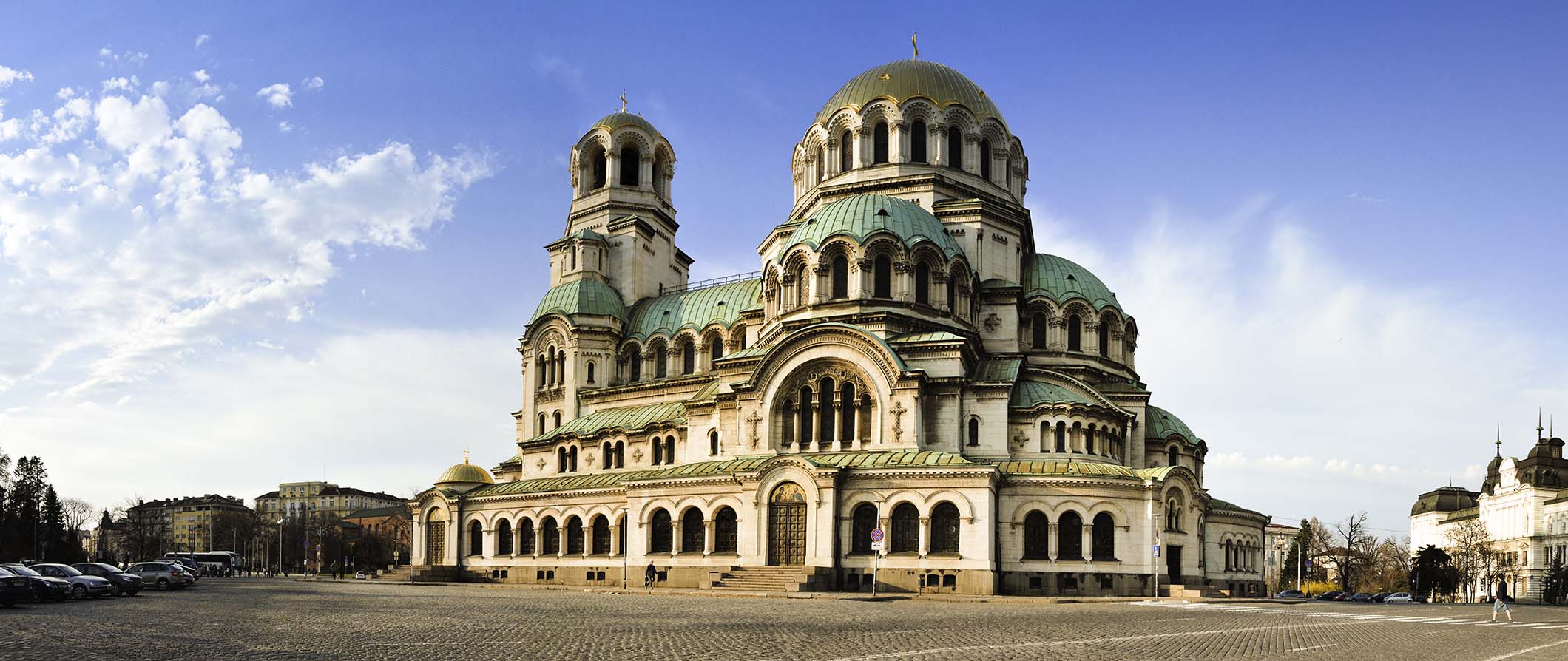
1. Visit the Alexander Nevsky Cathedral
Constructed in the early 20th century, this is one of the world’s largest Eastern Orthodox cathedrals (it’s even made the list of the 50 largest Christian churches in the world). The gorgeous cathedral can hold up to 5,000 people at a time. The cathedral was named after the Russian prince, Saint Alexander Nevsky and was intended to honor the Russian soldiers who lost their lives when fighting in the Russo-Ottoman war during the late 1800s as the war resulted in Bulgaria’s independence from the Ottoman empire. Visitors can explore the stunning interior and the museum of Bulgarian religious icons in the cathedral crypt, famed to hold the most extensive collection of Orthodox religious icons in Europe. Topped with the characteristic gilded domes of the Neo-Byzantine style and with a beautiful Italian marble interior, it’s my absolute must-see here. The bell tower holds 12 bells that weigh 23 tons!
2. See Sveti Georgi Rotunda
Dating to the fourth century, this tiny circular Roman building is the oldest preserved structure in Sofia and sits undisturbed amongst other Roman ruins. The red brick building was built in the 4th century on a site that was believed to be an even older pagan temple. Originally a bathhouse, the interior is painted with magnificent murals that date between the 6th and 14th centuries. In total there are five layers of ornate frescos that were painted over when the church was converted into a mosque during Ottoman rule. They were only uncovered during the church’s restoration in the 20th century. The rotunda and the ruins are surrounded by modern government buildings and preserved in a large courtyard that remains open to the public. The small church holds weekday services so just dress respectfully.
3. Hike Vitosha mountain
Head for a hike to reach the summit and you’ll be treated to incredible panoramic views over Sofia and the surrounding area. The highest summit is Cherni Vrah at 2,290 meters (7,513 feet). Most trails just take a couple of hours. It’s surprisingly easy to reach Vitosha’s trails, all you have to do is take a bus to the Simeonovo ski lift. Once you arrive, you’ll feel worlds away from the hustle and bustle of the city, surrounded by craggy rocks and ancient pine trees. Vitosha mountain is part of Vitosha National Park, which is one of the oldest in the Balkans and includes a massive cave you can explore.
4. Visit the National Gallery Quadrat 500
This enormous gallery contains artwork from both the National Gallery and the former Museum of Foreign Art. Having opened in 2015, Quadrat 500 is the most recent admission to the National Gallery and contains 1,700 pieces of art. Wander through 28 halls and four levels filled with art from around the world and you’ll find works from beloved Bulgarian 19th-20th century artists here (including Georgi Mashev and Vladimir Dimitrov) alongside African tribal masks and sketches from Renoir and Matisse. Admission is 10 BGN. You can receive discounted admission on Thursdays for 2 BGN. The museum also hosts a variety of lectures in both Bulgarian and English throughout the year.
5. Day trip to Rila Monastery
This is the most important Eastern Orthodox monastery in the country, having been a spiritual space for over 1,000 years. Rila was founded in the 10th century by Saint John of Rila. Then a simple hermit, the site of the monastery was believed to be the place where he lived and died. After his death, they were converted into a monastery that was a center of spiritual and social activity during the medieval period. The original building was destroyed in a fire in the early 19th century and later rebuilt in the Bulgarian Renaissance style in the mid-1800s. You’ll find stunning religious art and colorful architecture, including golden domes and striped archways. Entrance to the monastery is free.
Other Things to See and Do in Sofia
1. take a free walking tour.
The first thing I do in a new city is take a free walking tour. It’s the best way to see the main sights on a budget and connect with a local guide who can answer all your questions. Free Sofia tour runs regular free walking tours that cover all the main highlights. Just be sure to tip your guide at the end!
2. See the Presidency and the Guard Ceremony
The Bulgarian president’s office lies within the eastern end of the same building that houses the Sheraton Hotel. The office isn’t open for public viewing, but the changing of the guard occurs every hour. The stomping march of the uniform-clad men can be heard all around the area. It doesn’t take long but it’s worth stopping by to see.
3. See what’s on at the National Palace of Culture
Usually referred to as the NDK, this building has 15 separate halls, making it the largest cultural complex in the country. During the summer, there is a regular schedule of various events and a diverse range of shows to check out, including concerts, dance performances, and theater. Check out their website to see what’s on during your visit.
4. Attend an event at the Red House
Home to political debates, poetry readings, and dramatic performances, the Red House is an independent cultural center that’s not as mainstream as the NDK. The building itself is a mansion from the early 20th century that once belonged to Bulgarian sculptor Andrey Nikolov. Events are usually free, and often in English. Check their website to see what’s on during your visit.
5. Have fun in Kokolandia
This is an outdoor adventure activity center located inside Borisova Gradina park. There are all sorts of fun challenges here including rope climbing, rock climbing, mini-golf, and a tree-top obstacle course. This adventure park is considered kid- and adult-friendly (though it’s mostly for kids; there are trampolines and bouncy castles too). Activities cost 6 BGN per person.
6. Go paintballing
Paintballing has become increasingly popular throughout Sofia. There are over half a dozen different places you can go that offer equipment rentals, paintballs, and both indoor and outdoor gaming areas. It’s super fun and a great way to spend a couple of hours! Reservations are usually required and sessions cost 90 BGN.
7. Stroll Vitosha Boulevard
This is a high-end pedestrian street filled with fashionable boutiques and designer shops, but it’s worth the stroll for the view of snow-capped Vitosha Mountain. Art Nouveau buildings line the street, and there are several small sidewalk cafes where you can grab a coffee and relax. Come here to browse, people-watch, and take in the local pace of life.
8. Check out the Museum of Socialist Art
This museum in Sofia showcases art from when the country was under Communist rule (1944-1989). A large outdoor sculpture park contains everything from a giant statue of Lenin that once stood in the center of the city to the red star that topped the socialist party headquarters. Inside you’ll find propaganda paintings, documentary videos, photographic galleries, and more. Admission is 6 BGN.
9. See the National Museum of Military History
This is one of the most visited museums in Sofia. There are three floors, each featuring detailed exhibits on warfare in Bulgaria from antiquity and the Middle Ages to World War II. You’ll see rebel flags, military uniforms, and artifacts, including the personal effects of actual soldiers. There’s also a collection of vehicles, including tanks and fighter planes. Admission is 8 BGN.
10. Visit the Archaeological Museum
This museum is located inside a former mosque that dates to the 1400s. The museum is home to a collection of Roman and medieval items, including a delicate mosaic floor from the Church of Sveta Sofia. Other artifacts come from the Thracians, a group of Indo-European tribes living in the area since the 8th century BCE. The incredibly detailed Thracian gold burial mask from the 4th century BCE has an especially impressive life-like appearance. Admission is 10 BGN.
11. Tour the Sofia History Museum
Housed inside the former Central Mineral Baths from the Ottoman era, the history of Sofia — from prehistory to the modern day — is on full display here. The museum spans two floors and includes rooms dedicated to the Bulgarian royal families of the 19th and 20th centuries. These rooms provide a glimpse of the lavish lives they lived. There’s even a horse carriage from Marie Antoinette here. Admission is 6 BGN.
12. Go skiing
If you’re here during the winter, hit the slopes on Vitosha. Unlike in much of Western Europe, skiing is super affordable here. You can get a lift pass for as little as 50 BGN, making this one of the most affordable winter sports destinations on the continent!
For more information on other cities in Bulgaria, check out these guides:
- Plovdiv Travel Guide
- Varna Travel Guide
- Veliko Tarnovo Travel Guide
Sofia Travel Costs
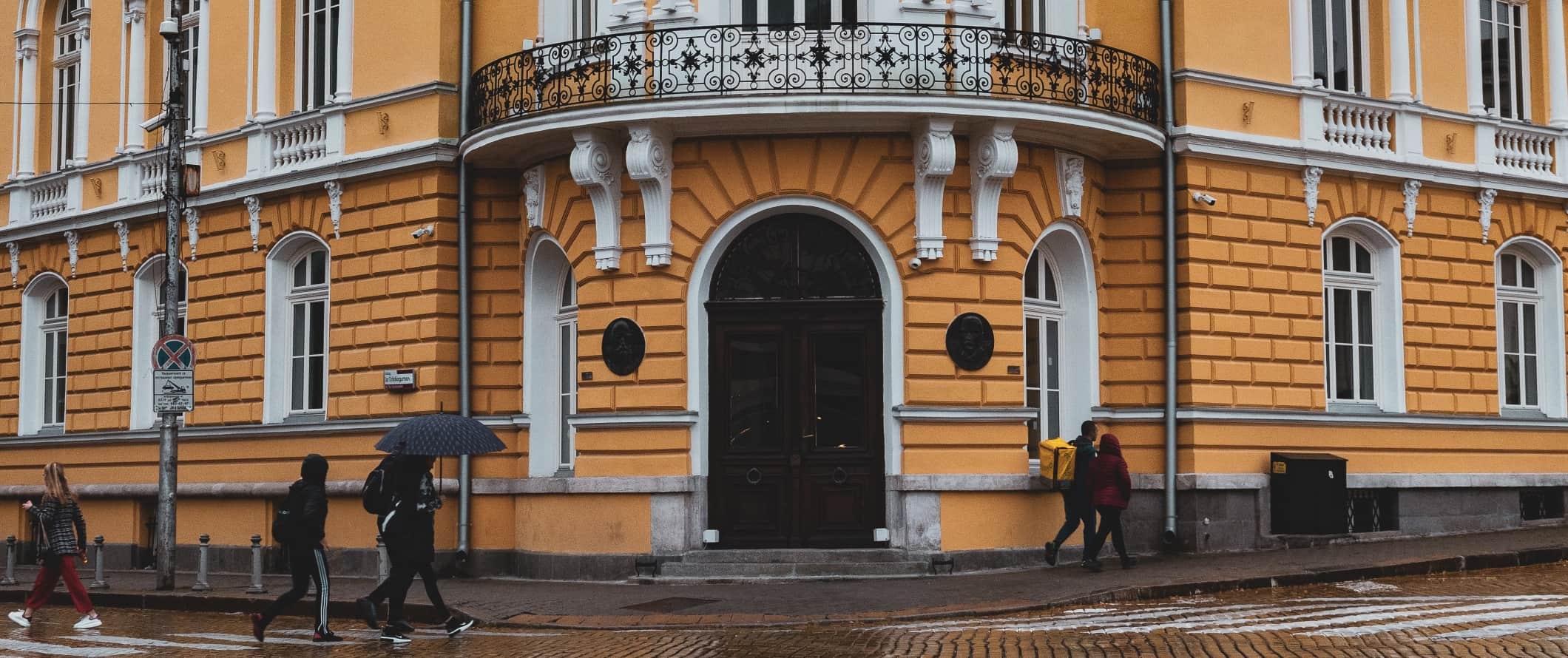
Hostel prices – A bed in a hostel dorm with 4-6 beds costs between 12-25 BGN per night. For a private room in a hostel, expect to pay between 35-75 BGN per night. Free Wi-Fi is standard and most hostels also have self-catering facilities.
If you’re traveling with a tent, wild camping is illegal in Bulgaria. There are campgrounds outside the city, however, you can’t book online or find prices in advance so you’ll need to check on arrival.
Budget hotel prices – Budget two-star hotels cost around 40-65 BGN per night. Expect basic amenities like TV and free Wi-Fi.
Airbnb is available all over the city, with private rooms starting at 30-55 BGN per night. Entire homes and apartments start around 55 BGN though prices average double that.
Food – Bulgarian cuisine is hearty and similar to that of its Balkan neighbors. Meaty stews with lamb, goat, or chicken are common, as are sausages and all kinds of yogurts (dairy products are big here). Popular dishes include kebapche (grilled mincemeat), shopska salad (a salad with tomato, cucumber, and cheese; similar to Greek salad), and moussaka.
You can find foods like banica (cheese pastry) for as little as 1.50 BGN, or you can pick up a hearty shopska salad or kebab for about 5 BGN. Pizza slices and hot dogs are usually no more than 4 BGN, while a sandwich is between 4-5 BGN.
A combo meal at McDonald’s costs 12 BGN while a meal at a mid-range restaurant with a drink shouldn’t cost more than 15-20 BGN.
If you want to splash out, a three-course dinner with a glass of wine at an upscale restaurant ranges from 35-50 BGN.
Beer is around 4 BGN while a latte/cappuccino costs around 3.70 BGN. Bottled water is 1.60 BGN.
Grocery shopping is incredibly affordable here, costing around 50-65 BGN per week for basic staples like rice, pasta, seasonal produce, and some meat.
Backpacking Sofia Suggested Budgets
If you’re backpacking Sofia, expect to spend about 60 BGN per day. On this budget, you’ll be staying in a hostel dorm, cooking your meals, limiting your drinking, taking public transportation to get around, and sticking to mostly free activities like free walking tours and hiking. If you plan on drinking, add 5-10 BGN to your daily budget.
On a mid-range budget of 150 BGN per day, you can stay in a private Airbnb, eat out for most meals at cheap fast food joints, enjoy a couple of drinks, take the occasional taxi to get around, and do more paid activities like visiting museums and attending performances.
On a “luxury” budget of 275 BGN or more per day, you can stay in a hotel, eat out for all your meals, drink more, rent a car or take more taxis, and do whatever tours and activities you want. This is just the ground floor for luxury though. The sky is the limit!
You can use the chart below to get some idea of how much you need to budget daily, depending on your travel style. Keep in mind these are daily averages — some days you’ll spend more, some days you’ll spend less (you might spend less every day). We just want to give you a general idea of how to make your budget. Prices are in BGN.
Sofia Travel Guide: Money-Saving Tips
Since Sofia is the capital city of Bulgaria, prices are a little higher here when compared to other parts of the country. However, it’s still incredibly affordable as there are so many cheap and free things to do. Here are some ways to save money in Sofia during your visit:
- Stay with a local – If you look early, you can likely find a Couchsurfing hosts in Sofia. This not only gets you free accommodation but you’ll connect with a local who can share their insider tips and advice.
- Take a free walking tour – Walking tours are a great way to get familiar with the city and its culture while on a budget. Just be sure to tip your guide at the end!
- Look for free events – There are always free events and festivals happening in Sofia (especially in the summer). Be sure to ask your hostel staff or host about what’s going on during your visit.
- Bring a water bottle – The tap water here is safe to drink so bring a reusable water bottle to save money and reduce your plastic use. LifeStraw is my go-to brand as their bottles have built-in filters to ensure your water is always clean and safe.
Where to Stay in Sofia
Sofia has several fun, clean, and affordable hostels. They fill up fast during the summer so book early. Here are my suggested places to stay in Sofia:
- Hostel Mostel
- Hostel Ivory Tower
- Park Hsotel Sofia
How to Get Around Sofia
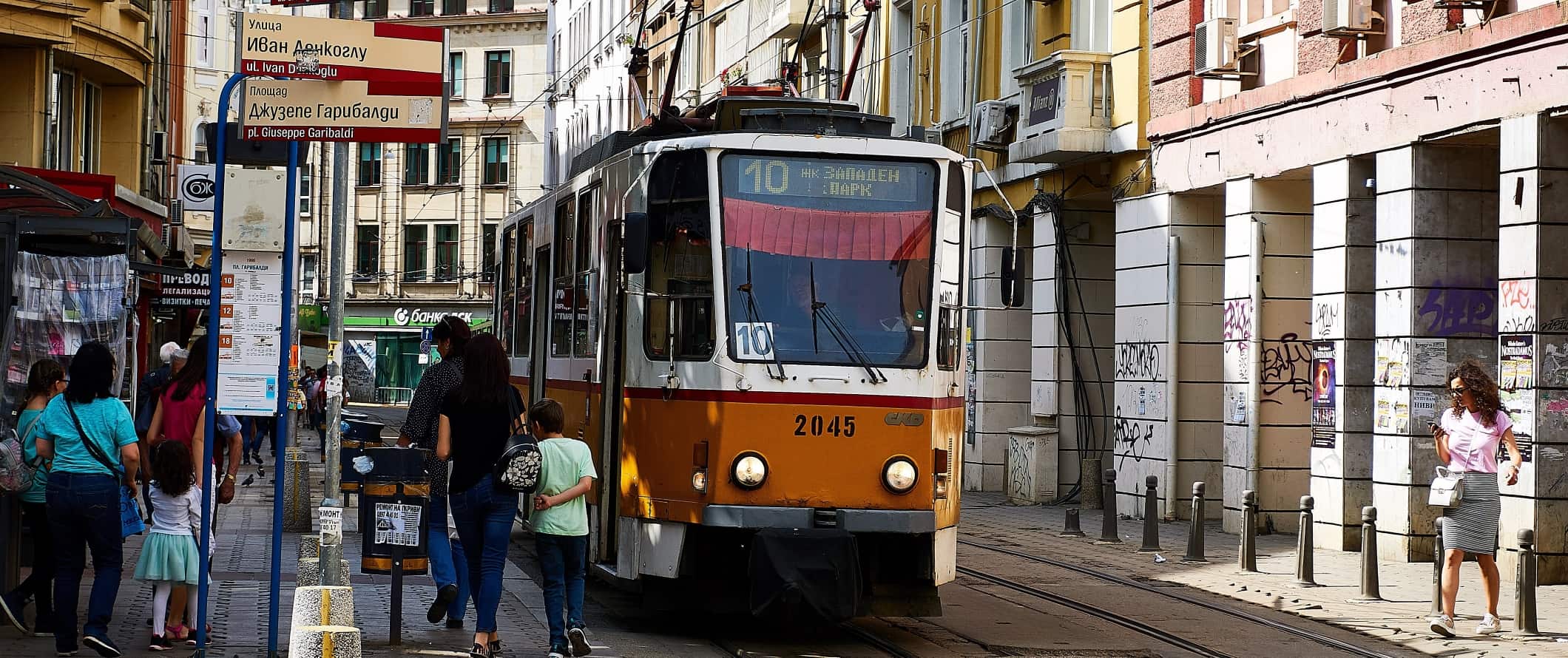
Public transportation – Sofia’s metro has two lines connecting the city center and the airport, as well as the central bus and train stations. Individual tickets are 1.60 BGN each, but they can’t be used on the buses, trams, or trolleybuses.
However, you can purchase a day pass for 4 BGN or a three-day pass for 10 BGN with unlimited rides on all public transportation. Use the official website (sofiatraffic.bg) to look up schedules and routes. This is by far the best deal for getting around the city.
Sofia’s bus system is extensive and can get you just about anywhere you need to go using it. You can use the sofiatraffic.bg website or the Moovit app to help plan your journey. You’ll need the exact change to buy a ticket from the driver on board the bus. Tickets are 1.60 BGN and you can purchase a 10-ride pass for 12 BGN.
Taxi – The normal start rate for a taxi in Sofia is 2 BGN, and then an additional 1-2 BGN per kilometer. The rate at night is 1.99 BGN per kilometer. While affordable, they can add up fast if you use them often so stick to public transportation if you can.
Bicycle – There are lots of bicycle rental services in Sofia. You can rent a bicycle for one full day for about 20 BGN. Sofia Bike Rental and Rent a Bike Sofia are two good options.
Car rental – Car rentals are super affordable here, costing as little as 25 BGN per day. You don’t need one to get around the city, however, if you want to explore the region a car might be helpful. Drivers need to be at least 21 years old and have an IDP (International Driving Permit).
When to Go to Sofia
Sofia has four distinct seasons, of which summer (June-August) is the busiest. June can be quite rainy, but otherwise, the daily temperature is usually over 30°C (86°F). Keep in mind that this is the most expensive time to visit, as prices for hostels and hotels increase.
I personally think the best time to visit is spring (April-May) or fall (September-October). Both seasons have pleasant temperatures, fewer tourist crowds, and lower prices. The foliage around Mount Vitosha is spectacular during the fall, making for some excellent hiking. Temperatures range from 5-21°C (41-70°F) in the spring and 6-17°C (42-62°F) in the fall.
Winter (December-March) is the quietest time of year to visit, as temperatures drop below freezing. The weather can be snowy and unpredictable during this time. If you like winter sports, this is the best time to visit for skiing Mount Vitosha or nearby Bansko. Accommodations are cheapest during this time as well. If you’re not coming for winter activities, though, I’d skip a visit during the winter.
How to Stay Safe in Sofia
Sofia is very safe. Scams and petty crimes like pick-pocketing are the most common danger you’ll face, but those are rare. Nevertheless, always keep your valuables secure and out of sight just to be safe.
Solo female travelers should generally feel safe here, however, the standard precautions apply (never leave your drink unattended at the bar, never walk home alone intoxicated, etc.).
When it comes to scams, if a stranger stops to talk to you out of the blue, be aware that they may be working in a team to try and grab your wallet. The best thing to do is ignore them and keep walking. Some taxi drivers have been known to overcharge their customers, so make sure your driver has a metered cab before you get in it.
You can read about common travel scams to avoid right here .
Pedestrian safety can be a concern as some drivers do not give pedestrians the right of way. Take caution when crossing the street.
If you experience an emergency, dial 112 for assistance.
Always trust your gut instinct. Make copies of your personal documents, including your passport and ID. Forward your itinerary along to loved ones so they’ll know where you are.
The most important piece of advice I can offer is to purchase good travel insurance. Travel insurance will protect you against illness, injury, theft, and cancellations. It’s comprehensive protection in case anything goes wrong. I never go on a trip without it as I’ve had to use it many times in the past.
Sofia Travel Guide: The Best Booking Resources
These are my favorite companies to use when I travel. They consistently have the best deals, offer world-class customer service and great value, and overall, are better than their competitors. They are the companies I use the most and are always the starting point in my search for travel deals.
- Skyscanner – Skyscanner is my favorite flight search engine. They search small websites and budget airlines that larger search sites tend to miss. They are hands down the number one place to start.
- Hostelworld – This is the best hostel accommodation site out there with the largest inventory, best search interface, and widest availability.
- Booking.com – The best all around booking site that constantly provides the cheapest and lowest rates. They have the widest selection of budget accommodation. In all my tests, they’ve always had the cheapest rates out of all the booking websites.
- HostelPass – This new card gives you up to 20% off hostels throughout Europe. It’s a great way to save money. They’re constantly adding new hostels too. I’ve always wanted something like this and glad it finallt exists.
- Get Your Guide – Get Your Guide is a huge online marketplace for tours and excursions. They have tons of tour options available in cities all around the world, including everything from cooking classes, walking tours, street art lessons, and more!
- The Man in Seat 61 – This website is the ultimate guide to train travel anywhere in the world. They have the most comprehensive information on routes, times, prices, and train conditions. If you are planning a long train journey or some epic train trip, consult this site.
- Rome2Rio – This website allows you to see how to get from point A to point B the best and cheapest way possible. It will give you all the bus, train, plane, or boat routes that can get you there as well as how much they cost.
- FlixBus – Flixbus has routes between 20 European countries with prices starting as low 5 EUR! Their buses include WiFi, electrical outlets, a free checked bag.
- SafetyWing – Safety Wing offers convenient and affordable plans tailored to digital nomads and long-term travelers. They have cheap monthly plans, great customer service, and an easy-to-use claims process that makes it perfect for those on the road.
- LifeStraw – My go-to company for reusable water bottles with built-in filters so you can ensure your drinking water is always clean and safe.
- Unbound Merino – They make lightweight, durable, easy-to-clean travel clothing.
- Top Travel Credit Cards – Points are the best way to cut down travel expenses. Here’s my favorite point earning credit cards so you can get free travel!
Sofia Travel Guide: Related Articles
Want more info? Check out all the articles I’ve written on backpacking/traveling Bulgaria and continue planning your trip:
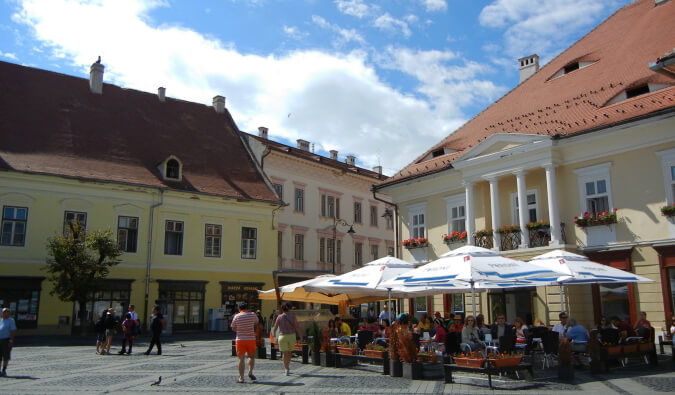
The Cost of Traveling Far Eastern Europe
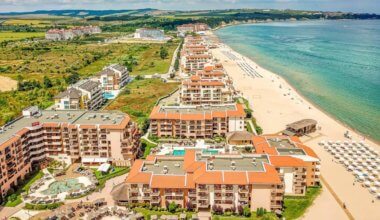
I Despise Sunny Beach. Here’s Why You Should Not Visit There
Get my best stuff sent straight to you, pin it on pinterest.
- Where To Stay
- Transportation
- Booking Resources
- Related Blogs
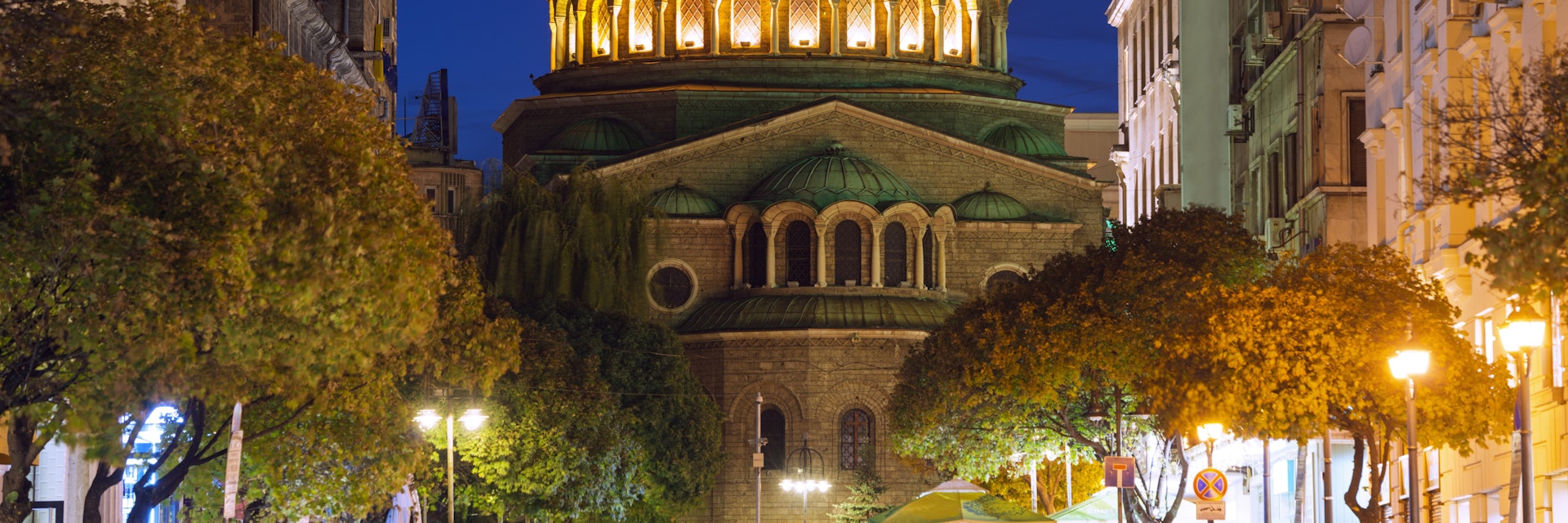
Christian Kober/AWL Images/Getty Images
Bulgaria's pleasingly laid-back capital is often overlooked by visitors heading to the coast or the ski resorts, but they're missing something special. Sofia is no grand metropolis, but it's a modern, youthful city, with a scattering of onion-domed churches, Ottoman mosques and stubborn Red Army monuments that lend an eclectic, exotic feel. Excavation work carried out during construction of the metro unveiled a treasure trove of Roman ruins from nearly 2000 years ago, when the city was called 'Serdica'. Away from the buildings and boulevards, vast parks and manicured gardens offer a welcome respite, and the ski slopes and hiking trails of mighty Mt Vitosha are just a short bus ride from the centre. Home to many of Bulgaria's finest museums, galleries, restaurants and clubs, Sofia may persuade you to stick around and explore further.
Your next trip starts here
Go from dreaming to planning with trip planning options made to help you craft your ideal itinerary.
Attractions
Must-see attractions.
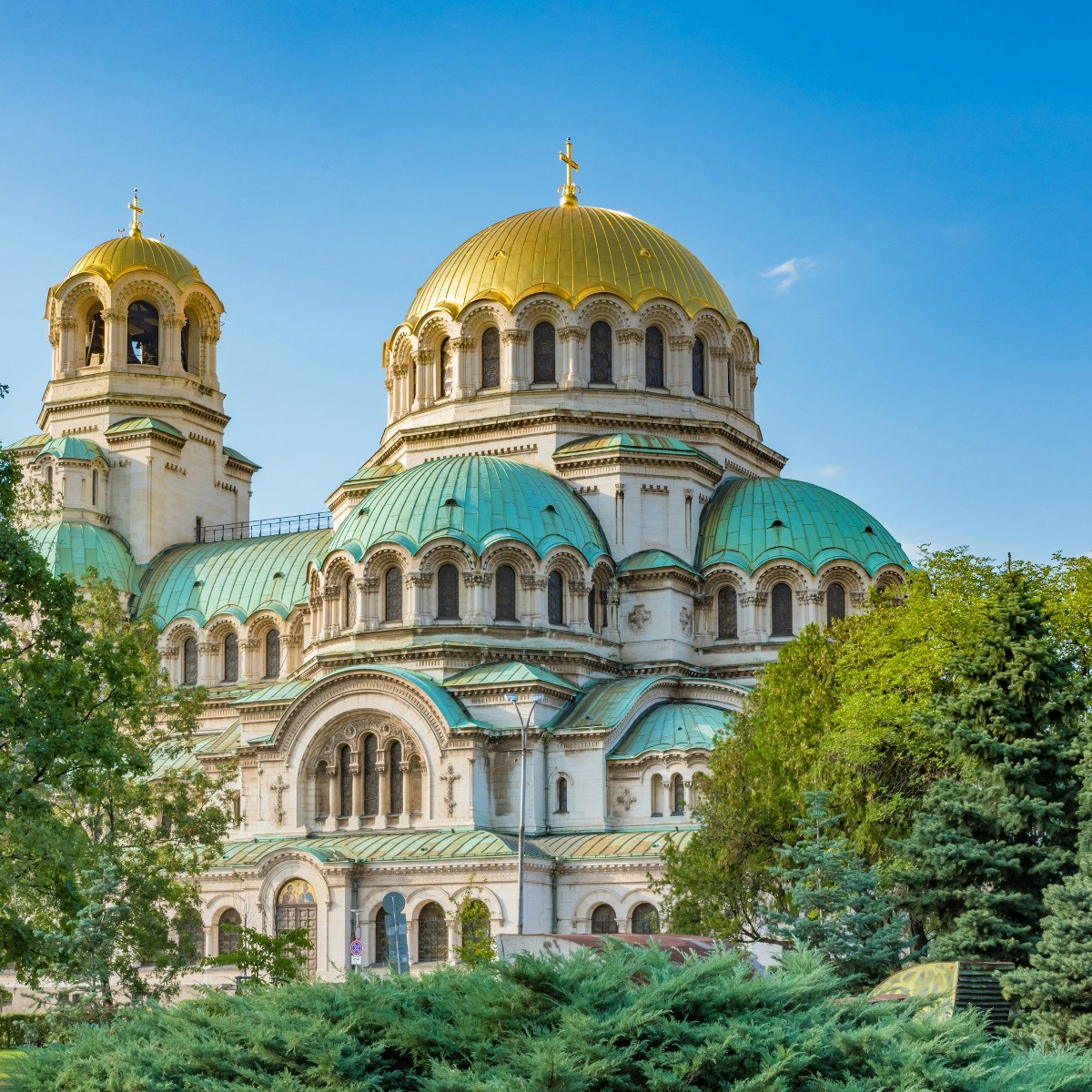
Aleksander Nevski Cathedral
One of the symbols not just of Sofia but of Bulgaria itself, this massive, awe-inspiring church was built between 1882 and 1912 in memory of the 200,000…

Sveta Sofia Church
Sveta Sofia is one of the capital's oldest churches, and gave the city its name. A subterranean museum houses an ancient necropolis, with 56 tombs and the…
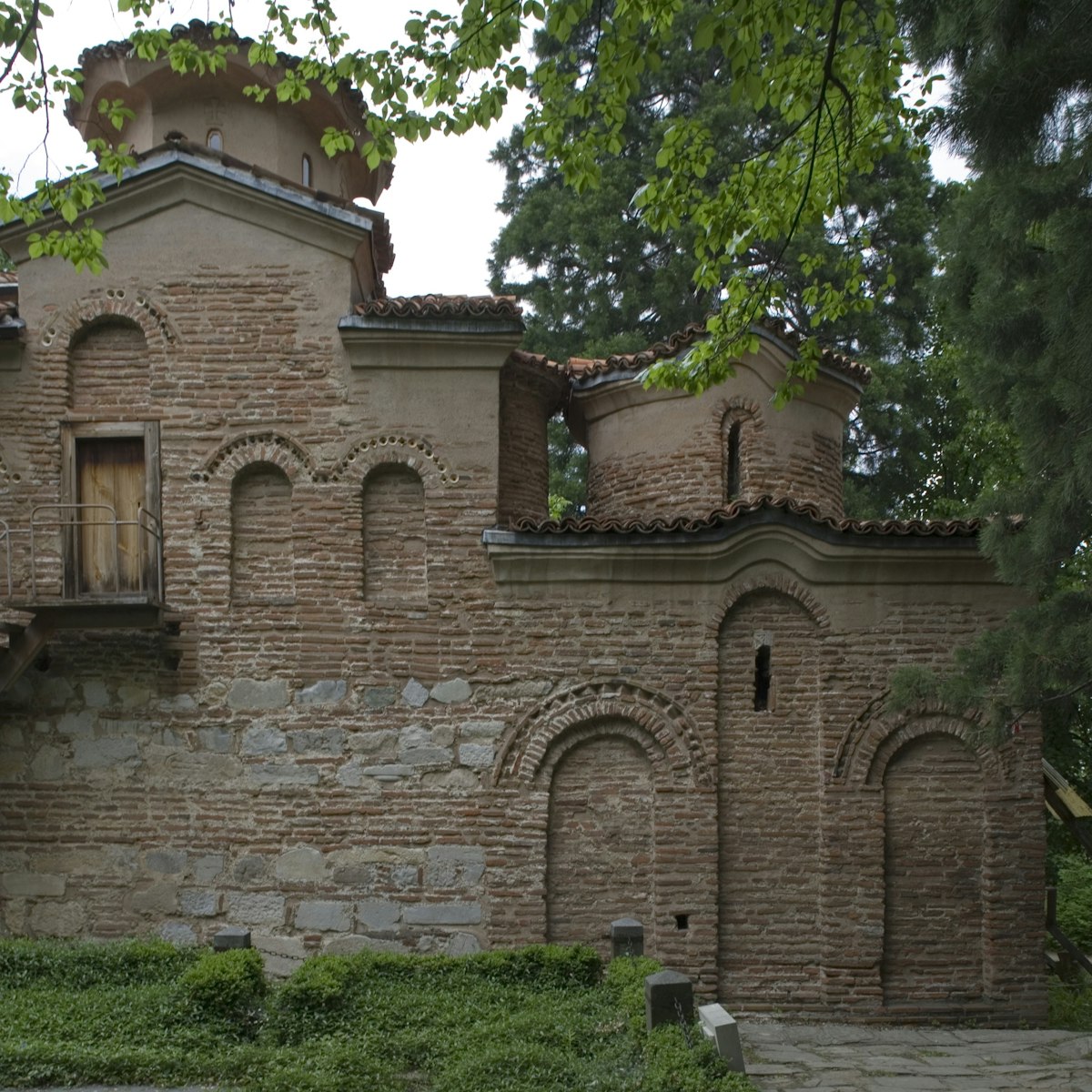
Boyana Church
Tiny 13th-century Boyana Church is included on Unesco’s World Heritage list and its 90 murals are among the very finest examples of Bulgarian medieval…
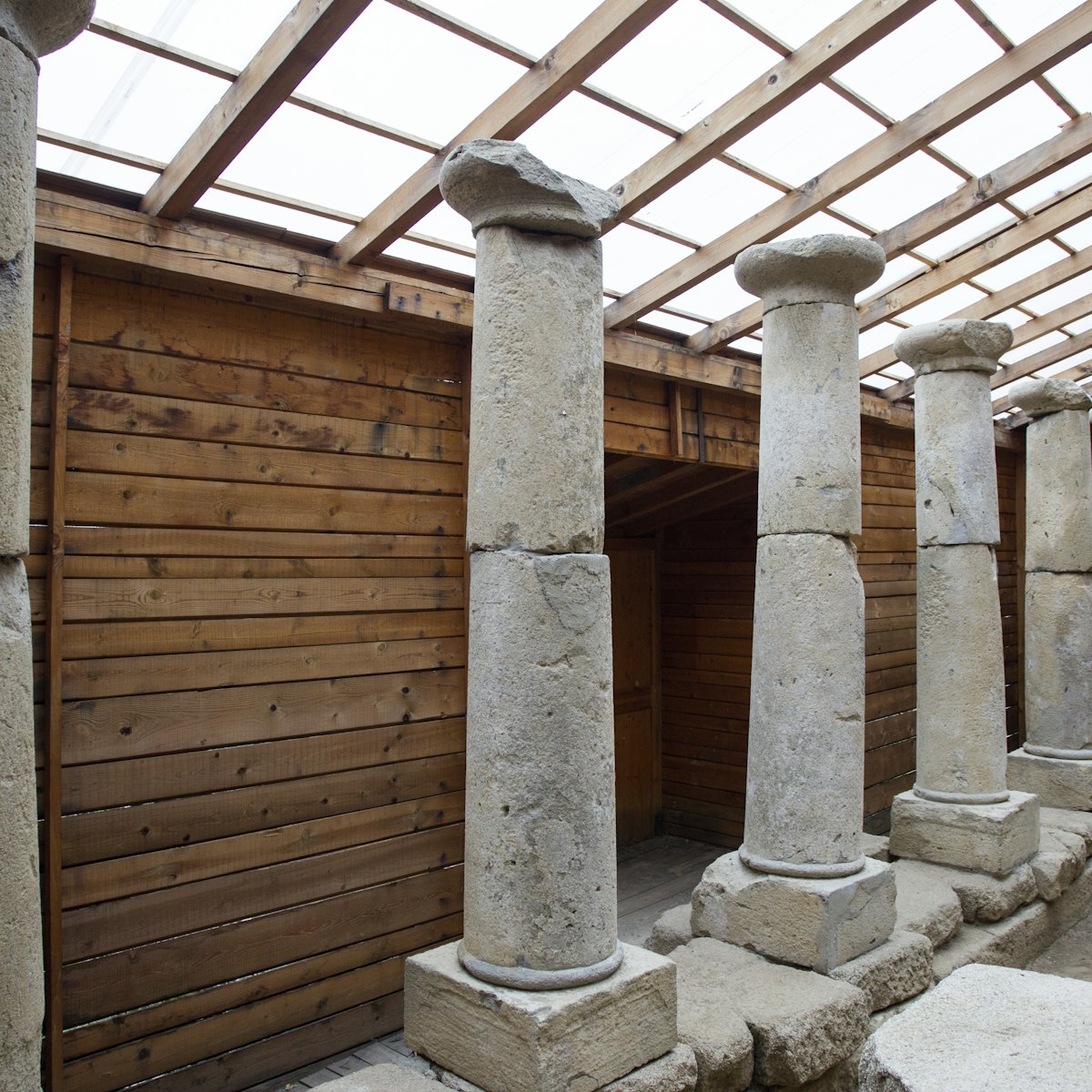
Archaeological Museum
Housed in a former mosque built in 1496, this museum displays a wealth of Thracian, Roman and medieval artefacts. Highlights include a mosaic floor from…

Sveti Georgi Rotunda
Built in the 4th century AD, this tiny red-brick church is Sofia's oldest preserved building. The murals inside were painted between the 10th and 14th…
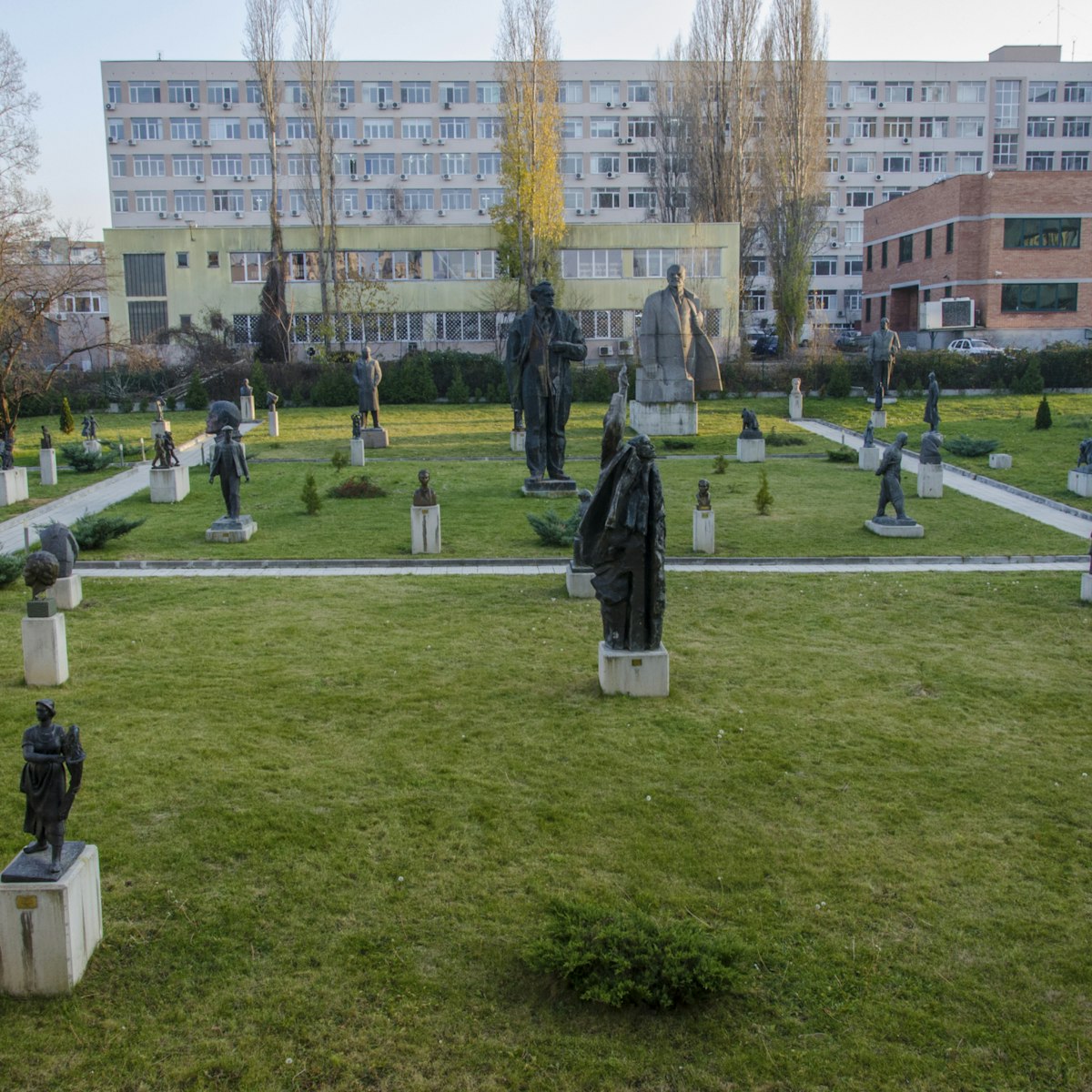
Museum of Socialist Art
If you wondered where all those unwanted statues of Lenin ended up, you'll find some here, along with the red star from atop Sofia's Party House. There's…
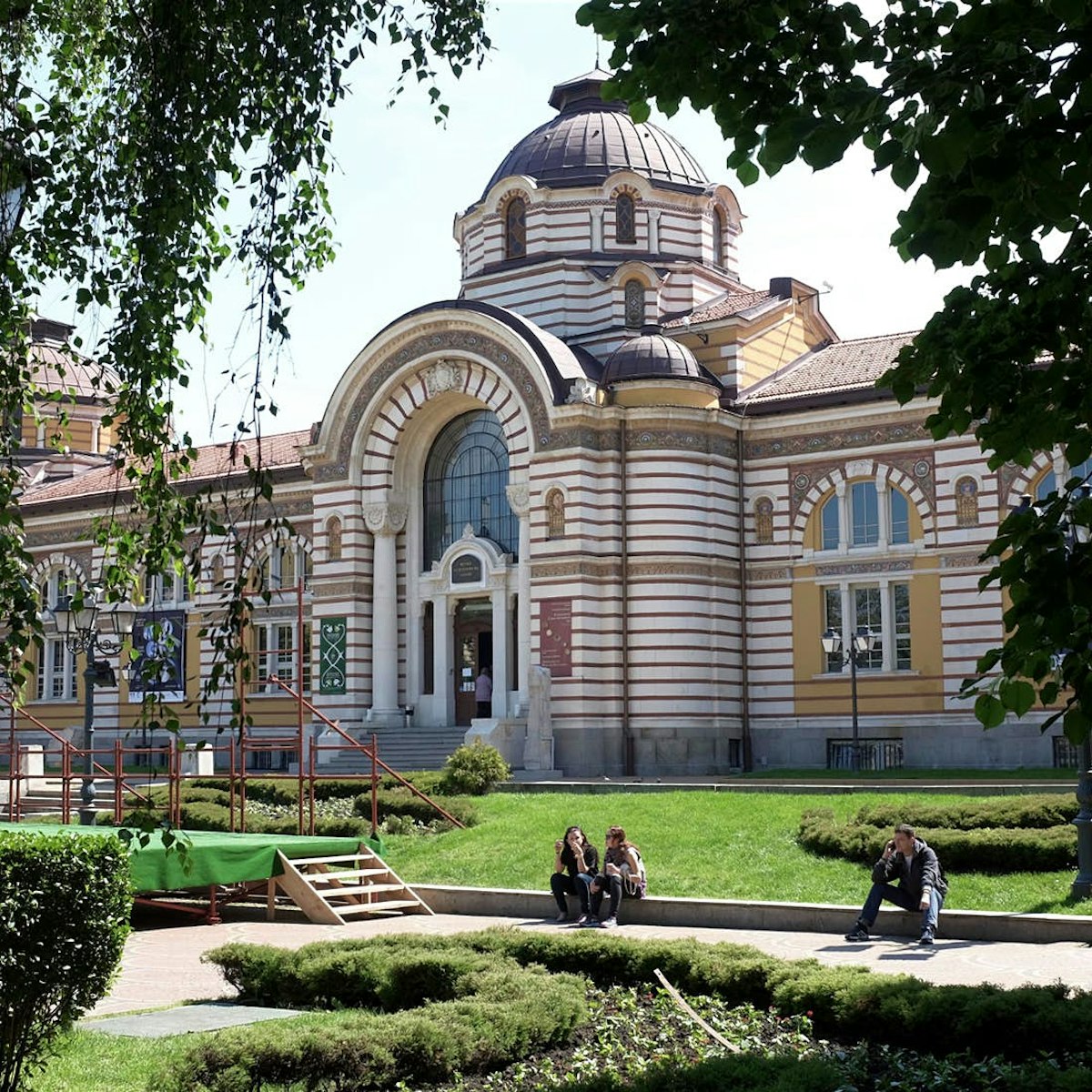
Sofia History Museum
The history of Sofia is presented on two floors of the magnificent former Turkish Mineral Baths, just behind the mosque. Exhibitions are divided…

Ancient Serdica Complex
This remarkable, partly covered excavation site, situated just above the Serdika metro station, displays the remains of the Roman city, Serdica, that once…
Latest stories from Sofia
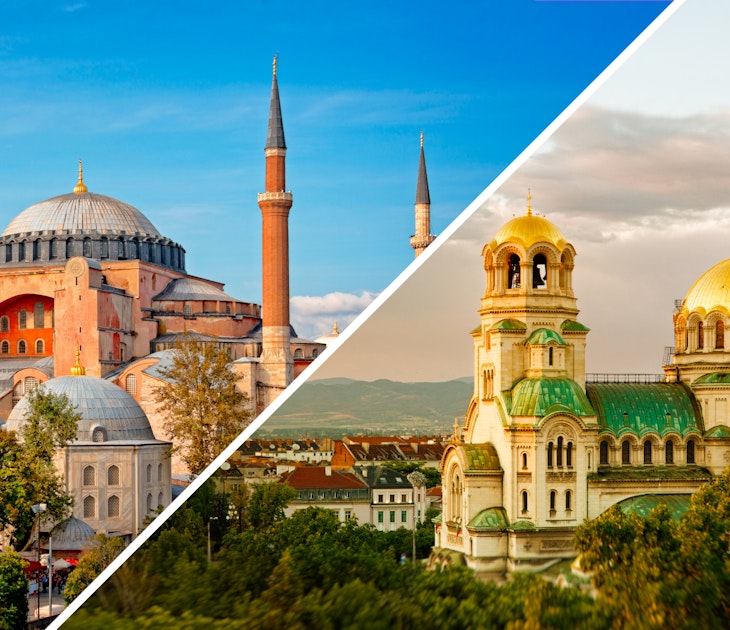
Best in Travel - 2023
Nov 15, 2022 • 10 min read
The recently restored overnight service between Istanbul and Sofia whirls two adventures into one. Tom Hall shows you how to do it.
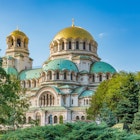
Oct 13, 2019 • 4 min read
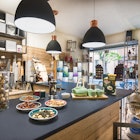
Feb 19, 2019 • 5 min read
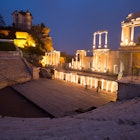
Jun 1, 2018 • 4 min read
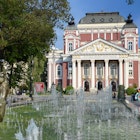
Apr 25, 2018 • 5 min read
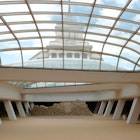
Jun 8, 2016 • 4 min read
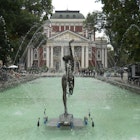
Oct 14, 2014 • 3 min read
in partnership with getyourguide
Book popular activities in Sofia
Purchase our award-winning guidebooks.
Get to the heart of Sofia with one of our in-depth, award-winning guidebooks, covering maps, itineraries, and expert guidance.
Explore Sofia

Plan Your Trip to Sofia: Best of Sofia Tourism
Essential sofia.
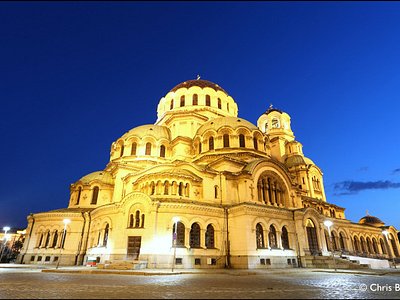
Trending in the forums

Sofia Is Great For
Historical tours.

Cultural Tours

Eat & drink
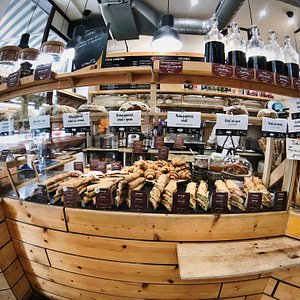
Archaeology Tours

- Grand Hotel Sofia
- InterContinental Sofia
- Hyatt Regency Sofia
- Sofia Balkan Palace
- Grand Hotel Millennium Sofia
- Staria Chinar - Sofia
- Olio D'oliva
- Osteria Tartufo
- Vitosha Mountain
- Vitosha Boulevard
- St. Alexander Nevski Cathedral
- Museum of illusions Sofia
- Rila Monastery and Boyana Church Shuttle Day Tour
- Day tour to Skopje, North Macedonia - Small Group
- Tour to Lovech, Devetaki cave & Krushuna waterfalls
- The Seven Rila Lakes & Rila Monastery
- The Seven Rila Lakes Day Tour From Sofia
Urban Wanders
Travel Blog based in Greece
- Thessaloniki
- Travel Guides
- Marketing Agency
Bulgaria , Readers Favorite , Travel ·
A Complete Travel Guide to Sofia, Bulgaria

Welcome to Sofia, the capital city of Bulgaria. If you’re planning a trip to this beautiful city, you’re in for a treat. Sofia is a hidden gem nestled in Eastern Europe, offering a unique blend of natural beauty, historical landmarks, and cultural heritage. Whether you’re a nature enthusiast, a history buff, or simply looking for relaxation, Sofia is the ultimate city break destination. In this complete travel guide to Sofia, Bulgaria, we will take you on a journey through the city, uncovering its top things to do, the best restaurants and cafes, and must-see attractions. With a perfect blend of captivating historical landmarks, a mesmerizing modern cityscape, and an atmosphere filled with vibrant culture, Sofia is truly a city that should never be missed. Let’s dive in and discover the top things to do in Sofia!
Table of Contents
- 1 How to get to Sofia, Bulgaria
- 2 How to get to Sofia City Center from the Airport
- 3 How to Get Around the City
- 4.0.1 Explore more hotels in Sofia
- 5.1.1 Regional History Museum
- 5.1.2 The Red Flat
- 5.1.3 The Palace – National Art Gallery
- 5.1.4 National Gallery
- 5.1.5 National Museum of Military History
- 5.1.6 National Archaeological Museum
- 5.2.1 St. Alexander Nevsky Cathedral
- 5.2.2 Saint Sophia Church
- 5.2.3 St. Nedelya Church
- 5.2.4 St. George Rotunda Church
- 5.2.5 St. Nicholas the Miracle-Maker
- 5.3 Explore the Parks of Sofia
- 5.4 Go Shopping on Vitosha Boulevard
- 5.5 Go on a Walking Tour
- 5.6 Visit the Ancient Serdica Archaeological Complex
- 5.7 Discover Vitosha Nature Park
- 5.8 Relax at Mineral Hot Springs
- 5.9 Visit the Seven Rila Lakes
- 6 Other Noteworthy Things to Do or See in Sofia
- 7.0.1 Restaurants
- 7.0.2 Coffee/Brunch
- 7.0.3 Check out the top 8 coffee shops to visit in Sofia here
- 8 How Many Days to Spend in Sofia
- 9 Best Time to Visit Sofia, Bulgaria
How to get to Sofia, Bulgaria
To reach Sofia, Bulgaria, you have several options available. The most convenient way is by air, as Sofia has an international airport with connections to major cities worldwide. Many airlines operate regular flights to Sofia, making it easy to find a suitable itinerary. Alternatively, you can also access Sofia by train or bus if you prefer a more scenic route. There are direct train and bus services from various European cities, providing affordable and comfortable travel options. Additionally, if you are already in Bulgaria, Sofia is well connected with other cities within the country via an extensive network of highways, making it convenient if you’re renting a car especially if you would like to combine a visit to Sofia with another city.
How to get to Sofia City Center from the Airport
To travel from Sofia Airport to the city center, there are several convenient options available. The most popular and cost-effective means is by using the airport’s metro station, conveniently located near Terminal 2. Simply follow the signs directing you to the metro, purchase a ticket from the machine, and hop on Line 1 heading towards the city center. The journey takes approximately 18 minutes, and trains run regularly. Alternatively, you can opt for a taxi or transfer service. Avoid grabbing a taxi found outside the arrivals hall as the drivers may scam tourists to pay more than they have to. It is advisable to confirm the fare with the driver beforehand to avoid any surprises. Another option is to take a bus, as Sofia airport is well connected to the city’s public transport network. Look for bus line 84, which takes you directly to the city center, or check the bus schedules and routes for other convenient options.

How to Get Around the City
When it comes to getting around the city of Sofia, there are several options available. First off, there’s no better way to explore and see Sofia than by walking. Sofia is a relatively small and compact city, making it perfect for exploring on foot. Many popular attractions, such as the Alexander Nevsky Cathedral, the National Palace of Culture, and the Vitosha Boulevard, are within walking distance from each other. Using Google Maps is a great way to navigate through the city. Otherwise, Sofia has an extensive public transportation network consisting of buses, trams, and an underground metro system. The metro, in particular, is very convenient and covers most of the city’s major areas. You can purchase tickets at metro stations or use a rechargeable card called a “Sofia City Card” for easy travel. Taxis are readily available in Sofia and are usually quite affordable. Look for licensed taxis with a company logo or use a ride-hailing app like TaxiMe for convenient and reliable transportation. Always insist on using the taxi meter or negotiate the fare upfront. Sofia has been improving its cycling infrastructure in recent years, making it increasingly bike-friendly. You can rent bicycles to get around the city while enjoying the sights at the same time. Lastly, if you prefer more independence and flexibility in your travels, consider renting a car. Several car rental companies operate in Sofia, and having your own vehicle gives you the freedom to explore the city and venture into the surrounding areas at your own pace.
Where to Stay in Sofia, Bulgaria
When choosing a hotel in Sofia, it’s important to consider your travel itinerary and the amount of walking you plan to do during your visit. If you’re only planning on walking to explore the city, then a hotel located in the heart of the city center should be sufficient. However, if you plan to spend a lot of time exploring the surrounding area, a hotel located a bit further from the center may be more convenient.
Hyatt Regency Sofia: Staying at Hyatt adds an extra layer of luxury to your trip without breaking the bank as rates in Bulgaria are on average lower than other European countries.
Juno Hotel Sofia: Situated right in the heart of Sofia this new boutique hotel boasts cozy rooms, high-end amenities, and a convenient location.
Oborishte 63: Designed to blend art and culture, this boutique hotel offers spacious rooms with a modern flair.
Grand Hotel Millennium Sofia: The Grand Hotel Millennium Sofia, is a luxurious property offering easy access to historic and cultural sites. It also comes with a spa center, 24-hour front desk, gym, a heated swimming pool, as well as a bar and shared lounges.
The Heart of the City Center Lux Apartment : Right in the vibrant city center, this Brooklyn-inspired apartment will make you feel right at home.
COURTHOUSE PRIVATE GARDEN Apartment: This chic apartment is situated in a trendy area, offering plenty of dining establishments, lounges, and bars. It can comfortably accommodate 4 people.
SCA Sofia City Apartments: These large apartments are perfect for families, offering everything you’ll need for a comfortable vacation, including a fully functional kitchen and spacious living room.
Apart-Hotels-Sofia: These apartments are ideal for solo travelers as well as large families, with various sizes available less than a kilometer from the famous Cathedral Saint Alexandar Nevski.
Explore more hotels in Sofia
Top things to do in sofia.
Sofia is a city that offers a wealth of experiences for visitors. The city is home to many historic landmarks, such as the Church of Saint George, the Alexander Nevsky Cathedral, and the National Palace of Culture. For a taste of modern Bulgaria, visit the city’s bustling streets, lively squares, and diverse cuisine scene. You can also explore Sofia’s parks, museums, and art galleries to discover more about the city’s rich cultural heritage. With its vibrant atmosphere and endless possibilities, Sofia is the perfect destination for travelers of all kinds.
Check Out the Museums in Sofia
Regional history museum.

The Regional History Museum of Sofia holds an impressive collection of historical exhibits that offer a comprehensive view of the city’s past. Covering the time frame from ancient times to the present, this museum captures the essential events and people that have contributed to the city’s rich cultural heritage. Housing the former Turkish Mineral Baths building, the museum showcases a wide range of cultural events and exhibitions. Visitors can expect to find an array of artifacts and exhibits, ranging from royal family memorabilia to educational displays from the communist era. The museum hosts a diverse range of topics, making it a must-visit destination for anyone interested in learning more about the city’s rich history.
The Red Flat
You can get a taste of the seemingly utopian way of life in communism by exploring an interactive exhibit at the Red Flat. The museum showcases the typical home of a Bulgarian family in the 1980s, allowing visitors to experience what everyday life was like during the era of Reagan and Gorbachev. From work to school, partying to household chores, everything is recreated to give visitors a realistic glimpse into communist Bulgaria. It’s advised to book a spot ahead of time as the time slots tend to sell out.
The Palace – National Art Gallery

The National Art Gallery in Sofia is a museum dedicated to showcasing Bulgarian art masterpieces, which span from the medieval era to the present day and is housed in a former royal palace. It is a must-visit destination for art enthusiasts and history buffs alike.
National Gallery

The National Gallery, a renowned institution for Bulgarian as well as international art, is located in the heart of Sofia, on the picturesque St. Alexander Nevsky Square. Its former name, the Royal Printing Office, dates back to the 19th century. The gallery is part of a historical structure and serves as a cultural hub for the nation. The entrance is about 5 euros.
National Museum of Military History
Part of the defense ministry, the National Museum of Military History preserves and processes culturally valued articles related to the military history of Bulgaria and Europe. It features a wide range of items, including rebel flags, parade uniforms, vehicles, and weapons. The outside exhibition is free for all visitors and is full of military aircraft, vehicles, and more.
National Archaeological Museum
The National Archaeological Museum in Sofia is home to an extensive collection of artifacts from various periods of human history. From prehistoric times to the medieval period, visitors can immerse themselves in the museum’s exhibits. Its location, within the building of the largest and oldest former Ottoman mosque in the city, adds to the museum’s cultural significance.
Visit the Churches of Sofia
St. alexander nevsky cathedral.

The St. Alexander Nevsky Cathedral stands proudly as the grandest Orthodox temple on the Balkan Peninsula. It is undoubtedly a must-see landmark in Sofia, captivating visitors with its magnificent architecture and exquisite interior. This iconic Bulgarian Orthodox church boasts a Neo-Byzantine style that leaves spectators in awe. Inside, a visit to its underground museum only adds to the sense of wonder and appreciation for this remarkable gem.
Saint Sophia Church

St. Sophia in Sofia, Bulgaria, holds the title of being the oldest church in the country. It originates from a Byzantine church dating back to the 4th century and showcases a predominantly brick interior adorned with beautiful paintings. Additionally, the church boasts an intriguing underground crypt. A noteworthy sight adjacent to the church is the Monument of the Unknown Soldier, where an eternal flame honors the memory of Bulgarian soldiers who sacrificed their lives in defense of their homeland. Don’t miss the striking lion sculpture situated close to the monument, whose gaze directs your attention towards the magnificent St. Alexander Nevsky Cathedral.
St. Nedelya Church

The St. Nedelya Church in Sofia is a beautiful medieval Orthodox church with a stunning domed interior adorned with exquisite murals. The church has a rich and fascinating history that dates back to the 10th century when it served as the primary religious institution for the city of Sofia. Over the years, the church has undergone numerous reconstructions and renovations, further solidifying its identity and significance in Sofia’s rich cultural heritage. Today, the St. Nedelya Church, along with its surroundings, is considered among the significant landmarks of the city. Its impressive architecture, breathtaking interior, and intricate murals adorning the walls make it a must-visit destination for tourists and locals alike.
St. George Rotunda Church
The St. George Rotunda Church is a remarkable historical monument located in Sofia, Bulgaria. Built in the 4th century, it stands as the oldest building in the city and holds immense religious and cultural significance. This cylindrical church features a stunning frescoed dome, showcasing intricate artwork depicting religious scenes and symbols. With its ancient architecture and rich history, the St. George Rotunda Church is a must-visit destination for those seeking a glimpse into Sofia’s past.
St. Nicholas the Miracle-Maker
The Church of St. Nicholas the Miracle-Maker is a Russian Orthodox church built in the early 20th century. It is known for its stunning architecture, adorned with ornate frescoes and gilded domes. The church is not only a religious landmark but also serves as a cultural and historical site. The church is located in the Russian Church Garden, a beautiful and quaint park ideal for strolling through with a coffee or for simply taking a break from all the sightseeing.

Explore the Parks of Sofia
Borisova Gradina Park: This is the oldest and largest park in Sofia, offering a perfect spot for a leisurely stroll, picnics, and boat rides on Lake Ariana.
South Park: Known for its lush greenery and stunning views of the Vitosha Mountain, South Park is a favorite among nature lovers and families.
National Palace of Culture Park: Surrounding the National Palace of Culture, this park which is also next to the South Park features tranquil ponds, and modern art installations, and hosts various cultural events throughout the year.
City Garden: Located in the heart of Sofia, City Garden is a charming spot with beautiful fountains, sculptures, and a lively atmosphere, including open-air concerts in the summer.
The Russian Church Garden: A quiet yet central park with various benches to sit, flowers and monuments. Found just a few steps away from all the famous churches of Sofia.
Sofia University Botanic Garden: The Botanic Garden features a wide variety of trees, shrubs, and flowers in a small yet charming park not too far from St. Alexander Nevsky Cathedral. Visitors have to pay a small fee to enter.
Go Shopping on Vitosha Boulevard

Vitosha Boulevard is the bustling heart of Sofia, filled with a vibrant mix of stores, restaurants, and bars. This iconic commercial street offers a delightful shopping experience, with a wide range of fashion boutiques, trendy shops, and designer brands lining its sidewalks. As the sun sets, Vitosha Boulevard transforms into a lively nightlife hub, welcoming locals and tourists to enjoy a diverse selection of bars and restaurants offering a variety of cuisines and delightful drinks. Whether you are looking to shop, dine, or simply soak in the energetic atmosphere, Vitosha Boulevard is hard to miss in the center of Sofia.
Go on a Walking Tour

Joining a walking tour of Sofia is one of the best ways to see the highlights of the city with an expert guide pointing out and sharing their insight about various monuments, buildings, and sites. Another walking tour worth joining includes the Communist Walking Tour , an educational 3-hour tour of the city’s communist-era landmarks – perfect for learning more about communist ideology and how it affected Bulgaria’s history. Booking a private walking tour of the city is also a great way to discover the real side of Sofia, its best places to eat, and tips on how to make the most out of your trip.
Visit the Ancient Serdica Archaeological Complex

The Ancient Serdica Archaeological Complex in Sofia is a fascinating site that offers a glimpse into the rich history of the Roman city of Serdica. With its two parts, the complex showcases the remains of ancient streets, houses, basilicas, and thermae. Visitors can explore the well-preserved buildings with their intricate decorations and learn about the prosperous lifestyle of the city’s elite during its peak period. The second part of this archaeological site was discovered in 2010 during the construction of the nearby Serdika metro station, where the remains were brought to light and further excavated from 2012 through 2013. If you are interested in archaeological sites and want to immerse yourself in Sofia’s ancient past, a visit to the Ancient Serdica Archaeological Complex is free and definitely a must.
Discover Vitosha Nature Park
Nature enthusiasts will also find plenty to do just an hour away from Sofia. Sofia lies in a large valley, surrounded by mountains, with Vitosha mountain being the highest nearby. Visitors can take a hike through the mountain’s trails, which offer breathtaking panoramic views of the city. Vitosha Natural Park offers visitors the opportunity to experience a wide range of other activities, including skiing, exploring waterfalls, lakes, caves, and horseback riding, making it a perfect destination for nature lovers and adventure seekers alike.
Relax at Mineral Hot Springs
With a history dating back to the beginning of the 4th century BC, Bulgaria’s mineral springs have long been cherished by locals and visitors alike. Exploring these mineral hot springs not only offers relaxation and wellness benefits but also provides a glimpse into the rich heritage of the city. Sofia is a special city because it has 42 mineral springs with 8 different hydrothermal zones where the water flows at a rate of 480 liters per second. These mineral springs are deep underground, making them clean and free from pollution. The water in these springs has a temperature ranging from 30 to 90 degrees Celsius, which makes for a unique and enjoyable experience.
Visit the Seven Rila Lakes
Located in the Rila Mountains, the Seven Rila Lakes are a pristine natural wonder just an hour and a half away from Sofia. Each lake has its own unique characteristics, ranging from tranquil to strikingly beautiful. Hiking through this breathtaking landscape offers stunning panoramic views and a chance to immerse oneself in nature’s serenity. Whether you’re a nature enthusiast, a photographer, or simply seeking a peaceful escape from the city, a visit to the Seven Rila Lakes is a must-do experience during your stay in Sofia.

Other Noteworthy Things to Do or See in Sofia
- National Assembly of Bulgaria: Head to the National Assembly of Bulgaria and its prominent square, where you’ll additionally encounter the Ancient Serdica Complex.
- Sofia Monument: Near the Ancient Serdica Complex it is hard to miss the famous Sofia Monument of Sant Sofia made from copper and brass.
- Ivan Vazov National Theatre: While it’s true that the performances at the Ivan Vazov National Theatre are in Bulgarian, the architectural beauty of the building itself is worth making the visit.
- St. Cyril and Methodius National Library: Head to St. Cyril and Methodius National Library, a stunning structure that boasts both external and internal beauty.
- Bulgarian Academy of Sciences: Go to the Bulgarian Academy of Sciences and the University of Sofia, both renowned educational institutions in the city.
- Banya Bashi Mosque: Take some time to explore Banya Bashi Mosque which serves as a reminder of the city’s past under Ottoman rule.
- Sofia Synagogue: During your time in Sofia, be sure to include a visit to the Sofia Synagogue in your itinerary. This religious site is also a notable landmark in the city.
- Mall of Sofia: If you’re a shopaholic, The Mall of Sofia is a must-visit destination in Sofia and one of the largest malls in both the city and the country.
- Sofia Opera and Ballet House: If you’re a fan of opera or ballet then visit the Sofia Opera and Ballet House which hosts Bulgarian and international musicians and dancers in a stunning theater and at reasonable prices.
- National Museum of History : The National Museum of History is located a bit outside the city, however if one is interested to dive deeper into Bulgaria’s history than a trip to the museum should be on their agenda.

Where to Eat and Drink in Sofia, Bulgaria
Restaurants.
- Made in Blue : Rustic and inviting atmosphere in a converted home; fresh and home-cooked meals.
- Made in Home : Charming establishment with wonderful rustic ambiance situated on a cozy street in the heart of Sofia.
- The Little Things : Hidden away, this cozy and romantic restaurant is housed in an old mansion; delicious food and very friendly staff.
- Rakia Raketa Bar: At this trendy restaurant and bar with a nostalgic decor, you’ll find unique regional dishes and cocktails served up in a space with a twist that pays homage to communism.
- Hadjidraganov’s Cellars : If you desire a satisfying Bulgarian meal with a traditional ambiance bursting with folklore, then this is the place for you.
- Bistro Pestro : Small and authentic Italian restaurant with amazing pasta.
- Manastirska Magernitsa Restaurant : Authentic Bulgarian cuisine in a traditional setting. Pretty extensive menu with both indoor and outdoor seating available.
- Supa Star : This place serves up tasty, colorful dishes made in-house with a relaxed vibe. Enjoy a delicious array of homemade soups, sandwiches, salads, and decadent desserts.
Coffee/Brunch
- Coffee Syndicate : Exceptional employees, outstanding selection of high-quality coffee and delicious eclairs and other pastries.
- Rainbow Factory : Popular brunch spot with great eggs, sandwiches and daily dessert specials. There are two Rainbow Factory locations in Sofia.
- Altruist – Urban Coffee Shop & Bakery : One location that should be on your list if you’re looking to indulge in a delectable slice of cake alongside a fine cup of coffee in a refined ambiance.
- Drekka : With a minimalistic style, this takeaway coffee spot specializes in gourmet coffee in addition to offering coffee and teas for purchase to enjoy at home.
- Chucky’s Coffee House : Best speciality coffee in Sofia! This coffeeshop is small and offers minimal seating, but their coffee is definitely worth visiting for.
- Pura Vita Belgian bakery : Handmade and delicious croissants at a reasonable price.
- y dough : For mouthwatering cinnamon rolls, their coffee is great as well.
- Wonderland Brunch & Cake : Exceptional brunch dishes and exquisite coffee. Due to its popularity, it is highly recommended to make a reservation, particularly on weekends.
- café Ma Baker : Homemade cakes, pastries, and sandwiches as well as coffee; limited seating available.
- Mekitsa and Coffee : Try traditional mekitsa here, offered with either sweet or sour filling options.
- Martines Specialty Coffee Shop & Roastery : High quality speciality coffee and super friendly staff.
- &bread : This bakery’s standout is its cubic croissant, but the pastries & bread are exceptional. Staff is friendly, helpful & skilled. The air is fragrant with freshly baked treats.
Check out the top 8 coffee shops to visit in Sofia here
- The Cocktail Bar : One of the most famous cocktail spots in the city. It’s set inside a glass pavilion nestled within a courtyard.
- K.E.B.A. : From morning till late at night, K.E.B.A. is an eclectic cafe/bar offering laidback vibes and top-notch cocktails.
- One More Bar : One of the most famous bars of Sofia found within Borisova Gradina Park.
- Bar Me : Standout for creative and delicious cocktails, charming atmosphere, and attentive service. Rare combo of elegance and unpretentiousness. Arrive early, as this cozy spot is in high demand in Sofia.
- Hambara : Secret bar only lite by candlelight, Hambara is truly a hidden gem. Entrance is found down a dark alley; knock on the wooden door to enter this enchanting bar.
- 5L Speakeasy bar : Upon locating the primary entrance, you must retrieve the key hanging nearby to unlock the subsequent door; Exceptional cocktails in a charming atmosphere.
- Sputnik Cocktail Bar : An exceptional ambiance that evokes the aesthetics of space and the Soviet era can be experienced here. The cocktails presented are exceptional, with a distinctiveness and well-balanced flavor, despite their use of uncommon ingredients.

How Many Days to Spend in Sofia
Sofia is often overlooked, yet it is a fantastic weekend escape option. One of the major advantages of visiting Sofia is that the cost of living is low, making it an affordable destination for travelers. In addition to its affordability, Sofia has a rich history, fascinating architecture, and great food, making it a well-rounded destination. To fully explore Bulgaria’s capital, you should stay at least two nights in Sofia.
Best Time to Visit Sofia, Bulgaria
The best time for travelers to visit Sofia, Bulgaria is during the spring or fall seasons. In the spring, which spans from April to June, the city comes alive with blooming flowers and temperate weather. Travelers can explore the sprawling parks and vibrant outdoor cafes while enjoying the pleasant temperatures. Similarly, the fall season, from September to November, offers mild weather, beautiful foliage, and fewer crowds. This is an ideal time to soak in Sofia’s rich history by visiting ancient landmarks, like the Alexander Nevsky Cathedral, or strolling through the picturesque streets of the city center. Whether visitors are seeking cultural experiences or outdoor adventures, spring and fall in Sofia provide the perfect backdrop for an unforgettable trip.
You’ll Also Love

Leave a Reply Cancel reply
Your email address will not be published. Required fields are marked *
Copyright © 2024 Urban Wanders · Theme by 17th Avenue
Sofia Travel Guide
Book your individual trip , stress-free with local travel experts
- roughguides.com
- Travel guide
- Local Experts
- Travel Advice
The Archeological Museum
The banya bashi mosque and the mineral baths, borisova gradina, the city art gallery, drinking and nightlife, the largo, party house and council of ministers, mount vitosha, the national gallery for foreign art, the rotunda of st george and the presidency, the russian church and aleksandar nevski cathedral, sveta nedelya church.
Sofia was founded by a Thracian tribe some three thousand years ago, and various Roman ruins attest to its zenith as a regional imperial capital in the fourth century AD. The Bulgars didn’t arrive on the scene until the ninth century, and with the notable exception of the thirteenth-century Boyana Church, their cultural monuments largely disappeared during the Turkish occupation (1396–1878), whose own legacy is visible solely in a couple of stately mosques . The finest architecture postdates Bulgaria’s liberation from the Turks: handsome public buildings and parks, and the magnificent Aleksandar Nevski Cathedral .
Most of Sofia’s sights are centrally located and within easy walking distance of each other. The pedestrianized Bulevard Vitosha forms the heart of the shopping district and leads north to the Church of Sveta Nedelya, from where bul. Tsar Osvoboditel passes the major public buildings, culminating with the grand Aleksandar Nevski Church.
Top image © Shutterstock
Tailor-made travel itineraries for Bulgaria, created by local experts

7 days / from 1944 USD
Relaxing beach fun - the Black Sea Coast in Bulgaria and Romania
The perfect trip for those that are looking for sun, sea and sand while also getting to know the culture and history of both Bulgaria and Romania. Start and end in Bucharest and discover Constanta, Sunny Beach, Nessebar, Burgas and Madara Rider.

8 days / from 1944 USD
The legend of Dracula
Transylvania is known to be the land of Dracula. Are you curious to visit the places mentioned in the book and the castles that hosted the major life events of Vlad the Impaler, the cruel ruler known as Dracula? Explore mysterious places and breathtaking landscapes all over Romania.

15 days / from 3888 USD
World Heritage in Romania and Bulgaria
Discover the most important UNESCO heritage sites in Romania and Bulgaria as well as some lesser-known attractions. From the capital Sofia to Plovdiv and Nessebar, as well as Veliko Tarnovo in Bulgaria to Romania's capital Bucharest to Sibiu, Cluj and Dracula's castle in Brasov.
Tailor-made trips for Bulgaria
There is a wealth of hospitable, characterful and downright quirky hostels in central Sofia, with competition between them ensuring that prices remain reasonably low. If the bunk-bed lifestyle doesn’t appeal, many of Sofia’s hostels do offer self-contained double rooms as well. Hostels fill up quickly in summer, putting pressure on both staff and facilities, so always ring in advance to secure a bed. The business end of the market is well catered for, and a growing number of boutique hotels, mid-priced family-run establishments and guesthouses have added considerable variety to what’s on offer.
A fifteenth-century mosque now holds the Archeological Museum , whose prize exhibit is the magnificent Valchitran Treasure, a Thracian gold cauldron plus cups. Also on show is a collection of Thracian armour, medieval church wall paintings and numerous Roman tombstones.
The Banya Bashi Mosque was built in 1576 by Mimar Sinan, who also designed the great mosque at Edirne in Turkey. The mosque is not officially open to tourists but modestly dressed visitors may visit outside of prayer times. Behind stand Sofia’s mineral baths , housed in a splendid yellow-and-red striped fin-de-siècle building, closed since 1986 and still being restored. Locals gather daily to bottle the hot, sulphurous water that gushes from public taps into stone troughs outside, opposite ul. Exzarh Iosif.
Down bul. Tsar Osvoboditel, past Sofia University, is Borisova Gradina , named after Bulgaria’s interwar monarch, Boris III. The park – the largest in Sofia – has a rich variety of flowers and trees, outdoor bars, two football stadiums and two huge Communist monuments.
The City Art Gallery in the City Garden, immediately to the south of pl. Aleksandar Batenberg, stages regular exhibitions of contemporary Bulgarian art.
Drinking in Sofia is a round-the-clock activity, with numerous cafés and kiosks doling out coffee, juice and alcohol during the day, and bars and pubs pulling in punters by night. For evening entertainment, there’s an ever-growing number of clubs, most playing a mix of pop, retro, rock or the ubiquitous local “folk pop”( chalga ). Jazz and Latino music are also popular. Entrance fees for clubs range from nothing to 20Lv depending on the venue, expect to pay more if a major DJ is manning the decks. A valid ID is compulsory.
While none of Sofia’s restaurants could be classed as truly outstanding, you’ll at least find a greater choice here than anywhere else in the country. The cheapest places to grab snacks, a beer or a coffee are the many cafés and kiosks around bul. Vitosha or in the city’s public gardens. International coffeehouse chains such as Starbucks and Costa have opened a number of cafés in recent years and there are plenty of pricier restaurants offering a range of international cuisine.
Laid out in the 1950s to demonstrate the power of Communist rule, the Largo is an elongated plaza flanked on three sides by severe monumental edifices built in Soviet Classicist style. They include the towering monolith of the former Party House , originally the home of the Communist hierarchy, and now serving as government offices. The plaza extends westwards to the Sofia Monument , the city’s symbol which represents the eponymous Goddess of Wisdom. On the northern side of the Largo is the Council of Ministers , Bulgaria’s cabinet offices.
A wooded granite mass 20km long and 16km wide, Mount Vitosha , 8km south of the city, is where Sofians go for picnics and skiing. The ascent of its highest peak, the 2290m Cherni Vrah , has become a traditional test of stamina. Getting here on public transport is straightforward, although there are fewer buses on weekdays than at weekends. Take tram #5 from behind the Law Courts to Ovcha Kupel bus station, then change to bus #61, which climbs through the forests towards Zlatni Mostove , a beauty spot on the western shoulder of Mount Vitosha beside the so-called Stone River . Beneath the large boulders running down the mountainside is a rivulet which once attracted gold-panners. Trails lead up beside the stream towards the mountain’s upper reaches: Cherni Vrah is about two to three hours’ walk from here.
An imposing nineteenth century building houses the National Gallery for Foreign Art , which devotes a lot of space to Indian wood-carvings and second-division French and Russian artists, though there are a few minor works by the likes of Rodin, Chagall and Kandinsky. Heading west past Alexander Nevski Cathedral, you’ll pass two recumbent lions flanking the Tomb of the Unknown Soldier, set beside the wall of the plain, brown-brick Church of Sveta Sofia which gave the city its name in the fourteenth century.
Sofia’s oldest church is the fourth-century Rotunda of St George , built upon the city’s oldest Roman foundations and housing frescoes from the eighth century onwards. Surrounding the church is the Presidency , guarded by soldiers in colourful nineteenth-century garb (Changing of the Guard hourly).
Built on the site of a mosque in the early twentieth century, the Russian Church is a stunning golden-domed building with an emerald spire and an exuberant mosaic-tiled exterior, which conceals a dark, candle-scented interior. The nearby Aleksandar Nevski Cathedral is one of the finest pieces of architecture in the Balkans. Financed by public subscription and built between 1882 and 1924 to honour the 200,000 Russian casualties of the 1877–78 War of Liberation, it’s a magnificent structure, bulging with domes and semi-domes and glittering with gold leaf. Within the gloomy interior, a beardless Christ sits enthroned above the altar, and numerous scenes from his life, painted in a humanistic style, adorn the walls. The crypt, entered from outside, contains a superb collection of icons from all over the country.
The city’s main shopping street, bul. Vitosha, is the place where you are most likely to come across familiar high-street shops and brands. Luxury goods, clothes and accessories are also on display at Tzum, which served as the city’s main department store during the Communist period, and still radiates a modicum of Stalin-era grandeur. The City Center and Sofia malls are characterless yet immensely popular malls stuffed with clothes shops, eateries and bars. For souvenirs there’s a long line of open-air stalls just in front of the Aleksandar Nevski Memorial Church selling paintings, reproduction icons, Russian-style fur hats, antiques, lace and embroidery.
At the heart of Sofia is ploshtad Sveta Nedelya , a pedestrianized square dominated by the distinctive Sveta Nedelya Church , whose broad dome dominates the vast interior chamber. Colourful modern frescoes adorn every square inch of its walls.
Discover more places in Bulgaria

- Travel Guide Morocco
- Travel Guide Namibia
- Travel Guide South Africa
- Travel Guide China
- Travel Guide India
- Travel Guide Indonesia
- Travel Guide Japan
- Travel Guide Laos
- Travel Guide Malaysia
- Travel Guide Myanmar (Burma)
- Travel Guide Nepal
- Travel Guide Philippines
- Travel Guide Singapore
- Travel Guide South Korea
- Travel Guide Sri Lanka
- Travel Guide Taiwan
- Travel Guide Thailand
- Travel Guide Australia
- Travel Guide Fiji
- Travel Guide New Zealand
- Travel Guide Belize
- Costa Rica Travel Guide
- Travel Guide Cuba
- Travel Guide Guatemala
- Travel Guide Honduras
- Travel Guide Jamaica
- Travel Guide Nicaragua
- Travel Guide Panama
- Travel Guide Puerto Rico
- Travel Guide Trinidad and Tobago
- Travel Guide Albania
- Travel Guide Austria
- Travel Guide Belgium
- Travel Guide Bosnia-Herzegovina
- Travel Guide Bulgaria
- Travel Guide Cyprus
- Travel Guide Czechia (Czech Republic)
- Travel Guide Denmark
- Travel Guide England
- Travel Guide Estonia
- Travel Guide Finland
- Travel Guide France
- Travel Guide Germany
- Travel Guide Greece
- Travel Guide Hungary
- Iceland Travel Guide
The Rough Guides to Bulgaria and related travel guides
In-depth, easy-to-use travel guides filled with expert advice.

Find even more inspiration here

Planning your own trip? Prepare for your trip
Use Rough Guides' trusted partners for great rates
written by Rough Guides Editors
updated 26.04.2021
Ready to travel and discover Bulgaria?
Get support from our local experts for stress-free planning & worry-free travels.
- Where to stay
- Travel advice
15 Fun Things to Do in Sofia, Bulgaria
Sofia isn’t a city that typically ends up on your European bucket list. But it should! Over the last four years, I’ve been to Sofia more than 10 times, and have accumulated a big list of things to do in Sofia, Bulgaria. From walking around this ancient Roman city and seeing both ruins and archaeological sites, to eating tasty traditional food or enjoying the booming craft beer scene. There is a lot to do in this city of a little under one million people.
Here are some of the best things to do in Sofia, Bulgaria based on my travels to the city over the last four years!
Some links in this post are to affiliate sites. If you purchase something through them, I may earn a small comission — which costs you nothing! I am very grateful when you use my links to make a purchase.
Best things to do in Sofia, Bulgaria
With all those travel tips out of the way, let’s take a look at some of the best things you can do in Sofia on your trip!
1. Take the free walking tour
An excellent way to start your time in Sofia is by taking one of the free 2-hour walking tours offered by Free Sofia Walking Tour . In the Summer, Free Sofia Tour operates four times per day, at 10AM, 11AM, 2PM, and 6PM. Besides the standard sightseeing tour, they also started to offer tours in Spanish as well as a tour focusing on the history of the Jewish people in Sofia.
The tour is operated by a non-profit, so it costs nothing and you are welcomed to leave a donation at the end for the tour guide.
2. Take a day trip from Sofia
Bulgaria has way more to offer than just Sofia, and is especially famous for having ancient sites and stunning nature. Here are the top three things you can do as day trips from Sofia to add some variety to your trip:
- 7 Rila Lakes and Rila Monastery Tour from Sofia Recommended – Rila Monastery is one of the TOP sights in the whole country, and this tour not only takes you to the monastery but also shows you some of the famous Bulgarian nature.
- Plovdiv and Koprivshtitsa Full-Day Tour from Sofia – Plovdiv is one of the most ancient cities in Europe, and a popular day trip (just 2 hours from Sofia). This is the top rated tour you can take that includes Plovdiv.
- Belogradchik Rocks Full-Day Trip from Sofia – These rock formations in the Balkan Mountains were nominated for the 7 new natural wonders of the world. You can spend the whole day exploring them!
3. Check out Sofia’s former bathhouse, now museum
Known as the Sofia Central Mineral Baths , this spot was once the main social spot to visit in the city. You can think of it as old-school Facebook 😉 Where all the goings-on among the locals. Some people wish the city still had a bathhouse, like the one you might know in Budapest .
Today, this historic building is home to the Sofia History Museum , which has a TON of history as Sofia is such an old city. You’ll find exhibits on pre-history, antiquity, the middle ages, all the way through modern times. If you want to appreciate the history of the city, do pop in. Even a combined ticket for both permanent and temporary exhibits will set you back just 10 lv, or 5€.
4. Enjoy the local craft beer scene
There are a number of great craft beers brewed in Bulgaria, though my favorite is probably the Stolinchno Pale Ale . You can get this beer at a number of different restaurants and bars, though I can specifically recommend two excellent spots for enjoying beerin Sofia.
- Vitamin B – This small bar located on a side street has a huge selection of beers, as well as some spots to stand outside and enjoy the sunshine.
- Kanaal – Lots of nice beers on tap, and even better it has a nice little garden where you can sit outside. Super friendly staff.
5. Taste Bulgarian wines
Bulgaria is also famous for its wine, as the grapes love to grow in the country’s sunny weather. Sofia has a number of different wine-tasting tours if you’d like to get some more information from an expert 😉
TIP – If you’re traveling outside of Sofia, definitely check out Starosel Winery , located near Plovdiv. You can drink wine underground in a room that looks like a Thracian temple! Even if you don’t stay there overnight, you can come enjoy the restaurant and winery during the day. I’ve been here and it was awesome.
6. Visit the Alexander Nevsky Cathedral
Easily the most famous sight in the entire city, the Alexander Nevsky Cathedral is a stunning example of an Eastern Orthodox church. Come inside for a dark and intimate church experience, with stunning ceilings and incredible sculptures. You can buy a photo pass for a 10 lv, or just walk around and enjoy the interior itself.
7. Walk down the main pedestrian street, Vitosha Boulevard
There are so many shops and places to eat on Vitosha Boulevard , the main pedestrian street in Sofia. You can see Vitosha Mountain, the biggest mountain that overlooks Sofia. Come here to walk up and down on the street, go window shopping, stop for a beer at a cafe, and meander past different churches.
8. Go for a hike on Vitosha Mountain
Speaking of Vitosha, you can take the ski lift up to the top and hike down. During the winter, it’s also possible to go skiing. You can also see the biggest waterfall on the mountain, Boyana Waterfall . There’s also a monastery located on the mountain, in case you can’t make it to Rila Monastery.
9. Order some traditional Bulgarian food
A lot of Bulgaria food is like a unique twist on traditional foods in neighboring countries like Greece or Turkey. Bulgaria is especially famous for its wine and tomatoes, and is a country that consumes a whole lot of meat. Here are a few foods worth trying during your trip to Sofia.
- Shopska Salad – Similar to a Greek Salad, but with Bulgarian cheese rather than feta. It’s got tomatoes, cucumber, olives, white cheese, and parsley. Seems simple but trust me, it’s addicting.
- Tarator Soup – This cold soup is yogurt-based and makes a great starter before you have your lunch.
- Meat – In general, there are a lot of options for people who enjoy eating meat. You can go to Skara Bar for a wide array of barbeque accompanied by potatoes.
- Mish mash – A vegetarian friendly option! Mish mash tastes better than it sounds and is offered in many traditional restaurants.
- Fried bread with feta and jam – A popular Bulgarian breakfast food, I could probably eat this by the kilo!
- Banitza – Another veggie-friendly food, this popular snack is commonly made with pastry dough, spinach, and/or feta cheese.
10. Or try some of the more modern restaurants
Traditional food is great, but one of the nice things about Sofia is that the prices are really affordable so you should not feel guilty to spend a ton of time eating in the city! Of course, like most places, a random restaurant on the street might not be the best representative of what the city has to offer. Here are a couple of specific recommendations:
- Made in Home – Super tasty, has indoor and outdoor seating. Cash only. If possible, make a reservation as it can be pretty popular.
- Boom Burger – A Sofia institution, you can order a burger here so spicy you have to sign a waiver. Guess who did that and then regretted it? Yep. Yours truly.
- Sasa – Fun sushi place and better than most in the city. Has multiple locations in the city.
- Rainbow Factory – Great cafe for breakfast and coffee, located in the center.
My lunch from Made in Home in the center of Sofia
11. See ruins dating back to the Roman period
Back in the day, ruler of the Holy Roman Empire, Constantine the Great, was debating between setting up the capital of the empire in two places: Constantinople (today’s Istanbul) or Sofia. Owing to the former’s superior strategic location, it was chosen over Sofia, but you can see a ton of remants of the Roman Empire all over the city. It’s not uncommon that anytime they want to build a new building in Sofia, some new ruins are discovered and it has to be evaluated whether to preserve them! That’s how densely used Sofia’s inner city was during Roman times.
12. Visit Europe’s second largest synagogue
Bulgaria used to have 50,000 jews before WWII, 80% of which were in Sofia. One of the most famous kings in Bulgaria’s history, Boris III, asked for delays to avoid deporting the jewish population. The total population of Jews in Bulgaria were saved, and many expatriated to Israel. For this reason, you can visit Europe’s second largest synagogue in Sofia, which is like the little sister of the one in Budapest .
13. See the seat of the former communist regime
Bulgaria was part of the former Soviet Union, and as such has a history of communism that lasted until the late 80’s. There’s evidence of this all over the city, especially places like these which used to be adorned with a red star and facing a statue of Lenin. For the most part, Soviet symbols have been removed but the shadow of communism remains.
14. Get a blast from the past at the ultra-kitsch Raketa Rakia
Curious what it was like to grow up in a Bulgaria positioned behind the Iron Curtain? You can get a small taste of what it looked like by trying out Raketa Rakia Bar , a retro communist-era bar and restaurant. It’s a great place to try out traditional foods like meat dishes or mish mash, or just admire the trinkets and photos plastered over the walls that’ll take you back in time.
While you’re at it, it’s time to try the national spirit of Bulgaria, Rakia. Usually served in a smaller version of a champagne flute, this liquor is about 40% ABV. It’s a brandy made from fruit, usually grapes but it can also be different kinds of fruit too. Although it’s a popular drink through the Balkans, going by different names, archaeologists do believe that Rakia originated in Bulgaria as early as the 14-16th century.
15. Walk around one of Sofia’s many public parks
Sofia has a number of public parks, especially in the city center. It’s hard to far without stumbling into one of the parks. You can go for a picnic, listen to live music, or hang out near some of the city’s famous buildings and monuments. For example, the National Theatre of Bulgaria, which is pictured below.
Tips for visiting Sofia, Bulgaria
- Do not trust just any taxi. Sofia is known for having a lot of scammer taxis who will charge tourists close to double what locals will pay. Two reputable taxi companies include Yellow! taxi or O.K. taxi. Yellow has an app you can use to order a taxi from your phone.
- Book at taxi at the desk in the airport. As soon as you get to the airport in Sofia, you can book a taxi at the O.K. taxi desk. You don’t pay there, but you’ll get a voucher with a number on it. Then be sure to look for your taxi through the exit on the right near the supermarket to find your legit taxi.
- Use the metro for just 1,60 leva. Tired of dealing with taxis? The metro in Sofia is rather new and extremely cost effective, as 1,60 leva is roughly 0,80€.
- Sofia is not very bicycle-friendly. Cars dominate the landscape of Sofia, be aware that it’s not a place for bikes and there is a fair amount of traffic, especially at certain times of the day.
- All menus tell you the weight of your dish in grams. This is a fun fact, no matter where you go, they’ll tell you how much your food weighs. If you’re not familiar with grams it doesn’t help but it’s kind of funny!
- Shaking the head means “yes”. Perhaps the number one most confusing thing about visiting Bulgaria, be aware that when a Bulgaria shakes their head, it actually means “OK” or “Yes”.
- Learn a few basics words in Bulgarian. Blagodariya means “thank you” but you can also use “merci”, which is a common substitute.
Inspired to visit Sofia, Bulgaria?
Shared your thoughts in the comments what you’d most like to do in Sofia, Bulgaria, or if you’ve been and have any tips for my next trip there!
Found this post useful? Pin it for later!

About the author
Hi there! I'm Monica, an American expat living in Germany for over six years and using every opportunity to explore the world from my homebase in Berlin. My goal is to capture my memories in photos and posts that show how easy it is to start from scratch and travel the world by working abroad.
Follow along on Instagram , Twitter , Bloglovin , & Facebook .
You might also like...
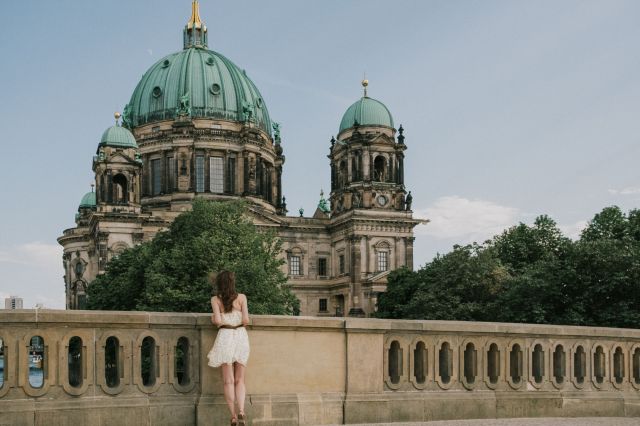
50 Awesome Things to Do in Berlin: Local Recommended!
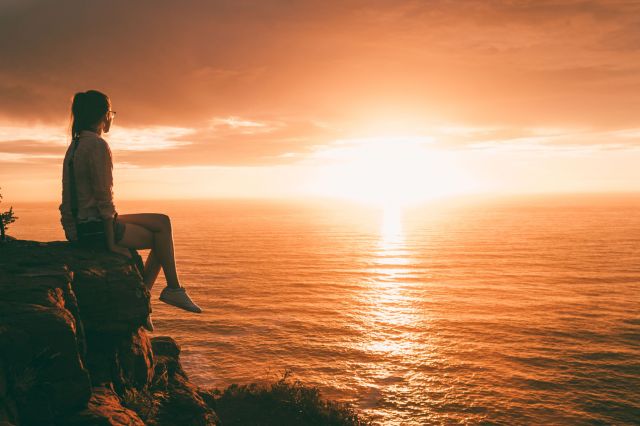
A Super Efficient 2-week South Africa Itinerary
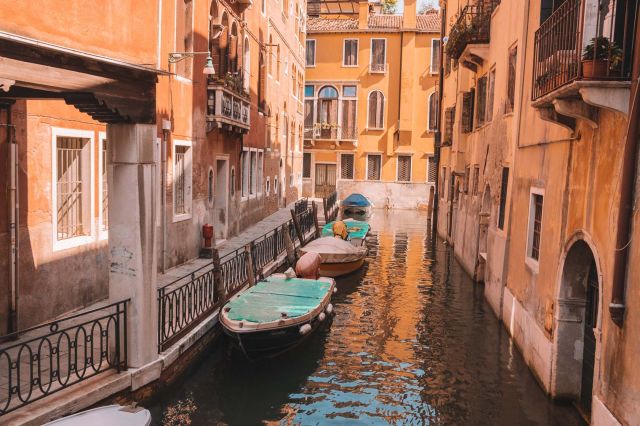
The Best Photography Locations in Venice

- Living In Croatia
- Croatian Recipes
- Balkan Recipes

Home > 43 Things To Do In Sofia, Bulgaria
43 Things To Do In Sofia, Bulgaria

Written by our local expert SJ
Sarah-Jane has lived in Croatia for 10+ years. SJ, as she is known, has been traveling the Balkans & beyond since 2000. She now shares her passion for traveling with her husband & kids.
Many people visiting Bulgaria focus on either the ski slopes or beaches, but there’s a lot more. Check out these fun things to do in Sofia.
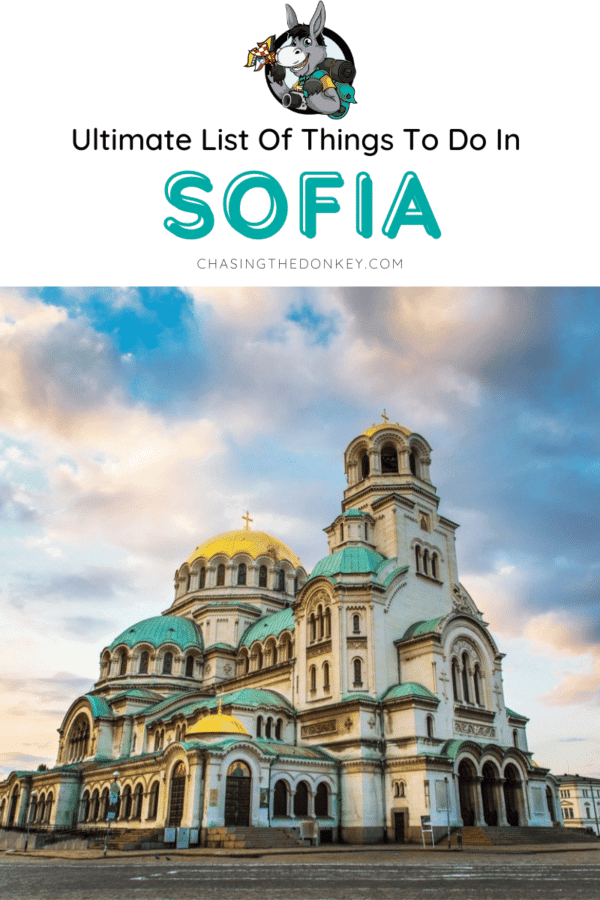
Over a century ago, Prince Ferdinand of Bulgaria aimed to make Sofia a fashionable capital city to the likes of nearby cities, Budapest or Prague. Walking the locally renowned yellow-bricked-tree-lined road leading to the National Assembly building, you will get a good idea of his vision.
Fortunately, although perhaps the city hasn’t reached the fashionable potential Ferdinand had in mind with matching standards of other European capitals nearby, it has reached its own unique, passionate, and quirky potential to do with culture, tradition, and art and is thriving with its distinctiveness.
There are numerous fun things to do in Sofia, which is growing into an enthralling capital in Eastern Europe. Some travelers swear this city to be the next Berlin because of its quirks, creative takes on culture, and the fact that the young generation has a tremendous impact on the city and what is happening within it. However, Sofia is on track to be whatever it wants to be, and there is no greater potential than that.
Skip Ahead To My Advice Here!
Sofia Is One Of Europe’s Most Exciting Cities
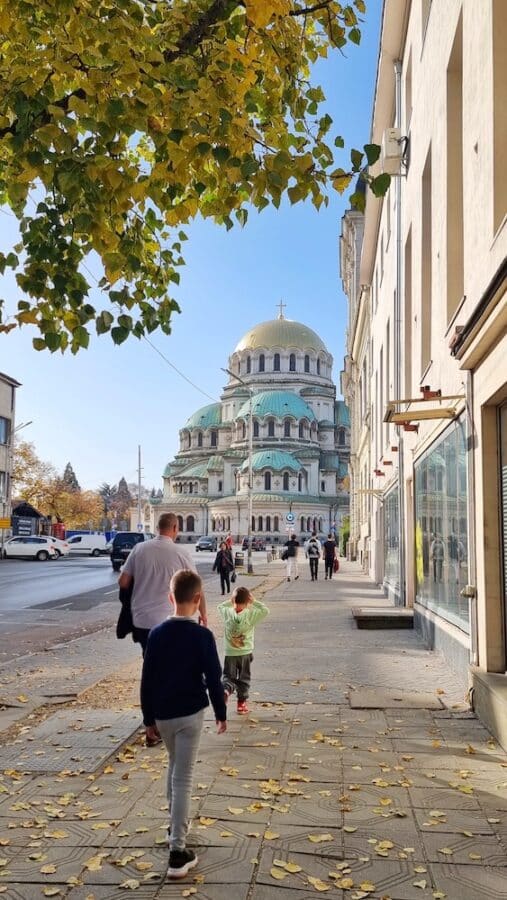
Tucked in the country’s western side below the impressive Vitosha Mountain, this city, full of 2,000 years of history it has endured by the Greeks, Romans, Ottomans, and Soviets, is one of the most special you will experience in Europe.
Many people visiting Bulgaria tend to focus on the ski slopes or the beaches, like Bansko and Varna . Sofia, the country’s capital, is often overlooked in the process. That’s really a shame. Sofia is an eclectic city with so much more to offer than most people realize, including being home to some of the best hotels in Bulgaria.
Sofia is situated in the very heart of the Balkan peninsula —equidistant from both the Black Sea and the Adriatic Sea—and is ancient. Archaeological evidence shows people have lived in the area for more than 9,000 years . Nowadays, it’s a thriving city with many different faces. There are plenty of fun things to do in Sofia, from great museums to Red Army monuments and iconic onion-domed churches to modern businesses.
On top of that, it’s one of the most affordable capital cities in Europe for tourists, with a great selection of accommodations for all budgets .
Entrepreneurs are also drawn to this vibrant and mostly modern city as it’s considered one of the world’s top ten cities for technology start-ups.
Long story short, this is a fascinating place to visit . It’ll surprise you, impress you and enchant you. Find out where to go in Sofia when you visit Sofia, Bulgaria , in this things to see in our Sofia city guide.
Best Places To Visit In Sofia, Bulgaria
Below is the all-inclusive list of best-known and alternative things to see and do within Sofia, Bulgaria, during your holiday :
Best Churches In Sofia
1. alexander nevsky cathedral.
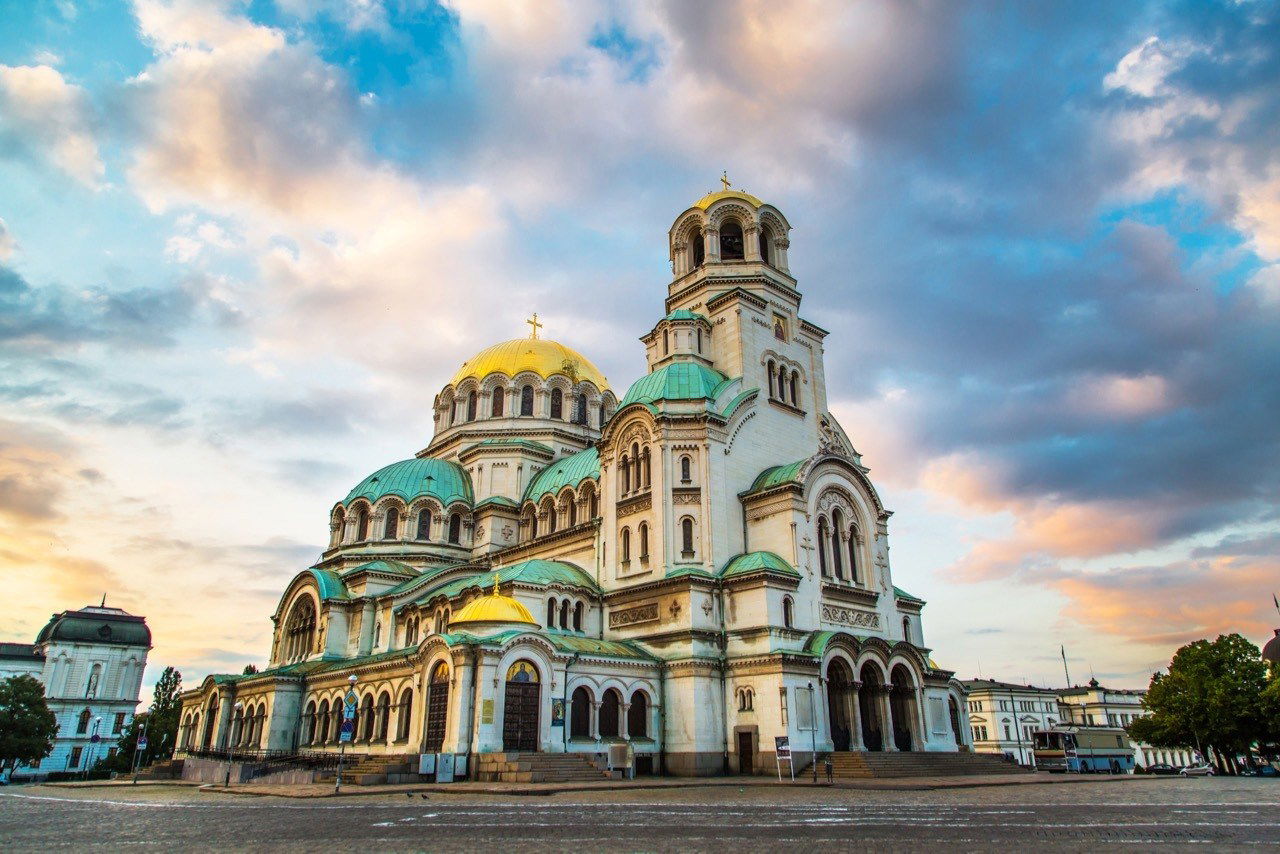
An enormous edifice with a capacity to hold 10,000 people, the Alexander Nevsky Cathedral is unquestionably the most iconic building in the city, the epitome of Sofia tourism, and one of the very symbols of Bulgaria.
One of the ultimate Sofia landmarks, it’s one of the world’s largest Eastern Orthodox cathedrals. Like much of Sofia’s imposing architecture, this cathedral also dates from the late 19th century.
If you’re figuring out what to see in Sofia in one day, this place should be the focal point of your Sofia trip itinerary .
2. St. Sofia Church
Its roots go back to the 6th century; St. Sofia Church is Sofia’s second-oldest church. Even though it’s a rather unassuming building—especially compared to other churches in the city—the St. Sofia Church is the church that gave the town its current name in the 14th century, making it one of the most significant places to see in Sofia.
You can visit the church and see what remains of the building’s foundation and tombs that date back about 1,500 years.
3. The Quadrangle Of Religious Tolerance
A rare area in the world today where four places of worship among four different religions gather and are peaceful with each other. The Orthodox Christian Saint Nedelya Church, the Sofia Synagogue, the Banya Bashi Mosque, and the Catholic Cathedral of Saint Joseph all sit within a hundred feet or so of each other.
On the same street (Knyaz Boris Street), be sure not to miss the Romanian Orthodox Church of Holy Trinity, and on the other side (Todor Alexandrov Blouveard), you will find St Mary Armenian Apostolic church. This is a unique chance to see how religions can coexist harmoniously and peacefully.
4. Church St. George Rotunda
In the center of Sofia, you’ll find this beautiful, small church dating back to the 4 th century. The church was originally built within the ancient city of Serdica as a Roman bath but was converted to a church later. It is now the oldest church in the capital and is made of attractive red brick with a domed roof.
The church is also part of a set of ruins, and behind the church, you’ll find old buildings, a former basilica, and a drainage system. Inside, you’ll find beautiful frescoes in excellent condition from the 12 th , 13 th, and 14 th centuries.
5. Sofia Synagogue
The largest synagogue in the Balkans and the third-largest in Europe as a whole, the Sofia Synagogue, can accommodate no fewer than 1,300 people. Its measurements are extraordinary, the main hall being 31 meters high and its central chandelier weighing 1.7 tons.
You can step inside to marvel at the Carrara marble columns, intricate wood carvings, and colorful Venetian mosaics. Also, don’t forget to visit the Jewish Museum of history, housed within this enormous synagogue.
6. Church of St. Nicholas the Miracle-Maker – Russian Orthodox Church
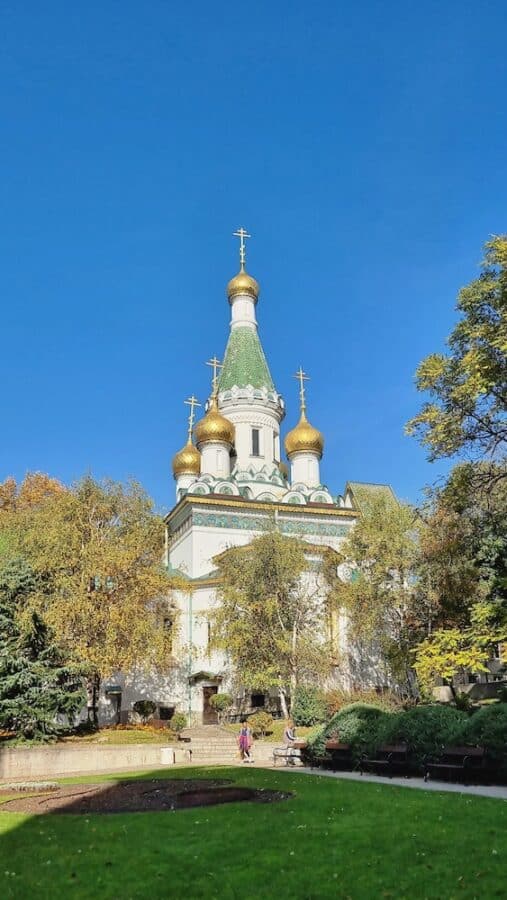
One of the prettiest sights in Sofia, no doubt about it. Aside from its beauty, you can also take the time and make a wish at the church. Open to people of all faith; all you need to know is where to go. Make your way to Georgi Rakovski Street and Tsar Osvoboditel boulevard and locate the Russian Church’s side door.

From there, make your way to the tables with pens and paper, write your wish and then drop it into the box. From there, you wait for your wish to be granted. My kids wished for a cat; what would you ask for?
7. Boyana Church
Another of Sofia’s many great churches, Boyana Church , is one of the major Sofia sights. This medieval Bulgarian Orthodox church lies outside the city center and is famous for its fresco-covered interior.
You can see no fewer than 89 different scenes, including 240 images of people. Because of this wealth of frescoes, the church was designated UNESCO World Heritage Site in 1979.
Best Historical & Cultural Sites In Sofia
8. serdica ancient complex.
A stone’s throw away from the Serdika Metro station, you will find the Serdica Ancient Complex, a must-visit for history buffs. Here you’ll discover the remarkably well-preserved remains of Serdica, the ancient Roman city.
The remains were found when the Metro was built in 2010, and you can see the outline of eight Roman streets, baths, houses, and a basilica that dates back to the 4th century.
9. Monument To The Soviet Army
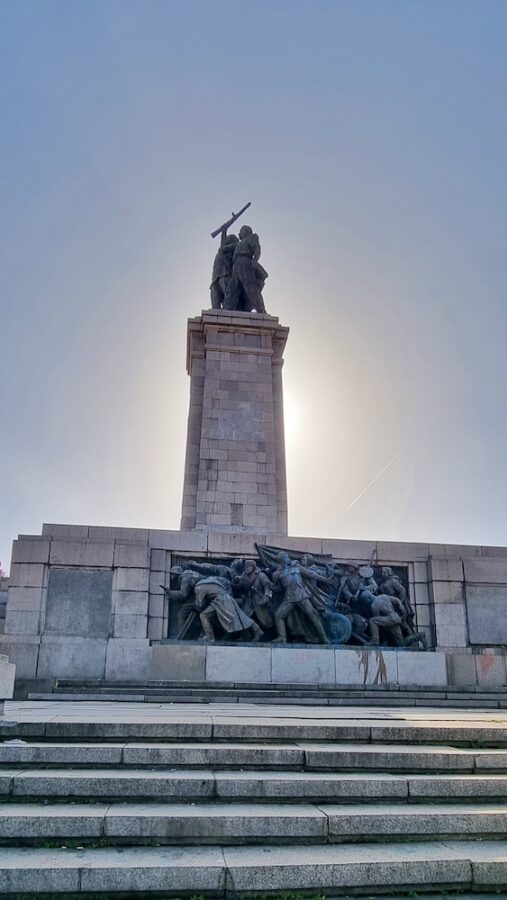
The Monument to the Soviet Army was constructed in 1954 as a form of gratitude of the Bulgarian government to the Soviet Red Army for protecting Bulgaria during World War II.
The monument depicts a soldier of the Soviet Army, a male worker, and a female Bulgarian peasant. The monument is located in the King’s Garden on Tsar Osvoboditel Boulevard, close to Orlov Most and Sofia University – the heart of the city – which means it is a popular place for young people to meet and hang out. It is also surrounded by a splendid park around the statue and surrounding area.
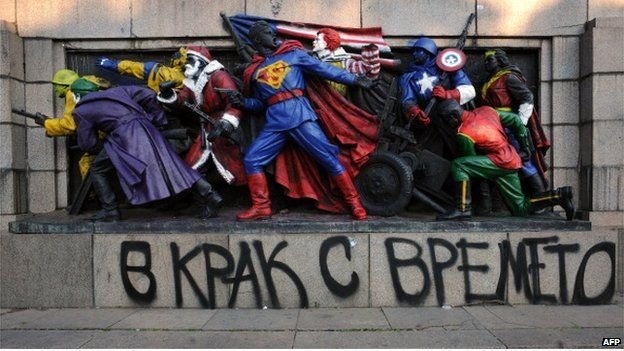
It has recently become somewhat of a canvas for local artists and graffiti vandals, and authorities have taken liberties in protecting the monument to reinforce good relations with Russia . It is easy to understand how locals (especially young Bulgarians) don’t appreciate what the statue commemorates or its message. The Soviets had a cold grasp on the country for so long.
10. Sofia Public Mineral Baths
Like many other major Eastern European cities, Sofia originated near or on top of natural hot springs . Arguably the greatest structure that commemorates this integral feature of Sofia is the Central Mineral Baths.
The current Sofia Public Mineral Baths building was constructed near the previous Turkish/Ottoman baths in the early 1900s. It features traditional Byzantine, Eastern Orthodox, and Bulgarian architectural elements and is one of Sofia’s most prominent landmarks. While the mineral baths are now closed, you can still fill your water bottle and taste try water.
11. Monument of Stefan Stambolov
Stefan Stambolov is one of the founders of modern Bulgaria and is a revered figure in the country. This monument is an important spot, and it is also located a stone’s throw from the site where he died, having been killed in the middle of the day by two assassins.
If you want to learn about Sofia’s history, visiting this spot and understanding the founding behind the modern version is essential.
12. Amphitheater Of Serdica
Before 2004, no one even realized that Sofia sat on what used to be one of the largest amphitheaters in the eastern Roman Empire.
The ruins of this colossal amphitheater lie in the heart of modern-day Sofia but were once one of the landmarks of the ancient Roman city of Ulpia Serdica.
Some of the ruins are now integrated into the Arena di Serdica Boutique Hotel, which has to be one of the coolest hotels in Sofia. Tourists can see the ruins free of charge.
13. The Largo

A visit to Sofia is not complete without a walk around Largo. This is the governmental heart of Sofia, and therefore of Bulgaria , comprising three so-called Socialist Classicism buildings. The Largo is regarded as one of the prime examples of this type of architecture in Southeastern Europe .
The collection of buildings consists of the former Party House, which now serves as the National Assembly of Bulgaria, a building housing the Council of Ministers of Bulgaria and the TZUM store, and a third building housing the Sofia Balkan Hotel , Ministry of Education, and the President’s Office. Other notable sites in Largo include the 4th-century Church of St. George.
Brands We Use And Trust
Best tours in sofia, 14. cook & eat with a local tour.
A huge part of visiting any location is trying the food. But eating food in a restaurant and eating food in a local home are two totally different things. This food tour means you can enjoy local, authentic food cooked by those who know while also learning how to cook yourself.
The tour comprises guided shopping, cooking, and tasting the dishes. You’ll get to make a local shopska salad and banista, and you’ll also be able to try local drinks, including rakia!
For those who love food, this is a great day out and a way to say you’ve truly experienced the ‘real’ Bulgaria.
15. Free Walking Tour Of Sofia
This tour will take you around the most popular Sofia attractions and will make you aware of what the city offers.
Around cities in Europe (especially capital cities), you may have taken a free walking tour guided by a local – usually a young adult or student – who has taken the time to study the city’s history and modern realities and is often an excellent source of local information.
In Sofia, it is no different, and the city offers an excellent free walking tour which meets every day at the Palace of Justice at various times depending on what time of year you visit the city. When I was there in summer, the tours ran at 11h, 14h & 18h.
The tour will take you past all of the most well-known attractions in the city center of Sofia and give you the most bang for your buck in terms of historical and present information.
If you would rather explore on your own, check out this self-guided audio tour of Sofia!
16. sofia communism tour.

Step back in time to experience Bulgaria, and specifically Sofia, during the time of communism. This historical 6-hour tour accommodates groups of 1-4 people and takes place in both the City Center and also on the outskirts of town.
Hop into a retro Chaika car and explore various sites around the city, including the Museum Of Socialist Art, the Bells Monument at the foot of the Vitosha Mountains, the purpose-built “Druzhba” neighborhood, the former office of the Communist party and the site of a bombing by the communist party in 1925 at St. Nedelya church.
You will also have a chance to pick up old communist relics at the market and eat at a local traditional restaurant during the tour (for an additional charge).
This tour is a great way to understand what everyday life was like for both the political leaders and residents of the time, as well as learning more about the influence and relations of the Soviet Union.
Book this tour or check out more excellent Sofia tours here!
Best parks in sofia, 17. the borisova gradina park.
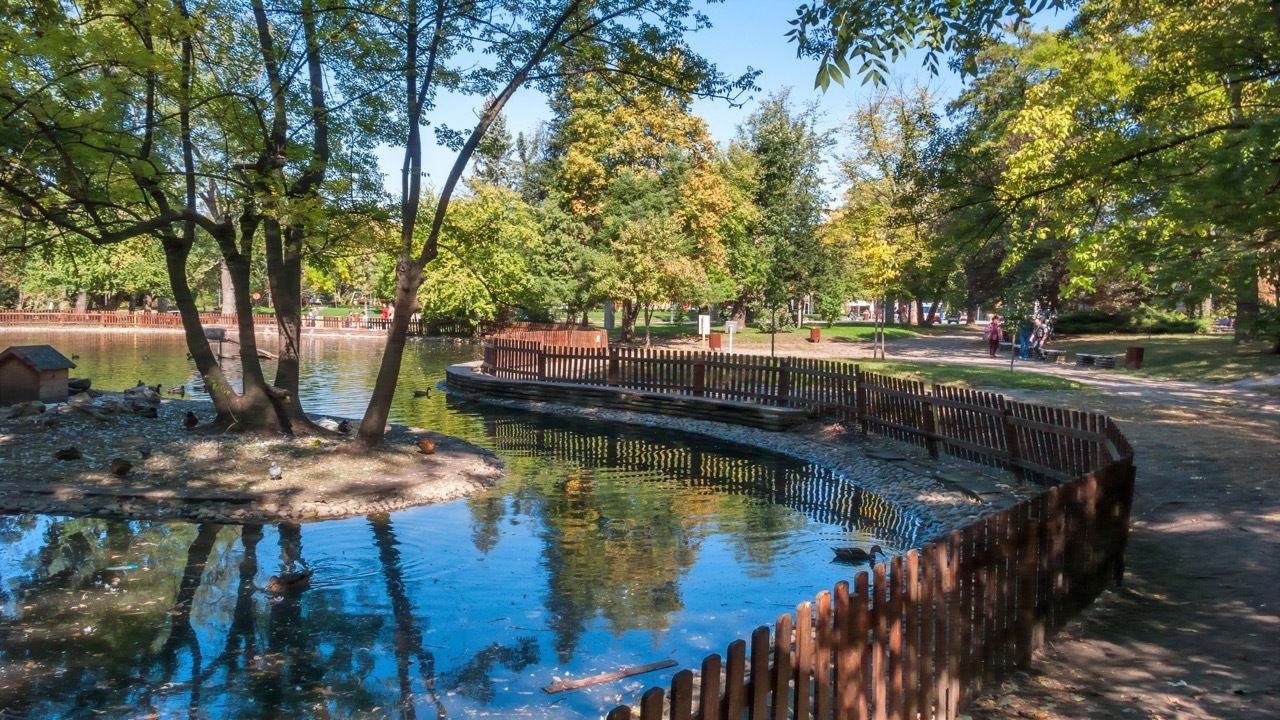
Many don’t know that Sofia is among the greenest capital cities in Europe . The Borisova Gradina Park is the oldest park in the city and is located at Sofia’s epicenter. Initially constructed on the park’s outskirts, it became centered in the town as the city grew.
It is also the biggest of the city’s four major parks. It takes a while to stroll through and will give you a nice breather from the city. There are ice cream vendors, restaurants, and bars nearby, and it is easy to spend a whole afternoon here!
You’ll find shady spots and plenty of sculptures to explore. It’s also a great place to let the kids run off some steam – much needed when sightseeing! During the summer, you’ll also find a large swimming pool, a lake , and sporting activities, such as football, tennis, and a cycling track.
18. Zaimov Park

The park is named after General Vladimir Zaimov and is easy to find as it is right by the Sofia Theatre. You’ll find many great fountains, statues, kids’ play areas, green spaces, and park benches here. The park is also close to one of the best restaurants in Sofia – Raketa! We got lost here for a while and found it relaxing.
19. Kristal Park
Located in front of the National Theatre, this is an excellent place to pair with your viewing of the iconic theater and can quickly fill an entire afternoon.
After long, cold winters being one of the highest elevated capital cities in Europe, the folks of Sofia are usually itching to get outside and enjoy the fresh air. Swing by in the spring and summer months in Bulgaria and participate in your picnic, people-watching, and getting to know Bulgarian customs as you mingle with locals and backpackers.
It is a great place to bring hostel mates as there is also a growing international vibe, with backpackers starting to show up at the park.
Tip: It is an excellent place for sunset, and more locals show up later in the evening anyway.
20. Vitosha Mountain Nature Park
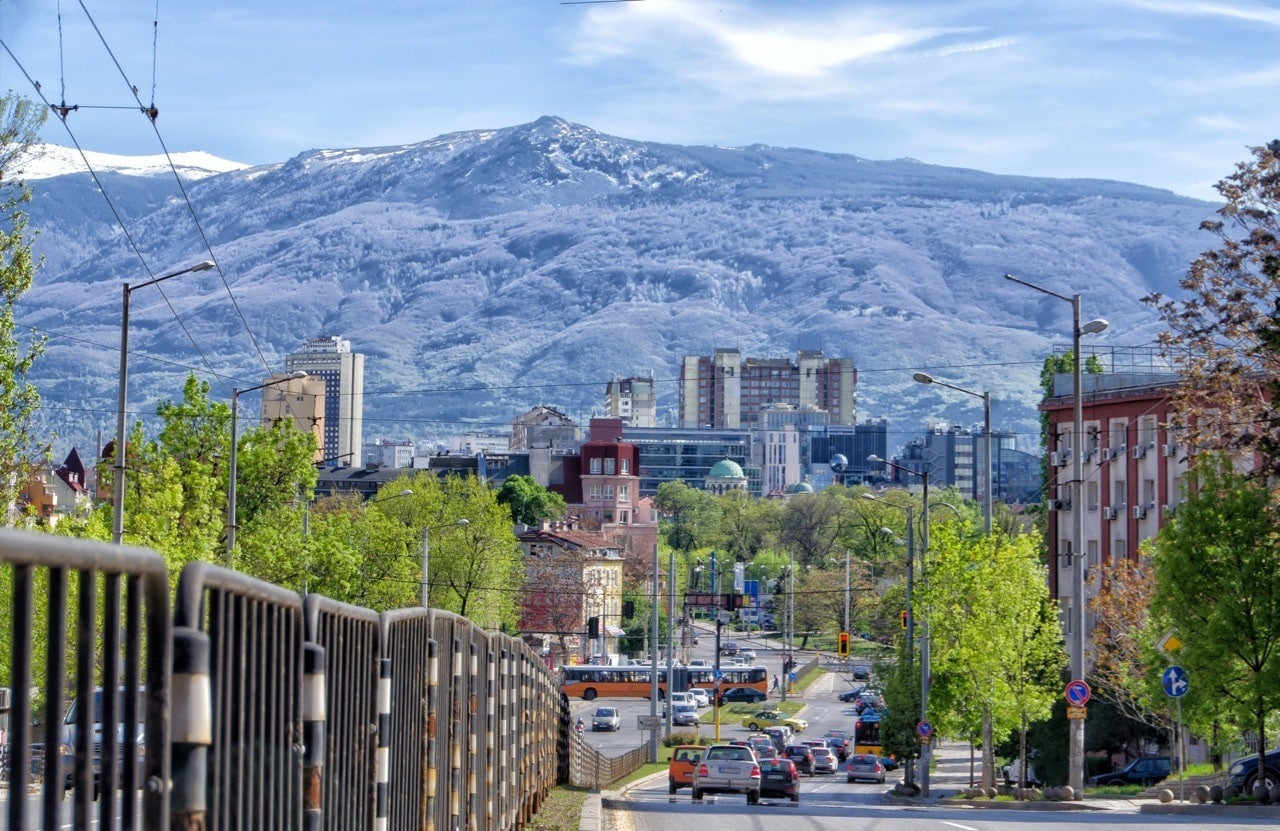
Located on the outskirts of Sofia, Vitosha Mountain towers over the city. Its massive dome rises 2,290 meters toward the sky and is Sofia’s most accessible ski destination. It will undoubtedly feel as though you have made it off the worn tourist track in Sofia once you’re up on this mountain.
It’s so large that it actually consists of many different peaks, ten of which reach more than 2,000 meters in height. This enormous mountain is also a nature park—the oldest one in the Balkans—and offers a wide variety of outdoor activities.
If you’re looking to escape the big city for a while, Vitosha Mountain is one of the best places to go in Sofia . Although many visitors know of the locally famous mountain, few take the time actually to hike up it. It’s easy to reach the top– no need to take an expensive tour with a guide or anything. Make your way toward the foot of Mount Vitosha using public transport (Bus 93 and 122 will get you there from the city center) and find one of many trails to start climbing.
If you’d like to do as little climbing as possible but still want to take in the excellent city views and breathe the fresh mountain air, Bus 66 will take you near the Aleko area, which is the highest you can climb using public transport.
Unfortunately, Sofia is also known as one of the smoggiest cities in Europe. So, hopefully, you get a clear day to take in the view. It may be the only European capital city with a large mountain nearby. Don’t miss your chance to explore nature so conveniently. Make a day excursion out of it!
Best Theaters & Performing Arts In Sofia
21. ivan vazov national theater.
One of the top Sofia tourist attractions, the Ivan Vazov National Theater, is Bulgaria’s national theater and the oldest theater in the country.
Located in the heart of the city, facing the City Garden, it’s named after famous writer Ivan Vazov, whose play “The Outcasts” was the first one that was performed in the theater after it opened. This imposing building, with its huge portico, is a major landmark in Sofia and Bulgaria, depicted on 50 lev banknotes printed in 1999 and 2006.
22. The National Opera & Ballet
Not only is this building pretty unique in terms of architecture, but it’s a cultural hotspot in Bulgaria, not just Sofia. Located in the city’s center, there are regular opera, ballet, and art performances. Be sure to check online to find out what performances are available during your stay, but even if you don’t get tickets, visit the building anyway.
Having been founded in 1890, this is the site of the first opera and drama company in Bulgaria.
23. The National Palace Of Culture
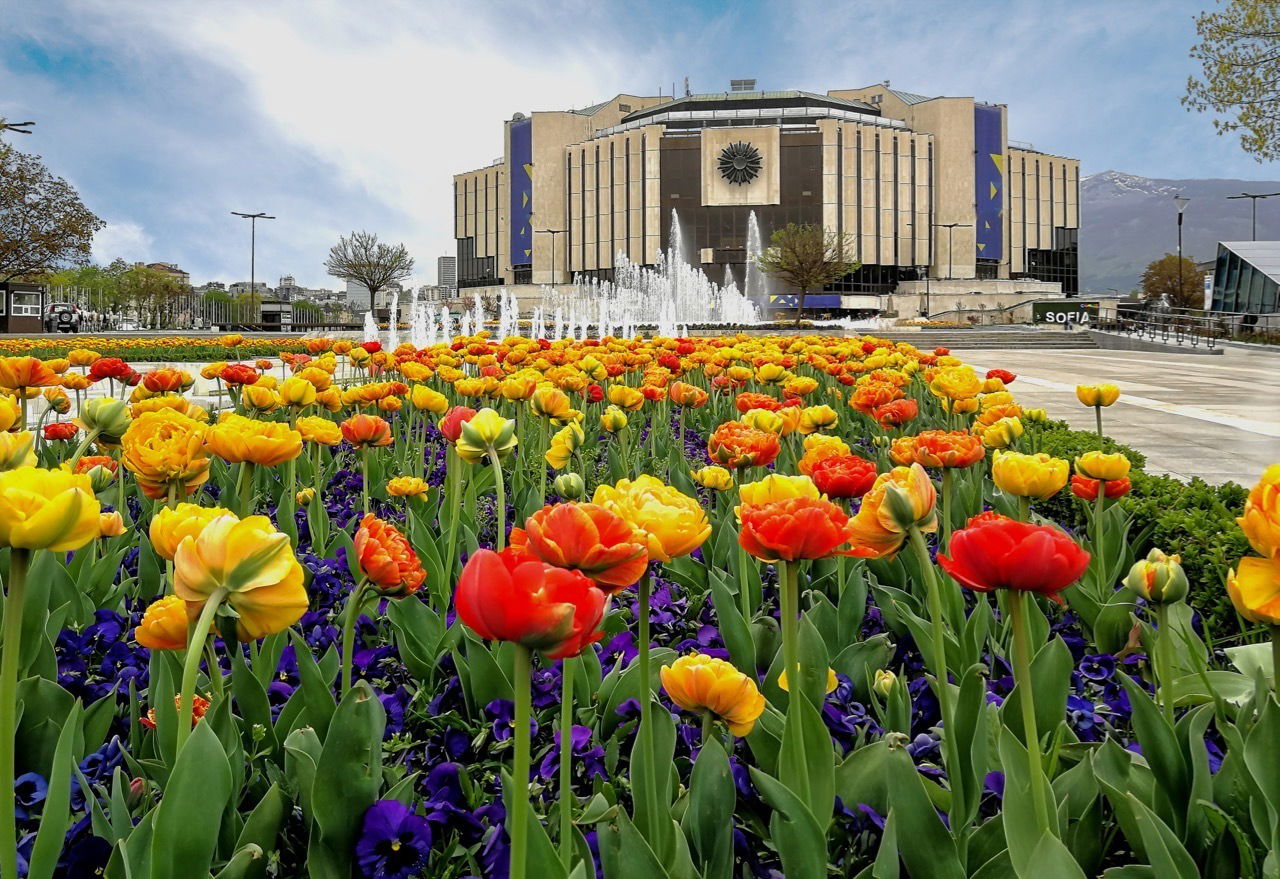
The heart of modern Sofia runs through the National Palace of Culture, built in 1981. This is one of the most well-known attractions on this list. Hosting events – anything from concerts of international pop stars to film festivals to art exhibits and fashion shows. Check the NDK (National Palace of Culture) website for details and prices of all the events at the event center while you are in Sofia, and try to check it out at least once.
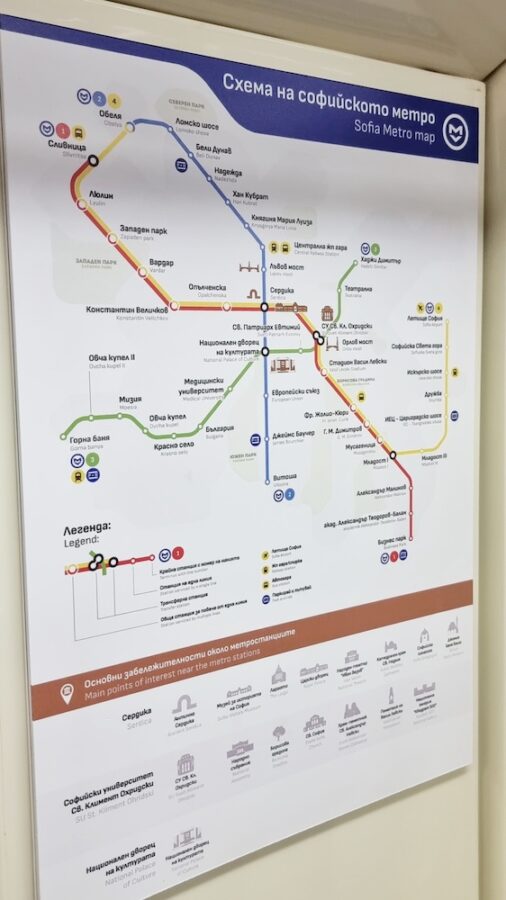
There are many ways to get to NDK via public transport: Bus 204/604, Trolley 5, Tram 1, and the Blue Line metro will all take you to NDK. Oh, and while we are talking about the Metro in Sofia, I can say that the experience is top-notch. We rode it to several locations costing just 4 LEV for the day!
Best Museums, Art Galleries & Street Art In Sofia
24. national institute of archaeology with museum (niam).
We know that Sofia is one of the oldest cities in the world, so it makes sense that you can find all types of archaeology. The National Archaeological Museum is a historically significant architectural landmark filled with fascinating exhibits that makes exploring easy, with everything in one place. The building itself is also pretty special.
The museum is housed within a former mosque, which was once the oldest Ottoman Mosque in the city. Inside, you’ll see examples of architecture dating back to Thracians and Medieval times.
NIAM exhibits cover the complete study of the culture of tribes and peoples who have lived in Bulgaria’s remote past up to more current times. Its displays showcase Bulgaria’s cultural heritage , spread across five exhibition halls—Prehistory, Middle Ages, Treasure, Central Hall, and a gallery for temporary exhibits.
Spend a few hours browsing through artifacts housed in the multi-leveled building, including tools, metal works, grave goods, gold & silver ornaments, ceramics, and art, all of which tell the story of this unique country’s history.
Discounted tickets are available for students and groups, and if you visit on the last Sunday of the month, admission is free for everyone.
25. Regional History Museum Sofia
Learning about history is much easier when everything is in one place. This museum is an excellent spot for those who want a thorough overview of Sofia’s history, dating back thousands of years. Inside you’ll find eight halls with various attractions and temporary exhibits from time to time. Be sure to check out King Ferdinand’s carriage and the Deed of Tsar Ivan Shishman, which is gold-sealed and dates back to 1378. The old neolithic home exhibit is also a great spot, referring to the 6th century BC.
26. National Museum of History
The vast National Historical Museum exhibits Bulgaria’s history, from prehistoric times to the nation’s communist era. With its 650,000+ artifacts related to history, ethnography, archaeology, and art, this is one of Sofia and Bulgaria’s most excellent museums.
The museum is home to both permanent and temporary exhibits and 59 thematic collections. The permanent exhibits walk visitors through the changes in Bulgarian land over time, with a special focus on the Neolithic, Bronze, Renaissance, and Middle Age periods. A beautiful exhibit of folk culture and costumes is also on display. Collections feature flags, fabrics, traditional clothing, weapons, jewelry, coins, and so much more!
You can explore the multi-level museum on your own or book a guided tour. Tours are offered in multiple languages (Bulgarian, English, French, German, Russian, or Japanese) and should be requested two weeks in advance so the museum can accommodate a guide who speaks the requested language. Special talks for children can also be arranged ahead of time if you are traveling with young kids .
Buses No. 63, No. 111, No. 304 (from Monday to Friday), and trolley bus No. 2 can all be taken to the museum from locations around Sofia.
27. Muzeiko Children’s Museum
Muzeiko is a children’s museum, one of the first of its kind in Bulgaria. Award-winning and super-modern, the museum is an excellent spot for children to learn while exploring – they won’t know they’re remembering! With many exhibits for all ages, it’s a great day out for all the family and a good option for a rainy day.
The museum takes you on a journey through time and space and has three floors that help you to explore the past, the present, and of course, the future.
28. Museum Of Socialist Art
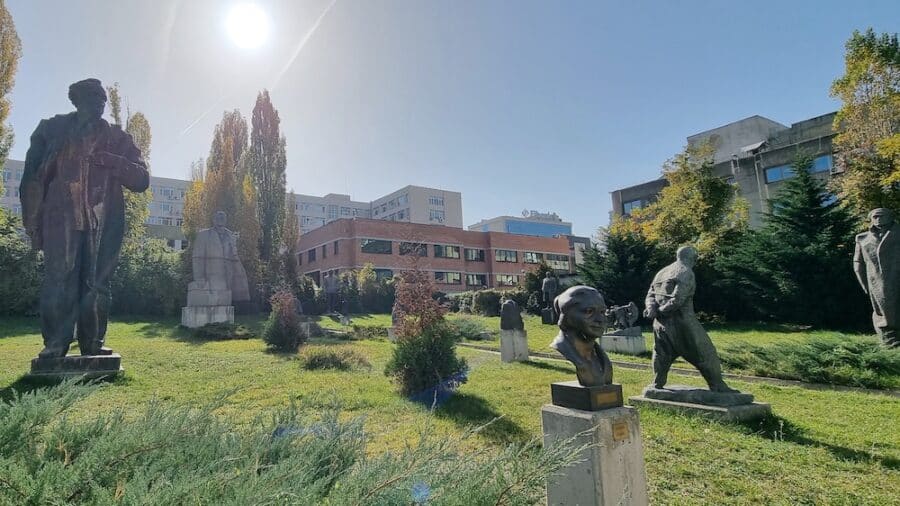
Displaying works of art from the period of Socialist rule in Bulgaria (1944-1989), this museum is definitely worth a short visit. It is home to an extensive sculpture garden featuring at least 70 works throughout the park grounds, including the large five-pointed star that once crowned the former Party House. It’s a great place to escape the city for a quiet art history walk.
Indoors, a rotating exhibit hall features easels and fine art based on themes from the era, showing various perspectives and interpretations of the period. Additionally, Socialist-era archival and documentary-style videos are shown in a separate room for a different type of visual experience.
The gift shop is a great place to pick up a piece of authentic memorabilia for those wishing to take a piece of history home with them.
29. National Art Gallery
If you want to immerse yourself in Bulgarian art, the best place to visit in Sofia is the National Art Gallery. Battenberg Square houses no fewer than 50,000 works of Bulgarian art, including the country’s most extensive collection of medieval paintings and superb National Revival and contemporary art pieces.
30. Local Street Art In Oborishte District
Not many tourists stumble upon this little gem of a neighborhood. It has an incredible repertoire of local eateries, artisan shops, and cafes, which is excellent for getting some work done. Not only that, but the entire neighborhood is filled with creative art on walls and sides of buildings which have become a theme for the area.
Arguably the best part of the neighborhood comes when you get north of Chavdar Bridge, where the density of building murals increases.
These aren’t just your ordinary graffiti artists, either. It is apparent from the sheer size of these murals that these local artists were contracted to bring this neighborhood to life. Some murals cover the entire length of the buildings, and the whole area feels like an open canvas.
31. The Big, Vibrantly Colored Snail House
Every bit of this unique building is of the anatomy of a snail , from its entrance doors symbolizing the snail’s mouth. It is as weird as it sounds , but it makes it a can’t miss!
Though this big colorful building is starting to show up on more internet travel lists, it is still (for the majority) unknown. Head here if only to grab a few photos of one of the most unorthodox residential apartment buildings you will ever see.
Located at Boulevard Simeonovsko Shose 187
Best Shopping & Markets In Sofia
32. shishman street.
Shop local culture at Shisman Street!
Though Shishman is prominent and popular, what you find on this street is the real treat. This street will keep your afternoon busy, whether it’s local art, food delicacies, local fashion, or other small trinkets and surprises.
Not only that, but a walk down Shishman Street will take you past a few of the larger landmarks in Sofia, like Patriarch Evtimiy Square and Sveti Sedmochislenitsi Church. You’ll find this street easily if you’re staying near the InterContentantal hotel.
33. Vitosha Boulevard
If you like (window) shopping, you want to take a stroll down pedestrianized Vitosha Boulevard. Many a Sofia travel guide says that this is the most important commercial street in Sofia, lined with restaurants, cafés and bars, fashion stores, and boutiques selling luxury products.
34. Bitaka Flea Market
Sofia may be chock-full of culture and history, but it has a lighter side. If you’d like some fresh air after spending hours in the city’s museums, consider going for a walk through the Bitaka Flea Market. This is easily the most interesting flea market/bazaar in the city.
Casually browsing the many stands is one of Sofia’s most relaxing and fun things. Vendors sell everything from jewelry, old cameras, and photos to watches, clothes , merchandise, and toys. Who knows what you might find?
35. Zhenski Pazar Women’s Market
The Zhenski Pazar Women’s Market opened over 140 years ago and is a bustling and vibrant spot even today. Here you can find everything you need and taste some of the most delicious fresh fruits and vegetables. You can also buy clothing, souvenirs, and spices .
The experience of walking through the market is like no other, with a colorful and exciting vibe. The market is also in the city’s center, so you can easily find it and make it a part of your day.
Where To Eat And Drink In Sofia
Eating and drinking are also among the best things to do in Sofia . They’ll enhance your travel experience tremendously, giving a fantastic insight into the local Bulgarian culture. Here are just a few suggestions to get you started.
36. Vodenitsata Restaurant
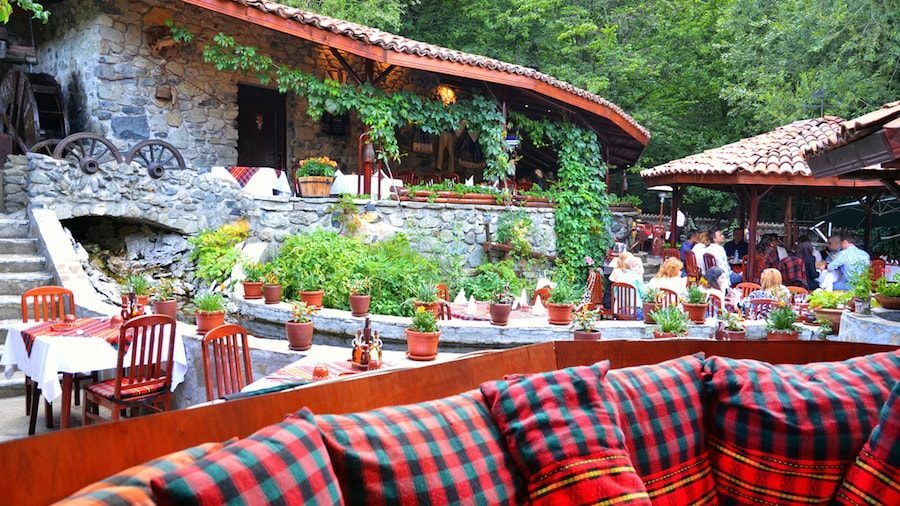
Eat traditionally, and watch culture at Vodenisata Restaurant. Located On Vitosha Mountain, the journey to get here is already worth your time, not minding the quality of the local food you are served. However, even the food is delicious! And you get more than a healthy serving size of any dish you order for a very reasonable and affordable price.
The restaurant’s interior design is traditional, and almost every night, you can witness a folklore program of traditional dances, costumes, fire dances, and other energizing performances.
It is one of the best places to go for a complete local taste of the city. Though, it will take you on an excellent ride to get there. Completely worth it!
Address: Kv. Dragalevtsi, Park Vitosha, Sofia | Website: Vodenisata Restaurant
37. Izbata Tavern
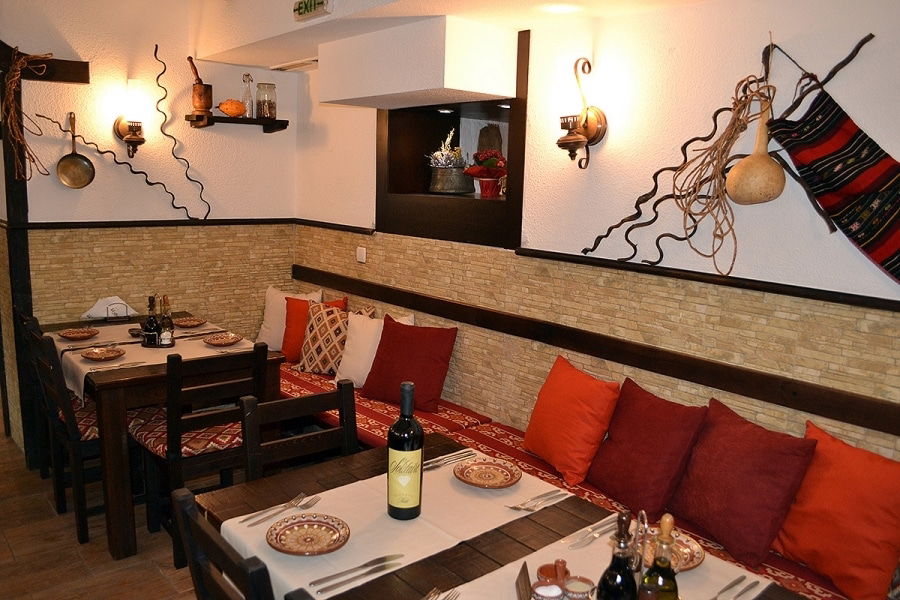
In the heart of Sofia, near the Alexander Nevski cathedral and the Parliament, this restaurant serves authentic Bulgarian cuisine in an invitingly traditional setting. Food is local, prices are low, and there is an option for an English menu should you need it.
A hearty selection of vegetarian and meat options are featured on the menu, and recipes for the dishes come from all over Bulgaria to give you a true sense of the country’s cuisine. Sip Bulgarian wine, beer, or rakia as you dine, and don’t forget one of the local desserts to polish off your meal.
Reservations can be made online ahead of time.
Address: ul. “ Slavyanska” 18 , 1000 Sofia Center, Sofia | Website: Tavern Izbota
38. The Hadjidragana Tavern

Housed in a building featuring old cellar decor, the atmosphere of this restaurant is unique and cozy. Upon entering, note the stone walls, old wooden barrels, displayed traditional Bulgarian clothing and wood carvings, all carefully selected.
Traditional recipes from all over Bulgaria are on the menu, and each day an entire lamb is roasted in a classic wood-burning oven. Plentiful options for traditional salads, meat platters, vegetable dishes, and desserts fill this menu , all made with local ingredients. In addition, the restaurant hosts an extensive wine list with many Bulgarian varieties.
On Wednesday through Sunday evenings, guests are treated to live folklore music, making this a place that’s incredibly fun to take kids along.
Be sure to call ahead for reservations.
Address: ul. “Hristo Belchev” 18, 1000 Sofia Center, Sofia | Website: The Hadjidragana Tavern
39. Raketa Rakia Bar

This trendy & funky bar, set in a Soviet-era building, feels like a museum and bar in one. Both pet and family-friendly, it’s a welcoming spot for all. Enjoy the Soviet-style interior and memorabilia as you relax at this local establishment.
It hosts an extensive selection of Rakija , as the name suggests, and is also a great place to grab a beer and a bite to eat, with local European dishes on the menu. And, as a bonus, if you like the spirits you try, you can buy them by bottle to take home with you!
Address: 17 Yanko Sakazov Blvd Next to Sputnik Cocktail Bar, Sofia 1000 | Website: Raketa Rakia Bar
40. Farmhopping Kitchen
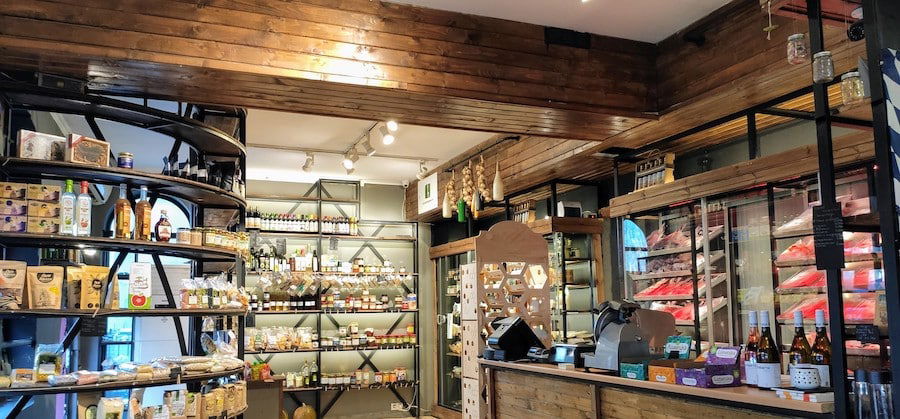
Head to Farmhopping Kitchen to enjoy authentic Bulgarian food produced by farmers who are members of the Agricultural Cooperative SIS Coop.
This hidden gem has a constantly changing menu as it specifically uses the freshest local ingredients in season. Diners will love the quality of the food, the excellent value for the cost, and the family atmosphere of the dining experience itself.
The fresh meat, wine from local producers, and homemade raki are all worth a special mention, but you can’t go wrong with anything on the menu. You might find yourself coming back again and again during your stay in Sofia!
Feel free to eat at the restaurant, order take out or have food delivered.
Address: Bul. “Patriarh Evtimiy” 44, 1000 Sofia Center, Sofia | Website: Farmhopping Kitchen
41. Shtastliveca

Shtastliveca is a small chain of popular restaurants, originally started in Veliko Tarnovo in 1997. The Sofia location is on the newer side, and the shabby chic and vintage decor of Europe’s 1930s will make you feel at home.
Two halls and a summer garden provide ample space for diners during both the lunch and dinner hours. The focus here is on traditional Bulgarian, or Balkans region, food, with a menu that lines up with the ingredients of the seasons.
In addition to tasty food, a good, extensive wine list will make any wine connoisseur happy to spend an evening here.
Address: Bul. “Vitosha” 27, 1000 Sofia Center, Sofia | Website: Shtastliveca
42. Mehana Mamin Kolyo
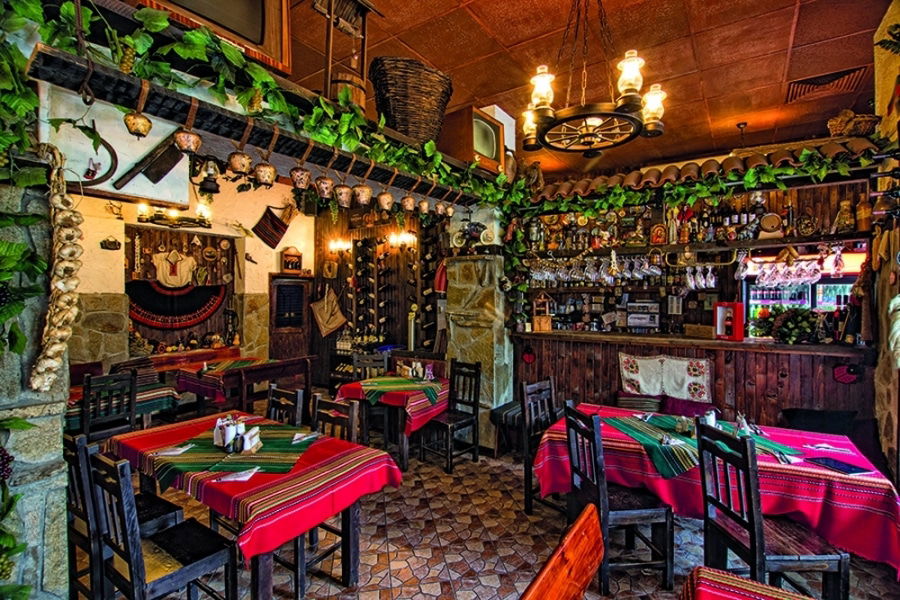
If you are looking for a spot where the locals eat, this is it! Here, you can unwind from the city noise, eating in either the summer beer garden accompanied by music or indoors with authentic decor and often dancing later in the night on the main floor, especially during the weekends.
Here you will experience authentic dining without the restaurant trying to be authentic. Portions are large, and the food can be heavy, so come on an empty stomach. Prices are moderate for the city, so it’s a good choice when looking for something a little less expensive.
If you are traveling with kids , the garden hosts a play space where they can get out some energy while waiting for dinner to be served.
Book a table online or order for delivery!
Address: ul. “Pozitano” 40, 1000 Sofia Center, Sofia | Website: Mehana Mamin Kolyo
43. No Matter Where You Eat – Try Rakia

Rakia isn’t unique to Sofia or Bulgaria , but they certainly have their distinctive take on it. I recommend trying Rakia in every city/country in the Balkan region of Europe.
In Bulgaria, plum and grape rakia is often mixed with various herbs, honey , sour cherries, and other ingredients to give it an individual taste different from other versions of Rakia you have tried in the Balkan region.
This fruity brandy is the national drink of Bulgaria and is popular among other south-Slavic countries.
Move This Adventure To Your Inbox & Get An Instant Freebie

No spam. Unsubscribe at any time.
Visit Sofia Bulgaria, And Revel In Its Quirks!
Sofia is one of the most unique cities in Europe, and it is only a matter of time before the rest of the European tourists catch on to this secret and crowd the city. Beat them to Bulgaria to witness all of the existing culture and traditions that are often lost to major tourism. Now is your time!
As Berlin is to Germany, Sofia is the real heart of the country, and it is easy to recognize it provides life to the rest of the country. There is something special about this city you must see to understand!
So, tell us – will Sofia, Bulgaria, make it on your travel itinerary this year?
- Things To Do In Bulgaria
- Things To Do In Sofia
- Best Day Trips From Sofia
- Things To Do In Varna
- Bansko Ski Resort
- Bulgarian Festivals
- Rent A Car Bulgaria
- Most Beautiful Caves In Bulgaria
- Best Campsites In Bulgaria
- Where To Stay In Nessebar
- Best Time To Visit Bulgaria
- Where To Dive In Bulgaria
- 5-Day Travel Itinerary Through Bulgaria
Comments (3)
A fantastic article, a wonderful blog!
I enjoy reading your travel blog, each time i want to just pack my bag! Now, I feel ready for a dose of Bulgaria.
Leave a Reply Cancel reply
Your email address will not be published. Required fields are marked *
Save my name, email, and website in this browser for the next time I comment.
This site uses Akismet to reduce spam. Learn how your comment data is processed .
Subscribe To Unlock Your FREE Customizable Travel Packing List & All Our Best Tips!
Understand [ edit ]

Sofia was founded around 2,500 years ago. Over the centuries, it has had several names: Serdika, Sredets and the remains of the old cities can still be viewed today. Near Sofia lies Boyana church, which is one of the most valuable memorials of Bulgarian and European culture. The church has frescoes, acclaimed by specialists as the best examples of eastern medieval art from the 13th century AD. The decline of Sofia during the Turkish Ottoman Empire was followed by the rejuvenation after the Russian liberation in 1878, when Sofia was chosen as the capital of Bulgaria at the First National Constituent Assembly, and followed by a brisk and straightforward period of construction.
- Visit Sofia tourism website
Get in [ edit ]
By plane [ edit ].
Over 20 airlines operate service to/from Sofia, with direct flights to/from Athens , Paris , Vienna , London , Rome , Amsterdam , Munich , Warsaw and other European cities. There are also domestic flights from Varna and Burgas .
Along with traditional carriers, some low-cost companies serving Bulgaria are EasyJet (to/from London-Gatwick, Madrid, Manchester) and Wizz Air (to/from Paris-Beauvais, Barcelona, Brussels-Charleroi, Dortmund, Eindhoven, London-Luton, Milan-Bergamo, Rome-Fiumicino, Valencia) and RyanAir. Bulgaria Air , the national carrier operates service to/from Alicante , Amsterdam , Athens , Barcelona , Beirut , Berlin , Brussels , Bucharest , Frankfurt , Istanbul , Larnaca , London (Gatwick & Heathrow), Madrid , Málaga , Manchester , Palma de Mallorca , Paphos , Paris , Rome , Skopje , Tel Aviv , Tirana , Tripoli , Valencia , Vienna and Zürich .
Budget airlines including EasyJet, Eurowings and Wizz Air operate from Terminal 1, while the traditional carriers including Bulgaria Air but also Ryanair operate from Terminal 2. There are shops, cafes, post offices, ATMs, and money exchange offices at the airport. For more details, see the airport website [dead link] .
There is a free shuttle bus operating between Terminals 1 and 2 every 15–30 minutes between 05:00 and 23:00. Outside of those hours, a free shuttle bus can be requested at the information desk or you can use Busses #84 or 184 depending on direction (see below). After midnight you might asked to book a cab for such ride.
To travel between the airport and the city centre:
- Sofia Metro Line 4 (Yellow) operates service to the airport between 05:30 and 24:00. The stop is next to Terminal 2 (leave the building and go east). The journey to the city centre takes 20–30 minutes. The journey to the central bus station takes approximately 35 minutes and a transfer is required. A single ticket costs 1.60 лв. You no longer need an extra ticket for each piece of large luggage. You can also buy a day ticket for all modes of public transport for 4 лв. The access gates as well as some ticket vending machines also accept credit cards and payment apps such as Apple Pay.
- Public Busses #84 and 184 operates service between both terminals and the city centre. The journey takes 30–40 minutes. Tickets can be purchased from news stands or ticket machines in the airport as well as by contactless payment aboard. A single ticket costs 1.60 лв. An extra ticker for large luggage is no longer needed. The bus makes a stop at Orlov Most (Sofia University metro station), where you can transfer to the metro.
- Taxi service from the airport is regulated. OK Supertrans AD is the only contracted taxi operator from the airport. It is best to request a taxi either from the taxi stand to the right when you leave the arrivals area or the taxi office right adjacent to the exit from the baggage reclaim. Beware of touts offering taxi service as well as non-contracted taxis with the fake "OK" logo which usually wait in front of the terminal instead on the official taxi rank besides it. A taxi to the city center will cost approximately 15 лв. The regulated taxi fare is: initial fee of 0.70 лв, price per km 0.79 лв in the day or 0.90 лв at night, price per minute of stay of 0.22 лв, price for ordering a taxi via phone of 0.50 лв. You can also use the Ridenow Taxi app .
By train [ edit ]
Trains run to Sofia from all the major cities, including the seaside resorts of Burgas and Varna . In any case, leaving by train is mostly recommended if you want to travel overnight to destinations on the Black Sea, since trains for Varna and Burgas will leave late in the evening and get you there in the early morning (a couchette to Varna is 16 лв).
Timetables can be found at the website of Bulgarian State Railways .
International [ edit ]
From Romania , a train runs daily from Bucharest at noon, taking ten hours; the return train leaves Sofia at 09:00. June to Sept this is a through-train, Oct-May you have to change at Ruse on the border. There's no longer an overnight train.
From Greece , a train runs daily from Thessaloniki at 07:00 reaching Sofia by 14:20; the return train leaves Sofia at 15:00 to reach Thessaloniki (shown on departure boards as "Solon") for 22:20. You need to stay there overnight for connections to and from Athens, Piraeus and the ferries to the Greek islands.
From Turkey , a sleeper train departs Istanbul Halkalı at 21:40, running via Edirne, Kapikule on the border where you get out for passport control, and Plovdiv, to reach Sofia by 09:00. The eastbound train leaves Sofia at 18:30 to reach Istanbul for 05:40. Fares are quoted in euros: in 2022 you pay €31.68 for the basic single from Istanbul. Add €10 for a couchette, €15 for a bed in a shared 2-person cabin or €35 for the entire cabin.
From Serbia , from mid-June to mid-Sept a direct train runs daily between Belgrade Topcider and Sofia, taking ten hours. However the Budapest-Belgrade line is disrupted throughout 2022 for engineering works, so it is difficult to reach Bulgaria from western Europe by train.
By car [ edit ]
The motorway network in Bulgaria is still under construction.
Access to Bulgaria's capital is via several entry points:
- From the north (Vidin) & south (Thessaloniki) via E79.
- From the east - via Thrace Highway E80/A1.
- From the west - from the Bulgarian-Serbian border point of Kalotina.
The following motorways heading for Sofia are already in service:
- A1 connects Sofia to Burgas and the Black Sea coast, as well as Istanbul.
- A2 ends about 80 km from each city; the rest of the route is a regular 2-lane road. Extensions into the cities are planned.
- A3 is planned to be from Sofia to Thessaloniki, about 2/3 of the route is already in service.
Coming from North Macedonia, via Kyustendil the roads are relatively good but driving within speed limits would avoid you much hassle caused either by traffic police, or road conditions. From Central Europe you can drive almost the whole length on highways (via Slovenia-Croatia-Serbia or Hungary-Serbia), with only the last 100 km between Niš in Southern Serbia and Sofia being heavily trafficked mountain roads around the Nishava ravine in not the best shape.
Get around [ edit ]
By public transport [ edit ].

Sofia has a well-developed, cheap, and efficient public transport system [dead link] that consists of buses, trolleybuses, trams, and subway lines. The transport network can be confusing for visitors who do not know it well, but there is a journey planner . The public transport operates from 05:00–23:00. Taxis are the only transport option in the night.
The price of a single ticket is 1.60 лв only paid in the local currency cash. There are also daily travel cards (4 лв). Tickets and daily cards can be bought at most newspaper stands especially ones adjacent to public transport stops. If you can't find any, you can almost always buy tickets from the driver, though not guaranteed. Always punch a ticket immediately after entering the vehicle, using the yellow "thing" between the windows. The inspectors rarely understand English and you might have problems with them if you travel without a ticket or if you forget to punch it. Inspectors ambush and board buses and trams in groups (and their attitude is generally not friendly at all), sometimes accompanied by police, and make no exceptions. The fine is 40 лв (which is the inspector's price of a ticket for your current trip, so you can use your unvalidated ticket on another bus.)
Tickets can also be purchased using contactless bank cards and payment apps such as Apple and Google Pay ( Visit Sofia , which might be the easiest solution for foreign visitors. In the metro, the ticket gates have a contactless symbol indicating the location of the reader (it's on the left side, not the right). On buses and trams, there are blue electronic readers with the same contactless symbol. Contactless purchases will be capped to the cost of the daily travel pass. Visit Sofia states: "If you travel more than three times during the day, from 16:30 to 00:00, including a combination of ground transport, the system automatically charges a daily pass price of 4 лв, regardless of how many times you used public transport. The only condition is to use the same bank card throughout the day and for one person only."
The day ticket needs to be shown to the person at the ticket office before every metro trip, as they are supposed to check the date stamp (manually applied at the time of sale) before activating the ticket barriers to accept it. If you are staying for 4 or more days, or 3+ days and arriving directly in the city centre, you can also buy a 3-day ticket on an electronic card from the public transport offices (not from metro stations or at the airport) for 10 лв + 2 лв card fee.
There are 15 tram lines, 9 trolley lines, 93 bus lines and 3 metro lines. Some of the buses cover the area outside the city centre including neighboring villages. Useful routes are bus #84 from both terminals of the airport to the center; from the train/bus station to Orlov most - bus #213 or #214 or tram #1, #7 and #18 to Vitosha Street and Sv. Nedelya Square, #1, #6, #7 to the National Palace of Culture, #18 to Slaveykov square or #6 to Macedonia square.
The subway in Sofia is still under construction and more lines will be available in the next years. There are two lines: one that crosses from the western edge of town (Lyulin, Obelya) through the city centre, the southeast (Mladost) and the airport; and a second one, that crosses from the northwestern neighbourhoods (Obelya, Nadezhda), through the central train and bus stations and the city centre, to the southern part of the city (Khladilnika). Trains operate two routes which each involve a combination of both lines . This may become more confusing as the system expands.
On foot [ edit ]
Streets have adequate tiled pavements, especially in the city centre. However, they are frequently uneven and potholed, and walking is further made difficult by parked cars, street vendors and cafes. Except for areas in the very centre, pavements rarely have slopes for wheelchair access or designated lanes for bicycle riders. Pedestrian crossings are numerous and are relatively respected by drivers. Use pedestrian underpasses to cross large intersections, though avoid ones in the suburbs as these are usually derelict.
By mini-bus [ edit ]
Mini-buses (marshrutki) stop if you just wave a hand and are usually fast way to go somewhere without need to change the car, but they aren't common anymore. You pay to the driver when you get on the car. Prices are 1.50 лв. You must tell the driver if and when you want to get off.
By bicycle [ edit ]
Sofia is one of the greenest capitals in Europe, with the big park zones ideal for biking. Slow traffic in downtown is perfect for cycling. On a bike you will save time and will enjoy sport activity. Sofia also has a few bike paths around the downtown area and in districts such as Mladost, Nadezhda, Hipodruma. Be careful as many cars double park and may open doors without noticing you. Rent a bike ) Bike rental operates 10:00-20:00 (April to November). Discover Sofia by bike map or joint to an experienced bike guide.
See [ edit ]

Sofia is one of the oldest cities in Europe and has ancient ruins throughout the city center. In the administrative center of Sofia, the streets are covered with a specific yellow pavement. It was laid in the beginning of the 20th century and were a present to the Bulgarian Tsar Ferdinand for his wedding from the Austria-Hungarian royal family.
Mineral springs [ edit ]
Sofia was founded because of the quality of its mineral waters. In the city, there are 7 independent mineral water springs . One of the springs is in the central area of the city and is accessible for everybody - cross the square behind the mosque, next to TSUM (the intersection of Iskar and Ekzarh Yosif streets).
Museums [ edit ]
- 42.693911 23.319845 9 The Red Flat , 24 Ivan Denkoglu str., Sofia , ☏ +359 98 825 2032 . Daily 10:30–19:30 . Half tour, half experience. Walk around a house setup like an old communist flat from the 1980s. You're allowed to touch and play with just about anything. There's an audio guide in English, Spanish and Bulgarian. 18 лв . ( updated Apr 2023 )
- Museum of Paleontology and historical geology , 15 Tzar Osvoboditel Blvd ( Inside Sofia University. ), ☏ +359 2 930 82 00 .
- National Ecclesiastical History-Archeological Museum , 19 Sveta Nedelya Sq. , ☏ +359 2 988 13 43 . 09:00 to 17:00 .
Galleries [ edit ]
Churches [ edit ].

- 42.6965 23.3315 19 Hagia Sophia Church , 2 Paris str. . It is across the square and to the right from the Aleksandar Nevski Cathedral. It was built in the 6th century over an even older church. It is a witness of the whole Bulgarian history and is a valued cultural monument. In the 14th century it gave its name to the city of Sofia. It was destroyed several times and during the Ottoman rule it was used as a mosque.
Other places of worship [ edit ]
Historical buildings [ edit ].

- Knyaz Battenberg's Palace ( Right in front of the city garden. ).
Monuments [ edit ]
- 42.69628 23.33053 30 Tsar Samuil Monument . A statue of the Bulgarian warlord and tsar Samuil, who ruled Bulgaria between 997 and 1014. ( updated Jul 2016 )
Open spaces [ edit ]
- 42.6879 23.3196 37 Park National Palace of Culture . ( updated Jul 2016 )
Parks and gardens [ edit ]

- 42.6739 23.3086 41 Yuzhen Park (South Park) . A nice park in the south-east part of the city, although a bit too crowded on weekends. Vibrant with open area cafes, entertainment for children and grown-ups, and a few ponds with ducks.
- 42.697433 23.342042 42 Oborishte Park , Yanko Sakazov blvd . A park near the center of the city with places to eat and drink. Also known as "Zaimov Park". ( updated Jul 2016 )
Bridges [ edit ]
Other sights [ edit ].
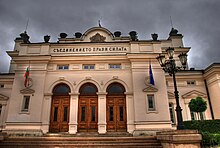
- 42.6942 23.3327 45 National Assembly of Bulgaria , 2 Narodno Sabranie Sq. , ☏ +359 2 939 39 , fax : +359 2 981 31 31 , [email protected] .
- 42.69354 23.33526 46 Sofia University , 15 Tsar Osvoboditel Blvd , ☏ +359 2 9308 , fax : +359 2 946 02 55 .
- 42.6173 23.3348 52 Snail House , Boulevard "Simeonovsko Shose 187, 1434 Simeonovo . Novelty architecture. ( updated Jul 2019 )
Do [ edit ]

- 42.66044 23.38229 2 Arena Cinema . One of the biggest Bulgarian cinema multiplex. Cinemas in Sofia play all films except children's films in their original language with Bulgarian subtitles.
- Sofia Bike Tour , Dyacon Ignatiy, 5 ( Start Point: National Theater "Ivan Vazov". ), ☏ +359 885523630 . April–November . Visit Sofia and the countryside around on a "free" bike tour, every day at 11:00 and 17:00. Note, for the ride you will need to rent a bicycle with the tour operators. And like always, the word "free" is a euphemism for "tips strongly appreciated". Also, this tour might in addition be a way to market their chargeable tours; always compare before committing to anything.
- Playgrounds . If you're travelling with kids, they might love playgrounds. The "rich" one is in the park that holds Vasil Levski stadium (close to the corner with Orlov Most; there are actually two playgrounds close to this corner and you'd look for the one more inside the park).
- Football – The men's national football team plays at Vasil Levski stadium (capacity 43,000) 1 km southeast of city centre. Five city clubs play in First League, Bulgaria's top tier:
- CSKA Sofia play at Bulgarian Army Stadium (capacity 23,000) just south of the national stadium.
- CSKA 1948 were formed in 2016 after a bust-up at CSKA Sofia. They play at Stadion Bistritsa (capacity 2500) 15 km south, and shared with Septemvri in the Second League.
- Levski Sofia play at Stadion Georgi Asparuhov (capacity 25,000, aka Vivacom stadium) 3 km east of the centre.
- Slavia Sofia play at Alexander Shalamanov Stadium (capacity 25,500) 4 km southwest.
- Lokomotiv 1929 play at Stadion Lokomotiv (capacity 17,500) 4 km north.
Vitosha [ edit ]

A magnificent landmark mountain very popular with the locals and rising just south of the capital. It is easily accessible by public transportation, bus 63 (from stop Tsar Boris III ) or 66 (from Metrostantsiya Vitosha metro stop), or by car. Day trips in Vitosha on a sunny day are highly recommended.
In the winter, it is well suited for skiing [1] and its proximity allows one day ski-trips; in the summer it is great for hiking. A great way to spend few days in Sofia, being on its "balcony," enjoying sunny days on the mountain with a spectacular view on the capital. So going to Sofia provide gives you a unique chance to witness the rare symbiosis of the metropolitan city with its nature park.
Buy [ edit ]
It is strongly advisable to skip exchange offices on the street and use exclusively banks for exchanging money. Some exchange stalls will try to scam you by buying your currency at very unfavorable rates. See Bulgaria#Money for exchange rates.) It's also possible to change money at a good rate in casinos if you play there.
ATMs are widely available and accept all major credit cards (Visa, MasterCard, Amex, Diner's, etc.), although you have to check your daily limit with your bank. ATMs will let you withdraw at most 400 лв in one go, but if your card limit allows it, you can make two or more withdrawals.
Credit cards are widely accepted in larger stores and supermarkets, but in small souvenir shops or restaurants you will definitely need to carry some cash.
Souvenirs can be bought many small shops in the subways in front of the old Party House and in the metro station at the Largo. The Ethnographic Museum has a small shop tightly crammed with souvenirs of all kinds from all over Bulgaria (on the right, just as you enter the main entrance). Antiques and souvenirs can also be found in Aleksandar Nevski square, in stalls just opposite the church.
- Vitosha Boulevard . It`s the main commercial street in the centre of Sofia. Its pedestrian part is a popular place for walks. It is known as the most expensive street in Sofia.
- 42.6606 23.3824 1 The Mall , 115 Tzarigradsko Shose Blvd ( Many bus lines stop at THE MALL. Choose between bus no. 1, 3, 5, 6, 76, 84, 114, 204, 213, 214, 284, 305, 306, 313 and 604. ). 10:00 to 22:00 . a convenience store, Largest shopping mall in Bulgaria; contains also a Carrefour store, large Arena cinema, a lot of cafes and restaurants, etc.
- 42.6999 23.3221 2 Central Sofia Market Hall , Knyaginya Maria Luiza Blvd ( Opposite the Banya Bashi mosque. ). Has many stalls selling all kinds of food, drink and cosmetics. The second floor has various fast-food cafés. As of early 2023 closed for renovations. .
- 42.6983 23.3226 3 TZUM , 2, Knyaginya Maria Luiza Blvd , ☏ +359 2 926 07 00 , [email protected] . 10:00 to 21:00 .
- 42.6983 23.3091 4 Mall of Sofia , 101, Aleksander Stamboliyski Blvd , ☏ +359 2 929 33 77 , fax : +359 2 929 33 00 . Contains a Piccadilly store and a Cinema City multiplex.
- 42.6789 23.3209 5 Park Center , 2 Arsenalski Blvd., floor 3 , ☏ +359 2 865 72 85 , fax : +359 2 865 71 37 .
- 42.6798 23.3676 6 SkyCity Mall , 52 Kosta Lulchev Str. ( You can get there by tram No 20, bus No 9, and Route Taxi No 1, 19 and 21. ), ☏ +359 2 971 02 13 , fax : +359 2 971 01 89 , [email protected] . 10:00 to 22:00 . Also has an entertainment center.
- 42.6911 23.3538 7 Serdika Center Sofia . Contains a Piccadilly store.
- 42.6451 23.3926 8 Sofia Outlet Center .
- 42.6641 23.2888 9 Bulgaria Mall .
- 42.6582 23.3152 10 Paradise Center . Largest shopping mall in Bulgaria; contains also a Carrefour store, large Arena cinema, a lot of cafes and restaurants, etc.
- 42.6245 23.3527 11 Sofia Ring Mall . Contains a karting track and a Cinema City multiplex. ( updated Jul 2016 )
Eat [ edit ]

Sofia is full of trendy cafes with outdoor seating in the summer and good-quality restaurants.
Fast food [ edit ]
You can easily find take away food in Sofia. For less than 2 лв you can get a slice of pizza, a hot-dog or a sandwich. You can get more traditional Bulgarian food in bakeries, offering banitsa and other kinds of pastry. This food is often consumed with ayran or boza. Another possibility is to get a katma, which is a big pancake filled with cheese, ham, jam or chocolate.
Drink [ edit ]
Cafés [ edit ].
- Starbucks , Corner of Vasil Levski Blvd & Gurko Blvd .
- Onda Coffee Break , ☏ +359 2 980 49 40 , fax : +359 2 980 19 39 , [email protected] .
- [dead link] Pchela Sweet Shop .
- Nedelya Sweet Shop , ☏ +359 88 560 08 30 .
- Costa Coffee .
- Art Club since 1991 , 6 Tsar Ivan Asen II Str. .
Bars [ edit ]
- JJ Murphys Irish pub [dead link]
- Cocktail Bar [dead link] - tasty cocktails, crowded in the evenings, has a summer garden (it is actually in a small park, which becomes occupied by the customers)
- Bar 5L - Speakeasy (5L is a transliteration of rooster in Bulgarian). Designer cocktails in cozy atmosphere. The key, corresponding to the day of the month, unlocks the door (not sure whether they change it at midnight).
Stay safe [ edit ]
Generally, Sofia is a very safe and walkable city, even at night. Nevertheless, you should avoid poorly lit areas and use your common sense. Avoid the area around the central Bus and Rail Station, Maria Luiza Blvd, the dark areas of the city parks and the Lions' Bridge (Lavov Most). And don't go to the Borisova garden, it is very dangerous (especially during the night). Single women and girls should be especially careful. Junkies get high in these areas, prostitutes offer their "services", some people might want to tempt you with touts of contraband (stolen, illegal, etc.) and/or try to mug you. These areas are also frequented by the homeless and the drunk. If your hotel is in the area you'll be alright, just don't hang around it unnecessarily. Try to act like you are familiar with the area (and familiarize yourself during the day) and look like a local. It is wise to choose a hotel/hostel in a good, central location.
Pedestrians should be careful since many Bulgarian drivers do not yield right of way to those on foot.
Do not get into conflict with locals especially if they seem aggressive or drunk, particularly football fan groups who tend to be drunk and aggressive. Avoid wearing football shirts or scarves of the Sofia-based football teams, especially on match days.
Be wary of petty thieves and poorer neighborhoods, as pick pocketing and thefts are common. If you are approached by locals trying to sell stolen goods, give you directions or bother you exercise caution.
If you get in legal trouble with some of the locals, the Bulgarian police and judiciary may not protect you adequately because of corruption and nepotism.
Be careful with taxis, make sure you check the prices first before you get in (the fare is per km and it should be something like 0.79 лв during the day and 0.90 лв during the night, avoid taxis that display their fare as above 1.00 лв), also make sure the taxi has the driver's card on the front with his name.
Banks exchange most currency so there is usually no need to use exchange offices which often offer a poor rate, ignore anyone on the street wanting to change money; you will get an awful exchange rate, or a handful of fake banknotes.
Cope [ edit ]
Embassies [ edit ], connect [ edit ].
Sofia has 5G from A1, Telenor and Vivacom. Wifi is widely available in public places.
Go next [ edit ]
- Rila Monastery – The most famous monastery in Bulgaria, situated in the huge Rila Massive. It is a 1½-hour drive away from Sofia.
- Plovdiv – A large city in Bulgaria. It is 1 hr (or 2-4 hr by train, frequent connections, price 9 лв per person) drive on a good highway away from Sofia. Plovdiv lies around three hills in the otherwise flat Thracian plain. Its historical center, Roman remnants & relaxed feeling make it a great day-trip.
- Veliko Turnovo – A beautiful city along a winding river, the former capital of Bulgaria in the Middle Ages. The original city castle and walls are reconstructed. Be sure also to visit nearby Arbanassi .
- There are also many monasteries around Sofia.
- Bankya is around 14.3 km away from central Sofia and offers a range of pools and water springs and a large park near the centre of the city. You can get there by taking the 47,48 or 49 bus from the Slivnitsa metro station. Bus fares are around 1.60 лв or you can get an all day ticket for 4 лв.
- Istanbul is reachable by night train from Sofia Central Station (D 493). As of October 2023, the train departs Sofia at 18:30 and arrives at 05:30 at the Halkali station 25 km west of Istanbul, where you transfer to a local train to the city centre. The local train runs every 15 minutes and costs €2. 4-bed, 2-bed, and private berths are available.
- UNESCO World Heritage Sites
- UNESCO tag to be fixed
- UNESCO Creative Cities
- Has custom banner
- Has map markers
- Airport listing
- Articles with dead external links
- Articles with obsolete information
- Has mapframe
- See listing with no coordinates
- Do listing with no coordinates
- Buy listing with no coordinates
- Eat listing with no coordinates
- Drink listing with no coordinates
- Sleep listing with no coordinates
- Articles with formerly dead external links
- Has routebox
- Usable cities
- Usable articles
- City articles
- Has Geo parameter
- Bulgarian Shopluk
- All destination articles
- Pages with maps
Navigation menu

Home » Travel Guides » Bulgaria » 15 Best Things to Do in Sofia (Bulgaria)
15 Best Things to Do in Sofia (Bulgaria)
Bulgaria’s capital has a lot of stories to tell, and each historic attraction will give you a new perspective on Sofia’s complicated past. Take the churches here that have spent several centuries of their existence as mosques, the overbearing soviet architecture or the Roman history that is still being uncovered and blends with the modern city.
Many of the buildings you’ll see are from the Bulgarian Revival in the late-19th century, when the country reclaimed its independence from the Ottomans. And always to the southwest looms the monumental Vitosha Mountain.
Here are the best things to do in Sofia :
1. St. Alexander Nevski Cathedral

The scale of this building will blow you away. Inside St. Alexander Nevski has room for 10,000 people and it’s the second largest cathedral in the Balkan region.
As with a great deal of Sofia’s grand architecture, the city’s cathedral dates to the 1880s.
This was directly after the Ottomans were overthrown and the state of Bulgaria was re-established.
It was originally dedicated to the Russian soldiers that lost their lives in the course of this liberation.
When you’re inside, look up at ceiling of the main cupola, which has a mural of the Lord God Sabbath.
The crypt here is open to visitors and has a big collection of icons.
2. St. George Rotunda

The heart of ancient Serdica and the oldest building in modern Sofia, this red brick church was built all the way back in 300s.
It’s a wonder that this building has survived unscathed for such an amount of time, and all around are interesting little details that hit home the great age of the site and civilisations that have passed though.
Step inside to view the detailed medieval frescoes that had been painted over by the Ottomans when the church was converted to a mosque in the 1600s.
These were only rediscovered and restored in the 1990s. Outside you can see the flagstones of a Roman street and other remnants of Ancient Serdica.
3. Vitosha Boulevard

The fanciest street in the city, Vitosha Boulevard is where all the posh boutiques and fashion houses are clustered.
If you’re not an upmarket shopper then you can just console yourself with those arresting views of Vitosha Mountain which is capped with a dusting of snow for much of the year and framed by the street’s tall buildings.
It’s a thoroughly pleasant place to spend a couple of hours; the cafes along the pedestrian street have outdoor seating and in recent years the lampposts, benches and kiosks have been redesigned into an elegant art nouveau style, recalling the early years of the Bulgarian Revival.
4. St. Sofia Church

It was this church that gave the city of Sofia its name in the 1300s during the Second Bulgarian Empire.
This unassuming red brick building goes right back to Byzantine times and was founded in the 500s on top of the ancient city of Serdica’s necropolis, as well as an older church from a century before.
When you visit you can see the remnants of this ancient church and the tombs that date back more than 1500 years.
For two centuries after the Ottoman invasion this was a mosque, but was abandoned after one earthquake in the 1800s brought the minaret down and another killed the Imam’s two son’s.
5. Boyana Church

On the lower slopes of Vitosha Mountain (which we’ll come to next) is this UNESCO heritage site.
The location of this medieval church is almost dreamlike, in a grove of tall softwood trees in a quiet suburb of the city.
Boyana Church was built in three stages from the 1000s to the 1800s, but the most important additions were made during the Second Bulgarian Empire in the 1200s.
This is when the fabulous interior frescoes were painted, depicting some 240 historical and biblical figures in a realistic style 200 years before renaissance artists were doing the same.
The paintings, by an unknown artist, include contemporary portraits of two Bulgarian rulers, Tsar Konstantin Assen and Tsar Koloyan, next to their wives.
6. Vitosha Mountain

Climbing to more than 2,200 metres behind Sofia’s southwestern suburbs is Vitosha, a monumental peak in a nature park, promising more adventure than you could ever cram into one trip.
The easiest way to access Vitosha is via Aleko, the mountain’s ski resort, which is where the Simeonovo gondola lift will drop you off.
From there the walk to Vitosha’s Black Peak is surprisingly light when then weather’s good in spring or autumn, as the peak is part of a large plateau that seems to go on forever thanks to its shallow gradient.
Of course, you don’t need to go that far for an incredible, vertiginous view of Sofia.
7. National Institute of Archaeology

Ferdinand I was on hand when this museum was inaugurated back in 1905 as a way of bring all of the important archaeological finds scattered around Sofia and Bulgaria under one roof.
And the roof they chose was that of the city’s former Grand Mosque, decommissioned following the Bulgarian Revival.
The main sections here are Prehistory, Main Hall (containing items from classical civilisations), Medieval Section and Treasury.
The last on that list has the Valchitran and Lukovit Treasures, two breathtaking hoards of Thracian Gold.
Discovered in 1953, the Lukovit Treasure dates to the time of Alexander the Great’s invasion of Thrace in 400BC.
8. National Historical Museum

This museum’s home is also a piece of Bulgarian history in its own right.
The National Historical Museum is housed in the former dictator Todor Zhivkov’s residence.
It’s a hulking slab of Stalinist architecture fronted by a massive open yard.
The collection at the museum is gigantic; the 65,000 items on display is just one tenth of what is held behind the scenes in its archives.
The variety of items here is also mind boggling, going from 20th-century space research equipment to treasures belonging to the Odrysians who held sway in Bulgaria until they were conquered by the Romans in the 1st century.
9. Ivan Vazov National Theatre

The Viennese architects Helmer & Fellner, responsible for a catalogue of extravagant buildings across Central Europe, built this theatre in 1909.
True to form the Ivan Vazov National Theatre is a grand neoclassical structure that remains the last word in Bulgarian culture to this day.
The building with its towering portico is an iconic sight for Bulgaria, appearing on banknotes, and is most famous for its drama productions.
Chief Director here is Alexander Morfov, responsible for acclaimed Bulgarian and Russian language adaptations of Don Quixote and Shakespeare plays in here and in Russia.
10. Borisova gradina

Sofia’s most famous park was landscaped in the 1880s right after the Bulgarian Revival, making it the oldest one in the city.
It was developed over the next 50 years by three different designers: the Swiss Daniel Neff, the Alsatian Joseph Frei and then the Bulgarian Georgi Dutev (when the park’s Soviet monuments were installed).
But what’s impressive is that all the landscapers worked within the original plan, and the upshot is a pleasing sense of coherence for such a big project.
It all makes for a refreshing afternoon amble, and if you’re here on a summer evening there are free concerts to catch.
11. Serdica Amphitheatre

Sofia’s own Roman amphitheatre wasn’t discovered until 2004.
In its day it was one of the largest in the Roman empire, holding gladiator fights and grisly battles pitting men against wild beasts.
What’s also interesting about this arena is the way it had three lives: First it was a theatre, then an amphitheatre that was sacked by the Goths.
In the 400s the arena was rebuilt but was abandoned not long after.
After it was unearthed it became integrated into the design of the Arena di Serdica hotel, but visitors off the street are free to look down at the ruins from the hotel’s specially-designed gallery.
12. Central Mineral Baths

Sofia has a lot of spring activity, and these waters have drawn visitors since medieval times.
The Ottomans developed their own hammam at this site, and when it was destroyed following the Bulgarian Revival a new city bathing complex was built.
The Central Baths date to 1913 and were in use up until the mid-80s.
It’s one of Sofia’s most photographed buildings, constructed in the neo-byzantine style with a large dome behind an impressive vestibule.
The gardens are open to the public and the fountain at the centre is fed by the hot natural mineral water. You’re free to try it if you’re brave enough!
13. Park Vrana

These are the grounds of the stately home of the aristocrat Simeon II, who was Tsar of Bulgaria from 1943-46 before going into exile.
After returning he was prime minister from 2001-05.
The estate is only open on weekends and you can’t enter any of the buildings, but the landscaped gardens are one of the most tranquil settings in Sofia.
Multilingual guided tours take place every hour and offer fun snippets about the palace and its grounds.
For instance the estate once had an exotic menagerie, including Bulgaria’s first elephants, which were used for yardwork in the grounds!
14. The Synagogue

Sofia has the largest synagogue in the Balkan region, and the third-largest in Europe.
It was built for Sofia’s sizeable Sephardic Jewish population in 1909 and Tsar Ferdinand I of Bulgaria was here when it was inaugurated.
More than 1,000 people can fit inside this cavernous building which is in the Moorish Revival style inspired by the old Sephardic temple in Vienna, destroyed in 1938.
Step inside to see the permanent exhibition about the history of Bulgaria’s Jewish communities.
15. Banya Bashi Mosque

If you arrive outside prayer times you can drop in to tour Sofia’s only mosque.
It was designed by Mimar Sinan, the epoch-defining Turkish architect responsible for spectacular works across the Ottoman Empire during this period.
Banya Bashi is from 1576, built at the very beginning of the city’s Ottoman period.
The name comes from Sofia’s mineral baths, which had attracted visitors throughout the region during the 1500s.
The mosque can fit 700 worshippers, and if you pass on Fridays you’ll notice many stragglers outside listening via the mosque’s external loudspeaker.
15 Best Things to Do in Sofia (Bulgaria):
- St. Alexander Nevski Cathedral
- St. George Rotunda
- Vitosha Boulevard
- St. Sofia Church
- Boyana Church
- Vitosha Mountain
- National Institute of Archaeology
- National Historical Museum
- Ivan Vazov National Theatre
- Borisova gradina
- Serdica Amphitheatre
- Central Mineral Baths
- The Synagogue
- Banya Bashi Mosque

- Destinations
Sofia Travel Guide
Upon arrival in Sofia, Bulgaria, visitors are captivated by soaring Mount Vitosha. Yet downtown awaits with the discovery of grand Orthodox cathedrals, charming open-air book markets, ancient ruins, crumbling communist monuments, and unexpectedly chic restaurants and cafes. Boasting three UNESCO World Heritage sites, culture lovers will rush to Rila and Boyana, while nature enthusiasts can explore primeval beech forests. Brush up on your Cyrillic beforehand, because Sofia tends to charm its visitors into lingering here indefinitely. —Stephanie Craig
- Terms of Use
- Privacy Policy
- Your US State Privacy Rights
- Children's Online Privacy Policy
- Interest-Based Ads
- About Nielsen Measurement
- Do Not Sell or Share My Personal Information
- Nat Geo Home
- Attend a Live Event
- Book a Trip
- Inspire Your Kids
- Shop Nat Geo
- Visit the D.C. Museum
- Learn About Our Impact
- Support Our Mission
- Advertise With Us
- Customer Service
- Renew Subscription
- Manage Your Subscription
- Work at Nat Geo
- Sign Up for Our Newsletters
- Contribute to Protect the Planet
Copyright © 1996-2015 National Geographic Society Copyright © 2015-2024 National Geographic Partners, LLC. All rights reserved
- South Africa
- Afghanistan
- North Korea
- Adventure + Outdoors
- Amusement Parks
- Backpacking Trips
- Boating + Cruises
- Budget Travel
- Bus + Train Travel
- Coasts + Islands
- Country Trips
- Fall Vacations
- Family Vacations
- Green Travel
- Heritage + History
- Honeymoons + Romance
- Inspiration + Guide
- Landmarks + Attractions
- LGBT Travel
- Markets + Bazaars
- National Parks + Reserves
- Nature + Wildlife
- Parks + Gardens
- Pets + Animals
- Photography
- Airlines + Airports
- Budgeting + Currency
- Business Travel
- Celebrity Travel
- Customs + Immigration
- Deals + Rewards
- Family Travel
- Hotels + Resorts
- Luggage + Packing Tips
- Offbeat News
- Photography Tips
- Responsible Travel
- Solo Travel
- Tech + Gear
- Travel Etiquette
- Travel Warnings
- Bars + Clubs
- Celebrity Chefs
- Restaurants + Cafés
- Wine + Vineyards
- Beach Hotels
- Boutique Hotels
- Hotel Openings
- Hotel Reviews
- Luxury Hotels
- Mountain + Ski Resorts
- Spa Resorts
- Vacation Rentals
- Asia Cruises
- European Cruises
- Festivals + Events
- Museums + Galleries
- Style + Design
- Travel’s Best
- Hotel with Agoda.com
- Hotel with Booking.com

Explore Fenqihu old street — What to do in Fenqihu in…
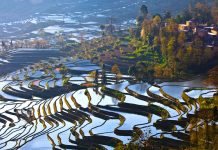
Where to go in Kunming? — 15+ top Kunming attractions &…

Must eat in Georgetown — 10+ famous, must-eat & best street…

Must eat in Melaka — 10+ famous Malacca street food &…
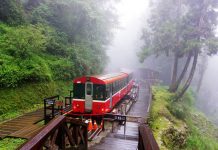
What to do in Alishan? — 5 top attractions & best…

All about tips in Nepal — How much to tip in…

Cambodia travel tips — 15+ what to know & things to…

When is the best time to visit Kyoto? — The best,…
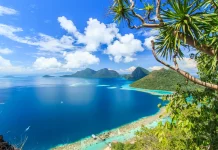
When is the best time to visit Malaysia? — The best,…

Hong Kong Soya sauce Chicken Rice and Noodles — The first…
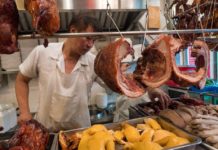
Hong Kong food culture — Hong Kong cuisine tells the historical…

Top hotels in Siem Reap — 8+ best places to stay…

Top hotels in shanghai — 15+ best hotels in Shanghai

Top hotels in Malacca — 10+ good & best hotels in…

Top places to stay in Bali — Top 10 best areas…

10 must-know things for your best first time European river cruise

Top 3 best luxury cruises in Halong Bay, Vietnam

Cherry blossom festival Korea 2024 — Top 5 cherry blossom festivals…

Ghibli museum blog — The fullest Ghibli museum guide for first-timers

Kyoto festival — Top 10 best events & most famous festivals…

National Palace Museum Taipei blog — What to see in National…

Japanese waterfall — Top 10 most beautiful waterfalls in Japan in…

19+ most beautiful towns in Europe every tourist need to visit…

Georgia travel photos — 20+ captivating photos show Georgia is heaven…

Explore Damnoen Floating Market — The oldest floating market of Thailand

Visiting Fenghuang Ancient Town — One of the most charming ancient…

Mekong Delta travel blog — Beyond rivers of Southwestern Vietnam

14 reasons why you should travel when you are young

Shigaraki Tanuki – An animal symbol of good luck in Japan

Living in the charms of cave houses in Andalucia, Southern Spain

20+ jaw-dropping tiny homes around the world
Sofia blog — the ultimate bulgaria sofia guide for first-timers.
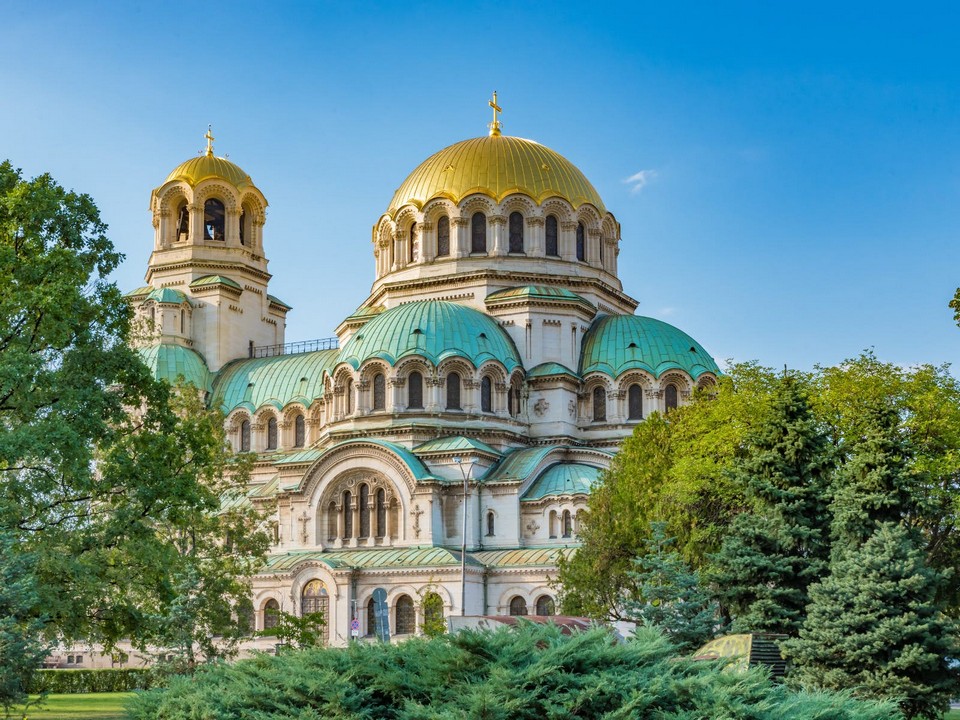
There is no need to go to the ends of the Earth to discover lands that still hold so many secrets. Sofia — the capital of Bulgaria located at the foot of Mount Vitosha is one of the lesser-known historical lands in Europe, not yet on the familiar routes of tour operators, that’s why uninformed people like me mistakenly thought it was not worth a visit. But, it was a totally wrong! So, what to do in Sofia and how to plan a perfect budget trip to Sofia, Bulgaria for the first-time? Let’s check out our Sofia blog (Sofia travel blog, Sofia Bulgaria blog) with the fullest Sofia travel guide (Sofia guide, Sofia tourist guide, Sofia visitor guide, Sofia Bulgaria guide, Sofia Bulgaria travel guide) from how to get there, best time to come, where to stay, best places to visit and top things to do to find out the answer!
- Plovdiv trip blog — How to make a Plovdiv day trip from Sofia
- Where to eat in Sofia? — +11 best restaurants in Sofia Bulgaria
- What to buy in Bulgaria? — +17 best Bulgarian gifts, souvenirs & top things to buy in Bulgaria
- 8 reasons why should you visit Bulgaria at least once in a lifetime
Explore Fenqihu old street — What to do in Fenqihu in a day trip?

I came to explore Sofia in an autumn, the gateway to Bulgaria, where you usually start or end every trip to the “Land of Roses” – Bulgaria. Just a few hours drive from Istanbul, Sofia like the last capital of the West, is the ideal destination for those who prefer the slow way of travel. It may be slow because Sofia is not on the familiar routes of travel agents, we will stay away from the “traffic jam” of large groups of tourists. Maybe slow because Sofia has so much green space, take a slow and deep breath to enjoy the greatest gift that Mother Earth has given us: The air – the breath signifies life. Walking slowly and surprisingly, because wandering in the city center, it is difficult to imagine this is a megacity of nearly 1.3 million people, where more than a quarter of the population of Bulgaria is concentrated, it is strangely peaceful.
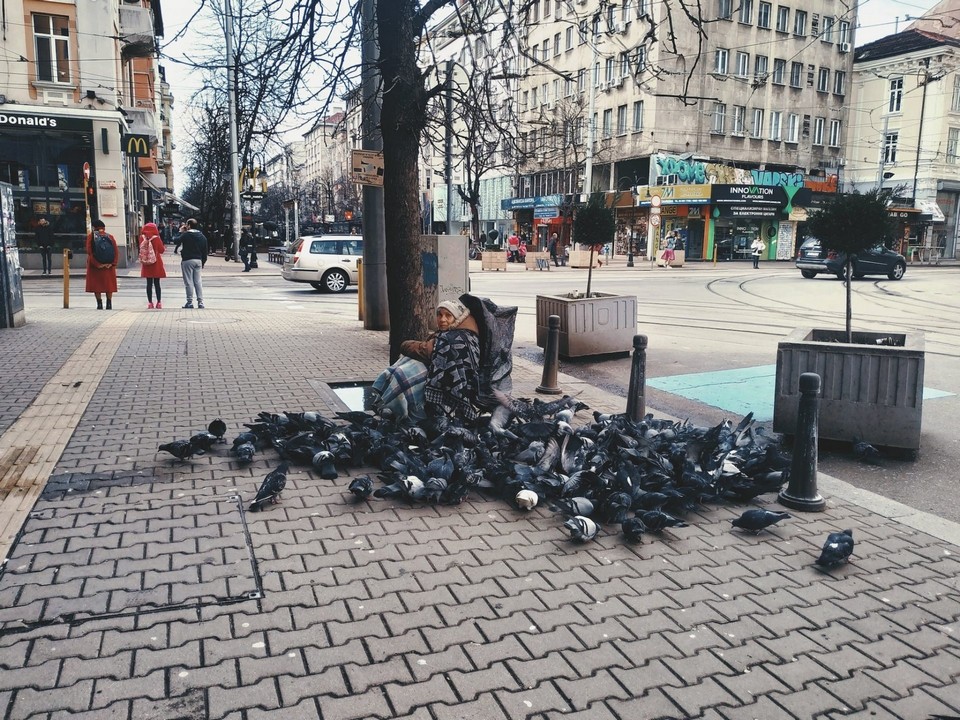
I visited Bulgaria in 2019, compared to Western Europe, Bulgaria is still poor and underdeveloped. For those who love the nostalgia of a time not far away, when the world was not as “flat” as it is today, in Europe there still was a “invisible wall” separating the East and the West, no need to go to the ends of the Earth, just going to Sofia makes us like we can step back in a time nearly two decades, showing an Eastern European city just like we imagined in black and white movies. But let’s go quickly, time will gradually erase all memories, traces in each of our minds as well as in every nook and cranny, street of this city.
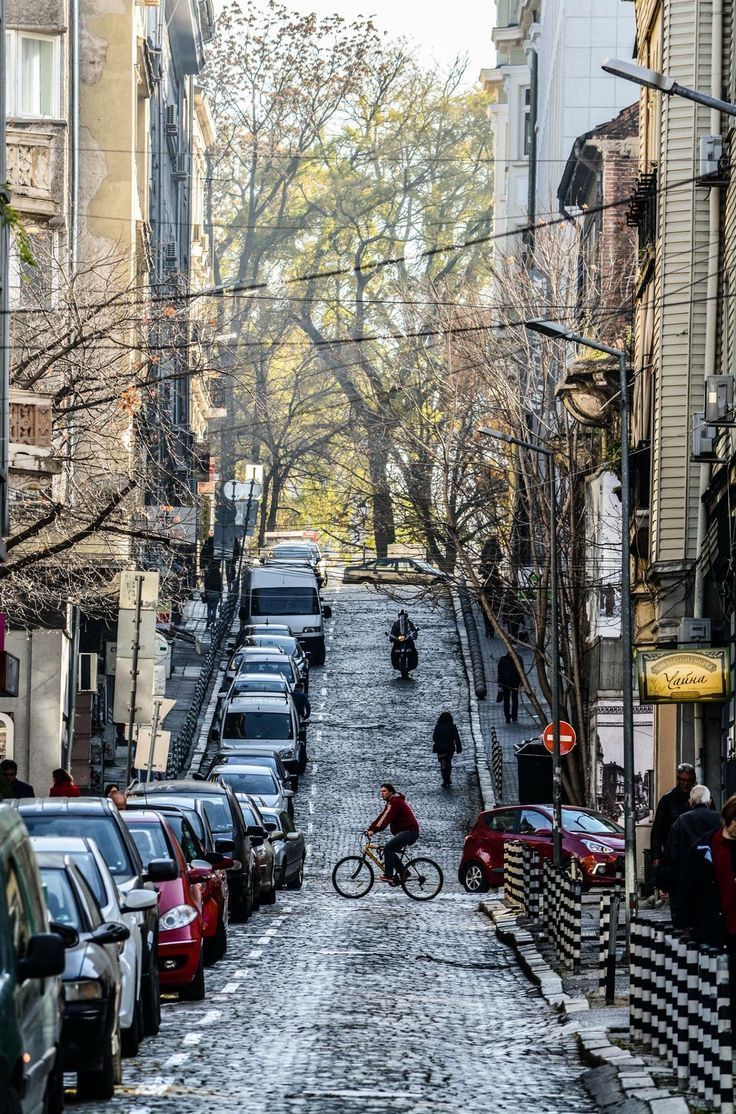
Sofia blog: Overview of Sofia

Sofia is the capital of the beautiful country Bulgaria with a population of neary 1.3 million people. This city is located in the western part of Bulgaria, at the foot of famous mountain ranges such as Vitosha, Liulin and the Balkans. You may not know that Sofia was previously known by other names such as Triaditsa, Serdica (Serdika) or Sardica. The name Sofia dates back to the 14th century and is named after an ancient Catholic church called Saint Sophia, the oldest Catholic church in the 4th century AD. In ancient Greek, the name Sofia means wisdom.
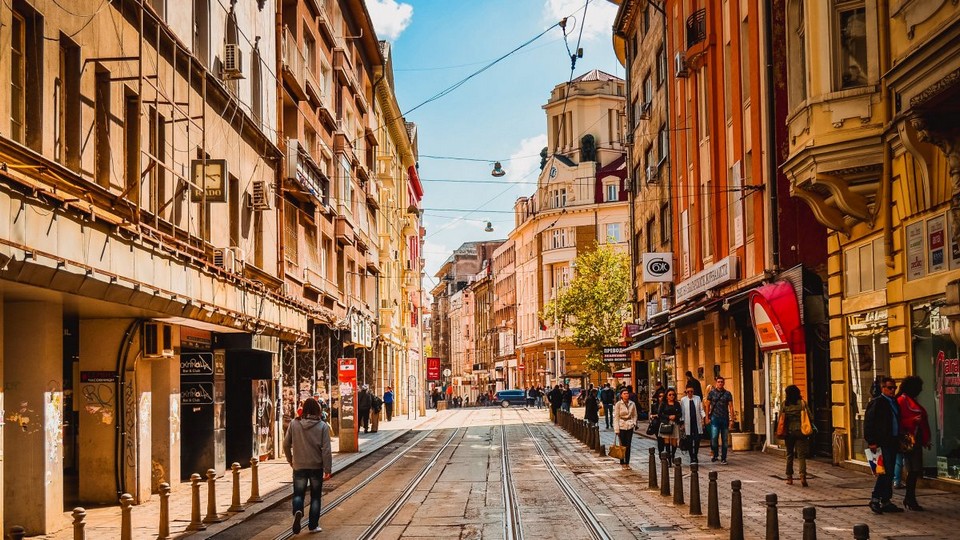
Before Bulgaria gained its Independence in the second half of the 19th century, Sofia was just a small town with about 12,000 inhabitants. This explains why the older architectures, buildings that still standing in the city are of relatively modest stature. The city really changed when it became the capital of the young Bulgaria in 1879. The city center as we know it today was reshaped and planned from that day, with buildings worthy of its position as a capital of the new kingdom. The Cathedral of St. Alexander Nevsky is a symbolic work not only for Sofia but also for the whole country of Bulgaria, like the Eiffel Tower of Paris, or the Colosseum of Rome. This should be picked as the first starting point, all other attractions in the central area are within walking distance.
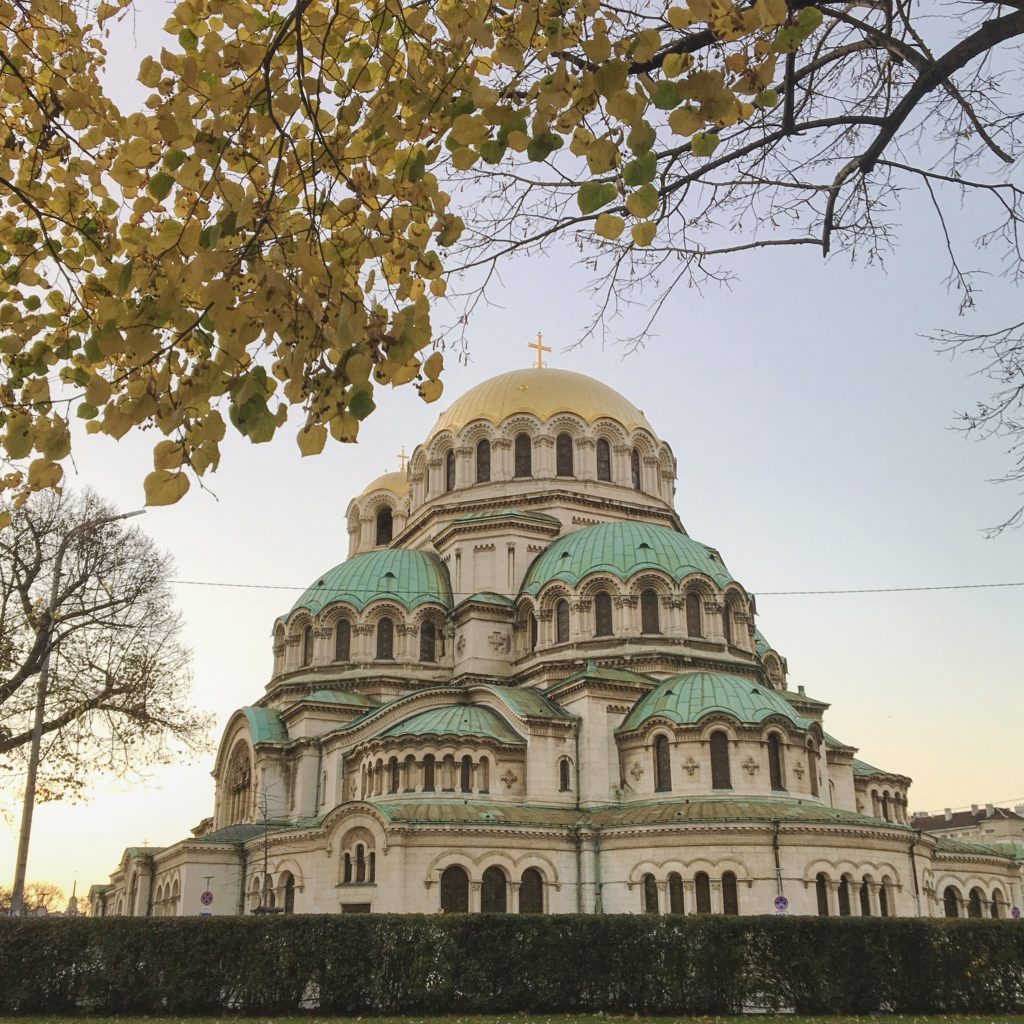
Why should I visit Sofia?
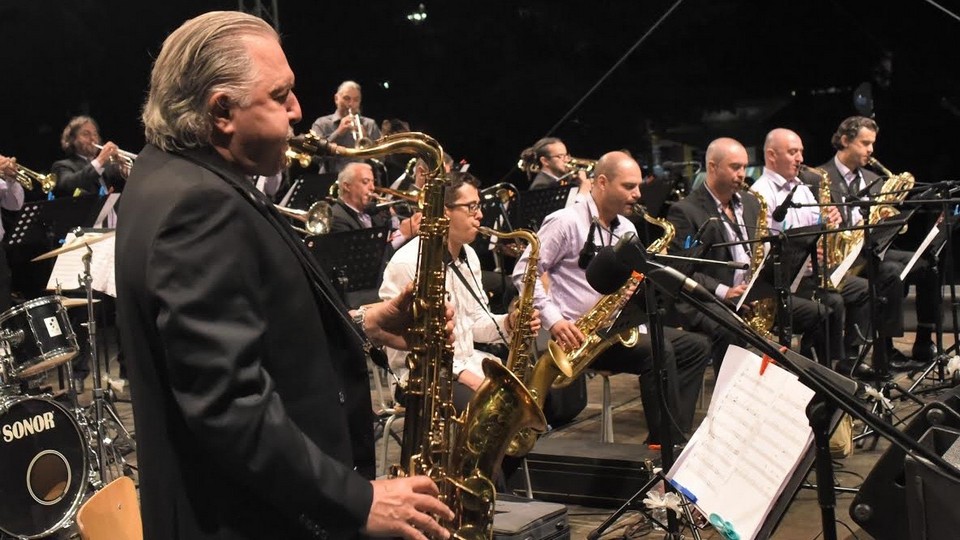
- Cuisine: Sofia is a food paradise! Bulgarian cuisine bearing bold oriental style: Rich in spices, rich in sauces, and diversity of meat. This is one of my favorite places to eat and drink, because it’s so cheap! And lots of great, must-try restaurants in Sofia.
- Culture: The intersection of traditional culture and communist culture is present everywhere in Eastern Europe. So is Sofia. However, Sofia has something much more ancient, nostalgic and mysterious. Eastern Europe is already strange and foreign. Coming here is like approaching a different culture from Western Europe, very interesting.
- Sofia is the paradise of street art.
- And also a paradise for history buffs. Especially during the Communist period.
- The beaches of the Balkans are as beautiful as the sunny Mediterranean beaches. Jazz: Charming and sweet. Jazz clubs are everywhere, and they’re all pretty special.
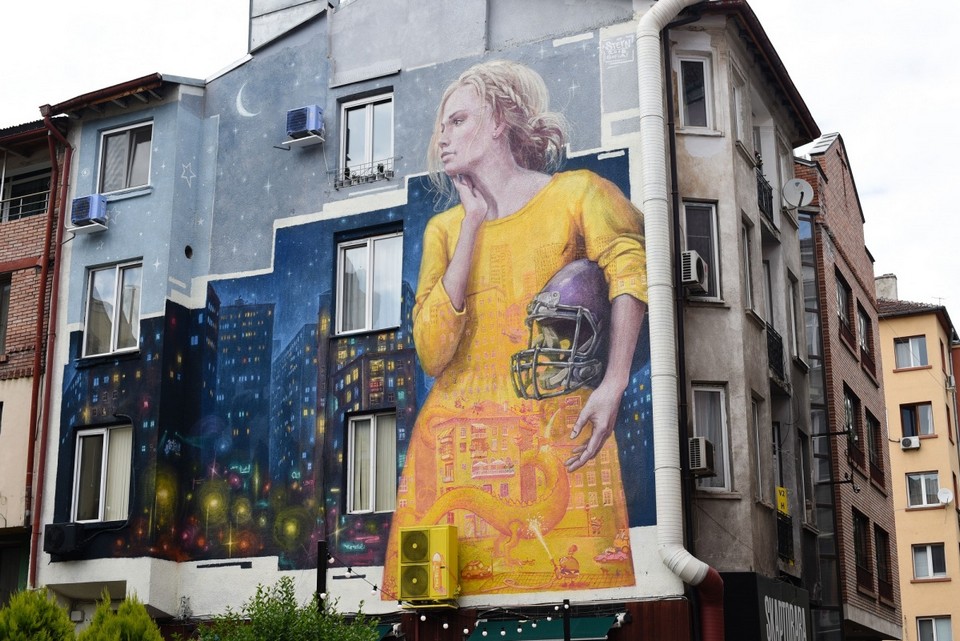
Sofia travel blog: When to come?
No matter what season you travel to Sofia, you will have the opportunity to enjoy your own experiences with its own beauty. Summer is the time when the flower fields of Bulgaria bloom, so traveling to Sofia this season visitors will have the opportunity to admire the beautiful flowers.
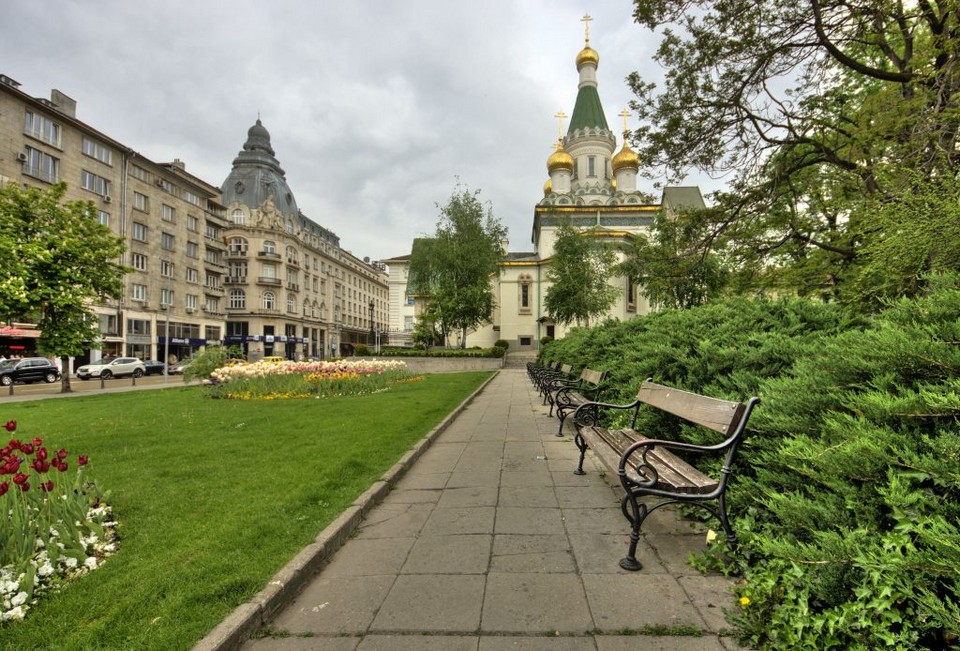
The weather in autumn and spring is cool, which is also very convenient for sightseeing and exploring, and this is also the time when many festivals are held. For those who love the winter cold of Europe and love to watching snow fall, you can travel to Sofia in winter, from December to April every year.
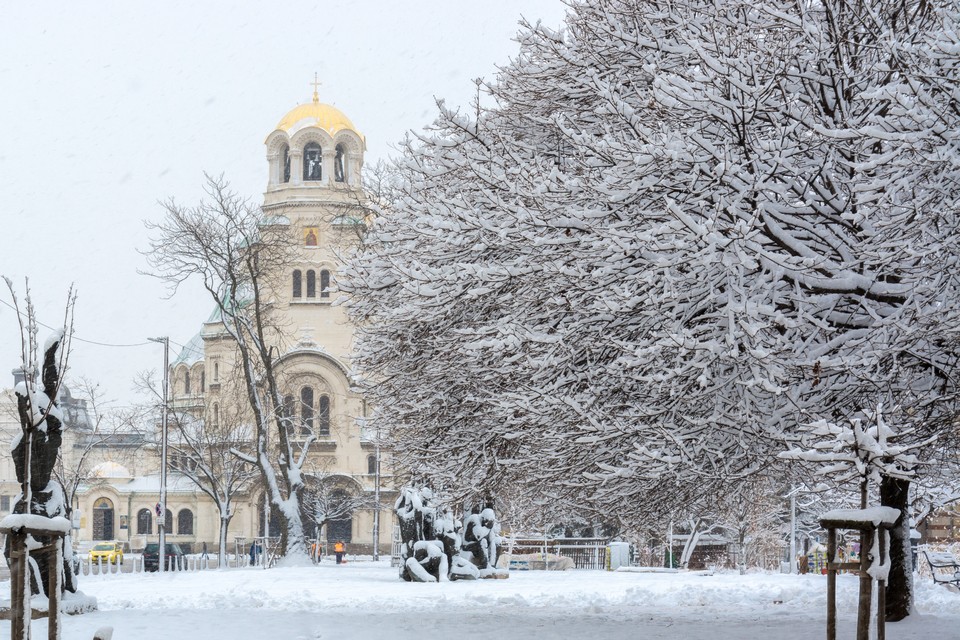
Getting from Bucharest, Romania to Sofia by train
There are 2 trains a day.
The day trip departs at 12:45 pm, arrival at 11 pm. I recommend you to take this day trip. Especially solo travelers like me. The train trip lasts 10 hours long, which means arriving in Sofia at around 11 pm. This trip is usually extremely deserted, as if it has been forgotten in time. Those who choose it either have a quiet, contemplative, old-fashioned or backpackers who want to save energy and time. I don’t know what I belong to, LOL. But all I know is that during that train, my spirit was quiet as if merging with the vast scenery outside as well as the calm atmosphere inside.
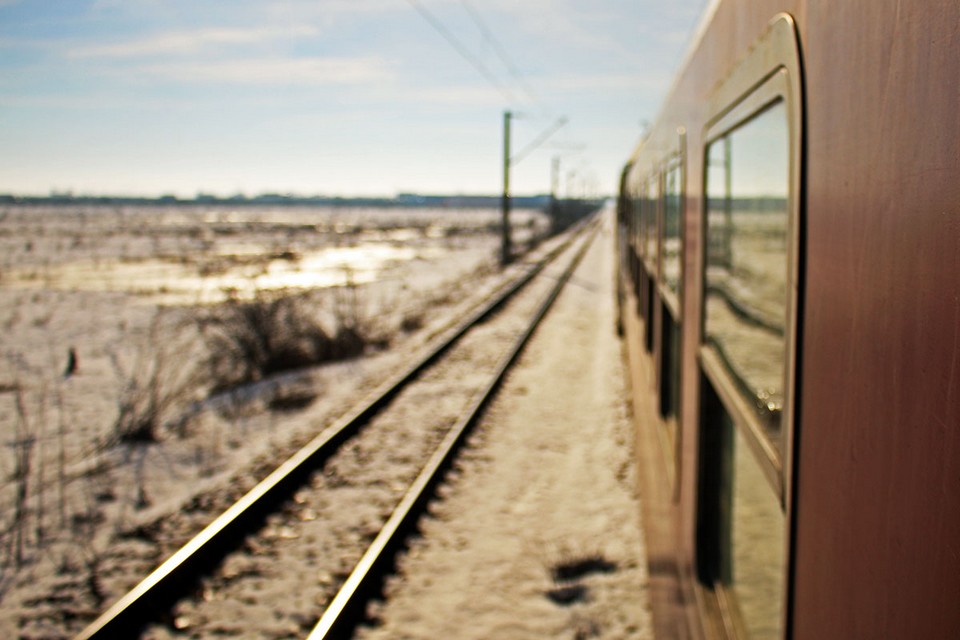
The second train is the night train. This train leaves Bucharest at 11s:12 pm, arriving in Sofia at 9:30 am the next morning. If you go with few people, you should not take this trip. The security of Eastern Europe is not very good. Nighttime there are often robbers and pickpockets, or illegal immigrants.
Eastern Europeans hardly speak English. When buying train tickets, please go to the international counter, not the domestic counter. Bucharest train station is very chaotic, no different from Vietnamese train stations. So, come a little early to find the ticket counter. The fare about 50 lev (25.56 euros).
Bring lots of drink water and food to “kill” the time. Fully charge the phone battery also. The scene on the road passing through the window is so enchanting. Open up the mind.
Bring lots of tissues. You will need it a lot. If possible, go to WC before get on the train. The train’s toilets are horribly dirty.
When crossing the Romanian border to Bulgaria, have your passport ready. The customs officer will keep your passport. Don’t worry, in Eastern Europe they still do so.
Because the Bulgarian railway system is quite old, most Bulgarians choose to travel by bus. The city’s two main bus stations are next to each other, at address: bulevard “Knyaginya Maria Luiza” 100, 1202 Tsentralna, Sofia, Bulgaria: Central Bus Station for domestic routes and Serdika Bus Station for international travel. As written above, these two bus stations are located right next to the central railway station, relatively close to the city center. If you want to take public transport, the nearest metro station is Central Railway Station on the M2 street.
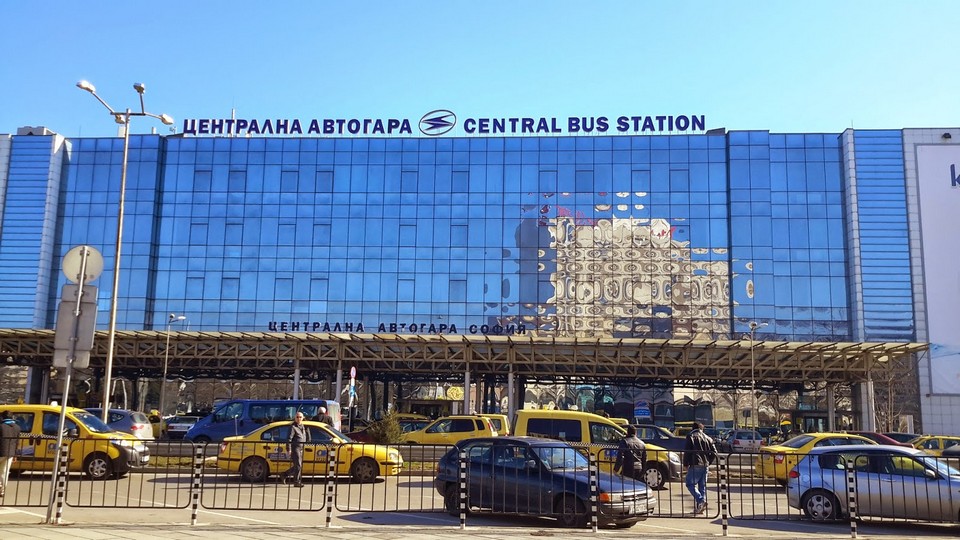
In addition, there are two smaller bus stations in Sofia.
West Bus Station (Ovcha Kupel): Address: No. 1 Ovcha Kupel Blvd. From the center to Ovcha Kupel bus station, take metro line #5 and get off at kv. Ovcha Kupel station, if you take a taxi from the center it takes about 7-12 leva (€3.5 to €6). This is the departure point of the bus to Rila Monastery.
Southern Bus Station: Address: 23 Dragan Tsankov Blvd 23. The bus station is about 300 meters from Joliot-Curie M1 metro station, about 7-12 leva (3.5 to 6 euros) by taxi from the center.
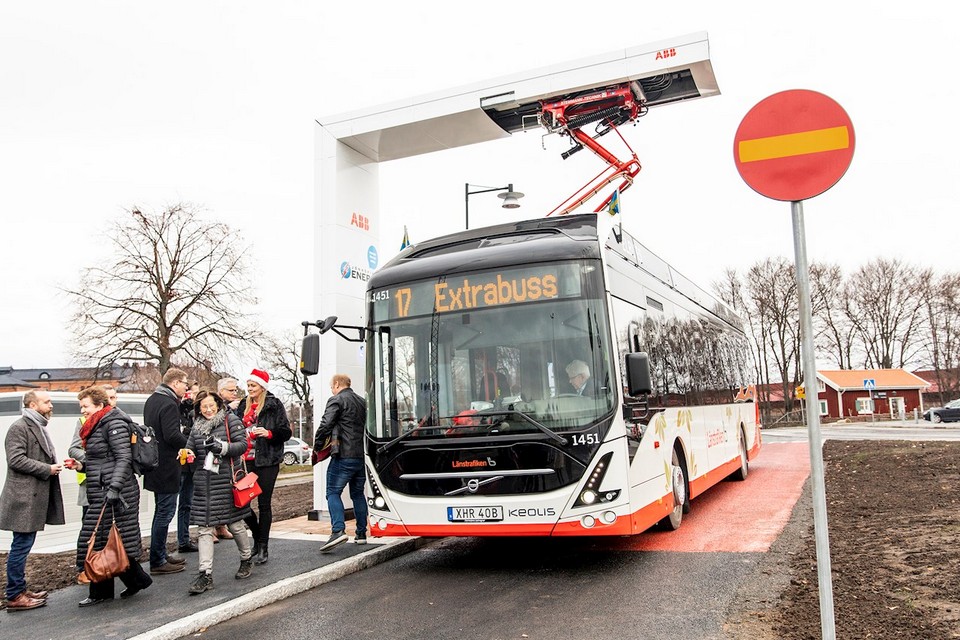
You can refer to the travel time by bus from Sofia to some other destinations in the Balkans as follows:
- Plovdiv: It takes 2 hours.
- Burgas: It takes 6 hours.
- Varna: It takes 7 hours.
- Veliko Tarvono: It takes 3 hours.
- Istanbul: It takes 10 hours.
- Bucarest: It takes 7 and a half hours.
- Skopje: It takes 5 hours.
- Belgrade: It takes 8 hours
In Bulgaria, to find long distance train or bus schedules, you can access www.bgrazpisanie.com .
Sofia travel guide: Getting around Sofia
Public transport.
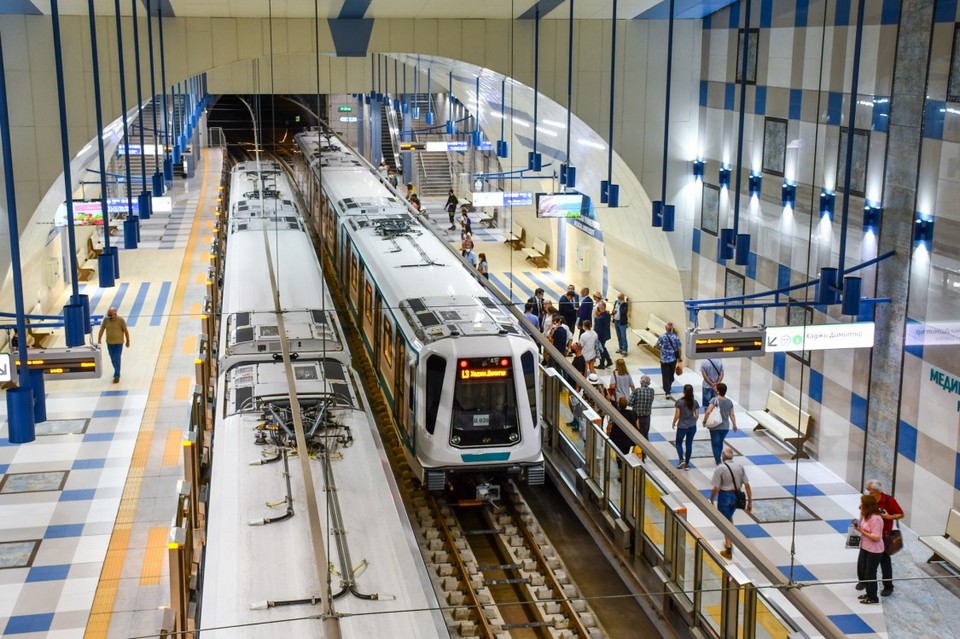
The public transport system in Sofia is very cheap. The current system includes 2 quite modern metro lines (the third line is under construction), along with 15 tram lines and many bus lines, quite old but clean. Metropolitan company ( www.metropolitan.bg ) manages the system. Tickets are sold at major stations, at newsagents or bought directly from the driver. Note that at the time of our stay in Sofia, there were relatively few automatic ticket counters that accepted card payments, most of which had to be purchased with coins. You can use www.eway.bg to find out how to get between two points by public transport.
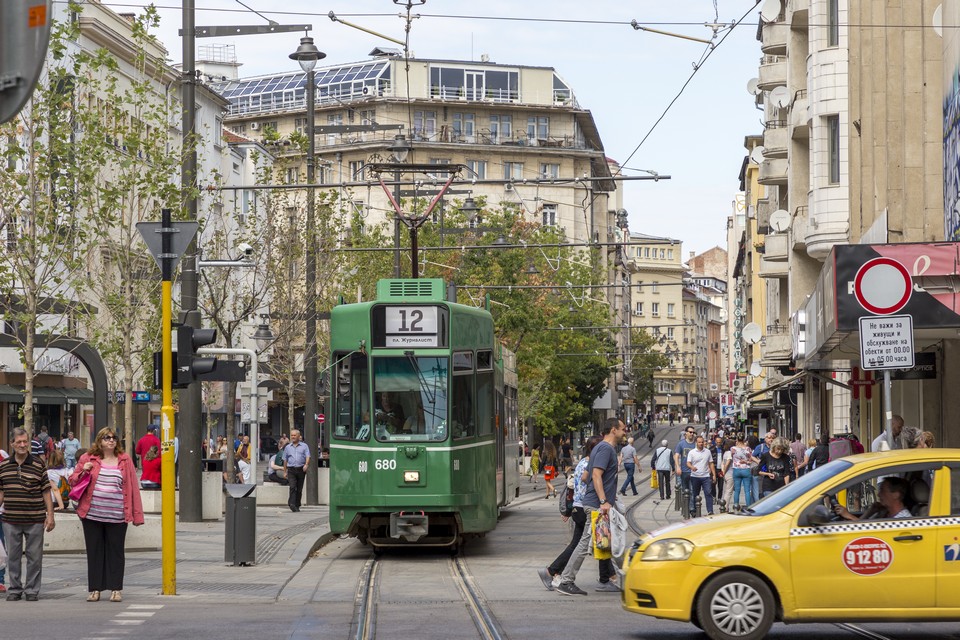
Regarding transportation tickets, they can be divided into three main categories:
- Single ticket: For 1.6 leva (€0.8). Note that tickets for the metro and other means are different and cannot be shared, even though they are the same price.
- Ticket for 10 trips: For 12 leva.
- Day pass for all vehicles: For 4 leva.
Taxi prices in Sofia are still relatively cheap, the most prestigious taxi company in Sofia is O.K. Supertrans ( www.oktaxi.net /Phone: +359 2 973 21 21). The fare is 0.70 lv when getting on the car, 0.79 lv/km for the time frame from 6am to 10pm, 0.90 lv/km at night, 0.22 lv per minute waiting. Getting around in the city center usually costs about 6 lv (€3)/trip, going to the suburbs usually only goes up to 15 lv. Note that many taxis even make fake logos that are similar to the company. If your phone has a network, you can use the TaxiMe app to call a car, which has features quite similar to Uber such as rating and giving points to driver, as well as calculating the estimated fare for the distance before booking a car.

Sofia’s central area is relatively small, within walking distance between attractions. So, we almost didn’t use public transport on this trip, just went to try it once or twice to get experience about writing again for you. When going out late at night, because the taxi price is still quite cheap, so our group chose this option for convenience and safety.
Car rental in Sofia
Our trip this time is a self-drive roadtrip to save time, and take advantage of the relatively cheap prices in Bulgaria. I found a car rental company for about half the market price and was quite satisfied with their service. A very small company called mybudgy.com is run by two brothers-in-law, one French and one Bulgarian. Although the car is not new, I rented a Renault Symbol car that has gone 160,000 km but still runs well and costs €15 a day. For another €5, they will deliver the car right at the airport when I arrive and then pick up the car at my hotel. We only deal with them first via e-mail and when we arrived at the airport, we found that the staff was waiting for us on time. When renting a car in Bulgaria, there is usually a toll stamp that is purchased annually and there are no additional fees.
Sofia blog: Where to go and what to do
St. alexander nevsky cathedral.
Address: pl. “Sveti Aleksandar Nevski”, 1000 Sofia Center, Sofia, Bulgaria Hours: 7AM–7PM Getting there: Metro line M1, get off at St. Kliment Ohridski/Sofia University Station.

As mentioned above, the church is a symbolic work not only for Sofia but also for the whole country of Bulgaria. The church was built to commemorate the Russian soldiers who died in the struggle for the liberation of Bulgaria in 1877-1878. The construction began in 1882, but it was not completed until 1912. The church was designed by Russian architect Alexander Pomerantsev, with the participation of Bulgarian, Austrian, German, Italian and Czech artisans in the typical Neo-Byzantine style, typical of Russia in the 19th century. Both interior and exterior of the church are worthy of the stature of the iconic building for a country. Built on the highest ground in Sofia, the gilded domes of the church can be seen from the top of Vitosha mountain or almost anywhere in the city.
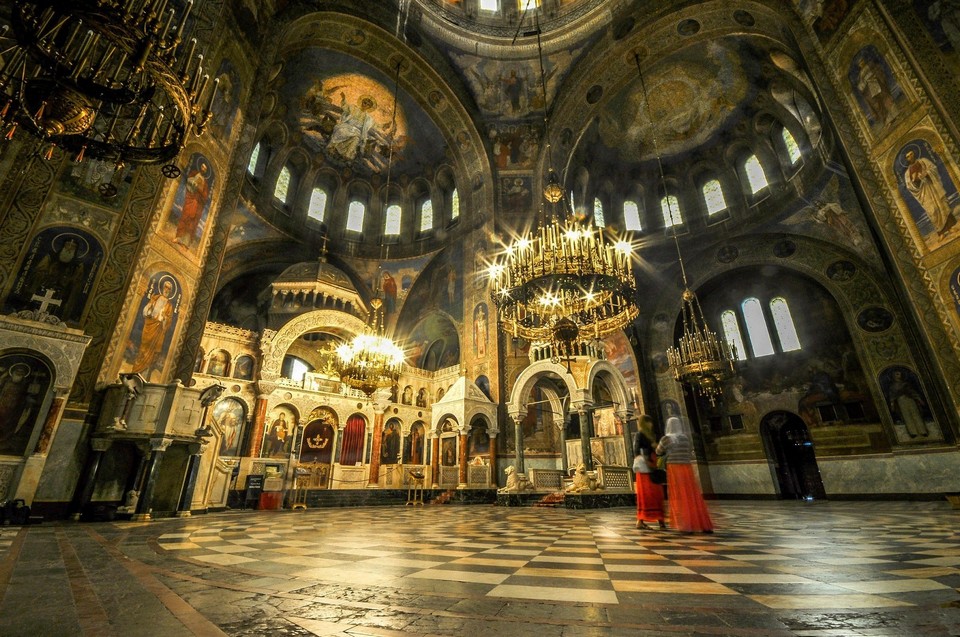
St. Sophia Church
Address: ul. “Paris” 2, 1000 Sofia Center, Sofia, Bulgaria Hours: 7AM–6PM Getting there: Metro M1 to St. St. Kliment Ohridski/Sofia University Station (A 2-min walk from the Alexander Nevsky Cathedral)
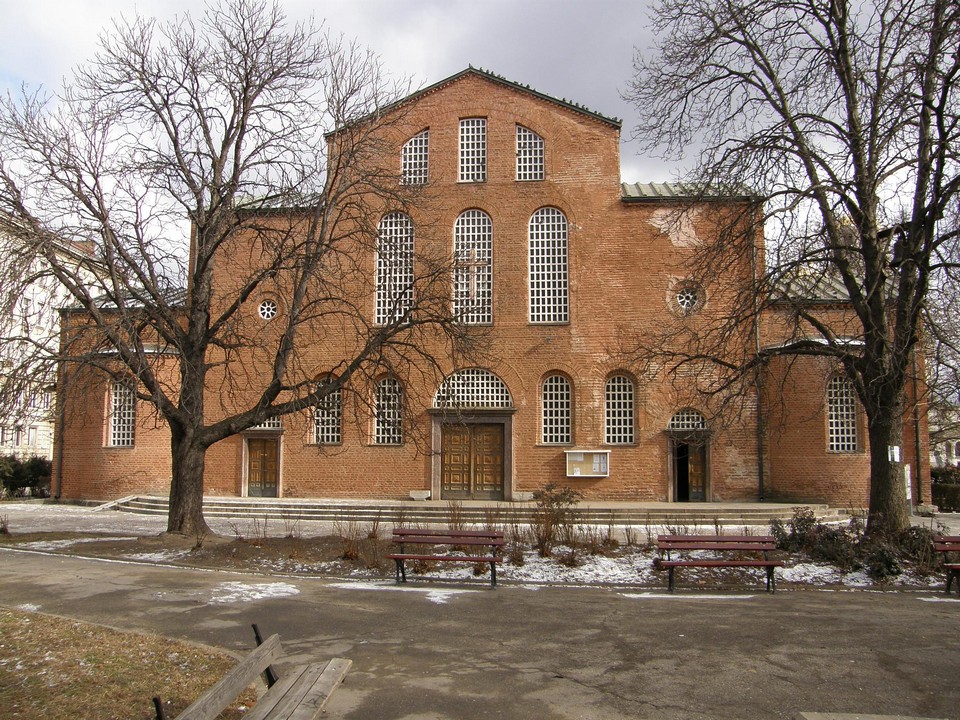
Before being named Sofia, the city was known by many other names: Serdika, Sredets and then Triadica. It was not until the 14th century that the name Sofia was called, after the church of Saint Sofia, the oldest Catholic building in the city built in the 4th century AD. It’s located directly opposite the church of St. Alexander Nevsky, Church of St. Sofia has a completely opposite style, simply with bare red brick walls without plaster.
Church of Sveti Sedmochislenitsi
Address: ul. “Graf Ignatiev” 25, 1000 Sofia Center, Sofia, Bulgaria Hours: 8AM–5PM
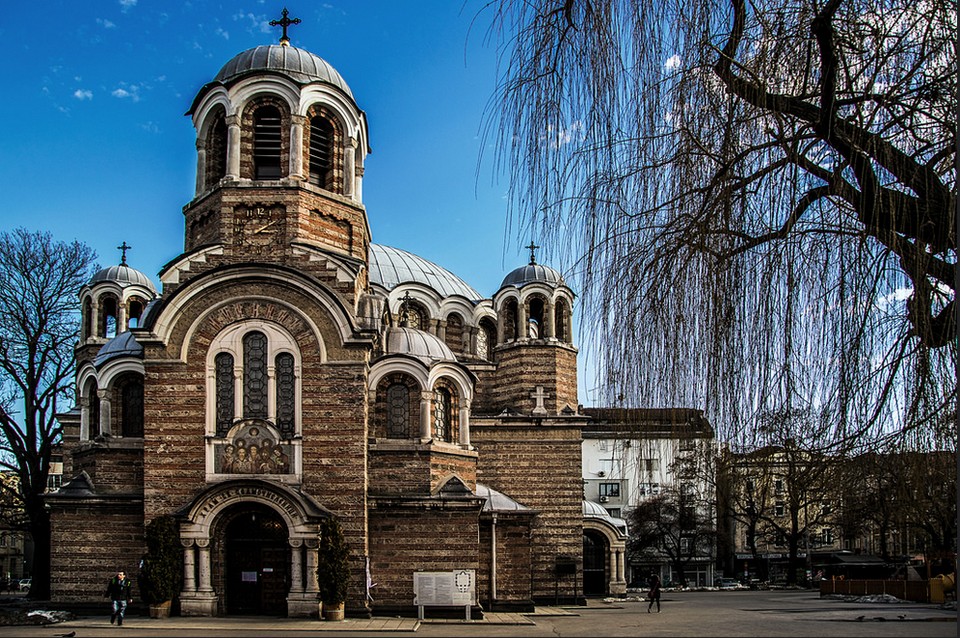
From Sveti Aleksandar Nevski Square where the church of the same name is located, we headed towards the Parliament building (National Assembly building) located in a corner of the square, before walking along the street named ul. “Tsar Shishman”. “Tsar Shishman” Street is one of my favorite places in Sofia, an area full of book shops, art and craft shops as well as renovated bars in old buildings and villas, combining nostalgia and modernity, delicate and timeliness. At the end of the road is the church of Sedmochislenitsi, set in the middle of a beautiful, green and quiet garden. It is special because this is an old mosque, built by the Sultans to overshadow all the Catholic churches in this city. It has a beauty of the blending between the East and the West. The church used to be turned into a prison after Independence day before being converted into a Christian Cathedral.
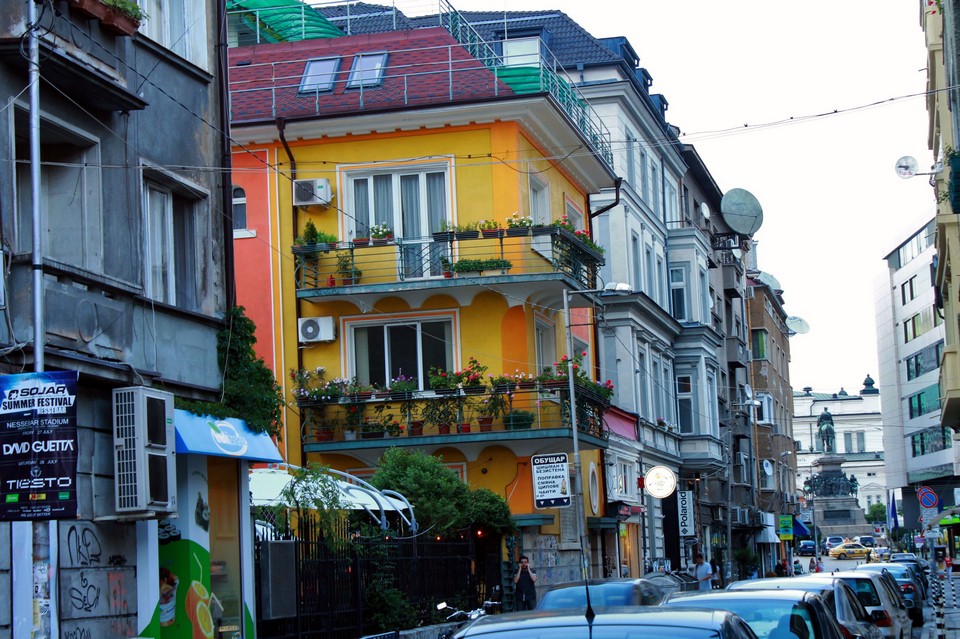
Church St. George Rotunda
Address: bul. Kniaz Aleksandar Dondukov 2, 1000 Sofia Center, Sofia, Bulgaria Getting there: Metro M1 or M2 to Serdika Station
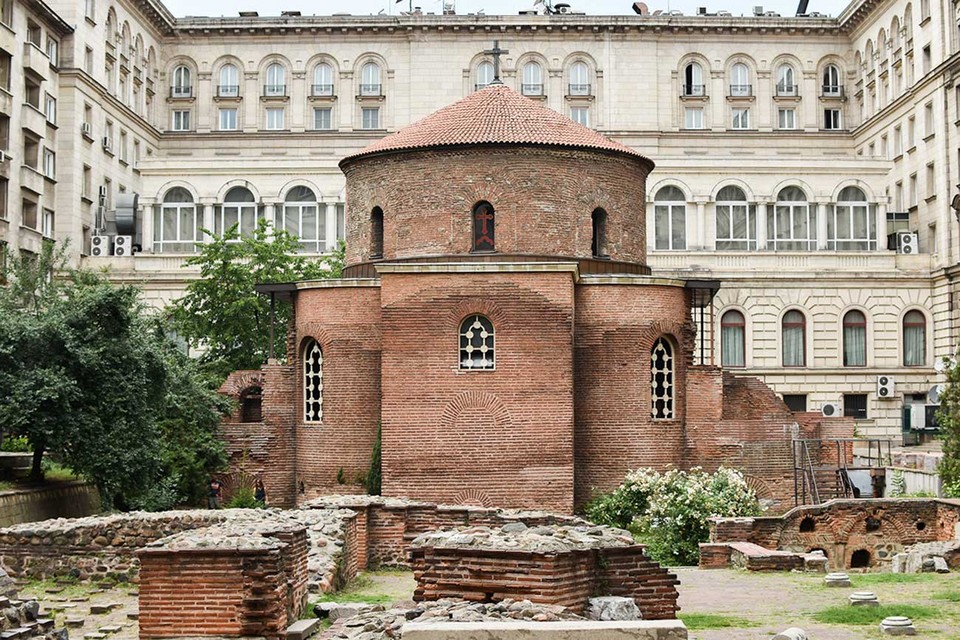
Located a little behind Knyaz Aleksandar I Square. The achitectural work that intrigues me the most Sofia, located in the common courtyard of the city’s most luxurious 5-star Sheraton hotel and the Bulgarian Presidential Palace, still standing and is still open to visitors. The St. George’s church was built in the 5th century AD under the Byzantine Empire, is one of the oldest works in Sofia still standing.
Boyana Church
Address: ul. “Boyansko ezero” 3, 1616 Bojana, Sofia, Bulgaria Hours: 9:30AM–6PM Getting there: From the center to here, take the metro line M2 to Vitosha station, take bus #64 and get off at Boyansko Hanche station. If taking a taxi, it costs about 15 lev (€7.5).
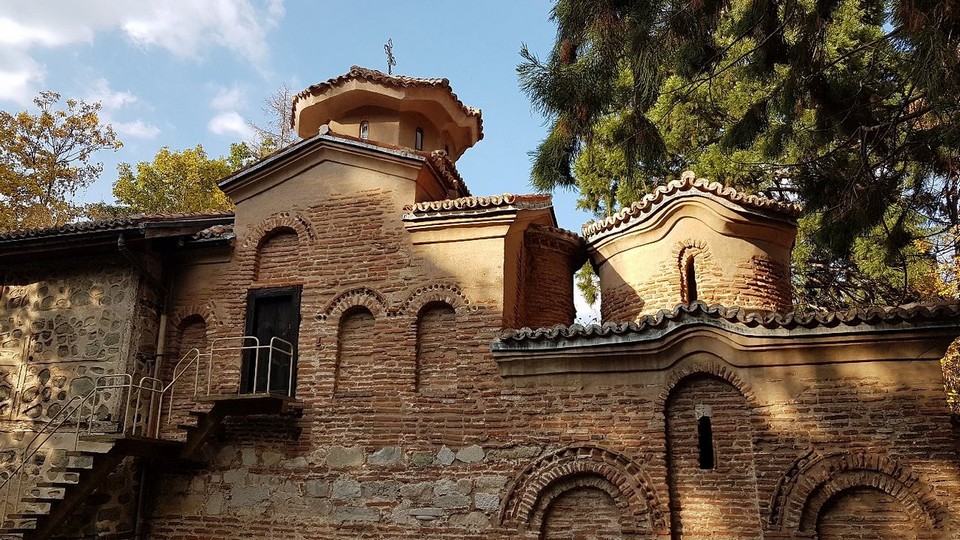
If you have more time, you can visit the Boyana church located on the outskirts of Sofia, one of the nine UNESCO cultural heritage sites of Bulgaria.

Slaveykov Book Market at Petko R. Slaveykov Square
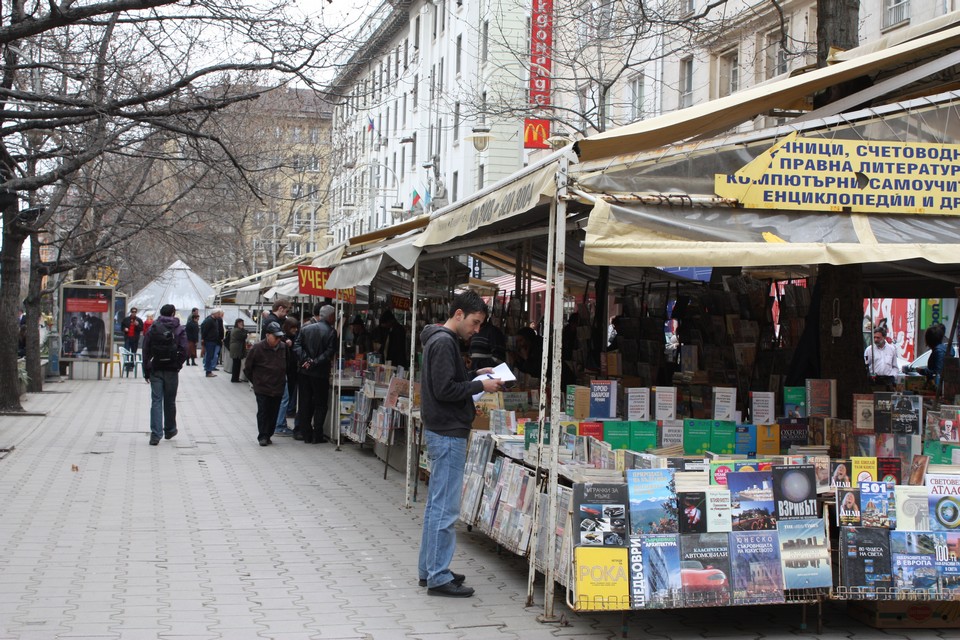
Not far from the Church of St. Sedmochislenitsi is a book market located at Petko R. Slaveykov square. When it first opened in the 90s, sellers of used foreign books began to gather in the square, just outside the City Library, when the need to learn about Western culture was no longer prohibited. Need any foreign language book, just ask the book sellers here, they will find it for you. Nearly 30 years after opening, the book market continues to operate as a cultural feature of the capital Sofia.
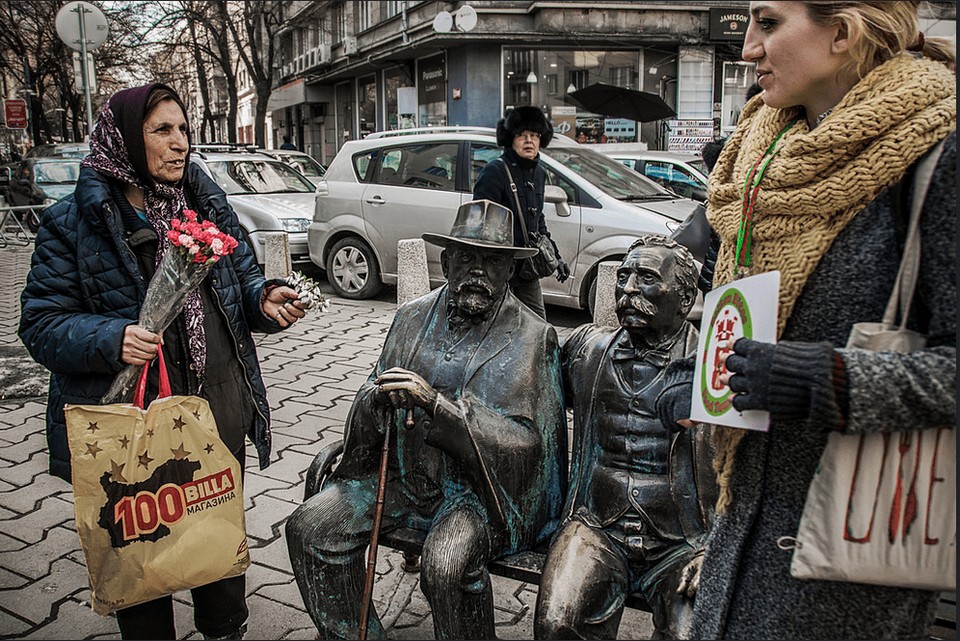
Ivan Vazov National Theatre
Address: ul. “Dyakon Ignatiy” 5, 1000 Sofia Center, Sofia, Bulgaria Getting there: Metro line M1 or M2, Serdika Station

From the Slaveykov book market, if you follow the street Georgi Rakovski, you will come to the Ivan Vazov theater which was opened in 1904 with a capacity of 940 seats in Neoclassical architectural style, the most magnificent and elegant building in the Bulgarian capital. Along Rakovski Street there are 8 more theaters, and countless Bulgarian Ministries. What I especially like is the city flower garden in front of the theater. On hot summer days, it’s a great place to stop by for a refreshing drink in the garden refreshment shops. The garden is also a meeting point for chess enthusiasts in the capital.
Knyaz Aleksandar I Square
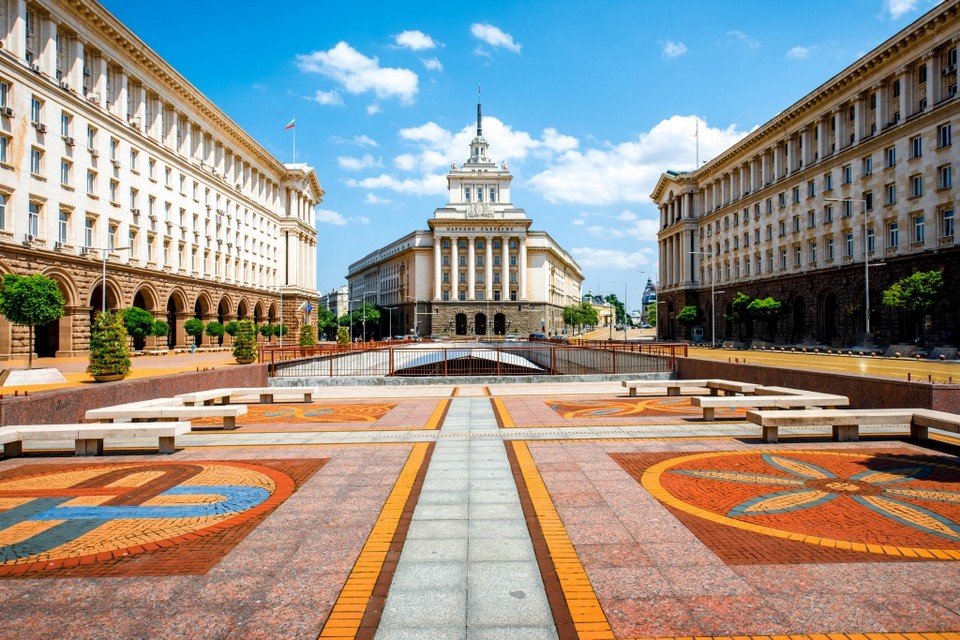
Located right next to the city flower garden, it can be said that this is the most “powerful” square in Bulgaria. Around the square are the former Royal Palace “Vrana”, now the National Art Gallery, the Largo Complex – the symbol of half a century of Socialism – including the former headquarters of Bulgarian Communist Party, the former Department Store Building TZUM and the Presidential Palace of Bulgaria. To the east of the square is the Russian Catholic Church.
Getting there: M1, M2 to the Serdika Station.
The Prince Alexander of Battenberg Square
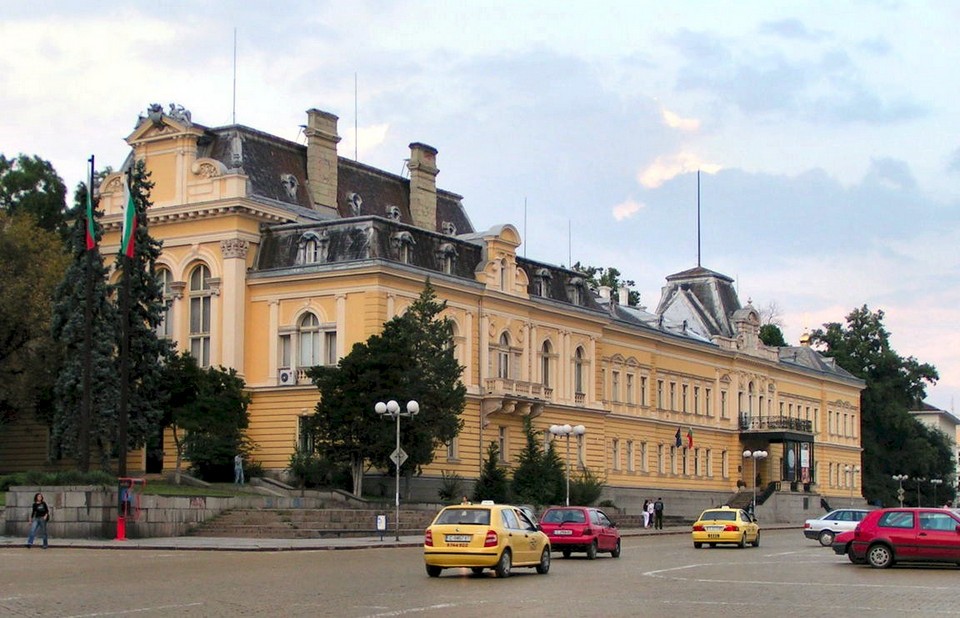
This square is located in the heart of Sofia, close to Sofia’s National Museum of Natural History and Russian Church “Sveti Nikolay Mirlikiiski”. This square is named after Prince Alexander of Battenberg, the first prince of modern Bulgaria. This is a convenient starting point for visitors to visit other attractions in the city.
Memorial Tomb of Alexander (Battenberg Mausoleum)
Address: ul. “Hadzhi Dimitar” 17, 1000 Sofia Center, Sofia, Bulgaria Hours: 10AM–5PM/Saturday, Sunday: Closed Opened: 1897
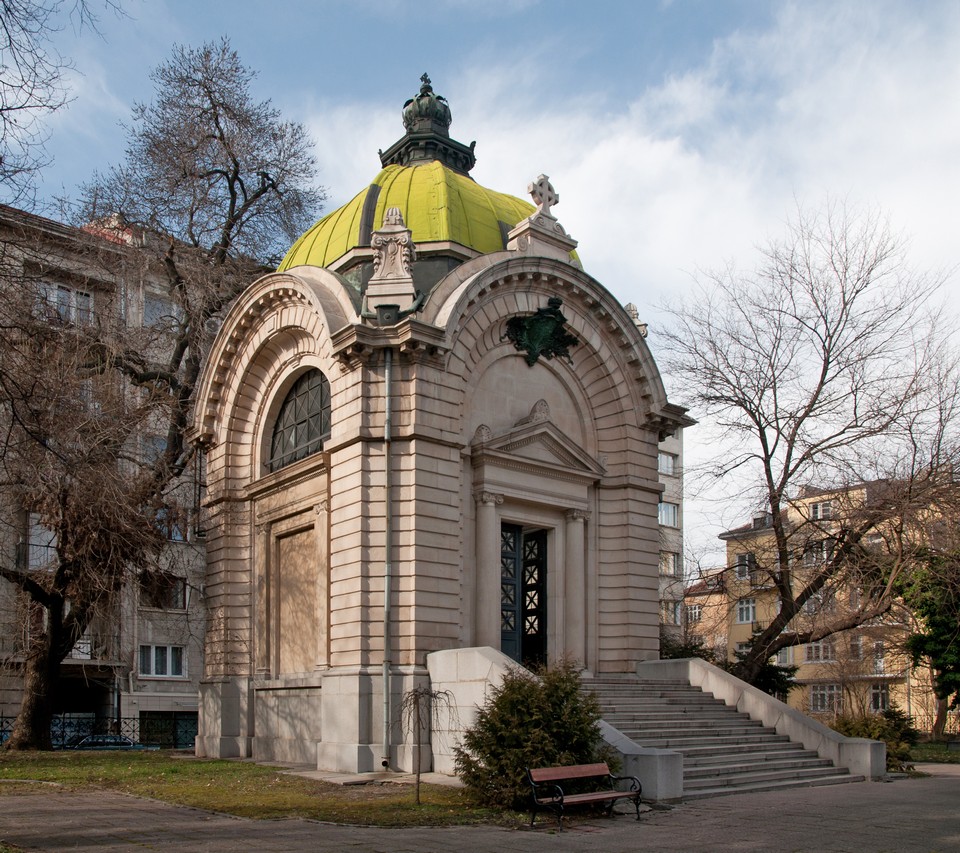
This tourist attraction is located on Vasil Levskim Blvd, one of the busiest boulevards of Sofia, but the space inside the mausoleum is completely quiet and cozy. When visiting this mausoleum, you will feel like you are lost in another space, both peaceful and cozy, the architecture of the tomb is also very beautiful and unique. This is a place well worth a visit.
Vitosha Boulevard
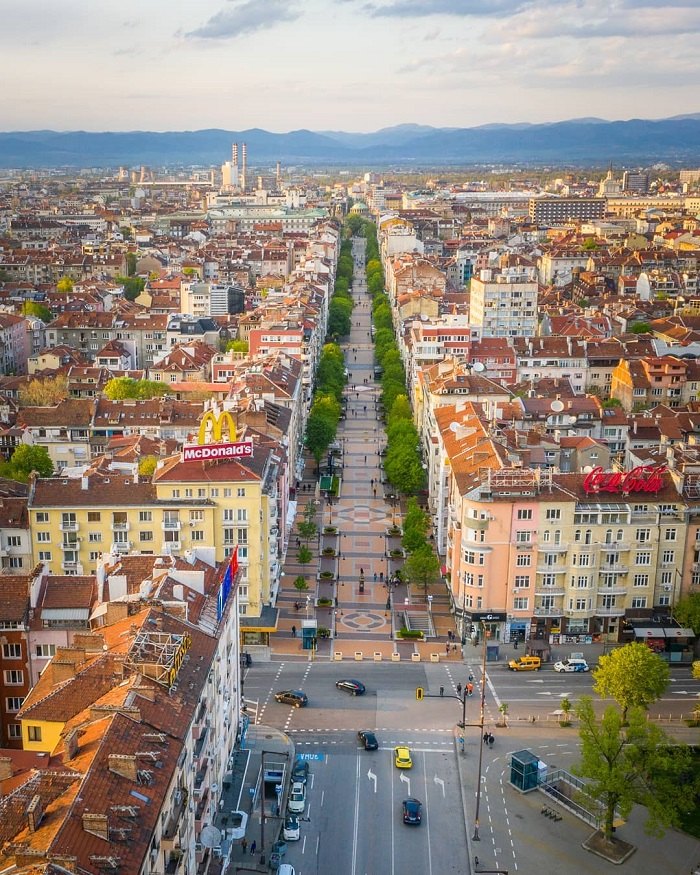
This avenue is the main commercial street of Sofia and also one of the 22 most expensive commercial streets in the world, so it is also a must-stop for visitors. This place has many fashion shops, restaurants, bars… very bustling. Vitosha Boulevard prohibits all vehicles except trams with the length of 2.7 km from Sveta Nedelya Square to South Park, so you can leisurely walk around to visit and shop.
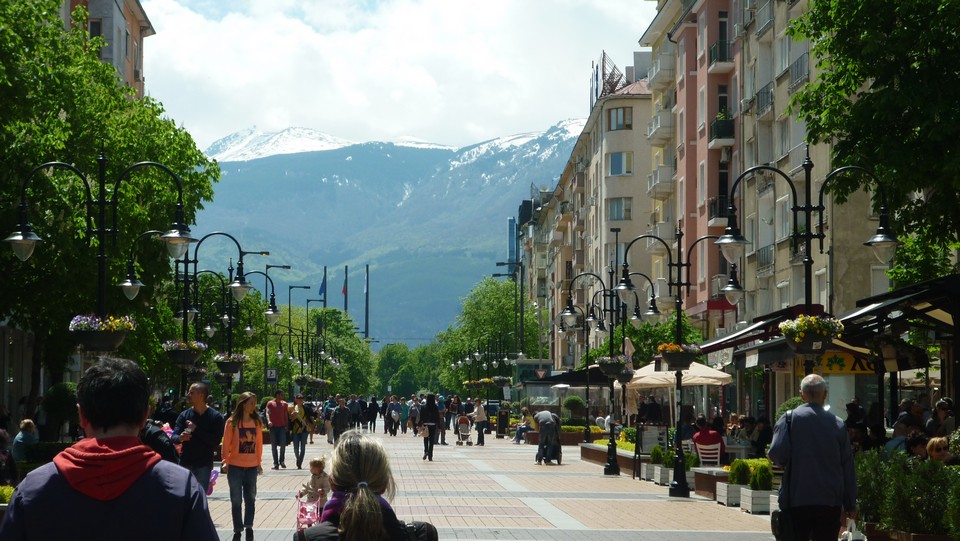
Sofia blog: What and where to eat?
Tarator (bulgarian cold cucumber soup).
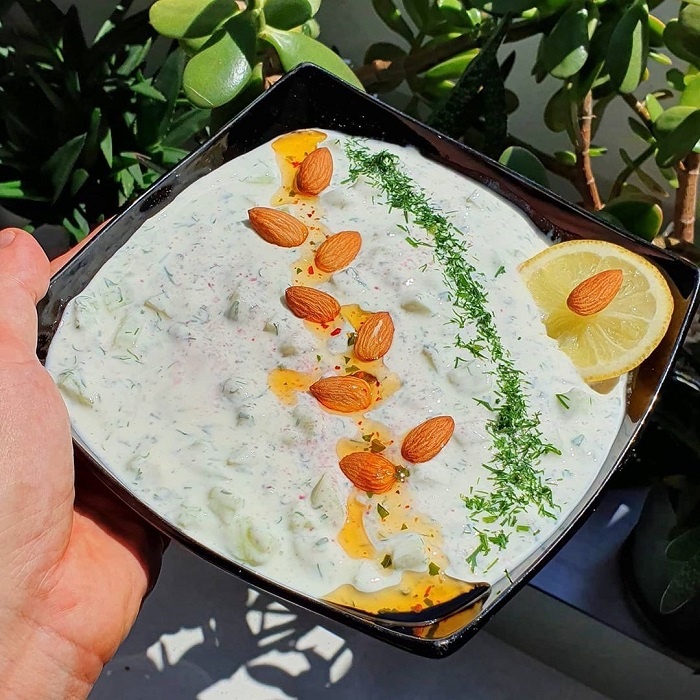
This is an extremely famous Bulgarian dish often used in the summer, this dish is made from yogurt, cucumber, garlic, dill, walnut… then mixed together to creat a delectable soup.
Ovcharska Salata
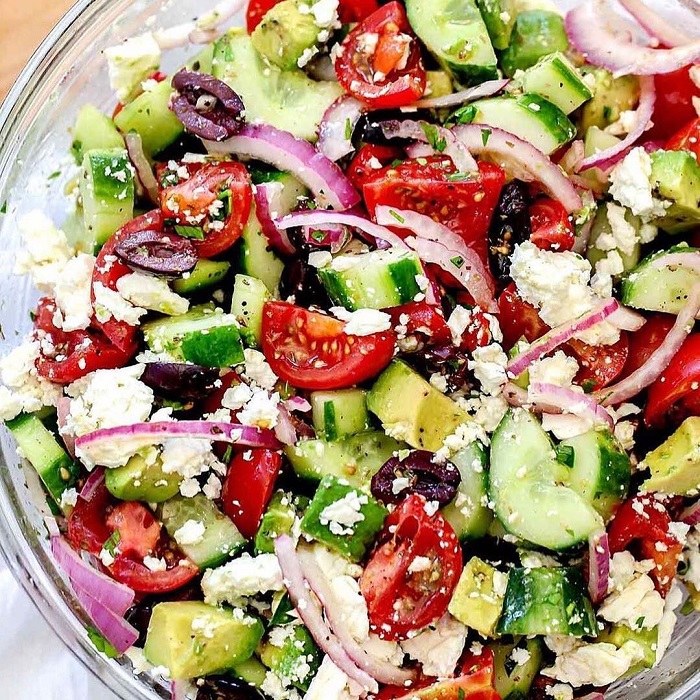
You should try this special salad. Ovcharka salata is a traditional Bulgarian salad with ingredients that are popular in Bulgaria such as cucumbers, carrots with mushrooms, ham and grated eggs.
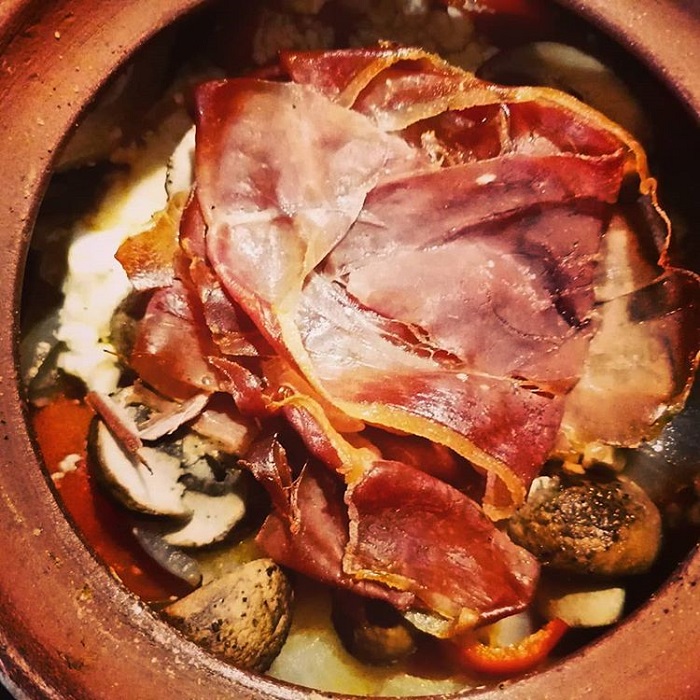
This dish is one of the very famous Bulgarian main dishes with the ingredient of grilled meat combined with stewed vegetables including tomatoes mixed with olive oil, onions, mushrooms and herbs. The taste of this dish is quite attractive and easy to eat, so it is also loved by many tourists.
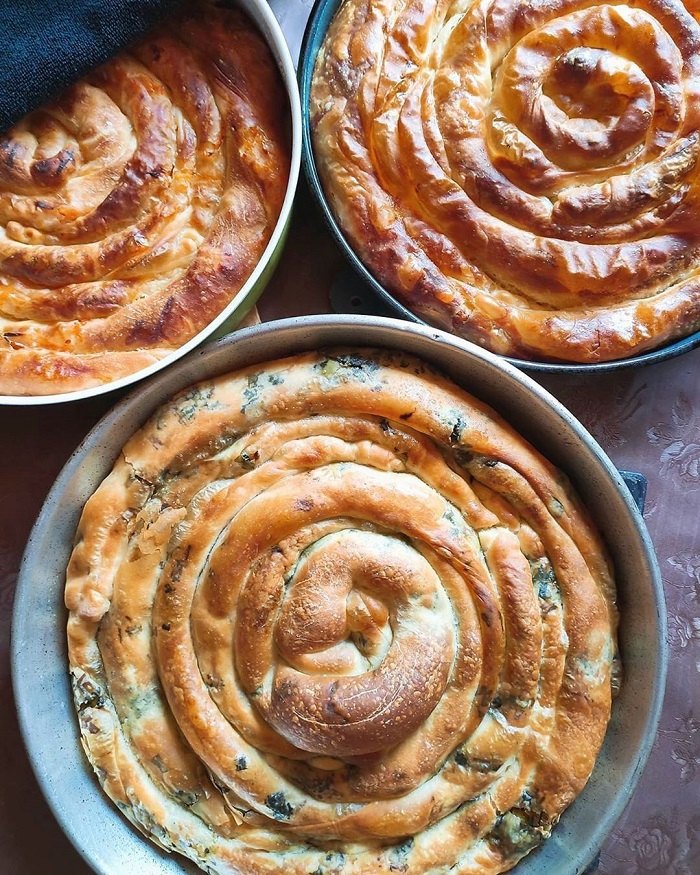
For those who have visited Sofia as well as traveling to Bulgaria, they will be very familiar with this cake, this is the most popular traditional pastry in Bulgaria. Cakes can be made from the main ingredients of eggs, white cheese, yogurt, and add pumpkin or apple for a sweet and pleasant taste. This cake is often used as a Bulgarian breakfast.
In addition to the above dishes, you can also taste many other attractive dishes in Sofia such as Lukanka, Teleshko vareno Soup, Shopska Salad, Pastarma, Shkembe chorba, Pacha, Tatarsko kufte… or enjoy traditional drinks such as beers like Zagorka, Pirinsko Pivo, Astika, Kamenitsa… Distilled drinks like Rakia, Mastika…
Where to eat?
Bulgarian cuisine has the characteristics of the Balkans, with the influence of 500 years under the Ottoman Empire, so with a little oriental flavors. Key ingredients can include Sirene white cheese. Bulgarian girls are taught by their mother the first lesson at homemaking, “if in doubt add sirene”.
As a country with a temperate climate located on the Black Sea coast, Bulgarian agricultural products are extremely rich. Bulgarians usually start with a bowl of soup cooked with seasonal vegetables. After the soup is the Shopska salad before the main course: Cucumber, onion, fresh tomato sprinkled with pepper, grated sirene and parsley.
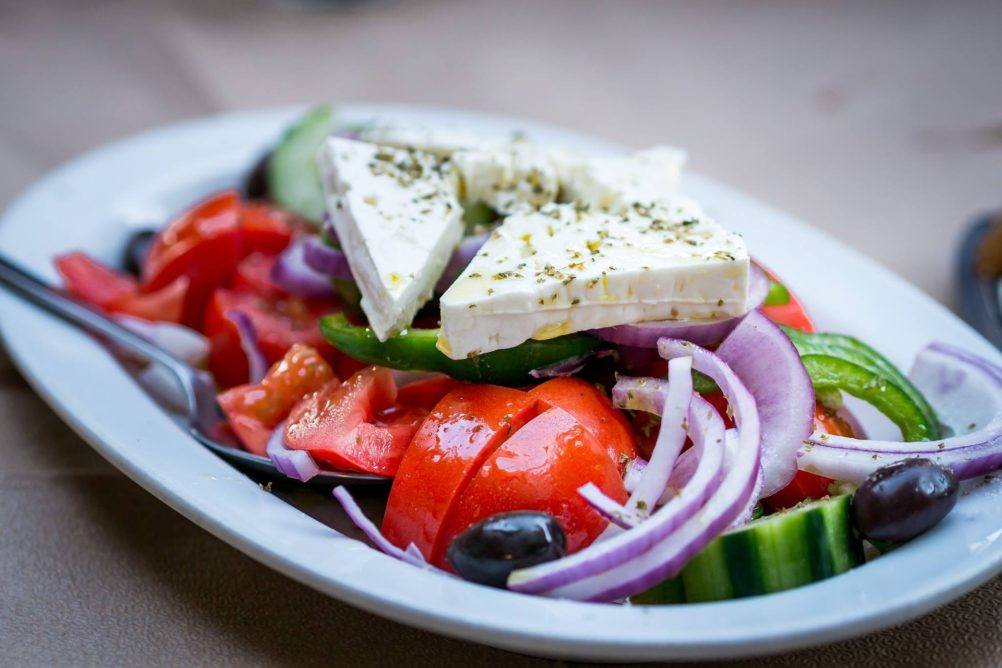
Among the typical main dishes of the Balkans, there is unique Sač. Sač is the name of a type of earthen pot or pan with a lid, the Balkan people buried for many hours in charcoal, used it as a kind of casserole, cooked on low heat. In a pot, often mix a variety of vegetables, peppers and onions, potatoes, mushrooms … with meat and cheese, then cover with lid and leave in the oven for many hours. The flavor of the ingredients is preserved, the sweetness from ingredients mixed together, if not too fatty and often too full, a serving that is difficult for one person to eat up, then this is a very good dish.

Influenced by Greek and Turkish cuisine, the Bulgarian charcoal barbecue is also tasty. Among the different types of grilled meat, it is possible to mention: Kebapcheta, kioufteta (minced meatballs with onions and parsley), chichtchéta (grilled meat on skewers), karantchéta (sausages), parjola (ribs). More delicious if accompanied by a cold beer of two local brands Kamenitza or Zagorka.
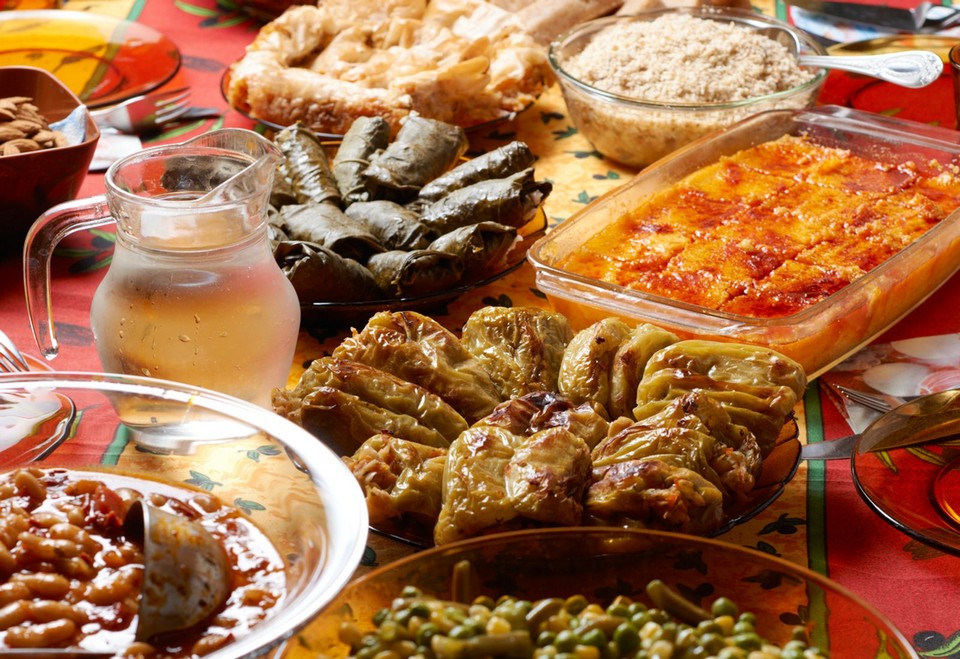
Ethno Restaurant
Address: Sofia, St Alabin 35, Bulgaria Hours: 10AM–10PM/Saturday, Sunday: Closed Phone: +359 88 401 1177/+359 88 440 2109.
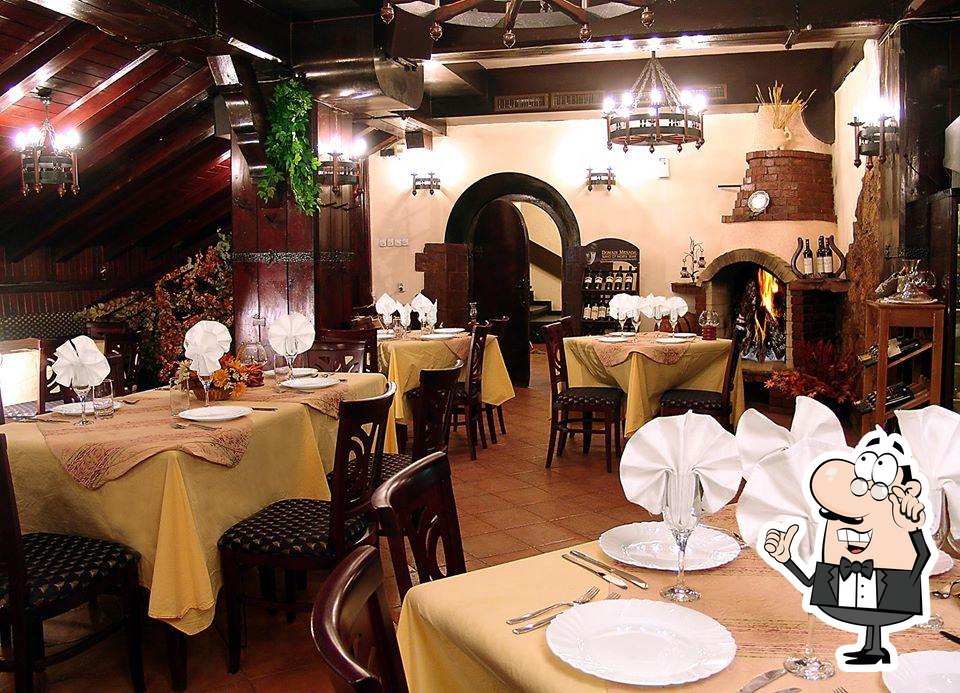
Without the “aboriginal people”, Uncle Ivelin, my mother’s friend showed the way, I would never have found the place. Located in the basement of a building on a street not far from the Bulgarian Presidential Palace, the entrance to the shop is only a modest panel, unexpectedly in the basement there is a very historic restaurant, which I observe, so that city businessmen often come and receive guests. Bulgarian food, exquisite and delicious. Skillful service. The shop is quite luxurious, but somehow I still think of the style of the ladies of the Department serving middle-high-class cadres in the Socialist era. Prices are high for the Bulgarian life, but within acceptable range, around 20 lv (€10) per person including wine.
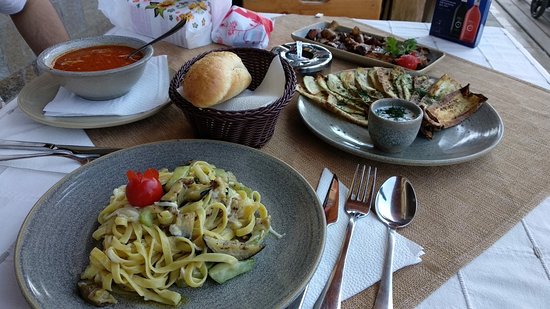
Address: ul. “Sveti Kliment Ohridski” 10, 1504 Sofia Center, Sofia, Bulgaria Hours: 11AM–10:30PM Phone: +359 2 943 8403
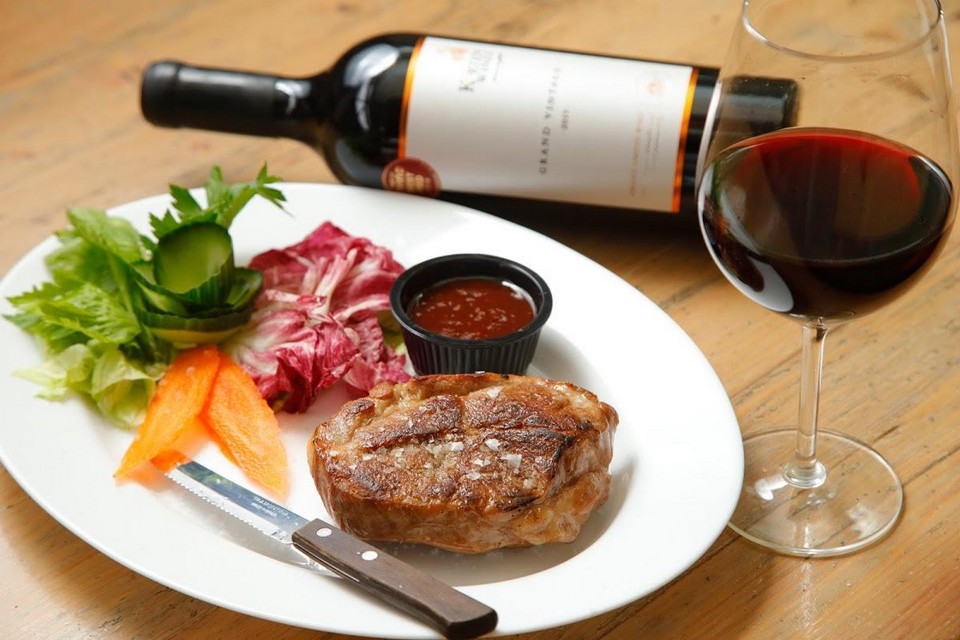
Located right next to Sofia University, this is a familiar address to both students and teachers of the school. The food is diverse, from Western European cuisine to more special Bulgarian dishes, simple but well prepared to my taste. My experience in Bulgaria, when entering a restaurant without knowing what to order, just order a grilled fish: Extremely tasty, fresh, firm and juicy. The price is about 10 lv/person including drinks.
One More Bar
Address: ul. “Tsar Ivan Shishman” 12, 1000 Sofia Center, Sofia, Bulgaria Hours: 8:30AM–2AM Phone: +359 88 391 0296/+359 87 769 3735

My wife has a Bulgarian friend who returned to Sofia after graduated from the university. She made an appointment to meet us at this very interesting bar, on the street “Tsar Shishman” is my favorite place in Sofia, an area filled with many book shops, very lovely small craft and art shops. The renovated bar in an old villa reminds me of French villas in Hanoi, with a patio that’s nice in the summer, while the indoor is more modern, combining nostalgia and modernity, delicate and timeless. The bar’s very good bartenders have delicious and strange cocktail recipes. The price is about 5 lv a drink.
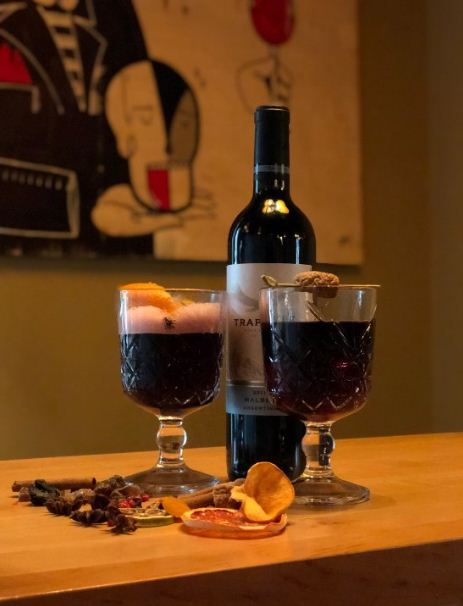
Read more: Where to eat in Sofia? — +11 best restaurants in Sofia Bulgaria
Sofia guide: Some tips before you go
- Money exchange: Bulgaria does not use the Euro (€) yet but uses the lev – the plural is leva (abbreviated as лв (lv) or BGN). In preparation for Bulgaria’s entry into the Euro Zone, the lev-euro exchange rate has been unchanged since 1999, €1 ~ 1.95 lev. For ease of calculation when buying, it is recommended to convert 1 lev ~ €0.5. Exchange money in big cities like Sofia is relatively simple, almost all major bank branches offer euros at this rate. Only avoid exchanging at stations, bus stations or airports where the exchange rate will not be favorable. As well as absolutely avoid exchanging on the street, easy to encounter scams. Ask them first if they charge a service fee. If not, you can ask them directly where to exchange without service fee.
- Language: One thing that is a bit inconvenient when traveling to Bulgaria, especially when going to remote areas, is that they use the Cyrillic (Kirin) script, which makes me sometimes like an illiterate, unable to read restaurant names, addresses, etc. The site bg.translit.cc can be used to convert Cyrillic characters to the Latin alphabet, at least you can reading address, spelling and guessing some terms.
- In Bulgaria, nod means no. Shaking head means yes. This may seem confusing at first.
- Mineral water is drinkable everywhere around the city.
- Visa: Bulgaria is not part of the Schengen area, so a visa is required to enter. However, if you have a Schengen visa, you can enter for less than 90 days. Or other residence papers are also ok. I have an Italian residence card, easy entry, no problem. Most are so. They interrogated a little at the border. You can check here.
- Bulgaria’s train system is very bad, tattered, slow. But extremely-cheap, usually half the price of a bus or coach. As long as it’s daytime, there’s no issue. I like it because it feels nostalgic. But you should think before taking the train. Because you may be shocked at how “ruined” they are.

Sofia blog: Where to stay?
Below we recommend some best budget, mid-range and upscale hotels with good ratings and reviews you can refer to.
- Central Hotel Sofia ( Agoda.com or Booking.com )
- Sense Hotel Sofia ( Agoda.com or Booking.com )
- Grand Hotel Sofia ( Agoda.com or Booking.com )
- Novotel Sofia ( Agoda.com or Booking.com )
- Hotel Anel ( Agoda.com or Booking.com )
- Sofia Hotel Balkan, a Luxury Collection Hotel, Sofia ( Agoda.com or Booking.com )
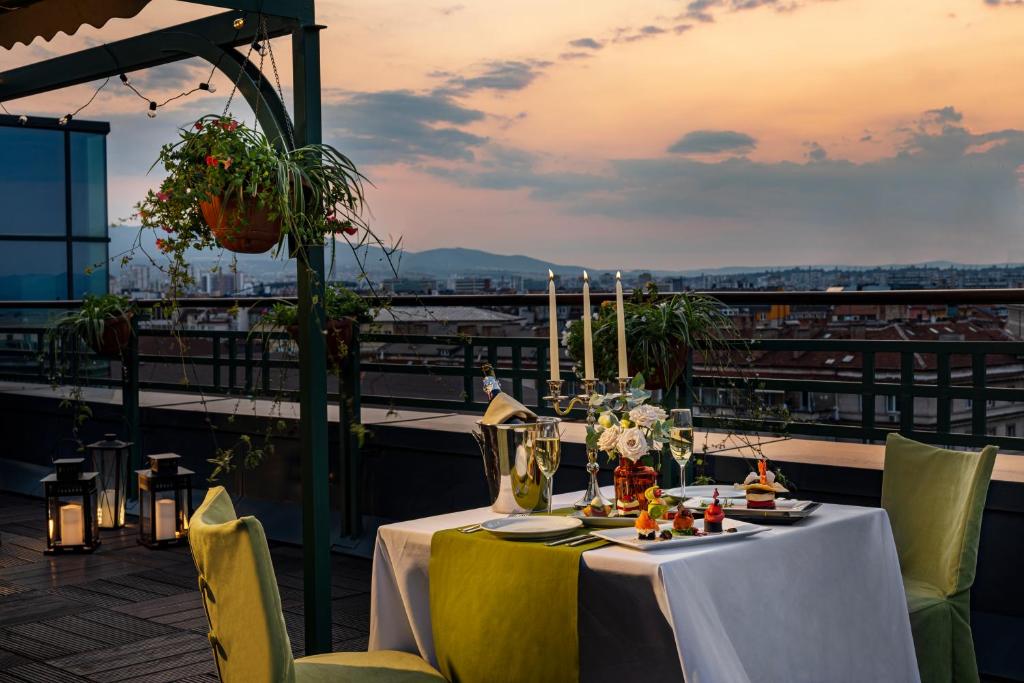
Check more top and best hotels in Sofia on Agoda.com or Booking.com .
Sofia guide: Some best day tours, trips, activities and transfer services, tickets in, from and to Sofia you can refer to
- Nis Day Tour from Sofia
- Plovdiv Day Tour from Sofia
- Rila Monastery and Boyana Church Tour from Sofia
- Rose Valley and Koprivshtitsa Tour from Sofia
- Plovdiv and Koprivshtitsa Combo Day Tour from Sofia
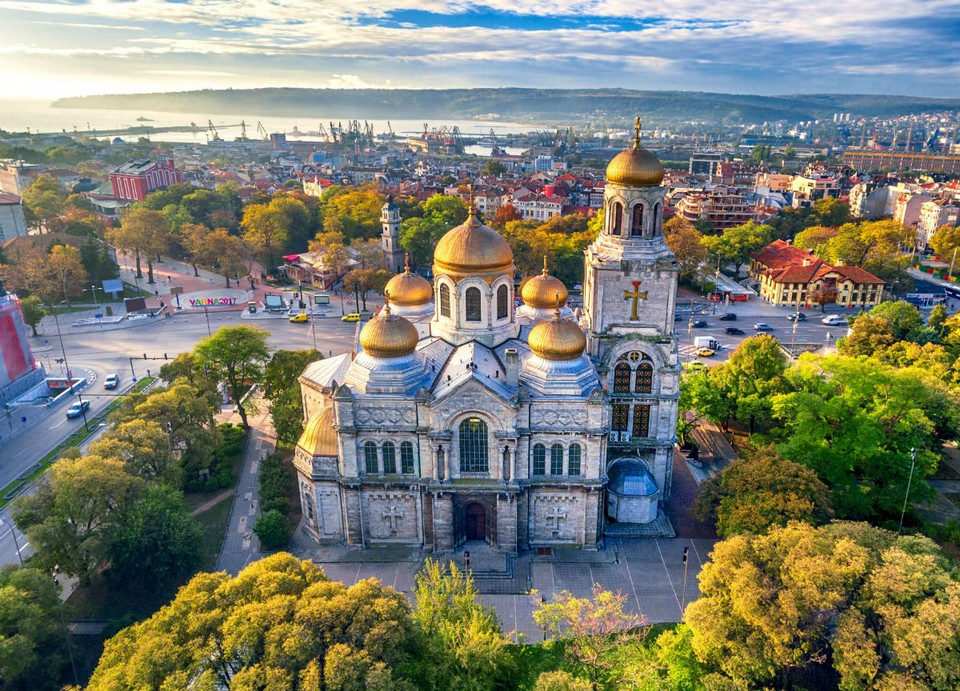
Read more: Where to eat in Sofia? — +11 best restaurants in Sofia Bulgaria and Bulgaria travel guide here .
Related articles
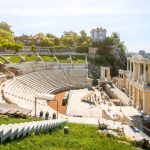
RELATED ARTICLES MORE FROM AUTHOR
Where to go in kunming — 15+ top kunming attractions & best places to visit in kunming, must eat in melaka — 10+ famous malacca street food & must try food in melaka, what to do in alishan — 5 top attractions & best things to do in alishan, taiwan, hong kong food culture — hong kong cuisine tells the historical story of the whole land.

Melaka food blog — Experience Melaka delicacies, arrived at by Trishaw
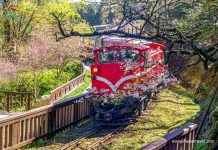
Alishan travel blog — The fullest Alishan travel guide for first-timers
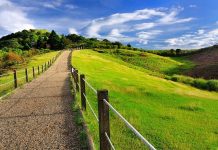
Gingtiangang Grassland Yangmingshan — The ultimate guide on how to go & top things to do
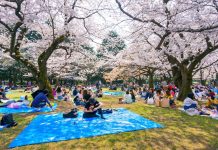
Tokyo best parks — 10+ best & most beautiful parks in tokyo
Editor picks.

Explore Fenqihu old street — What to do in Fenqihu in...

What to eat in Chongqing? — 14+ most famous, best food...

Where to go in Kunming? — 15+ top Kunming attractions &...
Popular posts.

What to buy in USA? — 17+ must buy in USA...

Must buy souvenir in Taiwan — Top 17+ most famous, cheap...

Must buy in Korea — Top 23 cheap, famous & best...
Popular category.
- Inspiration + Guide 1454
- Trip Inspiration 469
- Thailand 209
- Food + Drink 207
- Coasts + Islands 193
- South Korea 168
- Vietnam 166
- Travel Photos 144
- Work for Us
- Terms & Conditions
- Privacy Policy

Is Sofia, Bulgaria Worth Visiting? A Complete Travel Guide for Bulgaria’s Capital City
- Post last modified: March 2, 2024
- Post author: Danielle Zito
- Post published: March 13, 2023
- Post category: Europe
Sharing is caring!
This capital city is one of the most popular in south Eastern Europe , but is Sofia, Bulgaria worth visiting?
I actually visited this city on two different occasions, and had two totally different experiences between the nightlife, nature, and soaking up the culture of the city.
In this guide we're going to dive into everything you need to know for visiting, from the best things to see in Sofia, to the best ways to get around, and more. Most importantly, we're also going to help you decide if Sofia, Bulgaria is worth visiting. Let's jump right in!
*Please note that this blog post may contain some affiliate links, which we make a small profit on, at zero cost to you. Links are only used on products & services that we've used and believe in, to give you the best buying experience. Purchasing from these links helps us to continue providing free travel guides for you- so thank you for your support!
Where is the City Sofia Located?
The city Sofia is located in the center of Western Bulgaria . The country of Bulgaria is situated in south Eastern Europe , and shares borders with Greece to its South, Macedonia to its south west, Serbia to its north west, Romania to its north, and Turkey to its south east.
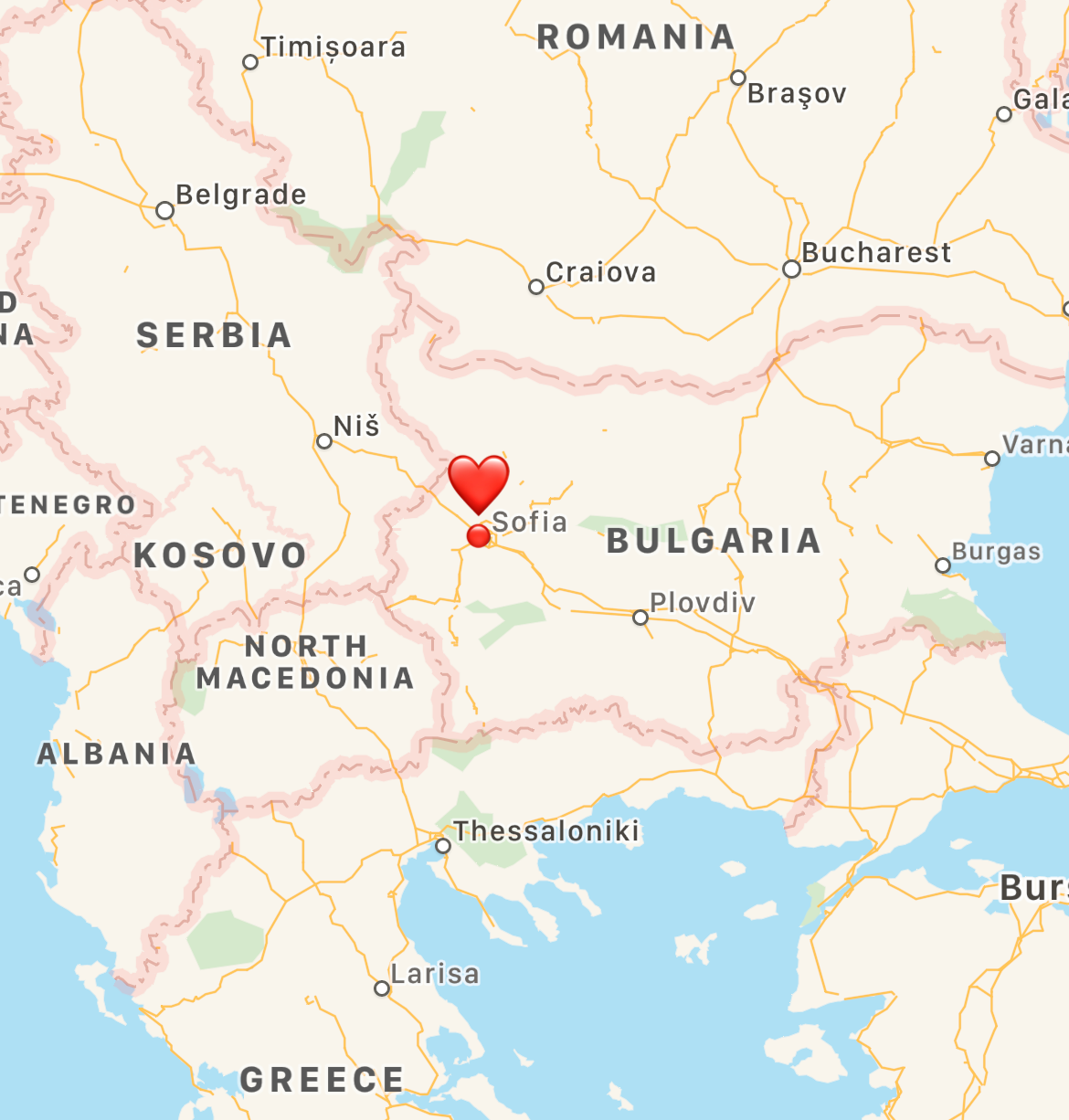
Sofia is located on the west side of Bulgaria.
How to Get to Sofia Bulgaria
Now that you know where the city Sofia is located, let's look at the different ways to get there!
Flying: Where is the nearest International Airport to Sofia?
Sofia has an International Airport that is just 12.2 km from the center of the city. Sofia is a big hub for Eastern European flights, and plenty of budget friendly options.
European cities that fly direct to Sofia include Alicante, Amsterdam, Athens, Baku, Barcelona , Basel, Belgrade , Berlin, Birmingham, Bologna, Bournemouth, Bratisalva, Bristol, Brussels, Bucharest , Budapest , Catania, Chambery, Cluj Napoca , Cologne, Copenhagen , Dortmund, Dublin , Edinburgh , Eindhoven, Frankfurt, Geneva, Gran Canaria , Hamburg , Istanbul , Karlsruhe, Larnaca, Leipzig, Lisbon , Liverpool, London, Madrid , Malaga, Malta, Manchester, Memmingen, Milan , Munich, Naples, Newcastle, Nice, Nottingham, Nuremburg, Paphos , Paris, Pisa, Prague , Rome , Stockholm, Valencia, Vienna , Warsaw, Zagreb , and Zurich .
The only domestic flight that goes to Sofia is Varna and the other cities around the world that fly to Sofia include Aqaba, Djibouti, Doha, Dubai , Fes, Hanoi, Hurghada, Phuket , Sharjha, and Tel Aviv.
Flight Tip: Using Skyscanner you can use the calendar feature to compare which are the cheapest dates to fly to Sofia.
Search for a flight to Sofia:
How to Get to the City Center from Sofia Airport
The easiest and cheapest way to get to the city center from Sofia airport is by taking the metro. Tickets are 1.60 Lev, and the ride is 25 minutes, with trains leaving every 15.
There are also taxis available outside the airport, which cost around 20 Lev, and the ride is a little under 20 minutes. Uber is banned in Bulgaria , so Uber is not an option to get to the city center from Sofia Airport.
Buses to Sofia
If you are traveling through the Balkans, you won't necessarily need to fly to Sofia, but can take one of the many buses that go to Sofia from surrounding big cities.
Here are a few of the most popular routes that you can book from International cities:
- Athens to Sofia
- Belgrade to Sofia
- Bucharest to Sofia
- Skopje to Sofia
- Thessaloniki to Sofia
Here are a few of the most popular domestic routes:
- Burgas to Sofia
- Plovdiv to Sofia
- Varna to Sofia
Travel Planning Services
Travel More . Spend Less .
Let us help you plan your dream trip.
Entry Requirements for Bulgaria
Now that you know how to get to Sofia, let's jump into the requirements for entering the country of Bulgaria.
Visa Entry Requirements
Bulgaria allows foreigners to visit for a period of up to 90 days within a 180 day period. This country is not part of the Schengen Zone yet, so you won't need to worry about expiring your time in Europe by visiting Bulgaria.
Covid Entry Requirements
All requirements to enter Bulgaria due to Covid-19 have now been lifted. Masks are also not required for entering any establishments or for public transportation.

All Your Travels
In one book.
Transform your travel memories into a unique book, with personalized pages, country by country.
Local Adjustments for Bulgaria
Whenever traveling to a new country there are things that you may need to adjust to, which are different from your home country. Here are a few of the local adjustments to keep in mind while traveling to Sofia, Bulgaria.
What Language is Mostly Spoken in Bulgaria
The official language in Sofia is Bulgarian, which is a Slavic language. Bulgarian is written in Cyrillic, which is the same alphabet used by countries such as Russia , Ukraine, Serbia , and Macedonia .
Is English Widely Spoken in Bulgaria?
Depending on the area of the country will depend on the level of English that is spoken. Being that Sofia is the capital, you will find plenty of people that speak English, as well as many things such as menus in signs also in English.
What is the Main Currency in Bulgaria?
The currency used in Bulgaria is the Bulgarian Lev. Currently (March 2024) 1 USD or Euro is equivalent to 1.81 Bulgarian Lev, and 1 British Pound is equivalent to 2.28 Lev.
Can you use the Euro in Bulgaria?
While Bulgaria doesn't use the Euro, there are some places that will accept Euros if it is the only thing that you have on you. We suggest taking local money from an ATM so that you have plenty of Bulgarian Lev on you.
Many restaurants and hotels will accept credit card, but there are some that will only accept cash. It is also great to have extra cash on you for street vendors or for tipping.
Is Sofia Bulgaria Cheap?
Overall, the country of Bulgaria is pretty cheap, especially for European standards. Being the capital, Sofia has plenty of budget friendly options, but also some higher end restaurants and hotels that you can expect to splurge a bit more.
Plug Types in Bulgaria
Bulgaria uses the same plug types as the rest of Europe , which are types C & F. The standard voltage in Bulgaria is 230 V and the standard frequency is 50 Hz.
If you are coming from the Americas, you will need to get a travel converter (not just an adapter) so that your electronics won't blow out.
Water Quality in Sofia, Bulgaria
The water in Sofia and other areas of Bulgaria are completely safe to drink. Restaurants will typically bring bottled water in restaurants in Sofia, but you can request to drink the tap water instead.
Tipping in Bulgaria
The tipping culture in Bulgaria is similar to many other European countries . While tips are not required, it is standard to leave 10% for a tip at a restaurant, and to do so in cash (you can't add it onto the credit card). If you feel you've received excellent service, you could leave a little extra.
Is Sofia, Bulgaria Worth Visiting? Things to Do in the City
Now that you know almost all of the basics, let's get into the fun stuff! Here is where you will be able to be asses if Sofia, Bulgaria is worth visiting or not. Here are the best things to do in Sofia.
Don't have time to read the whole article and want to save it for later? Just pin it!
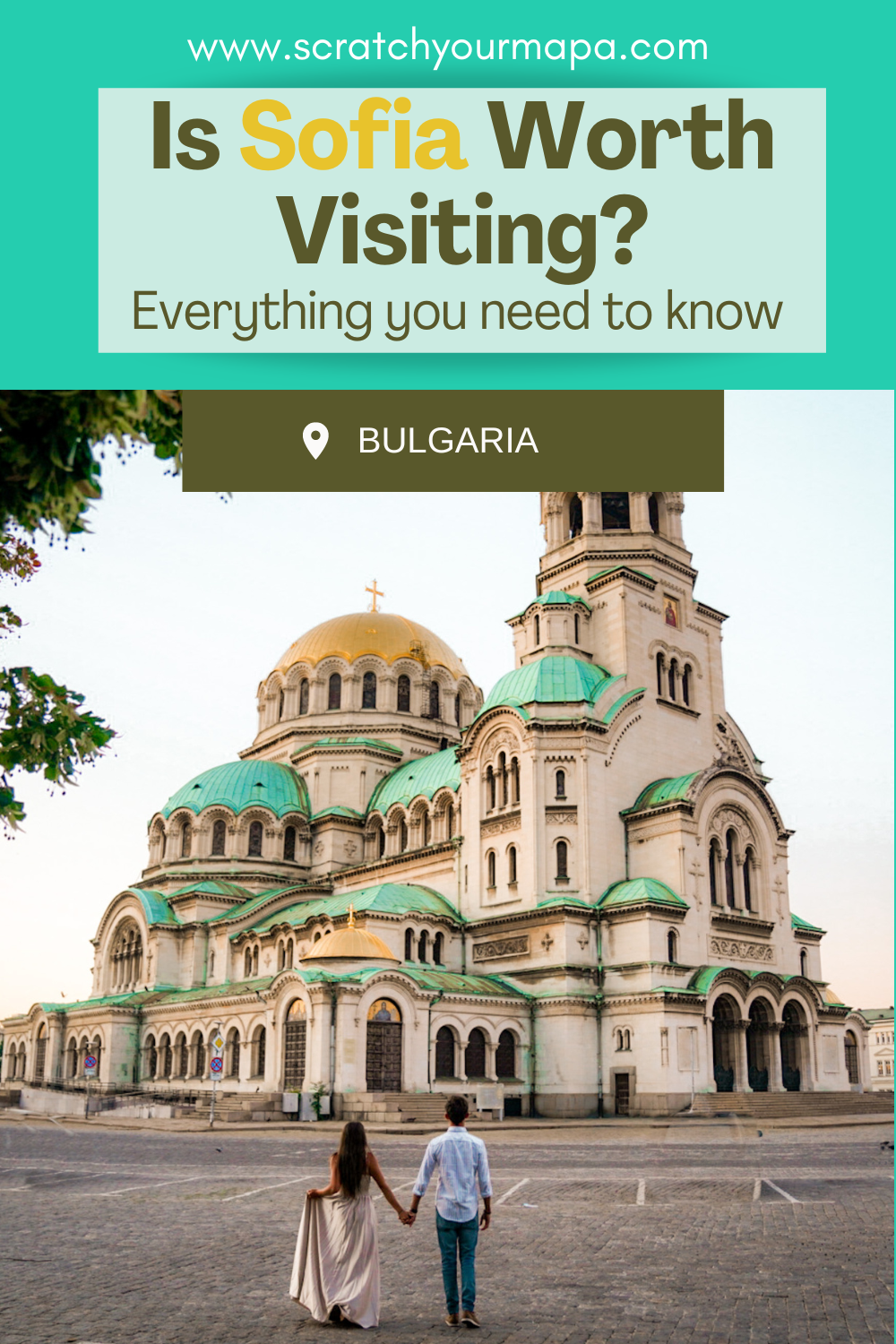
Take a Free Walking Tour
One of our favorite ways to explore somewhere new is by taking a free walking tour. We particularly think they are our favorite for Balkan cities . This is because they usually don't have many "iconic locations", but definitely don't lack in history!
Locals always know the city best, and they can dive into the hidden gems of Sofia, as well as give you great insight to the best places to eat and drink. Tours are completely free, and work on a tipping basis, so make sure to carry some cash with you.
You can sign up online for daily walking tours, either at 11 am or 2 pm. There are two different groups- one that is for English speakers, and one that is for Spanish speakers.
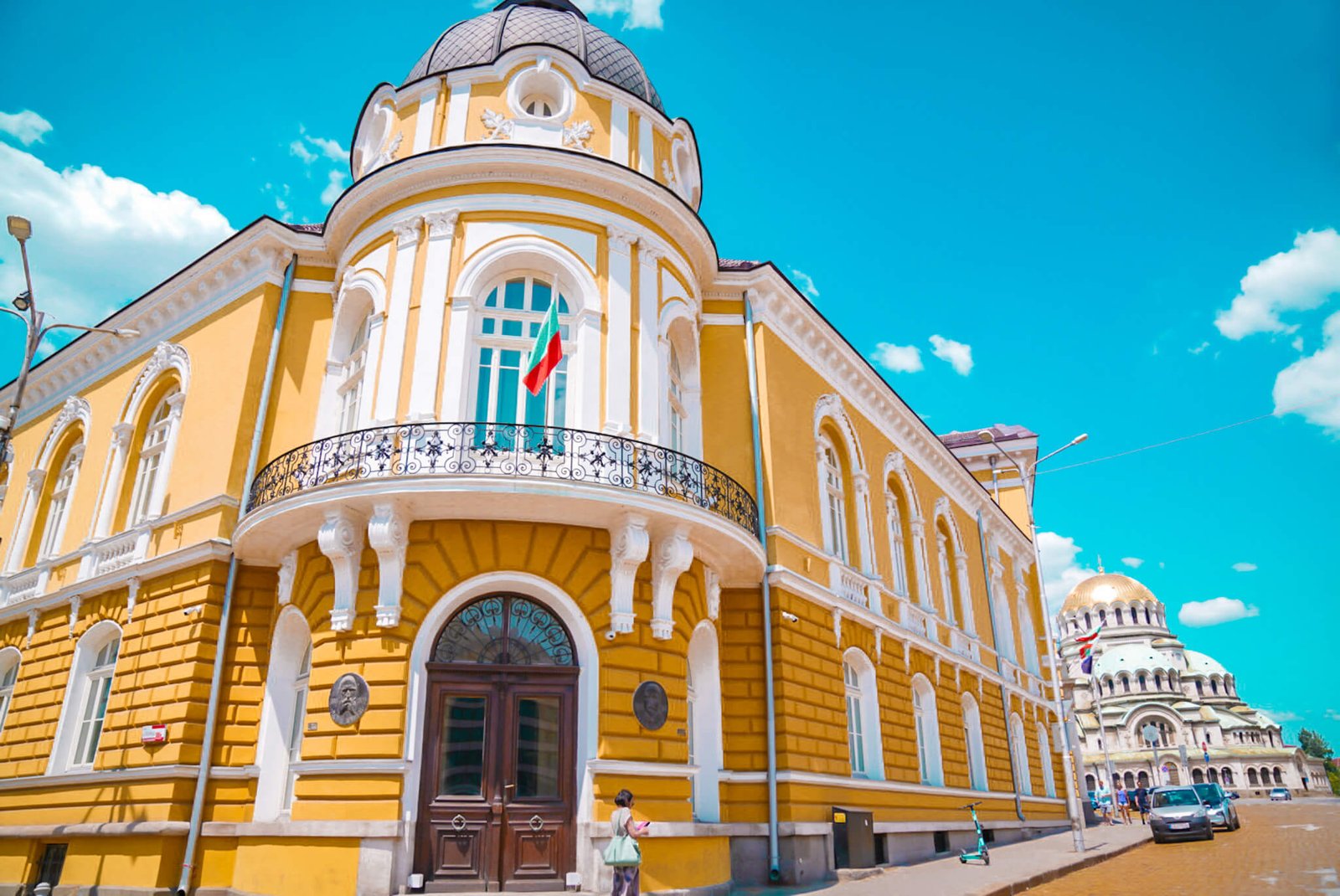
Free Walking Tours are the best way to explore the city.
Explore the Highlights of the City
If doing a tour isn't your thing, or doesn't fit your timetable, then you can add these different sites onto your list of things to see in Sofia.
St. Alexander Nevsky Cathedral
This is definitely the top at the list for things to see in Sofia. In our opinion, Sofia, Bulgaria is worth visiting solely for this iconic structure. St. Alexander Nevsky Cathedral is located in the heart of the city center, and is so breathtaking with its turquoise and gold domes.

St Alexander Nevsky Cathedral is one of the main reasons that Sofia, Bulgaria is worth visiting.
National Palace of Culture
This is another one of the top things to see in Sofia, Bulgaria. The National Palace of Culture is the biggest conference and exhibition center in all of south Eastern Europe . The beautiful building is surrounded by fountains and gardens, making it another one of the most remarkable places to visit in the city.
St. George Rotunda Church
This red brick rotunda was originally built in the 4th century as Roman baths, and has since been converted to a church, and one of the top things to see in Sofia.
Church of St. Nicholas the Miracle
This Russian Orthodox Church is another stunning building that is located in the heart of Sofia. While we didn't get to visit inside, the architecture was amazing to admire from the outside.
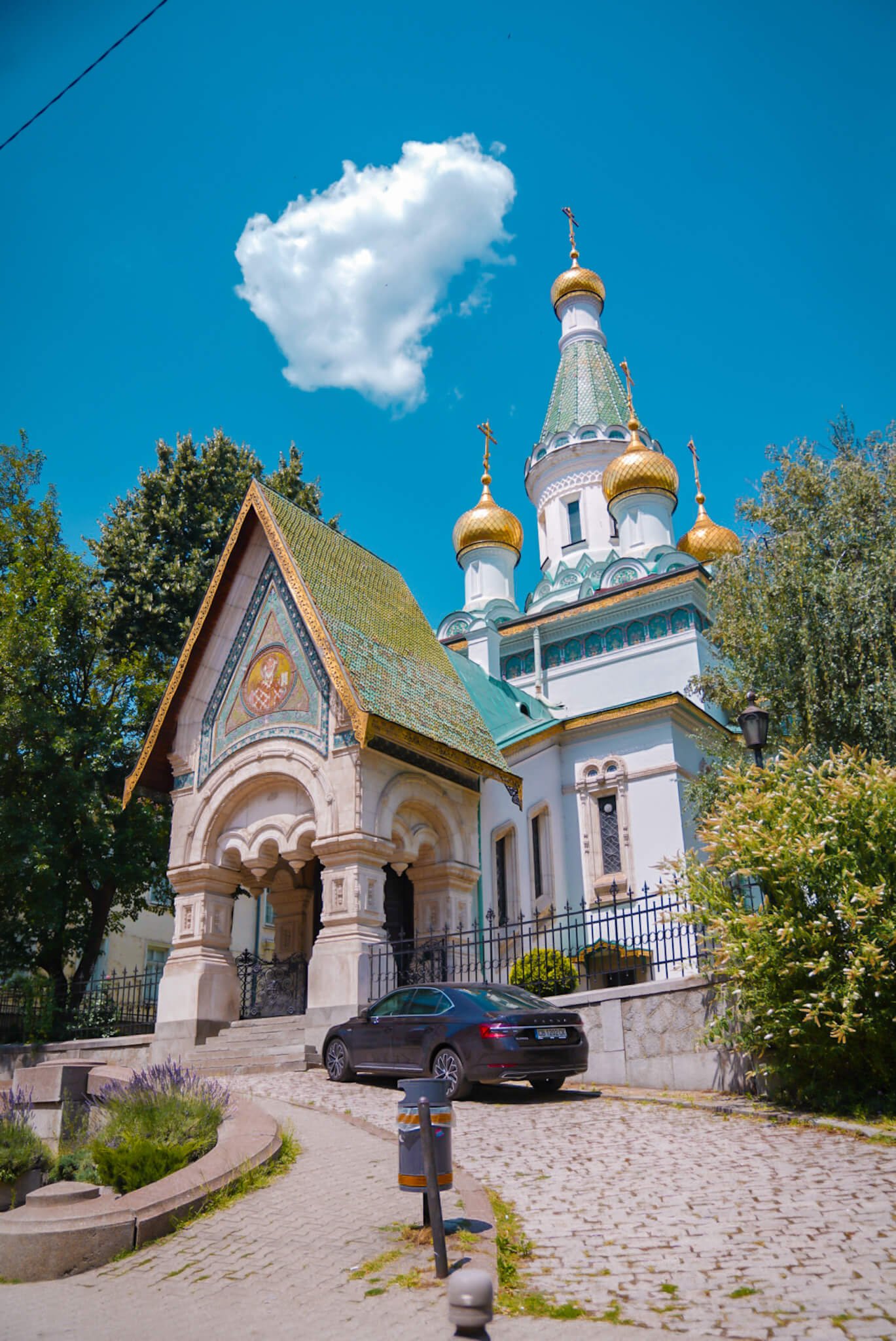
Boyana Church
This Orthodox church is a bit on the outskirts of Sofia, but nonetheless worth a visit. Built in the late 10th century, it is recognized as an UNESCO World Heritage Site.
Regional History Museum
Originally mineral baths from the 20th century, this building is now preserved as a museum where you can go and learn about the history of Sofia and Bulgaria.
The Palace- National Art Gallery
This is Bulgaria's biggest art gallery, and is home to over 50,000 pieces of Bulgarian art.
Ivan Vazov National Theater
This is the biggest and most impressive theater in the whole country, and is located in the heart of Sofia's city center.
Admire the Architecture
Apart from the top things to see in Sofia, there are also so many buildings worth checking out. There are tons of architectural gems in the city, so simply roam the streets and appreciate all of the beautiful designs you can find.
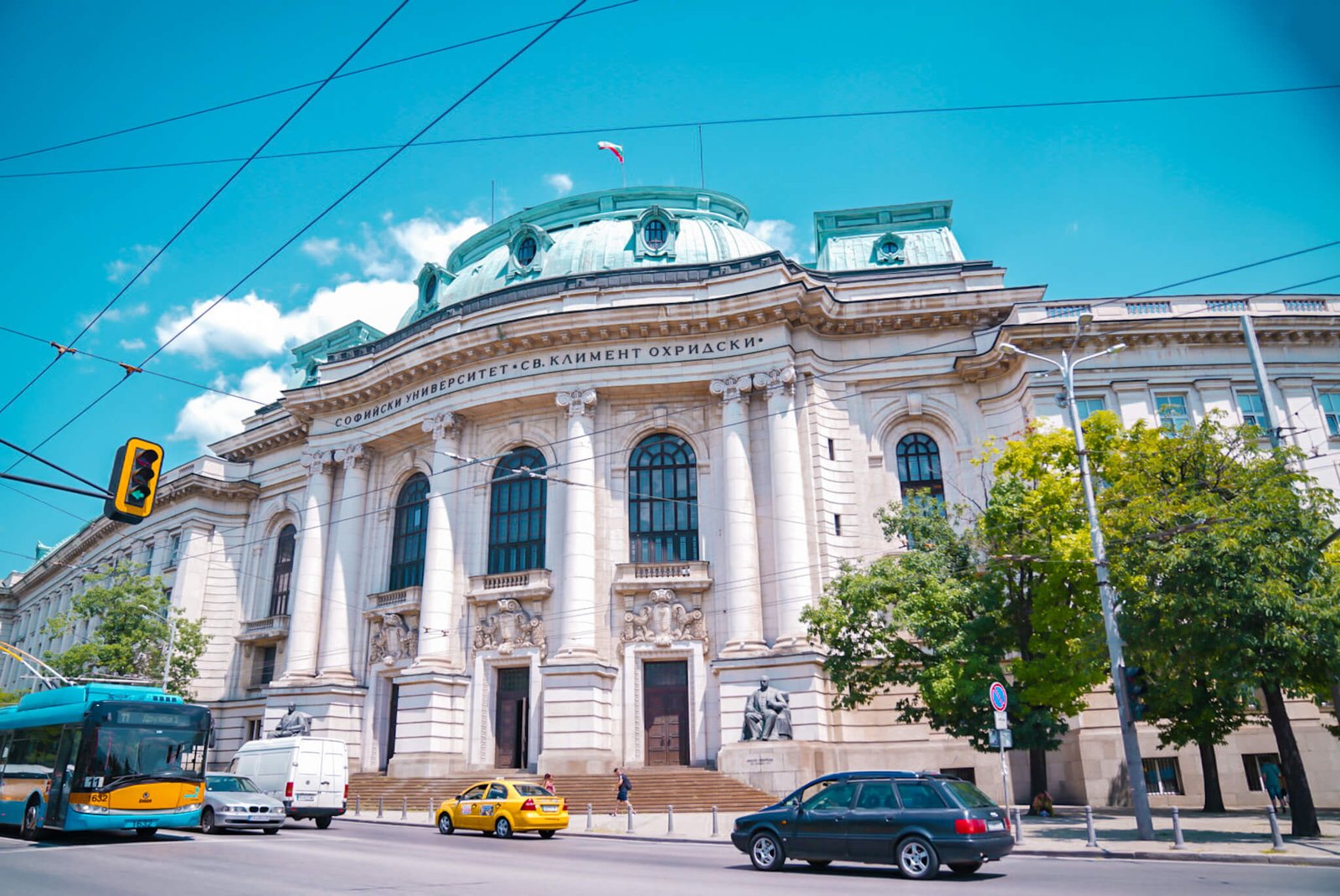
Sofia, Bulgaria is worth visiting for its beautiful architecture.
Visit a Rooftop Bar
Right around the main square of Sofia you will find a number of great rooftop bars. We suggest going for sunset and enjoy an appetizer and a drink, while admiring the gorgeous views of the city. Make sure to make reservations in advance if you can, as they tend to fill up with both tourists and locals alike.
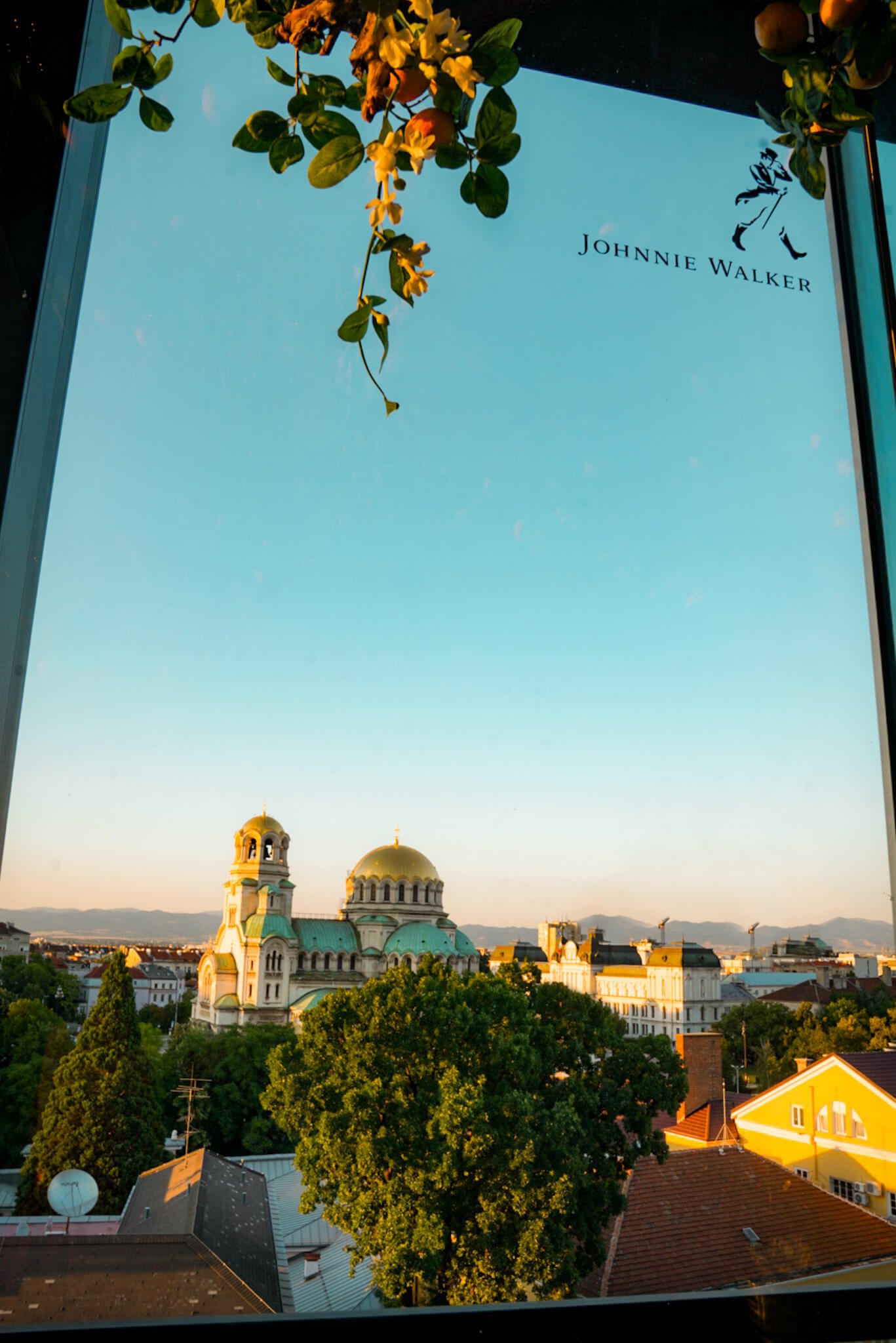
Sense is one of the most popular rooftops in Sofia.
Three of the most popular rooftop bars in Sofia are located in hotels, which include Sense, Sky Bar, and the Scene.
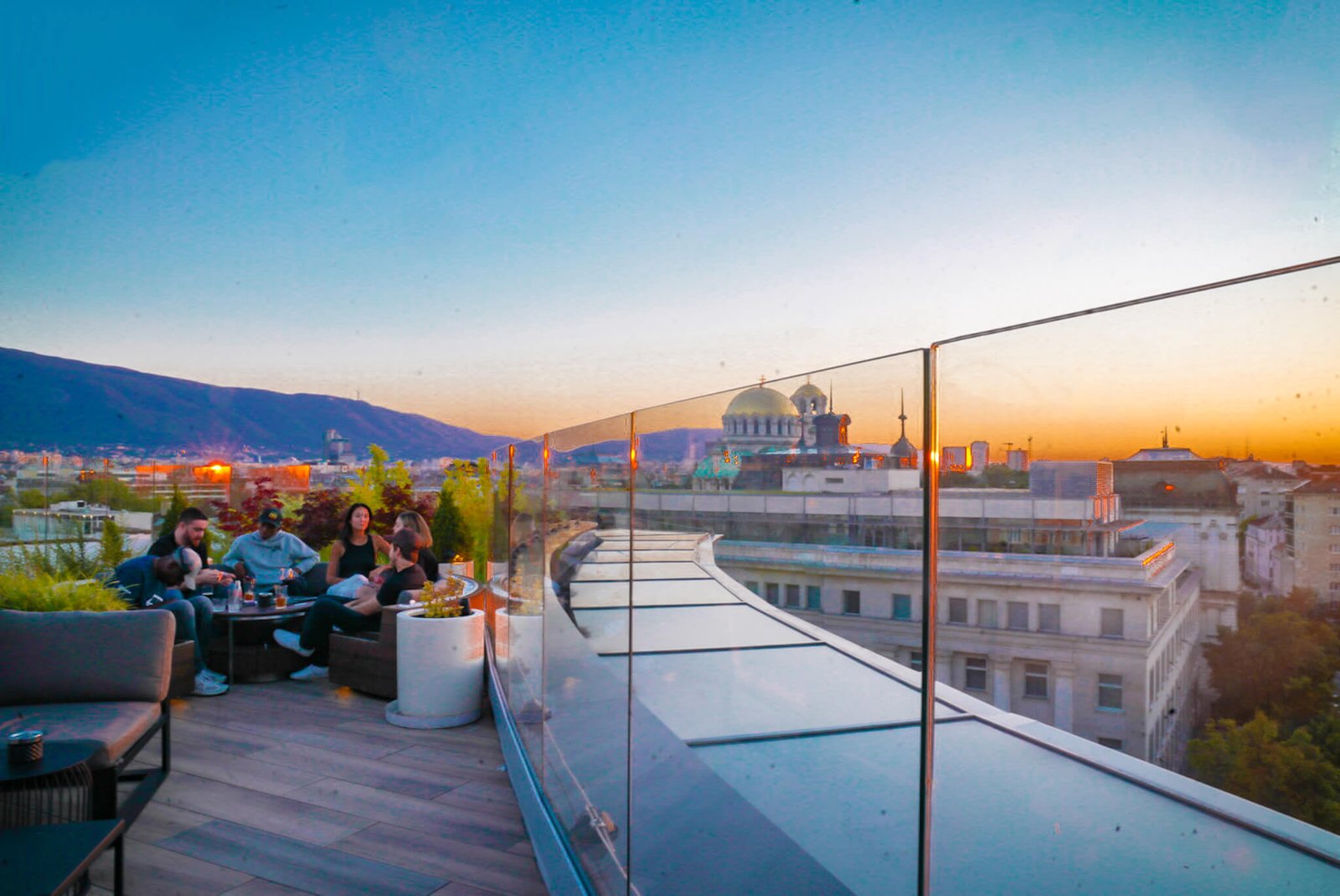
The best time to hit the rooftop bars is during sunset.
Enjoy the Nightlife of Sofia
The first time I went to Sofia I went out with a bunch of people that I met in my hostel. We all went to a bunch of bars and clubs, and partied all night long. Sofia has great nightlife, and in my opinion is another one of the reasons that Sofia, Bulgaria is worth visiting!
Most of the nightlife is located right in the city center, along Boulevard Vitosha and Ulitsa Rakovski. Head there and get ready to have a wild night out!
Hike Vishtosha Mountain
Looking to get out in nature? Well, luckily you don't need to go too far for a great hike in the outdoors.
Sofia is situated right next to Vitosha Mountain, which peaks at over 2,000 meter high. Taking 3.5-4 hours, there are great hiking trails to reach the top, giving breathtaking views around it. It is easily accessible from the city center. All you need to do is take a bus to the Golden Bridges.
My friend and I attempted the hike during my first time in Sofia. We actually got a bit lost (not sure how) and ran out of time before making it to the top! That being said, it is definitely on the list for whenever we visit again, and we've heard that the hike is definitely worth the reward at the end.
Climb Seven Rila Lakes
This is our favorite hike in Bulgaria, and definitely one of the best day trips from Sofia. Seven Rila Lakes are a group of 7 different lakes all situated in the mountains. The hike allows you to see all of them, with a viewpoint where you can appreciate seeing 6 of them at once!

One of the best day trips from Sofia is Seven Rila Lakes.
You can reach here by renting a car, or by taking a tour, and you can book one below:
Want to learn more about this epic adventure? Check out our full guide below!
Take a Trip to Rila Monastery
Located in the same region as Seven Rila Lakes is one of the most beautiful monasteries in Bulgaria. Rila Monastery is located 117 km south of the city of Sofia, and is the perfect day trip from the capital. This is definitely something you'll want to do as a tour, which can also be combined with Boyana Church.
Book a tour to Rila Monastery:
Food & Drink in Sofia
Sofia has great food, with both Bulgarian and international cuisine. Bulgarian food has many similarities with surrounding countries like Greece , Macedonia , and Romania . Fresh cheeses, olive oil, and grilled meats are some of the staples. Meals are affordable, and you can find a great variety,
Here are a few of the local dishes you should try:
- Banitsa: a cheese filled pastry that's very popular for breakfast
- Shopska Salad: staple salad in the Balkans with tomato, cucumber, and cheese
- Tarator: a cold yogurt-based soup with cucumber and dill
- Sarmi: stuffed cabbage
- Moussaka: similar to Greek Moussaka, but instead of eggplant they use potatoes
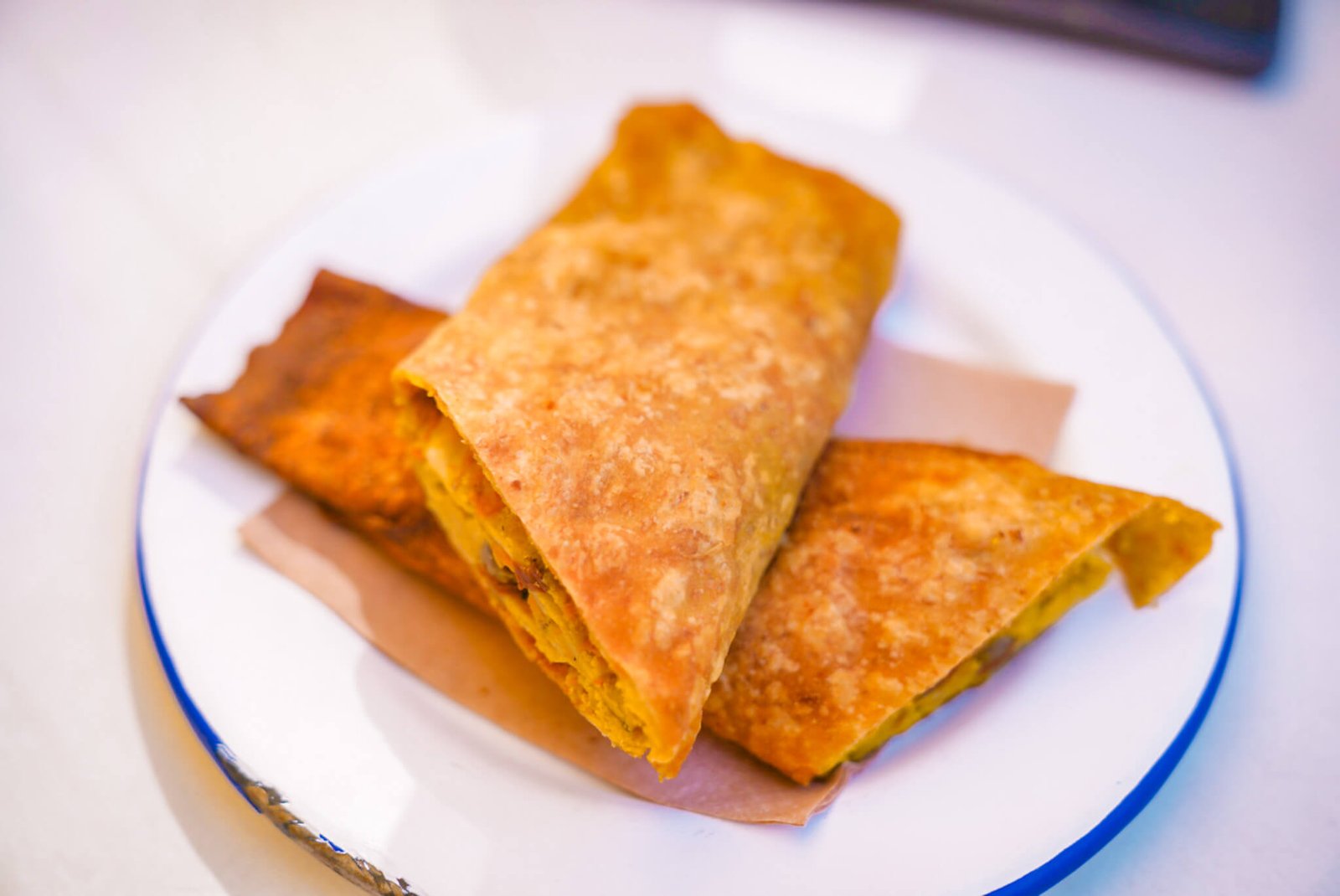
Banitsa was our go-to option for breakfast.
Here are a few restaurants we recommend:
- Rainbow Factory: great breakfast spot
- Sun Moon: an adorable Vegetarian restaurant with both indoor and outdoor seating
- The Little Things: restaurant with a garden and local ingredients- perfect for lunch
- Made in Home: cozy restaurant with home cooking- cash only
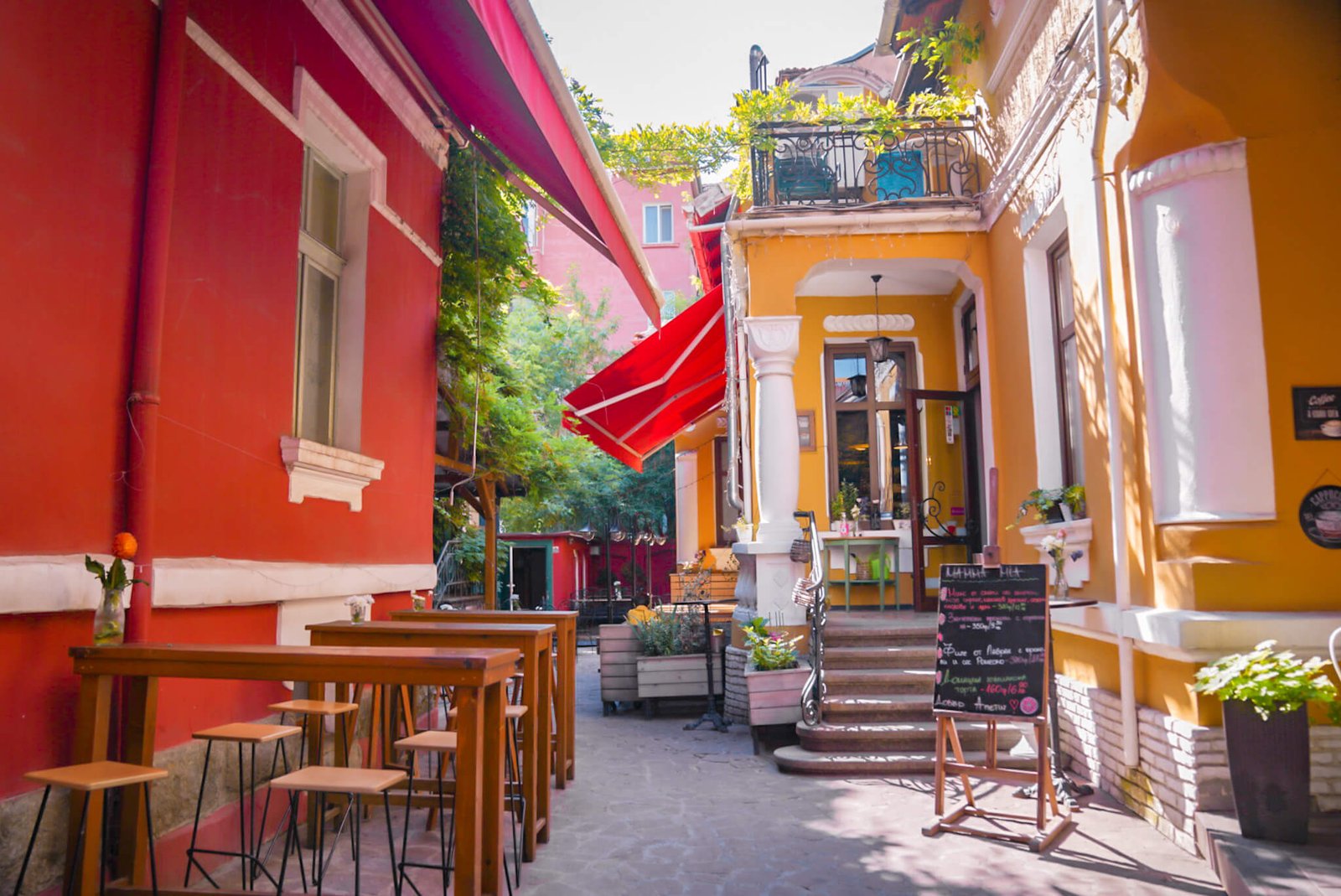
Sofia has a great food & drink scene.
How To Travel Cheaper and Better in 15 minutes!
How much more would you travel, if it costed you less resources?
With our Free eBook, you will learn how to save money and time on your future trips . Plus, you'll see the exact system we use.
Grab your copy for free when you sign up for our newsletter 👇
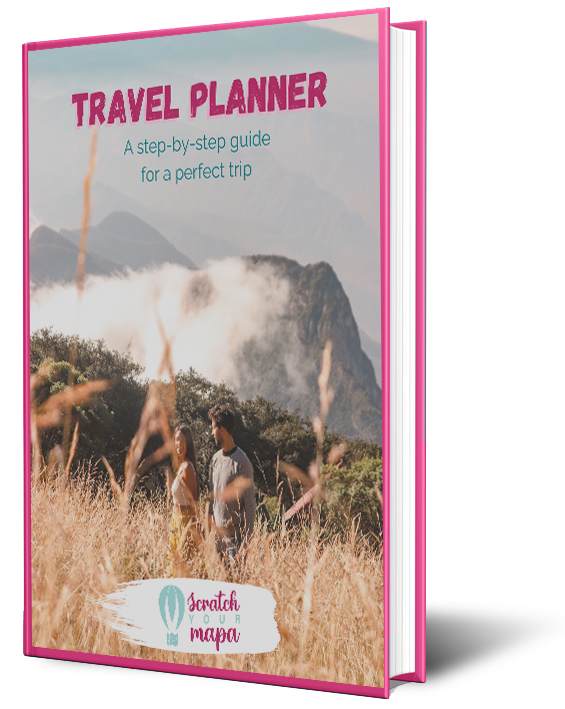
Getting Around Sofia
The city of Sofia has metros, public buses, and taxis readily available for anywhere you would want to go in and around the city. Uber isn't available, but the transportation prices are all very reasonable.
Is Sofia a Walkable City?
The top things to do in Sofia are all within walking distance, which is another reason that we think Sofia, Bulgaria is worth visiting. It's super easy to get around and explore, so you rarely need to get taxis or public transportation.
Renting a Car in Sofia
If you'd like to do some of the amazing day trips around Sofia, then renting a car will be very helpful! Cars are very affordable, and can easily be rented from the airport. We suggest booking in advance so for the best rates and availability.
Here is a site we typically use to book our rentals:
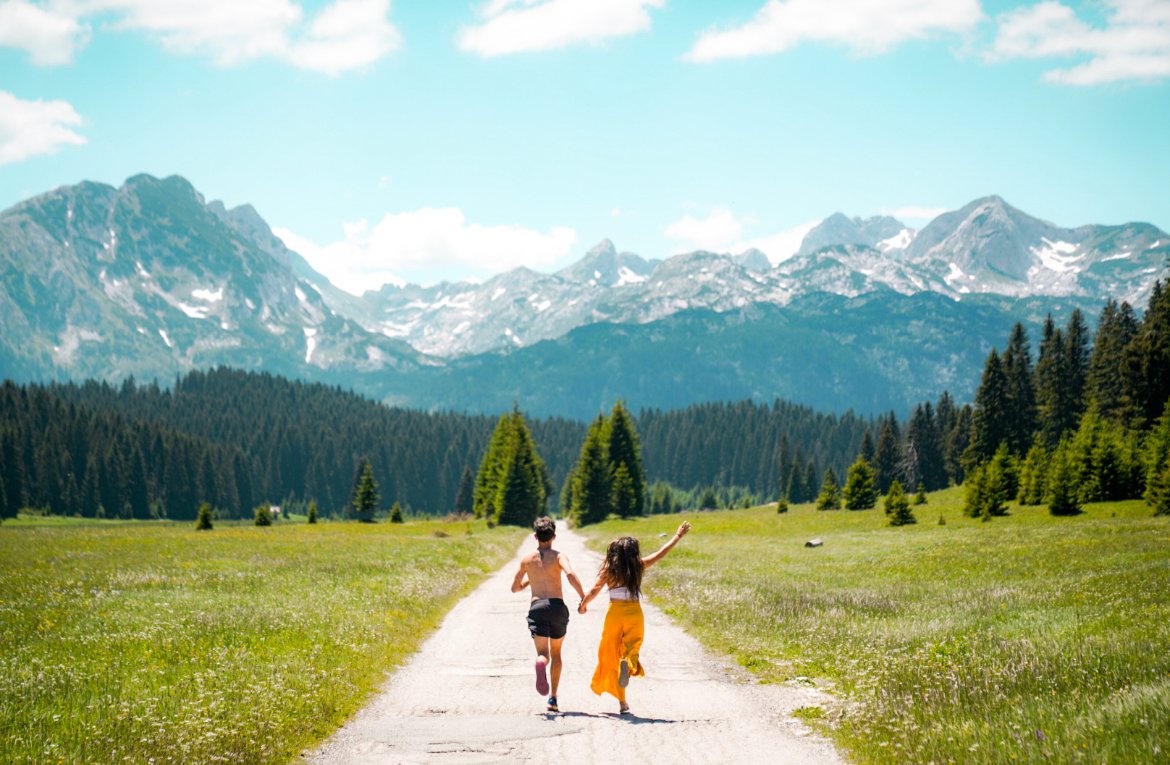
Stay Up To Date📫
We have a non-spammy weekly newsletter, where we give travel tips, and exclusive content and discounts .
Where to Stay in Sofia, Bulgaria
Since the city center is quite small, we definitely suggest trying to stay somewhere within the center, preferably closer to St Alexander Nevsky Cathedral.
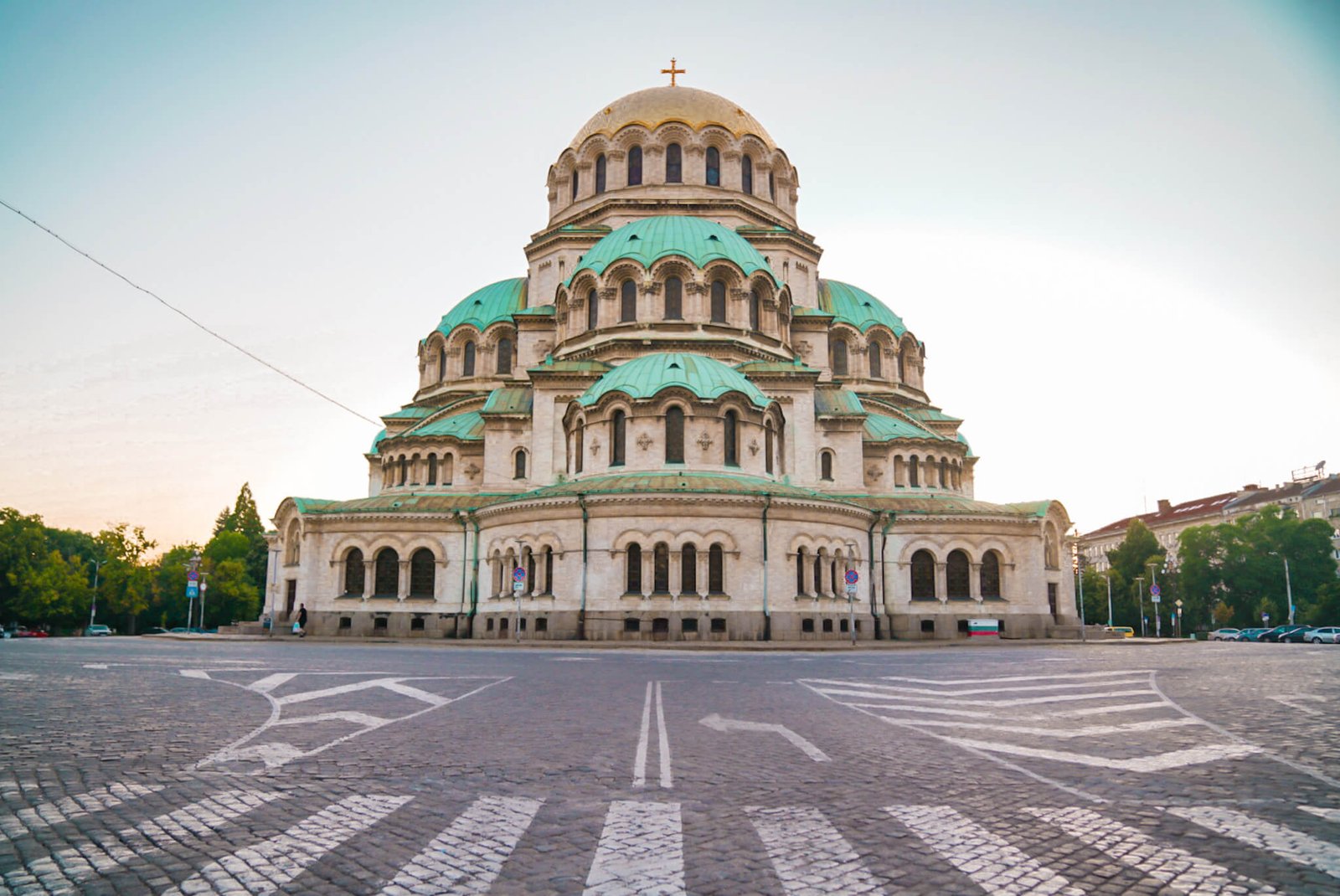
The city center is the best area for tourists to stay.
Both times that I visited Sofia I stayed in hostels. I found that it's truthfully one of the best cities to stay in shared accommodation, as the best part about Sofia is the social aspect. Meeting fellow travelers and experiencing the nightlife is exactly what made Sofia, Bulgaria worth visiting for us!
Of course if you are a family or visiting for business, we would suggest staying at one of the fancier hotels that surround the main square, or more established hotels in the area.
Check below for different accommodation options in Sofia:
Is Sofia Safe?
Overall, Sofia is a pretty safe city. However, we have heard about petty theft like pickpocketing or breaking into cars. While you can definitely enjoy Sofia traveling solo or at night, we do suggest keeping an eye on your belongings, and if you have a car, make sure to leave it in a paid lot, and nothing visible on site.

Transform your photos
One click is all it takes to make your photos look stunning. Get our latest package of Lightroom presets, Into The Wild .
Other Things to Know About Visiting Sofia, Bulgaria
Now you know almost everything you need to know for visiting Sofia! Here are a few more things we'd like to cover though:
What is the Weather like in Sofia, Bulgaria?
Sofia experiences all 4 seasons, with hot and sunny summers, and cold, snowy winters.
The Best Time to Visit Sofia, Bulgaria
We visited Sofia in the summer, and found it to be quite empty (many people head to the beach). We personally think Sofia is best enjoyed in the spring or fall, when there are more locals around, and the temperatures are still warm enough to enjoy the outdoors.
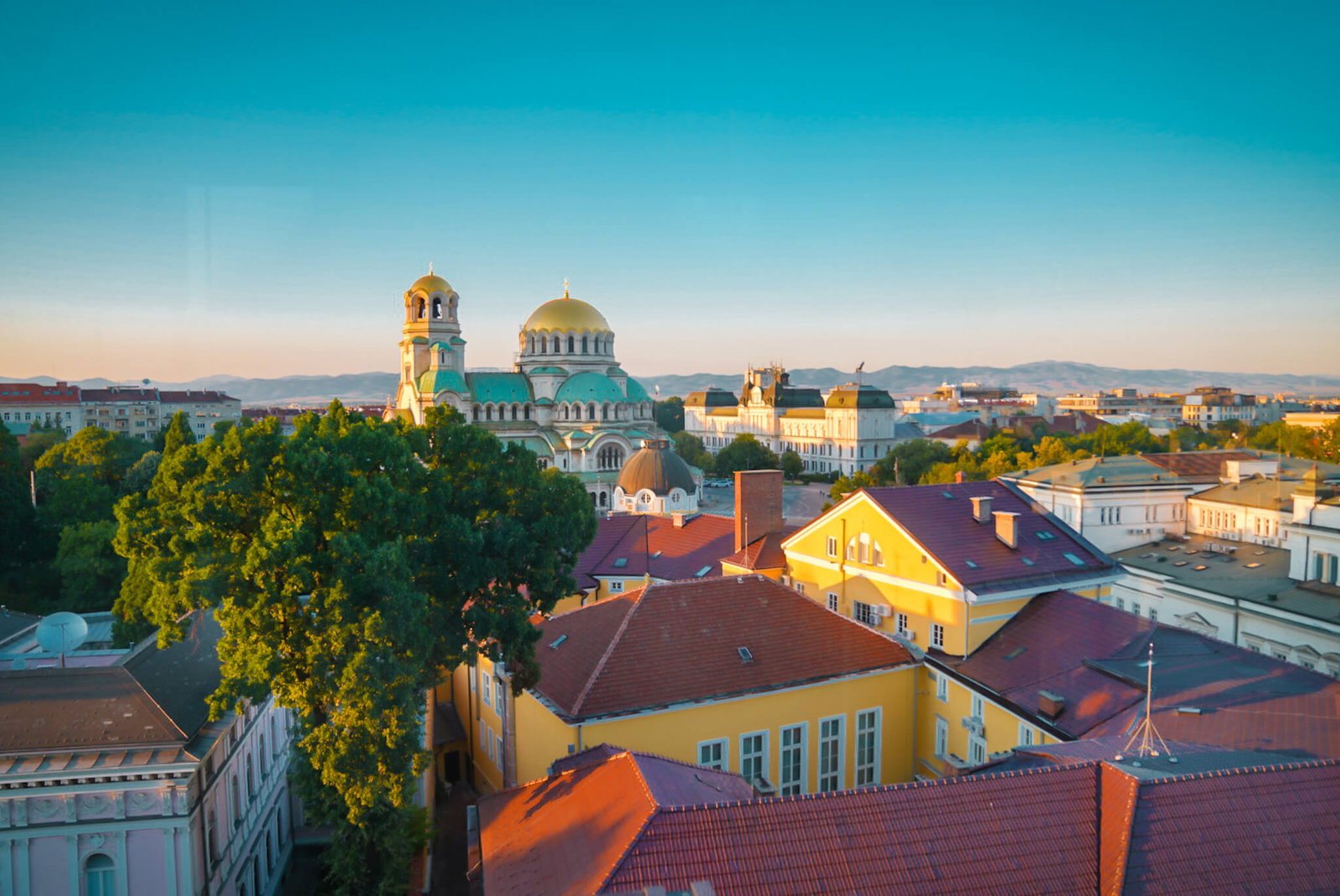
Sofia is pretty empty during the summer months.
Is Sofia Bulgaria Worth Visiting?
We definitely think Sofia, Bulgaria is worth visiting! While Sofia may not have a ton of things to see and do, it's a great place to soak up some Bulgarian culture, and to experience some great dining and nightlife. Being so well connected to surrounding cities, it really is the perfect place to spend a night or two.
Is 2 Days Enough in Sofia?
To see the city of Sofia itself, 2 days is definitely enough! We'd suggest spending one day exploring the city highlights, and the other day going to Vitosha mountain. If you have extra days you can then do some fun day trips, like Rila Monastery or 7 Rila Lakes.

2 days is enough in Sofia if you'd like to experience the city and one day trip.
Packing For a Trip to Sofia, Bulgaria
Packing for a trip to Sofia depends mainly on whether or not you plan on doing one of the hikes outside the city. Here are some of the things we'd suggest bringing:
- Reusable Water Bottle (we use 17oz Double Wall Vacuum Insulated Stainless Steel Water Bottle" rel="nofollow" style="outline: none;" target="_blank" class="">this water bottle from Cafago because it holds the temperature)
- Travel Adapter (we use Tessan travel adapters as they are affordable and reliable)
- Zippered Bag or Backpack (to secure your belongings)
- Lock (if you stay in a hostel)
- Power Bank (we use Anker Homepage" rel="nofollow" style="outline: none;" target="_blank">Anker power banks , as they are super long lasting and sturdy)
Here are a few things you may want to bring if you explore the outdoors:
- Sunscreen
- Drone (We use the Mavic Mini Pro 3 because it's super light and doesn't sacrifice quality)
- Action Camera (we use the Insta 360 X3 because it's small & waterproof)
What to Wear in Sofia, Bulgaria
We honestly saw all different styles when we were in Sofia. Being a capital city, you'll find some people dress very nicely during the day, while other dress very comfortably.
We'd suggest bringing whatever makes you comfortable for the day, and some nicer attire for the evening (especially if you plan on going to a rooftop). There are dress codes for some places, so it's important that men bring pants and closed toed shoes. (Fede was actually turned away from one place).
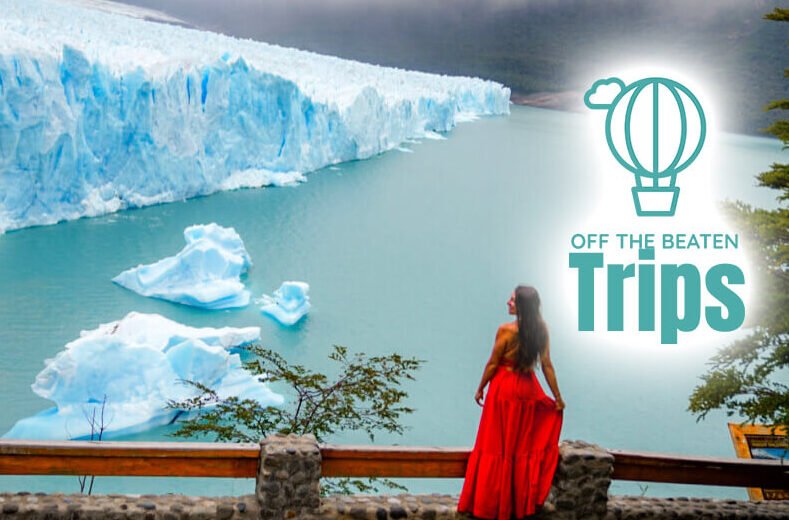
Looking To Travel Somewhere?
Off The Beaten Trips is our travel agency.
But this isn't anything like you've ever experienced before. You'll have an epic trip without having to break the piggy bank.
Unique locations. Epic adventures. Lifetime memories.
Travel Planning Tools
Here are some useful tools that you can use for planning your upcoming trip!
So, now that you know everything- what do you think? Is Sofia, Bulgaria worth visiting? We think it's definitely worth spending a day or two, so that you can experience the great dining and nightlife, as well as witness the stunning St. Alexander Nevsky Cathedral.
Planning on visiting other cities in the area? We have a ton of Balkan travel guides that we're publishing every week! Make sure to subscribe to our newsletter to stay up to date with the most recent articles, and so you can receive exclusive deals on our products and services.
Ready to start planning your trip? Well, now you don't have to spend all the time and energy doing so. We're dedicated to helping you find the best flight and hotel deals. With our customized travel planning services you can save both money and time, so that you can explore more and worry less. Just shoot us an email to start your free consultation today!
Here are some other articles you'll love:
February 27, 2023
How to Spend 1 Day in Tirana, Albania
The best places to visit in Albania are
January 16, 2023
What to Do in Pristina: The Capital City of Kosovo
Did you know that the capital of Kosovo
December 12, 2022
A Complete Guide to Visiting Skopje in Macedonia
Are you planning a trip to through the
October 13, 2022
What to Do in Bucharest for the Perfect Trip
Are you wondering what to do in Bucharest,
July 21, 2022
Lake Ohrid in Macedonia: A Sacred Balkan Paradise
Welcome to the most sacred and beautiful place
December 23, 2021
10 Great Things to Do in Thessaloniki Greece
Did you know that Thessaloniki is the second
Like this article? Please share it with your family and friends, so that we can continue to keep creating free travel guides for you! It takes just a second, and would mean the world to us. Thanks for being here!
You Might Also Like
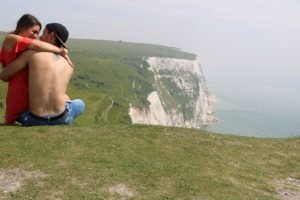
Dover, United Kingdom: Home to the Stunning White Cliffs

The Island of Gran Canaria: Everything You Need to Know
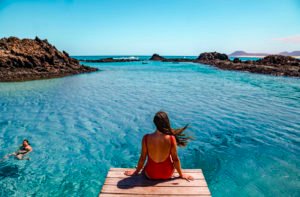
A Trip to Isla de Lobos: One of the Best Things to Do in Fuerteventura
- Destinations
Is Sofia Bulgaria Worth Visiting? What To See and Do (Plus: How Long You Need!)
- April 13, 2022
Sofia is the capital of Bulgaria, but is it worth adding to your bucket list?
Here I will share the best things to see and do in Sofia, as well as where to stay, where to eat, and how to get around.
Plus : How long to spend in Sofia, and whether you should even bother!
Grab a coffee and take a deep dive with me, into Sofia Bulgaria.

Is Sofia Worth Visiting?
If you are just here for the short answer:
Yes. Sofia is worth the trip. Sofia is a slow burn however, and is better when you have time to get to know her.
Why Visit Sofia Bulgaria?
There are a lot of great reasons to visit Sofia, but here are the best of the best! :
- Sofia is affordable
- Sofia has great food
- Experience Sofia’s unique culture and atmosphere
- Sofia has an amazing history
Sofia is Affordable
For a major city in Europe, Sofia is ridiculously inexpensive across the board. Here are all of the things that you can save money on, when you travel to Bulgaria .

Sofia (and Bulgaria in general) is one of the rare places that you may not save a ton of money by cooking for yourself.
You can’t haphazardly grocery shop and make pretty much anything at your apartment and still save money over eating at a restaurant.
If you do some good meal planning you could definitely save a few bucks, but eating out for every meal won’t break the bank.
$25 – $30 USD per person per day would be plenty for food – even if you’re eating out.

Cheap Transportation
Getting around in Sofia is very affordable. A taxi ride will not cost you more than $5 – $10 no matter where you are going in the city.
(Unless you have luggage! Then you may get gouged like anywhere else.)
Sofia has a limited and outdated metro system, but tickets will only cost you about $1 USD.
Plus, walking is free, and the city is pretty pedestrian friendly.
Free and Cheap Things to do
There are a number of quality free things to do in Sofia, which I will cover in a moment, under “Things to do.”
Another great reason to visit Sofia!

Affordable Accommodation
Sofia is more expensive than the rest of the country, but it still doesn’t push anywhere near the prices of other European capitals.
You can get a nice place in central Sofia for less than $300 USD per week . That’s just $42 per night!
(I will list some popular accommodation in just a minute.)
Depending on when you go and how much space you need, you can also find accommodation for under $30 per night.
Sofia has Good Food
Sofia isn’t just home to cheap food, it’s good food. This city has a budding art and foodie scene, and we’re here for it.
Sure there is a lot of pizza, but Bulgaria has a lot of other great comfort foods. A lot of the offerings are simple but delicious.
Sofia has a Unique Culture
I know some would scoff at the idea of Soviet “culture,” but Sofia has a very unique blend of Bulgarian folk culture mixed with their modern history of communism.

It’s present in the architecture and in people’s attitudes.
(Take that as you will.)
Sofia has a Long and Interesting History
Sofia has been around in one form or another since the neolithic era. Artifacts have provided evidence of settlement since 4000 BC or even earlier! That’s insane.
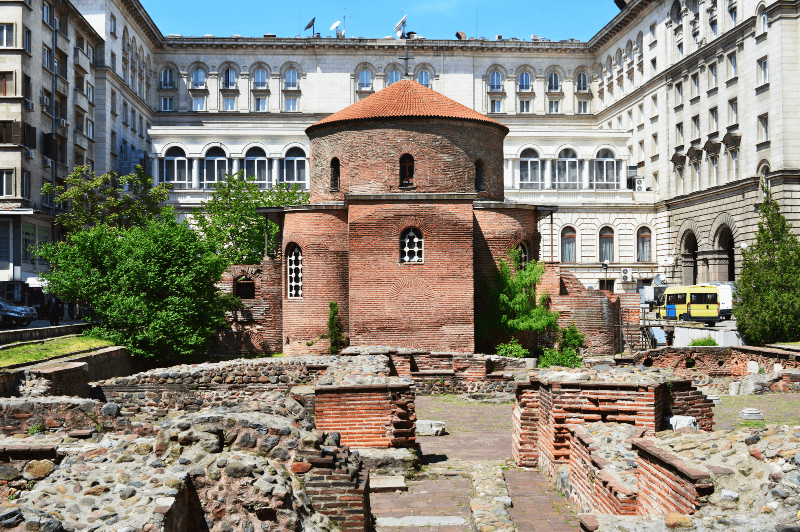
The best preserved history is from the time of ancient Serdica all the way through to medieval times.
Sofia isn’t just a cheap place to visit with a big church! Baby got back…story.
Why Visit Bulgaria?
Bulgaria has all of the same price perks that Sofia does.
Across the country you will find affordable:
- Accommodation
- Transportation
- Things to do (many free)
What else does Bulgaria have going for it?
Varied Landscapes
I’ve said it before, and I’ll say it a million times, Bulgaria has everything when it comes to natural wonders.
This country has mountains and caves, beaches and hot springs, forests and lakes.
It even boasts a single (albeit small) desert.

Whatever natural things you like to see on vacation, you can see them in Bulgaria.
Not Touristy
Sofia is about as touristy as Bulgaria gets, and it’s not that touristy.
If you like hidden gems and underrated destinations, you will like Bulgaria.
Ancient History
Bulgaria is on of the oldest countries in Europe (many say the oldest) and as such the country is full of amazing ruins and artifacts.
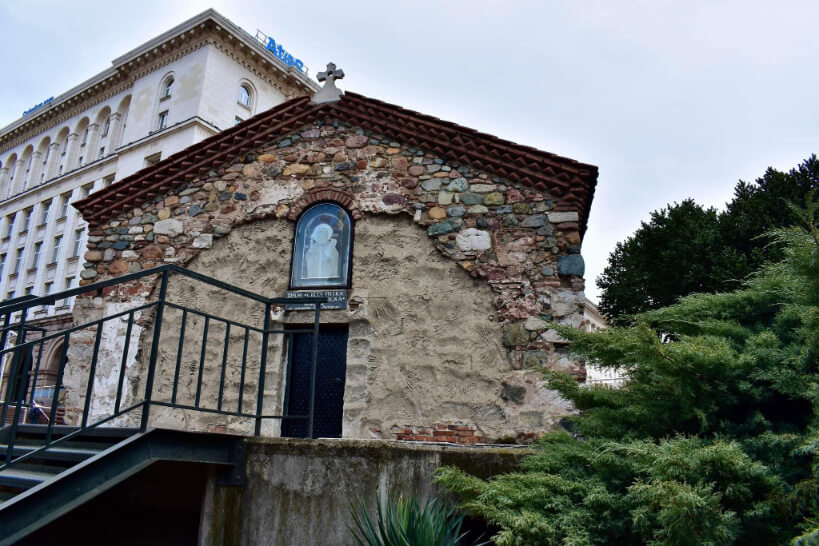
Relatively unknown archaeological sites are scattered everywhere, and you are sure to discover something you have never heard of.
History of Sofia
(Click here to skip History)
I will try to summarize as concisely as possible! As I mentioned earlier, Sofia was inhabited in the neolithic time , so there is a lot of ground to cover.
[The following is my best attempt at piecing together information from Wikipedia , Britannica , and a number of other credible sources that sometimes conflicted with one another. You may find details elsewhere that differ from what is compiled here.]
Thracian Rule
The first known organized settlement, was that of a tribe of Thracians. They lived in Sofia prior to the 5th century BC, at which time they became part of the Thracians’ Odrysian Kingdom.

Macedonian Rule
Philip II of Macedon, the same kind who would give Plovdiv it’s former name “Philipoppolis,” defeated the Thracians and took much of modern day Bulgaria.
He conquered Sofia in 339 BC.
Serdi Occupation
Details are scant about the tribe that gave Sofia it’s earliest recorded name of Serdica. The first mention of the city is from the 1st century BC.
While they are often referred to as Thracians or Romans, they were actually a Celtic tribe.

The Romans took Serdica around 29 BC and ruled for centuries. Most of the amazing antiquities found in Sofia are from this time period.
I cover Serdica and its ruins thoroughly here:
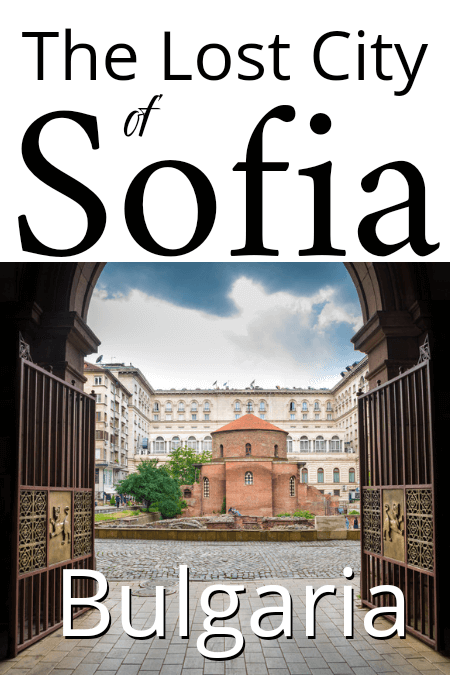
Byzantine Empire
Under the Emperor Constantine, Sofia (Serdica) became part of the Eastern Roman Empire, known by most of us as the Byzantine Empire, sometime after 330 AD.
Huns destroyed the city in 447 AD, but it was rebuilt in the 6th century by the Byzantine Emperor Justinian.
(I was very curious what happened between 447 AD and whenever it was rebuilt in the 500’s, but I couldn’t find any info. The facts may not be recorded, or may only be available to those who can read Bulgarian language history books.)

Contested Rule
In 809 AD Khan Krum of the Bulgars took the city and incorporated it into the Bulgarian Empire. At this time Serdica was renamed “Sredets” (In Greek: Triaditsa) .
After this time control of the city went back and forth a few times:
- 809 AD – 1018 AD Bulgarian Empire
- 1018 AD – 1185 AD Byzantine Empire
- 1185 AD – 1385 AD Second Bugarian Empire
Ottoman Empire
In 1385 , Sredets (formerly Serdica) became part of the Ottoman Empire , and remained under their control for nearly 500 years .
During this time, the city came to be known as “Sofia.” Interestingly, the name was unofficial at this time.
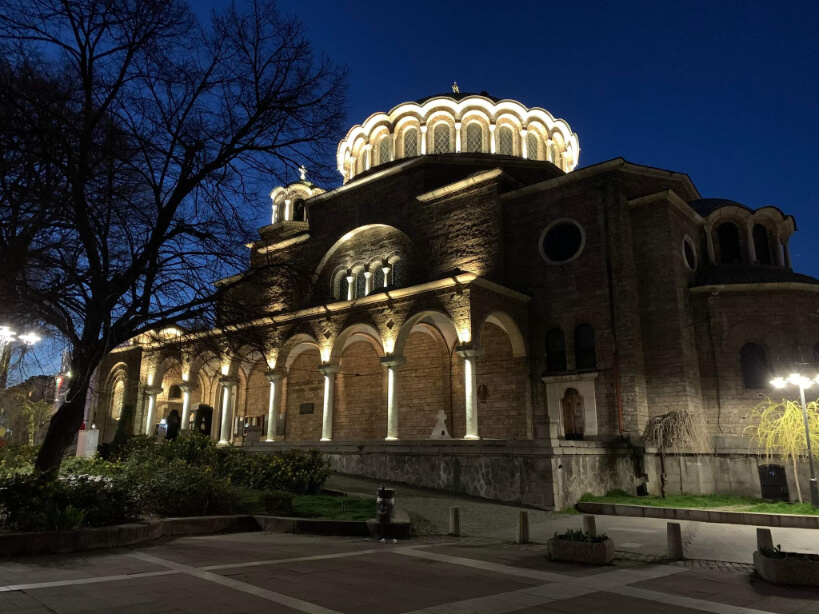
The earliest known reference to this new name was in 1376, but people living in the city were still referred to as “of Sredets” and the region was known as “Sredetska.”
This lasted the entire Ottoman period.
Vasil Levski is Bulgaria’s most famous hero, and he was put to death for fighting Ottoman rule. In a long and sordid tale , his body is thought to have been laid to rest secretly under the Sofia church: St. Petka and the Saddlers.
Russian Liberation
In 1878 Sofia (and all of it’s still Sredetsian people) was taken over during the Russo-Turkish war.
The Ottoman Empire signed a treaty with Russia, but other European superpowers intervened in the agreement, and a new treaty – the Treaty of Berlin – was signed.
This treaty allowed for a pseudo-independent Bulgarian state.

During this tempestuous time period, the debate over the name of the new Bulgarian capital raged on.
In 1879 a committee of celebrities formed to lobby for the historical name of Sredets.
From the Wikipedia article : “Gradually, a compromise arose, officialisation of Sofia for the nationwide institutions, while legitimating the title Sredets for the administrative and church institutions, before the latter was abandoned through the years.”
That doesn’t sound like a compromise so much as a formalization of what people were already doing, but the name Sofia ended up sticking , which is the takeaway.
In 1908 Bulgaria became truly independent , and was renamed the Kingdom of Bulgaria.
Bulgaria at War
Throughout the Balkan Wars (1912 & 1913) and both World Wars, Bulgaria remained independent and control of Sofia never changed.
Soviet Union

Post World War II, Bulgaria was a member of the USSR and remained one until it’s fall in 1989.
Bulgaria was the only southern Slavic country to not join Yugoslavia.
Where is Sofia?
Sofia is in west-central Bulgaria, and is the closest major city to the Serbian border.
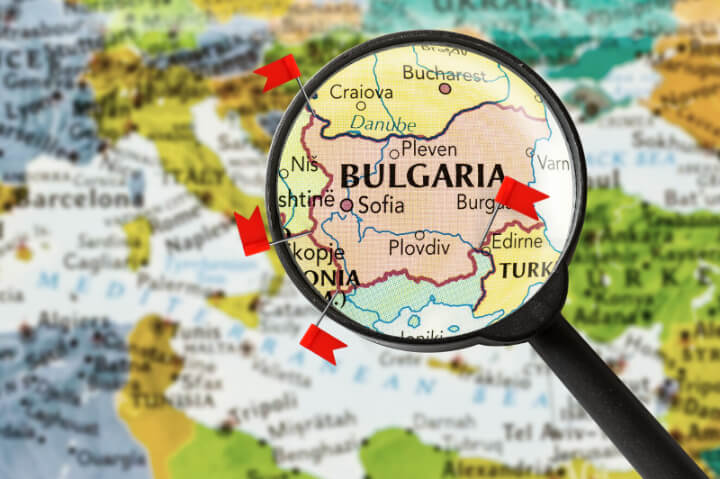
Getting to Sofia
Whether you are traveling from outside the country, or you are already in Bulgaria, there are a couple of ways to navigate to Sofia.
Flying to Sofia
From outside of Bulgaria, your most convenient and affordable option for visiting Sofia, is very likely by air.
Bulgaria Air offers a variety of affordable short-haul flights from other major European cities, as does Ryan Air and a few other low cost carriers.
If you are travelling from North America, schedule the cheapest flight to any large city in Europe, and find your own connecting flight to Sofia.
It will always be more affordable to arrange your own low-cost flight than to book all the way through to Sofia.
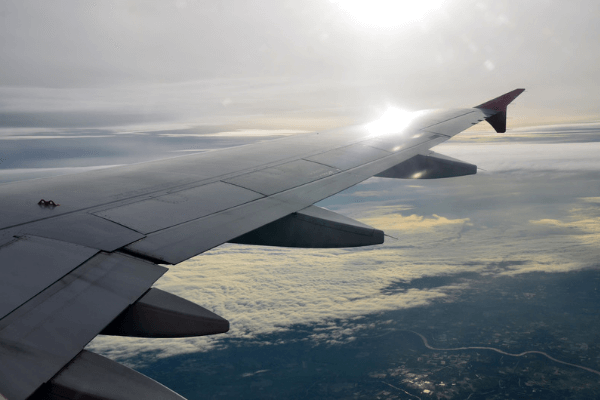
Getting to Sofia by Rail or Bus
Sadly the rail system in Bulgaria is poor compared to other countries, and is not a very efficient way to get to Sofia.
I know for sure that you can take a sleeper train from Istanbul, but beyond that I am not too sure.
There are some efficient bus options from bigger cities.
For bus and train routes, check out Rome2Rio. It’s an amazing resource for getting basically anywhere!
Driving to Sofia
If you fly to another Bulgarian city, either Burgas or Varna, you can drive to Sofia in about 4 – 5.5 hours respectively.
Download a maps.me to have offline GPS for your whole trip, or pay the extra few Lev to get a wifi device with your rental car.

Where to Stay in Sofia
The best neighbourhood in Sofia to stay in, is Vitosha Boulevard.
- Vitosha Boulevard
Vitosha is the main pedestrian area in the heart of Sofia’s city centre. From here you can reach a lot of great places on foot.
Boasting views of Mount Vitosha on one end, and the National Palace of Culture on the other, Vitosha is the best Sofia has to offer in terms of food, shopping, and culture!
Sofia City Centre
While Vitosha is in the city centre, staying inside the larger area of Sofia’s city centre is also a good choice.
Again this will be very pedestrian friendly, and nothing takes long to get to in Sofia.

Sofia Airport
Staying near the Sofia airport isn’t ideal for a few days stay, but for a stopover or for late departing or arriving flights, this might be your best option.
There are a number of hotels with free shuttles close to the airport, and you will also be close to the rental car agencies.
The metro into Sofia leaves right from the airport, so you can go back and forth with relative ease.
The airport is quite far from the city centre, so keep that in mind!
Best Places to Stay in Sofia
We happen to have not only a lot of personal experience staying in Sofia, but we also have connections to hundreds of travellers who have visited Sofia over the years.
Thanks to the Bulgarian adoption community, we have been able to gather a lot of information about people’s favorite hotels and apartments in Sofia.

These opinions are mostly from US families travelling with children.
Here is a list of highly recommended accommodation in Sofia!:
Top Accommodation in Sofia – Our Choice
Marrinella Apartments
Out of all the places we have stayed in Sofia, we liked Marrinella Apartments the best.
We have stayed in three different apartments with Marrinella, and each of them was great!
They have a number of apartments, all surprisingly spacious and close to Vitosha.
Our very favorite was a walk-up on the street ul. Knyaz Boris I – but that is probably because of nostalgia, it’s the first place we brought our daughter to!
Marrinella Apartments range in price from 22 – 84 Euros per night, and can sleep up to 5 people. If you don’t see something that will work for you, contact them!
We have found them to be very accommodating and I don’t think their full inventory is on the website.
Price: $25 – $97 USD per night Ask about weekly rates!
Marrinella Apartments haven’t been reservable on booking.com recently, but you can still book through their website here.
You can see their previous reviews and a number of photos on their booking.com page still.
Best Budget Accommodation in Sofia
Sofia Place
The Sofia Place Hotel is popular with families, as it has the amenities of a hotel, but still offers the space and convenience of apartments.
They get a thumbs up for having modern clean bathrooms, a delicious breakfast, and a great coffee shop next door.
Price: $35+ USD per night
Modest accommodations still close to the Vitosha pedestrian area. Great breakfast, and multiple people commented that they had very helpful staff.
There is also a good restaurant on site.
Price: $47+ USD per night
The Budapest hotel also has a great breakfast, and it is located in a quieter area of Sofia. The rooms are spacious and there is parking available, a rarity in the city center.
Price: $60+ USD per night
Arena Di Serdica
You can’t really beat staying at the site of ancient Roman ruins. Arena Di Serdica Hotel was built right over the remains of an ancient theatre that was discovered as they excavated for the foundations.
A more luxurious hotel in the most convenient area in Sofia.
Price: $141+ USD per night
Where to Stay Near the Airport
Best Western
You really can’t go wrong with Best Western . As far as chain hotels go, they are incomparable when it comes to a predictable experience.
The Best Western near Sofia airport has a free shuttle, beautiful clean rooms, and an amazing breakfast.
Price: $65+ USD per night

Getting Around the City of Sofia
The Sofia metro is very limited in its reach and route options.
It is very affordable however! Last time we were there it was still only 1 Lev for a ticket. (About $0.60 USD)
The metro is the best way to get into the city from the airport, without over paying for a cab.
The airport metro station is to the left as you exit the terminal. It’s so close that it’s basically connected!
After this, the metro is likely of little use to you. If you are staying in the city centre you can get most places on foot. When you can’t walk, a taxi is a better option.
In Bulgaria, taxis are pretty strictly regulated and they need to run the meter or you can report them.
(The number to report is plastered on every single taxi)
Cabs are affordable, and the best way to get around the city when you can’t walk.
(I know, as a slow travel blog, I would like to be more eco-conscious, but when public transport isn’t good, that’s just facts!)

If you are worried about getting ripped off, just ask how much it will be for your ride.
Most of the time the driver will look at you like you’re a maniac and gesture to the meter, which means he will use it!
Taxis are allowed to a charge a more expensive base rate if you have luggage, so bear that in mind if they spike the meter at the beginning of the ride.
If you have a stroller : Fold it before you try to catch a taxi, because they won’t want to pick you up if it looks big. (We discovered this.)
I wouldn’t recommend driving around Sofia.
It isn’t necessary to have a car, and it will be very difficult to get around the narrow streets of the city centre.
Most of Sofia’s streets are also paid parking, and they expect you to have a Bulgarian phone to be able to call in and pay.
If you do want to rent a car for the rest of your trip, there are a number of rental companies in the airport. We prefer Top Rent-a-Car .
If you need to drive your rental car to your accommodation for whatever reason, search for a paid parking lot.
These are not usually expensive and you will be able to pay cash, unlike street parking.

Where to Eat in Sofia
Sofia offers a huge variety of dining experiences for every budget. Here is a selection of the best restaurants in Sofia.
Best Atmosphere
Whether you want a view, or to see nothing at all, these are restaurants in Sofia with unique atmospheres:
Restaurant Serdika
This restaurant has an amazing atmosphere full of plants with floor to ceiling glass looking out on the ruins of Serdica.
Honestly, where else can you look out over Roman ruins as you enjoy your meal? Or maybe a better question: Where else can you comfortably afford to do that?
Restaurant Serdika serves traditional Bulgarian cuisine and features an extensive drink menu. Customer service was rated top notch here, which is somewhat of a rarity in Bulgaria.
Serdika is a little more expensive than the average casual dining experience in Sofia, and a main will cost you about 15 Lev (~ $9 USD).
Also in central Sofia, Tenebris is a once in a lifetime dining experience in total darkness.
Guests purchase a surprise 5 course tasting menu and enjoy their meal using every sense other than sight.
It may sound unusual, but Tenebris is actually the top-rated restaurant in Sofia on Trip Advisor, and receives rave reviews for both the quality of the food and the overall experience.
This atmosphere comes with a steep price tag for Sofia, and will cost you about 85 Lev (~ $50 USD.)
Reservations recommended. Vegetarian options available – Just make sure they know who at your table is vegetarian!

Best Budget
Despite the name implying perhaps an Italian restaurant, Carnivale is actually Greek food, but they do offer burgers and other items too.
Carnivale offers breakfast, lunch, AND dinner, so if you like it you are bound to return!
Customers of Carnivale love both the food and the service. Try their gyros with a local craft beer. Carnivale also offers hookah, so don’t be surprised by that.
Vegetarian options available.
Best Burger
Skaptobara iskra.
Another top-rated restaurant in Sofia on a budget is SKAPTOBARA Iskra . This casual spot offers top-notch burgers, piled high with amazing toppings.
They also offer craft beer to pair with your delicious burger.
SKAPTOBARA makes a bold promise about their offering, saying “nothing lame.” They offer free wifi, and accept cards, so that definitely helps!
A main at SKAPTOBARA will set you back $3 – $10 USD.
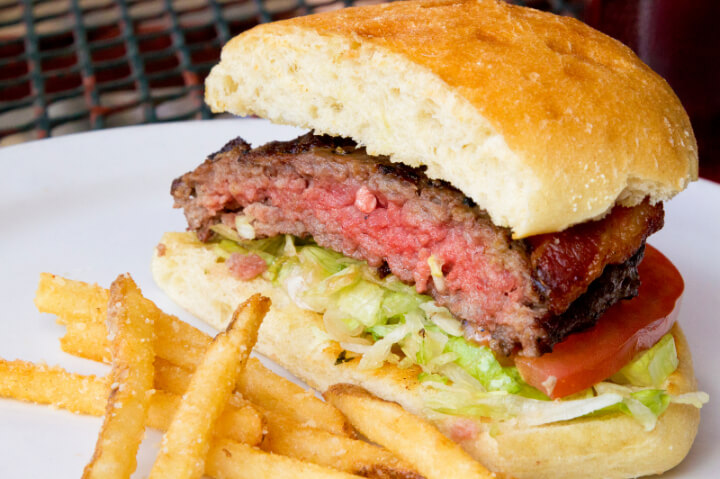
Best Dessert
Cake Lab is located very near Vitosha Boulevard and is the #1 rated “restaurant” in all of Sofia . They offer a wide variety of cakes, cookies, and other sweet treats. They also serve coffee of course!
Cake Lab also won’t break your budget! A treat here will cost only $1 – $4 USD.
Try Cake Lab for a breakfast pastry to start your day off right.
Restaurants on Vitosha
No surprise that the biggest tourist area in Sofia has a huge assortment of restaurants to choose from!
Most have patios that even operate in the winter with blankets and heaters.
Take a walk down Vitosha and try something new. We never had a bad dining experience in Sofia!

Sofia Landmarks
Here are a few of the more popular Sofia landmarks that you can see on your visit:
Alexander Nevsky Cathedral
I promise if you do a Google image search for Sofia, the Alexander Nevsky Cathedral (or just “the Nevsky”) will fill the results pages. It is Sofia’s largest and most recognizable landmark.
A little investigation reveals that the Alexander Nevsky Cathedral is the largest Orthodox church in Southeast Europe.
It is also said to be one of the 50 largest Christian churches in the world, and in the top 10 for largest Eastern Orthodox churches.
Basically, the Nevsky is huge , but not world-record huge.
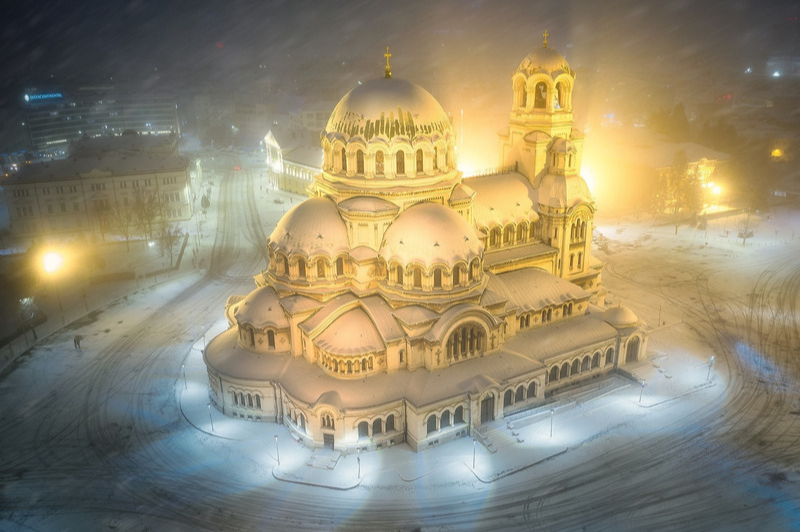
You may notice that only some of Alexander Nevsky Cathedral’s domes are shiny. This is not because they were cleaned recently, but because only 5 domes are actually gold and the rest are copper , which oxidized to the characteristic green colour.
The Alexander Nevsky Cathedral was built between 1882 and 1912.
This is also where you can find Sofia’s famous yellow brick road.
Yellow Brick Road
The yellow brick road in front of the Alexander Nevsky Cathedral, is exactly that: A road of yellow bricks.
I don’t think anyone can say for sure. The story has long been that they were a wedding gift for Tsar Ferdinand from the Austro-Hungarian Empire.
Since then an architect has claimed that the real story is that they were purchased from that Empire at great expense , with the hope that Sofia’s paved road would make the capital city more fashionable.
This last story is very interesting, because the capital of Portugal, Lisbon, very recently painted a street pink to revitalize a seedy area. It worked.
Does coloring a street fix everything? How does the rest of the world not know this?
The yellow brick road is said to be disappearing, as the bricks are no longer produced and the broken ones are being replaced with regular ones.
I don’t see why they couldn’t paint the bricks like Lisbon painted the pink street, since the bricks are already deathly slippery when wet! I guess we will see what the future holds.
In the meantime, the yellow brick road and the Alexander Nevsky are great instagram photo stops in Sofia!
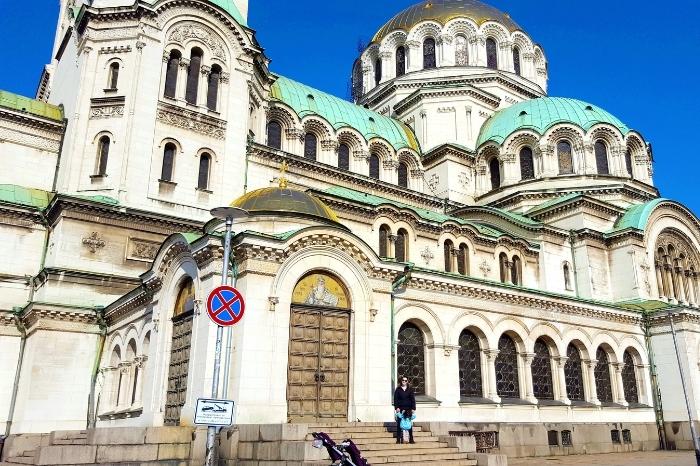
Sofia’s Oldest Landmarks
Some of Sofia’s oldest landmarks have been around since 200 – 300 AD!
These three are definitely worth visiting:
- St. George Rotunda
- St. Sophia Church
- Roman Ruins
I have already covered Sofia’s ancient sites in my post about Serdica (I will link it at the bottom of this article). Check that one out for how much everything costs to visit and where you can find each of them.
Statue of Sveta Sophia
You will probably see the statue of Sveta Sophia (St. Sophia) if you spend any time in Sofia’s city center traveling by car. She stands tall in copper and bronze in the middle of one of the city’s main thoroughfares.

In the year 2000, this statue took the place of one dedicated to Vladimir Lenin, the founding head of Soviet Russia.
Soviet Monuments
National palace of culture.
The National Palace of Culture in Sofia is hard to miss, and a must-see for anyone who is into Brutalist architecture.
The brain child of Lyudmila Zhivkova – both the daughter of one of Bulgaria’s Prime Ministers and a senior member of the Communist Party in her own right – stands tall in a city center park. It is now a convention center.

I have actually never been inside, but the grounds around it are beautiful, and the building is a sight to behold.
Things to do in Sofia
Here are some things to do on your trip to Sofia:
- Free Walking Tour
- Street Art/Graffiti Walk
Paradise Mall
Botanical garden.
You can read all about the free Sofia walking tour , and what to see and do near Vitosha Boulevard here .
Street Art/Graffiti Walking Tour
In addition to the free Sofia walking tour, you can also try the graffiti walking tour .
Like the volunteers that operate the other walking tour, this one is run by English speaking locals who appreciate your donations. Proceeds go back to the local art scene, and the artists who host your tour!

You can do a self guided street art tour, by wandering the avenues between Vitosha and the Alexander Nevsky Cathedral, but the tour promises to sneak you into the places where the artists like to work.
Paradise Mall is very much a large mall like most other large malls in big European cities, but it’s still a fun place to pass some time.
At Christmas the mall is decorated extravagantly for the holiday season, and is sure to delight the kids in your group!
There is a large food court at the top level, where you can enjoy an affordable meal.
The Sofia Botanical Garden is a top-rated and affordable thing to do while in the city!
Stroll through a massive outdoor garden and even an indoor cactus garden. This is a beautiful spot to take photos.
Entrance: Adults – 4 Lev (~$ USD) Students – 2 Lev (~$ USD) Children – 1 Lev (~$ USD) Hours: Tuesday – Saturday: 10 am to 5 pm. (Closed at 4 pm from November to February)

How Long to Spend in Sofia
Sofia is a really affordable and unique place to visit in Eastern Europe. Having said that, a trip through the rest of Bulgaria is well worth your time too!
Is 2 Days Enough for Sofia?
You can see most of what Sofia has to offer in just 3 days. 2 days is not enough to do all of the sightseeing that you may want to do in Sofia.
You can still enjoy 2 days in the city center walking around and seeing what you find, just don’t try to do it all.
If you have 4 days or more, you could also travel out to Rila Monastery.
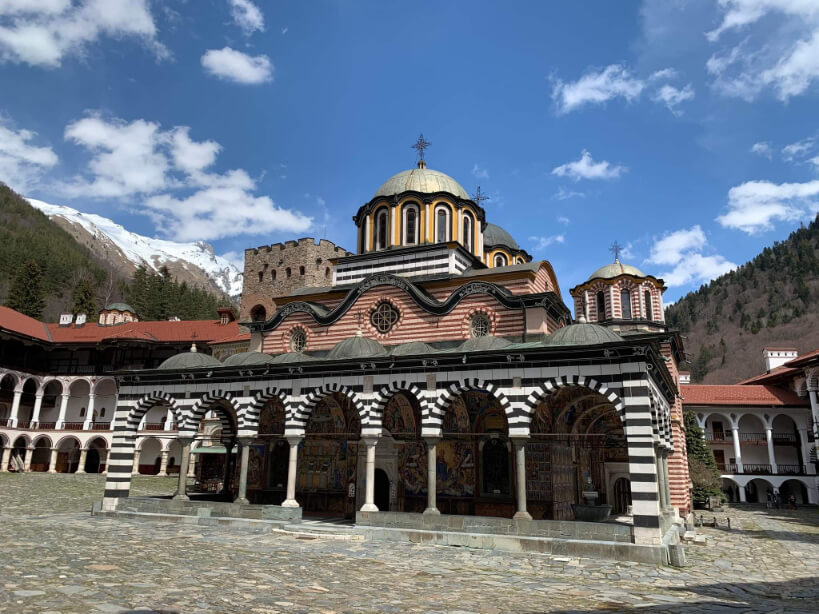
Is 7 Days Too Long in Sofia?
If you have nothing but time, you could easily spend a week or more in Sofia, just experiencing life as a local. Stay near Vitosha and try out a new daily routine.
Is Sofia Worth Visiting for an Extended Period?
It depends on what you are looking for. Sofia is a rising choice for Digital Nomads because it has great wifi, is affordable, and walkable.
If I was to spend a lot of time in Bulgaria, I would personally be more likely to settle near the Black Sea , in Burgas or Varna.
If the mountains are more your thing, Bansko is very popular in the summer with long-term travelers.
Where is Bulgaria on your list for 2022?
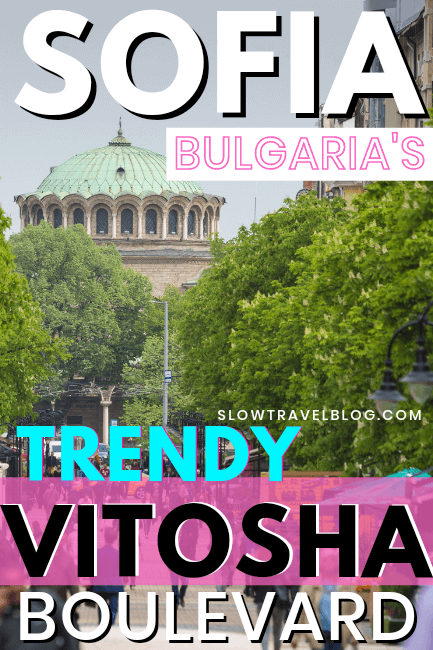

The Perfect Bulgaria Itinerary: 5 to 10 Days (or More!)
Last Updated on February 14, 2024
by Maggie Turansky
Disclaimer: This article contains affiliate links. That means if you click a link and make a purchase, we may make a small commission. As an Amazon Associate we earn from qualifying purchases. For more information, see our privacy policy.
The Balkan country of Bulgaria has long been overlooked on standard European travel routes, where traditional tourists rarely travel farther east than Hungary or Croatia. However, for those more intrepid visitors keen to see the delights that southeastern Europe has to offer, planning a 5 to 10 days in Bulgaria itinerary is a fantastic idea.
Though relatively small in size, Bulgaria has a lot to offer visitors and really can appeal to almost every personality. Bulgaria boasts cosmopolitan cities and ancient metropolises, rugged mountains and pristine beaches, world-class skiing and incredible wine country — it can seem that wherever your interests may lie, Bulgaria will have it.
Table of Contents
When to Visit Bulgaria
You are likely going to want to know when is the best time of year to visit this European nation. Well, luckily for travellers, Bulgaria has its merits no matter what time of year you choose to visit so it all depends on what you’re after on your trip.
While it is located in southeastern Europe, don’t expect Bulgaria to have the same kind of climate as other southern European countries like Croatia , Portugal, Italy or Spain. Contrary to these countries, Bulgaria experiences a much more continental climate with very cold and snowy winters and hot, muggy summers. With this kind of climate, you can best bet to enjoy all of the seasonal activities that come throughout the year.
Winter in Bulgaria sees high temperatures averaging around freezing throughout most of the country, though it can certainly be colder high in the mountains or warmer in the coastal areas along the Black Sea.
With the winter freezes come a lot of skiing opportunities at some of the most affordable prices in all of Europe. Destinations like Bansko are incredibly popular in the wintertime, however, you can also easily combine a skiing holiday with a cosmopolitan city break without leaving Sofia by visiting Vitosha Mountain.
Summers, on the other hand, can get incredibly hot, with average temperatures soaring to well over 30°C (86°F) and humidity can be quite high, as well. The inland cities in the summer can be sweltering, however, the coast becomes a bustling mecca for sun worshippers and party seekers alike.
The mountains can also be a pleasant escape with ample hiking opportunities and mild temperatures in the high altitude. Summer is also, not surprisingly, when tourist crowds are at their peak, as are accommodation prices.
If you’re sensitive to either the cold or heat and want to avoid tourists as much as possible, then probably the best time to visit Bulgaria would be in the shoulder seasons.
The months ranging from March-May and September-October see some of the mildest temperatures, though you should be prepared for the occasional cold snap or frequent rains (especially in Spring). However, in the shoulder seasons, you are just as likely to have beautiful warm temperatures and sunny skies that steadfastly cling to summer.
No matter which time of year you choose to embark on your trip to Bulgaria, you are sure to be met with a beautiful country eager to welcome your exploration!

Getting To & Around Bulgaria
Now that you’ve figured out which season to travel to Bulgaria, we need to discuss how you plan to get around once you’re there.
First things first, it is likely that you will begin your Bulgaria itinerary by flying into Sofia airport, which has frequent connections from budget airlines like Ryanair and Wizzair to a number of cities throughout Europe. The affordability of reaching Bulgaria has made it an attractive option for travellers looking to explore a lesser-visited corner of Europe.
There are other international airports in the country besides Sofia, however, and you can just as easily begin your trip from any of these. The highest-trafficked airports after the capital include Burgas and Varna on the Black Sea and Plovdiv airport, which serves a couple of flights per week from destinations like Tel Aviv, Belfast, Manchester and Dublin.

If you’re visiting Bulgaria as part of a longer Balkans itinerary you will be happy to know that a few of the country’s major cities are fairly well connected with neighbouring countries. Travellers can easily reach Sofia from Thessaloniki in Greece, Belgrade or Nis, Serbia and also from Skopje , North Macedonia and Istanbul , Turkey, the latter of which will transit through Plovdiv.
You can also reach Sofia by overnight bus or train from Bucharest , Romania. It is also possible to find a direct connection to the northern city of Veliko Tarnovo to Bucharest as well.
Once you’ve arrived in Bulgaria, you need to know how you plan to get from point A to point B. Like elsewhere in the Balkans, if you’re relying on public transport for your Bulgaria trip, then your best option is going to be the bus.
While there is a train network in Bulgaria, it largely hasn’t been updated since the 1960s and can be incredibly slow, uncomfortable, and inefficient. The only time I would generally recommend using the train network in Bulgaria is if you have an affinity for communist-era railways.
In contrast, the bus system is quite comfortable and well-developed and they also tend to be much faster than the trains.
If you are only travelling between major cities, you will find that connections between transport hubs tend to be frequent and the system is easy enough to navigate, even if you have a language barrier. It can be helpful to know what the city you’re travelling to looks like spelt in the Cyrillic alphabet so you know which booth to buy your tickets from.
Most smaller city centres are easily navigable by foot, including cities like Plovdiv and Veliko Tarnovo, however, in Sofia, it might be necessary to use the public transportation system. The metro in Sofia is efficient and user-friendly, with everything written in both Bulgarian and English.
If you need to take a taxi in Bulgaria, make sure to practice the general precautions you would with taxis throughout the world as, unfortunately, Bulgaria is not immune to taxi scams. However, there are a number of taxi apps in various cities where you can call a reliable cab.
If you do hail one off the street, make sure to do some research on reliable taxi companies beforehand and ensure that the meter is running. Taxi rides are incredibly affordable in Bulgaria, especially when compared to some Western European countries.

5 to 10-Day Bulgaria Itinerary
Bulgaria has a lot to offer visitors and, therefore, travellers can easily spend a number of weeks or even months within the country and always find something new to explore. However, if you only can spend 5 days in Bulgaria, then the first five days of this itinerary is outlined to be a complete trip.
If you have a week, the same concept applies if you have 7 days in Bulgaria. And if you’re fortunate enough to have 10 full days to spend in this Balkan nation, then you can enjoy the entirety of the outlined route.
Days 1-3: Sofia
It is likely that you will begin your Bulgaria itinerary in the capital city of Sofia. Though Sofia may not have to best reputation among Balkan cities (when we first planned to visit, we were told to skip it by numerous people), we’ve found that it has a lot to offer visitors with great energy and many interesting things to do.
Though you could easily spend a week or more exploring Sofia , we recommend spending 3 of those days in the capital. Start off with a free walking tour of the city to get your bearings, a great way to get some context to the incredible history you’re going to see in the Bulgarian capital.
There are a number of things to occupy yourself during these three days in Sofia including visiting the top monuments like the ancient city of Serdika and the Alexander Nevsky Cathedral.
You can also take the time to visit some of Sofia’s many museums, enjoy its thriving culinary scene, and learn more about its communist history.
Though it may not be the most beautiful of cities, there is a very cool edge that Sofia holds and it can be worth also learning about its burgeoning street art scene.
If you only have three days, we do recommend that you spend all of them in Sofia as it will allow you to really get to know the city. However, if you want to see more of the countryside, it is possible to go on a day trip.
Rila Monastery – a UNESCO World Heritage Site – is one of the most popular day trips from Sofia, as is the nearby Vitosha Mountain, which you can reach by Sofia’s own public transport.
Where to Stay in Sofia
Art ‘Otel – This hotel is a great option if you’re after some luxury. They are well located within easy reach of all the major city sights and have a range of clean and comfortable rooms available. They also have a great breakfast included in the room rate.
Hostel Mostel – This hostel is your best bet if you’re travelling solo or on a tight budget. As one of the most popular and well-rated hostels in Sofia, they have a range of dorm and private rooms available, a friendly staff, and great common areas for you to meet other travellers.
Not quite what you’re looking for? Click here to browse more Sofia hotels!

Days 4-5: Plovdiv
After exploring Sofia, the final step on a 5-day Bulgaria itinerary should be the second-largest city of Plovdiv. As one of the European Capitals of Culture in 2019, Plovdiv is probably the most tourist-friendly city in Bulgaria and it has a lot to offer visitors.
Plovdiv is thought to be the oldest continuously inhabited city in Europe, with a history dating back over 6,000 years. Though Plovdiv is most famous for its incredible ancient amphitheatre. there is a lot more that the city has to offer, which is why we recommend spending two days in Plovdiv to really get to know the city.
Spend your first day in the city exploring its ancient monuments and Roman ruins like the aforementioned amphitheatre and the ancient stadium. Wander through the picturesque old town and enjoy the view of the city from the ruined fortress on Nebet Tepe.

You can also head into the trendy neighbourhood known as Kapana, which means “The Trap” in Bulgarian.
These windy, pedestrian streets have recently been refurbished by a lot of government investment and are now full of great restaurants, cafes, bars, and independent shops and have become a haven for local artists. If you’re interested in hipster culture or street art, this is the neighbourhood to visit.
You can also use Plovdiv as a base to go wine tasting in the Thracian Valley. The nearby town of Brestovitsa is home to several wineries and is only 20 kilometres from the centre of Plovdiv.
Though Bulgaria may not be the first country that comes to mind when it comes to wine tourism, it has one of the oldest viticultures in the world and produces some truly fine vintages.
Where to Stay in Plovdiv
Hotel Evmolpia – Situated in the Old Town, this charming boutique hotel is within easy walking distance of everything to see and do in Plovdiv, including the amphitheatre, Kapana district, and main pedestrian street. They have a number of clean and comfortable rooms available and a good breakfast.
Hostel Old Plovdiv – Located in the heart of the Old Town, this hostel is located in a traditional revival house and is one of the best places to stay in Plovdiv. They have a very welcoming a helpful staff, a range of comfortable dorm and private rooms available, and a great breakfast included in the room rate.
Not quite what you’re looking for? Click here to browse more Plovdiv hotels!

Days 6-7: Black Sea Coast
After spending the first five days in Sofia and Plovdiv, it’s time to head to the coast and enjoy the gorgeous Black Sea.
There are a number of great places to visit on the long coastline of Bulgaria and it really depends on what kind of experience you’re after. If you want a smaller, more sleepy seaside town, then head to lovely Sozopol. This town boasts a couple of fine sand beaches, beautiful cobbled streets, and a laid-back atmosphere.
If you want some more western amenities, a party scene, or a high-end beach resort, the head to Sunny Beach or Nessebar which are significantly more touristy and developed than Sozopol.
If you want a big city vibe but still some great beach time, then head to Varna or Burgas, the biggest cities on Bulgaria’s coast. No matter where you choose, you are sure to enjoy a couple of days enjoying the charms of the Black Sea.
Where to Stay on the Black Sea
Hotel Diamanti – If you’re looking for a more subdued seaside holiday on the Black Sea, then the perfect place to stay in Sozopol would be this hotel. They have a number of affordable rooms available, some with sea views, a restaurant on site, and a great breakfast included in the nightly rate. They are also located within walking distance of everything in Sozopol.
Nomado Hostel – As one of Varna’s highest-rated hostels, this is a great place to visit if you’re looking to see the Black Sea on a backpacker’s budget or as a solo traveller. They are centrally located, have a friendly and helpful staff, an included breakfast, and both dorm and private rooms available.
Not quite what you’re looking for? Click here to browse more Black Sea hotels!

Days 8-10: Veliko Tarnovo
If you’re fortunate enough to have 10 days to spend exploring Bulgaria, then heading to Veliko Tarnovo for the last two days is an excellent ending point.
Veliko Tarnovo, located to the north of Bulgaria, is a lively university town that once acted as the capital of Bulgaria. Today, it is famous for its mountain scenery and impressive fortress that commands spectacular views over the city and mountains surrounding.
Veliko Tarnovo is incredibly picturesque and well worth taking a day or two to explore on foot. It is also located very close to a number of great mountains, so it is possible to use the city as a base to go for a great day hike. As the former capital of Bulgaria and another ancient city, there is also a long and fascinating history here that is worth learning about.
As the home of one of Bulgaria’s best universities, there is also a lively, youthful energy which makes for a lot of good eateries, bars, and cafes along with some trendy shops and things to do.
Where To Stay in Veliko Tarnovo
Augusta Spa Hotel – This boutique hotel is centrally located and is a great option if you have a bit of a higher budget when visiting Veliko Tarnovo. They have a range of clean, comfortable, and air-conditioned rooms available, some commanding great views of the medieval fortress, and a great breakfast included in the nightly rate.
Hostel Mostel – This hostel, owned by the same people who run the branch in Sofia, is an excellent option for budget and solo travellers. They have both dorm and private rooms available, breakfast and dinner included, and great common areas to meet other travellers.
Not quite what you’re looking for? Click here to browse more Veliko Tarnovo hotels

Have More Time?
If you have more than ten days to spend in Bulgaria, or fancy getting a bit further off the beaten path, there are a few options you could take.
First, if you like nature, small towns, and wine, then heading to the lovely town of Melnik is a fantastic option. This tiny town is relatively easy to reach by public transport from Sofia and is an excellent stopping off point if you’re heading south to Greece after travelling in Bulgaria.
If you want to experience some of the best and most affordable skiing in Europe in the winter or visit a pristine hiking mecca in the summer, then the town of Bansko is also a great option to add to you Bulgaria itinerary.
Finally, the northwestern town of Belogradchik close to the Serbian border is a great offbeat destination in Bulgaria. Famous for its unique rock formations and imposing fortress, spending a day or two here will show you a different side to the country.
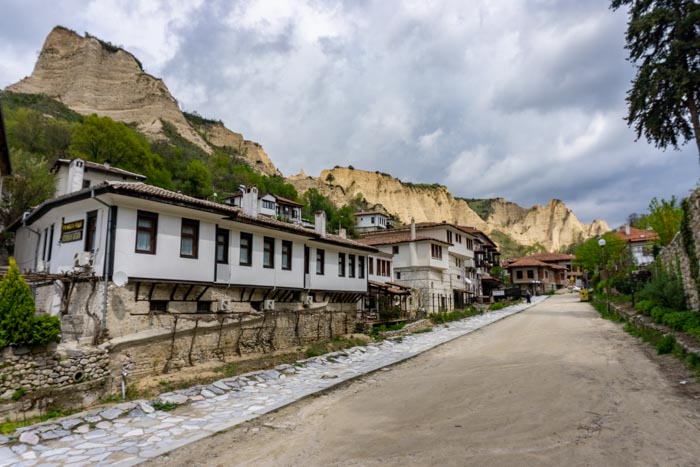
No matter how many days you have to devote to a Bulgaria travel itinerary, there is no denying that there are countless things to see and do in this underrated European nation.
Are you planning to visit Bulgaria? Have any questions? Let us know in the comments!

Related Posts:

The Perfect 1, 2, or 3 Days in Sofia Itinerary

Is Bulgaria Expensive? A Guide to Prices in Bulgaria

What To Do in Plovdiv: A 1 or 2 Day Itinerary

About Maggie Turansky
Maggie is a co-founder and writer for The World Was Here First. Originally from the US, she has lived in five different countries and has travelled to dozens more, both solo and with her partner, Michael. She particularly loves exploring Spain and spending time in the Caucasus and the Baltics. Read more about Maggie
great itinerary, lots of useful tips too. many thanks. marilyn
Thanks, Marilyn! Hope you have a great trip.
Hi. This looks like a very useful itinerary. Plan to visit next early June after an extended Turkey, Azerbaijan, Armenia trip. Was planning 5 days but I think 10+ will afford a much better flavor of Bulgaria. Thanks!
Hello, What is the best way to travel from Plovdiv to Varna? Bus? Return to Sofia and take a flight to Varna?
Best regards, Oliveira
You can take a bus directly from Plovdiv to Varna 🙂
How affordable and practical would it be to rent a car for places outside Sofia? Or is bus a better option than driving?
Renting a car can be a great option if you want a lot of flexibility and not to be beholden to bus timetables. Prices can vary depending on a number of factors.
How would you recommend getting to Plovdiv from Sofia? Could we take the local bus?
Yes, the bus is the best way if you’re using public transport 🙂
If I want to do a Bulgaria Greece trip. Start in Sofia then to Plovdiv. Can I fly into Greece next from Plovdiv? Or do I need to go back to Sofia to catch a flight?
Hi Dee Dee, Plovdiv airport is quite limited in its routes so I think your best bet would be to go to Sofia if you want to fly to Greece. Alternatively, I would recommend looking at taking the bus and going overland!
Another interesting old town is Koprivshtiza, on the road from Sofia to Black Sea, in high mountains and very picturesque. Also, there are many caves, waterfalls, natural wonders, and spa options to choose from.
Thanks for the tip, Lil!
Thanks a lot for this wonderful guide. I find it quite helpful.
Thanks, Gali! Hope you’re able to plan a great trip 🙂
Leave a Comment Cancel reply
- Visas and Border Control
- Emergency numbers
- Banks and currency information
- Petrol stations
- Tour operators, tourist agencies, associations
- Communications
- About Bulgaria
- Public transport
- To and from Sofia
- Air transport
- Railway transport
- Bus transport
- Family hotels
- Guest apartments
- Guest Rooms
- Guest Houses
- Restaurants
- Coffee-shops
- Art and Culture
- Galleries and exhibition halls
- Concert halls
- Architecture
- Monasteries – Sofia Mount Athos
- Leisure and Sports
- Vitosha mountain, parks and gardens
- For family and children
- Street fitness
- Water sports
- Winter sports
- Extreme sports
- Horse riding
- Stadiums and Sports halls
- SPA & wellness
- Night life and others
- Bars and music clubs
- Dance clubs & Discos
- Sofia Routes
- Pilgrimage Routes
- Let's have a walk in Sofia
- Wine map of Sofia
- Meet the birds of Sofia
- Do not miss
- National and Official Holidays
- Religious Holidays
- Music and Dance Events
- Sports Events
- Business Events
- Exhibitions
- TIC - SOFIA
- TIC - LARGO
- TIC - CHITALNYATA
- TIC - BANKYA
- Sofia Tourism Administration
Welcome to Sofia the capital of Bulgaria
Events calendar, the wine map of sofia, sofia around me.
- 28 Apr | PalmSunday Religious Holidays
- 27 Apr | Lazarus Saturday (Lazarovden) Religious Holidays
- 25 Apr | MAKEDONISSIMO Music and Dance Events
- 2 May | BERND GLEMSER & MARTIN PANTELEEV Music and Dance Events
- 22 Apr | SONG OF THE NATURE Music and Dance Events
- 24 Apr | CONCERT OF SOFIA QUARTET Music and Dance Events
- 28 Apr | INSPIRED VIOLINS AND FRIENDS Music and Dance Events
- 29 Apr | CONCERT NUTI OF THE NATIONAL SCHOOL OF DANCE ART Music and Dance Events
- All events for the day
Find out...
Accommodation. wine & dine. sights. entertainment., where to stay.
The four-star hotel VILLA BOYANA is situated in the ideal center of the elegant Sofia district of Boyana, only 300 m from the Boyana Church, famous for its unique frescoes.
Where to eat?
What to do.
Sofia University St. Kliment Ohridski also has its own climbing wall - in the heart of Sofia! It is located in one of the domes of the main building. It has different difficulty routes, routes on the ceiling, as well as boulders. It is mainly used by students, but it is also available for all enthusiasts in the hours between 7:30 - 10:00 and after 17:00.

11 Magical Things to Do in Sofia in Winter
Bulgaria , What to Do

I love Sofia in winter – the city just comes to life under a pile of snow. I love the look of the yellow vintage trams on snowy streets, the churches covered in snow, the cap of snow on Vitosha in the distance.
Here are 11 wonderful things to do in Sofia in winter, from cozy bars to Christmas markets to excellent museums. We’ve also included recommendations for where to stay in Sofia at the bottom of the post!
Visit the charming Christmas market

Not one to be left out of the Christmas market frenzy, Sofia has a beautiful Christmas market all of its own. Located in Borisova Gradina, the Christmas market is small but charming. You’ll find everything you can find at a German Christmas market, including glühwein (hot mulled wine) and bratwursts.
In 2018, the Christmas market opens on the 23rd of November, plenty of time to enjoy it before Christmas.
Read Next: How to Visit the Sofia Christmas Market for a German Christmas in Bulgaria
Marvel at the snow-covered architecture

Sofia is one of those cities that simply looks better underneath a blanket of fluffy white snow. There’s something about the way the onion domes of the Russian Church look against a stunning white backdrop or the way the brick red of Ivan Vazov looks even redder against the snow.
I mean, how beautiful is that church? I hate the cold (I’m a Californian after all) but I find myself longing for the snowy days to come, just to see Sofia under a blanket of snow again.
Ski and snowboard in Sofia in winter

How many cities can say that they have their own mountain in the city limits? And not just any mountain, either – Sofia’s Mount Vitosha is 2,290 meters high, yet because it’s so close to the center, you can drive from the city center to nearly 2,000 meters above sea level in about 30 or 40 minutes.
In fact, you can actually ski and snowboard on Vitosha. If you don’t travel with your own snow sports equipment, you can rent them at Aleko Hut for a reasonable day rate.
If you’re a huge snow sports person, you’d probably be better off at Borovets, Pamporovo, or Bansko, which are bigger snow centers. But still, the ability to ski in Sofia in winter without even leaving the city is pretty magical. I can’t think of any other city that boasts that.
Watch the sunrise over the snowy mountains

Vitosha is one of the most beautiful places to watch the sunset in Sofia. If you have rented a car during your stay in Sofia, I challenge you to wake up early one of the days to enjoy the beautiful sunset over the mountains. If not, taking a taxi to Vitosha will cost about 80-100 leva round trip plus wait time, roughly – not a bad expense if you get a few friends to share the expense.
If you’re lucky, Balcanic may be doing a free sunrise tour during your visit, which does a sunrise tour hike on most Thursdays. I did a hike with them at the beginning of April when there is still a lot of snow on the mountain, but I’m not sure if they will be running sunrise tours all winter long. The tour isn’t entirely free as you have to contribute to the cost of joint taxis but it was quite affordable – I contributed about 15 leva to the taxi pool.
Duck into a museum when it’s cold

If it’s a cold Sofia winter day, one of the best ways to get out of the elements is to duck into one of Sofia’s many excellent museums.
Kvadrant 500, an art museum located just a stone’s throw from Alexander Nevsky Cathedral, is home to the best art collection in the city, including both Bulgarian and foreign artists. The Regional Museum inside the former Central Mineral Baths are also a great choice.
One of our favorite museums is the Museum of Socialist Art, located a bit outside the city center in the neighborhood of Iztok. This museum is mostly indoors and has a collection of paintings and videos of Socialist propaganda. But one of the most interesting things in the Museum of Socialist Art is the Communist “statue graveyard” in the courtyard of the museum. Here, you can see the statue of Vladimir Lenin that used to be located where the Saint Sofia Statue is. You can also see the red star that used to top the party headquarters, which has since been taken down and relocated here.
Check out an opera or ballet

One of the best ways I can think to spend a winter night in Sofia is to take in a show. There are several excellent theater and music venues in Sofia; however, a lot of the performances are not very accessible to tourists as they are in Bulgarian and no subtitles are provided.
For that reason, I recommend going to something such as an opera or ballet, where the words do not matter quite as much. Here’s our guide for how to get tickets and go to the Sofia Opera and Ballet.
Eat some hearty Bulgarian food

Bulgarian food is great for winter weather! While some of the food is better enjoyed in summer (nothing is tastier than fresh summer tomatoes in a shopska salad), there are several Bulgarian dishes that are absolutely fantastic in the winter.
My favorite cold weather food is sach, a massive plate for two or more with sizzling vegetables and meat that is sometimes served on fire for dramatic effect. It’s classic cold weather food!
A few other dishes I recommend for the winter are delicious soups. Bob chorba – bean soup – is a favorite, and more adventurous eaters will definitely want to try shkembe chorba, a slightly spicy tripe soup that is supposed to cure hangovers. I can’t stomach (pardon the pun) tripe, so I’ve never tried it, but some people love it. And of course, it’s the Balkans – grilled meat is always a good choice in the winter.
Check out the great coffee scene

Sofia has a lot of excellent coffee shops where you can duck into for a quick break from the cold weather. One of my favorites is Drekka because, I mean, look at that interior! They serve amazing coffees (I particularly love the flat white) and the people who work there are sweet.
I also like DABOV Specialty Coffee near NDK and Chucky’s Coffee just off Vitosha Boulevard, but there are several other great coffee places in Sofia – just check out my friend Megan’s Sofia coffee guide .
Stroll down Vitosha Boulevard

Vitosha Boulevard is one of the main pedestrian thoroughfares in Sofia and it’s a must-visit on a cold night because the bars and restaurants lining the streets have great atmosphere year-round.One thing I especially love is that almost all the bars, cafes, and restaurants on Vitosha Boulevard have enclosed terraces so you can get the “outside” feel without, y’know, actually freezing.
However, be aware that these terraces also allow smoking so if you are smoke-sensitive you may prefer to sit indoors where smoking is not permitted.
Enjoy a glass of Bulgarian red wine

Bet you didn’t know that Bulgaria makes some excellent red wines! While I am partial to rosé all day in the summer, there’s no denying that a wonderful glass of red wine in the winter hits the spot like no other.
A lot of restaurants have great wine lists, such as Bagri and 33 Gastronauts, but if you want a wine bar then check out Grape Central just off Vitosha Boulevard. Try wines from Melnik, my favorite wine region in Bulgaria!
Drink in a warm, cozy indoor rooftop bar

Why don’t more cities have indoor rooftop bars? Sofia has some seriously cold weather in winter and some rainy weather in summer so it’s a fantastic idea to have all the beauty of a rooftop bar without the unpredictability and occasional unpleasantness of dealing with the elements.
Enter Sense Rooftop Bar, my favorite bar in Sofia. This sleek, elegant rooftop bar on the 9th floor with sweeping views of Alexander Nevsky Cathedral, yet it’s entirely indoors so you can stay warm while you drink. Drinks are pricy by Sofia standards – a cocktail is about 15 leva, or 7.5 euros – but it’s well worth it for the views!
Where to Stay in Sofia
While accommodations in Sofia are affordable year round, prices dip quite a bit in the winter and you can get fantastic deals on hotels. We’ve broken down where to stay in Sofia according to a few different budget ranges. Here is a general range of what we mean by each budget category:
- Budget: A room in a hostel, usually $5-12 USD per night for a dorm bed or under $40 for a double.
- Mid-range: Around $40-80
- Luxury : Around $100 per night or more
Budget: For a hostel, we always recommend Hostel Mostel . I have never stayed at the Sofia location but several of my friends have and have always spoken highly of it. I stayed at the one in Veliko Tarnovo and it was excellent. Perks include a free vegetarian dinner in addition to breakfast included in your stay! Check rates and availability here .
Mid-range: For a trendy boutique hotel that is surprisingly affordable, we recommend R34 Boutique Hotel. The location is dead center, near the Ivan Vazov National Theater in the middle of Sofia. It has gorgeous, loft-inspired details like exposed brick, giant windows, and streamlined but modern décor. It’s a great bargain, too – check rates, reviews, photos, and availability here .
Luxury : As far as we see it, there’s only one option for the best hotel in town: Sense Hotel. We go to their upscale, beautiful rooftop bar all the time when we have guests in town. With beautiful views over Alexander Nevsky, Sofia’s most iconic landmark, the hotel couldn’t be in a better location. Sense Hotel also boasts a state-of-the-art fitness center, an art gallery in the lobby, an excellent spa with luxe treatments, and an indoor pool. It’s truly the best choice in town. Check rates, reviews, photos, and availability here.
Planning a Trip to Sofia? Don’t Forget Travel Insurance!
Make sure you always travel to Sofia with a valid travel insurance policy. While the country is safe, accidents can happen anywhere. If you experience an accident or theft, travel insurance will help you recover your costs and enjoy the rest of your trip. This is especially important in winter, since winter activities carry a certain amount of risk with them.
For travel insurance, I use World Nomads . I’ve been a happy customer of theirs for almost three years, and I’ve never had an issue when making a claim. I’m happy to refer them to anyone I meet.
Get a travel insurance quote for your trip here.

Originally from California, Allison has been living in Bulgaria for the last two years and is obsessed with traveling around the Balkans. She has been published in National Geographic, CNN Arabic, Matador Network, and the Huffington Post. She loves befriending dogs, drinking coffee, geeking out about wine, and cooking food from around the world.
Related posts
20 comments.
I found it insightful and very interesting. I have one question please: My husband and I want to visit Bulgaria in February. We only want to stay in Sofia and are thinking about staying for five nights. Is it too long? Please advise.
No five days is great! You can book a day trip to Rila Monastery or Buzludzha if you want to go on a day trip from the city for a day. My first trip to Sofia was a month long and I didn’t get bored, so you can definitely fill up five nights!
We will be working on itineraries in the next few months, so check back this summer for more resources!
Will we see snow in February in Sofia. We live in South Africa and hardly ever see snow. I would love it if we can see snow, or even if it snows.
There is *usually* snow in February, but you can’t always control it. However, if you want to see snow and there’s none in Sofia, you can go up Mount Vitosha where you will definitely find some!
Can you plan a trip for two in the countries of Balkan. I would like to experience snowfall. What will be the cost in total. I am from Malaysia. Appreciate your guide please on flight travels from my country.
Hi Angie! Thanks for your comment. At the moment we don’t offer itinerary planning, but we plan to offer this as a paid service in the near future. For now, you can check our Balkan itinerary post which may help: https://sofiaadventures.com/balkans-itinerary/
Hi Allison, I’m planning to go to Bansko for ski-ing in feb with my 4 year old daughter, flying from Amsterdam to Sofia. Would a couple of days in Sofia make sense for the 2 of us?
Allison’s on her honeymoon so I’ll answer – yes we love Sofia! If you have the extra time, we would suggest two or three days for sure! You can use this 2 day itinerary and things to do in Sofia in winter as an idea of what to do here after (or before) your ski trip.
Hi, I am planning to visit Sofia around 1st week of Dec but i’ve heard its too cold and bit boring as nothing much happening . is that true ? what can i do or visit in sofia in4 or 5 days ? thanks lot
I love Sofia that time of year. You can visit the Sofia Christmas Market, take a day trip to Rila Monastery, a day trip to Buzludzha, and spend two days exploring the city.
Hi Sofia, thank you for the ideas you gave me. I am planning a trip for me and my wife in Sofia in January. We want to try skiing, never have done it before. Probably only a day trip or two days with an overnight. It looks like Borovets and Bansko are the best options. Which one would you recommend? I only found an organized day tour to Borovets https://www.balkanity.com/borovets-ski-snowboard-day-trip Do you think we should book it or you have any other suggestions. We are total beginners and we will need lessons. Thank you very much!
I do like that company a lot, but I haven’t gone skiing with them. Maybe send them a message on their Facebook page and ask if that tour is appropriate for beginners?
You’re welcome!
Hi! I am considering a trip to Bulgaria/Romania/Moldova during the first half of this coming January. I am prepared for snow and cold, but would there be any danger of flight/train/bus cancellations or travel difficulties during this time? I would have a strict deadline to arrive in Italy. Also have you been to Romania/Moldova? Thank you!!
Hi Laura! There is a possibility of flight or transit delays if there’s particularly bad weather like anywhere else in the world that has harsh winters. I suggest giving yourself a 2-day buffer between travel in winter if you’re concerned and have somewhere to be on a particular day! We have a ton of content on Romania, which you can find here: https://sofiaadventures.com/romania and Stephanie has a ton of content on Moldova on her site which you can find here: https://historyfangirl.com/tag/moldova/ – I’ve also been to Moldova but never ended up writing about it!
Hi there, love the information you’ve shared – we’re heading to Bulgaria for a 5 day break early February – we were thinking of skiing but have decided not to, as we don’t feel like it’s enough time to ski and see a bit of Bulgaria. Though we’d love to do tobogganing or similar. There are 2 teenagers in our party. Can you suggest a rough itinerary that allows to capture the culture and beauty of Bulgaria in the winter. I’m also keen on exploring the food scene as well. Thanks, Gill
We’d suggest 3 days in Sofia with a day trip to Rila Monastery and Boyana Church and 2 days in Plovdiv. I don’t know of anywhere that offers tobaggoning, but you could take a taxi or bus up to Vitosha mountain in Sofia and play around in the snow for a bit. We have an article on the best restaurants in Sofia that you should check out; for Plovdiv, we always suggest Pavaj.
Hope that helps!
Hi there, what is Sofia/ Bulgaria like for a solo female traveller? I’m planning to visit for about 5 days and was wanted to visit Veliko Tarnovo and Belogradchik Castle among other things. I visited Sofia and the Rila Monastery last year with a friend but plan to return alone this time in winter. Does it make more sense to book a guided day tour of these places or could I book my own train tickets and plan these day trips on my own? Thanks in advance!
Sofia solo is very easy! I did my first month here as a solo female traveler, and I had no issues. Just use normal city safety tips.
Veliko Tarnovo as a day trip from Sofia is pretty easy, but when I travel alone I usually do guided tours so that I also get to learn about the places I’m visiting. Here’s our bus guide, but it also has info on the guided tour options: 3 Easy Ways to Get From Sofia to Veliko Tarnovo
For Belogradchik, I would either rent a car or go on a guided tour. Here’s our guide to this site: Belogradchik Fortress & Rocks: Bulgaria’s Hidden Gem in the North
Submit a Comment Cancel reply
Your email address will not be published. Required fields are marked *

New on Sofia Adventures:
- How to Spend a Magical One Day in Istanbul: Mini Itinerary
- 30 Insanely Delicious Greek Street Foods You Need to Try
- 13 Things That EXIT Music Festival Visitors Should Know
- Travel tips
Sofia Solo Travel: 20 Best Things to Do in Sofia Bulgaria
If you are wondering what to do in Sofia, Bulgaria, I have great news for you. It is a fantastic destination for independent travellers as there are many things to do in Sofia and is a safe city for solo female travellers.
The capital city of Bulgaria is known for its ancient Roman ruins, mineral springs and the biggest Orthodox Church in the Balkans. The city has over 7,000 years of history. It goes back to the Roman Empire when the city was called Serdica. Moreover, Bulgaria was once a socialist republic from 1944 to 1989.
With a long and interesting history, there are so many things to see in Sofia, especially if you are a first-time visitor. In this post, I’ll show you exactly how you can travel to Sofia alone and explore some of the best things to do in Sofia Bulgaria as a solo traveller.
Disclosure: This post may contain affiliate links. If you buy something through them, I will receive a small commission at no additional cost. Thank you for supporting this website. For more information, please read the disclosure for more info.
Table of Contents
What you need to know before travelling solo to Sofia Bulgaria
Before you start your solo trip to Sofia, take a look at some of these useful travel tips first:
- Sofia is a safe city for solo female travellers.
- 1 euro = 1.96 lev (fixed rate) . In 2024, Bulgaria will change to the euro, which means 2023 will be the final year for the Bulgarian lev.
- There is one ATM at the arrival terminal and another next to the metro ticket machine inside Sofia Airport Metro Station .
- Currency exchange is available at Sofia Airport . It is next to the Relay convenience store.
- The Bulgarian Cyrillic alphabet is used to write the Bulgarian language. But most touristy places have English signs and menus.
- Unique Bulgarian gestures : shaking your head means yes and nodding means no.
- The best prepaid SIM card is A1 . A 15GB SIM card for 30 days costs 15 lev. It is available at the Relay convenience store at Sofia airport or any A1 retail store in the city.

Is Sofia Safe for Solo Female Travellers
If you are travelling to Bulgaria for the first time, you must wonder if Sofia is safe to travel alone. And generally speaking, Sofia is safe for female solo travellers . Violent crime rate is low. Pickpocketing could be a concern around busy and major touristy area but generally, not a huge issue.
I spent almost two months in Sofia and stayed at multiple places in different parts of the city. I felt safe throughout the day and at night (although I don’t go out very late at night but would walk around in the evenings).
Tips for staying safe in Sofia
Even though Sofia is a pretty safe city, I still recommend practicing regular travel safety precautions. Here are some safety travel tips to keep in mind:
- Be aware of your belongings (bags, mobile phone, etc), especially in a crowded area.
- Avoid taxi scams (especially at night) by taking authorized taxi’s only, walk or take the metro.
- Don’t wear flashy jewellery (necklaces, bracelets, earrings, etc) to attract unwanted attention.
- Leave your passport, (large sums of) money and other valuables at your hotel.
- Avoid poorly lit alleys at night when you are walking home at night.
How to Get to Sofia, Bulgaria
Solo visitors flying into Sofia will arrive at Sofia Airport (SOF) , 10km east of the city centre.
The cheapest and fastest way to travel from Sofia Airport to the city is by taking the Sofia Metro . Follow the signs for Sofia Airport Metro Station at the terminal. Purchase a single journey ticket (1.6 lev) from the machine and take the metro line M4 (yellow line) to the city centre. The journey takes about 40 minutes .

How to Get Around Sofia on your own
The best way to see Sofia is by walking. You can get to most attractions on foot.
However, the most efficient way to see tourist spots outside the city centre is by metro, bus or tram . As mentioned already, a single journey ticket costs 1.6 lev . You can use this for either metro or bus. Keep the ticket until the end of the trip, just in case someone checks it.
Alternatively, get a day pass for 4 lev for all public transportation . When you use the metro, scan the barcode (and activate) the pass at the metro cash desk. As for the bus, you don’t need to perforate the ticket. A day pass can be purchased from the point of sale of the Urban Mobility Center or metro cash desk .

20 Best Things to Do in Sofia Bulgaria as a Solo Traveller
If it is your first time in Bulgaria, you must wonder what to do in Sofia as a solo traveller. The city is compact , and almost all attractions are within walking distance .
I think spending two to three days in Sofia is best so you can see all the city’s highlights.
So in no particular order, here are my 20 best things to do in Sofia for independent solo travellers.
What to see in Sofia: Best Tourist Attractions
1. visit the largest orthodox cathedral in the balkans: alexander nevsky cathedral.
The foundation of the Alexander Nevsky Cathedral was laid in 1882, but most of the church was built from 1904 to 1912. It was built to honour the Russian soldiers who lost their lives during the Russo-Turkish War (1877-1878).
Built in a Neo-Byzantine architectural style , the Orthodox Cathedral is a cross-domed basilica that occupies 3,170 sqm. The gold-plated dome is 45m high , and the bell tower reaches 53m. The temple has 12 bells, and the inside is decorated with various types of Italian marble.
Words cannot describe what I think of this Bulgarian cathedral. The sheer size of the church and voluminous domed space is something else. You’ll have to see it for yourself!
The church is free to enter, but it costs 10 lev to take photos. And don’t miss the underground crypt with a Bulgarian icon collection.

2. Stroll along Vitosha Boulevard, the main pedestrian street in Sofia
Vitosha Boulevard is the main commercial street in the city of Sofia . The street is named after Vitosha Mountain, which you can see from the famous road while looking south.
The actual road is 2.7km long . But the most popular part is the pedestrian-friendly zone between the Palace of Justice and the National Palace of Culture Park . You can find many retail stores, cafes, restaurants and bars here.
The area is a bit touristy, but you can find other less touristy shops and things to do when you wander around the small streets perpendicular to Vitosha Boulevard.

3. Visit different places of worship around Sofia
Sofis is the only city in Europe where many religions can coexist with one another. Many places of worship are in close proximity and within a few minutes walk in the city centre.
While you are sightseeing in Sofia, don’t miss these notable religious buildings:
- Sveta Nedelya Church – a preserved Eastern Orthodox Church at the north end of Vitosha Boulevard
- Church of Sveti Sedmochislenitsi – was built as an Ottoman mosque and then converted to a Bulgarian Orthodox Church
- Church of St. Nicholas the Miracle-Maker – also known as the Russian Church
- Banya Bashi Mosque – the only functioning mosque in Sofia and it is built over natural thermal spas
- St. Sophia Church – there is an underground museum in the oldest church in Sofia
- St. George Rotunda Church – see frescos inside the 4th-century red brick rotunda. This is the oldest preserved building in Sofia.
- Sofia Synagogue – largest synagogue in Southeastern Europe

4. Visit some of the notable buildings around Sofia
There is no shortage of wonderful architecture in Sofia, Bulgaria. Everywhere you turn is another spectacular building. These are some of the must-see in Sofia:
- Ivan Vazov National Theatre – the oldest theatre was completed in 1906 and named after the prominent writer
- Parliament of Bulgaria – the former party house of the Bulgarian Communist Party and the best example of Socialist Classicism architecture in Sofia
- National Palace of Culture (NDK) – the biggest multifunctional convention centre in Southeastern Europe
- Central Sofia Market Hall – a 3,200sqm Neo-Renaissance market hall. Take note of the coat of arms of Sofia above the main entrance.

5. See different monuments around Sofia
When you walk around Sofia, you will notice many statues and monuments all over the city. Take note of these ones:
- The Statue of Sofia – the 24 feet copper and bronze statue is the symbol of the capital city
- Monument to the Tsar Liberator – an equestrian memorial built to honour Russian Emperor Alexander II
- Eagles’ Bridge – the bridge symbolizes the eastern entry to the ancient city
- Lions’ Bridge – four bronze lion sculptures were built to commemorate the heroic death of four booksellers
- The Doctors’ Memorial – was built to remember the 531 Russian medics fallen in the Russo-Turkish War that liberated Bulgaria from Ottoman Empire
- Monument to Stefan Stambolov – a modern bust statue to honour Stefan Nikolov Stambolov, one of Bulgaria’s greatest statesmen
- Roman Wall – an old wall that is part of a 17th-century Islamic religious building

6. Visit Sofia’s best museums
There are almost 30 museums in Sofia! That means you’ll need many days or weeks to see them all. But that’s probably not possible, so I picked five museums that I find interesting and worth checking out:
- Sofia History Museum (10 am to 6 pm; closed Mondays; 8 lev) – the exhibits are housed in the former Central Mineral Bathhouse.
- National Art Gallery – (10 am to 6 pm; closed Mondays; 6 lev) several buildings comprise the entire National Art Gallery. I really like the Palace, which showcases contemporary art in the former Royal Palace building.
- National Ethnography Museum (10 am to 6 pm; closed Mondays; 3 lev) – also located in the former Royal Palace, learn about Bulgarian culture by seeing over 50,000 cultural items.
- Bulgarian Archeological Museum (10 am to 6 pm; 10 lev; free last Sunday of the month) – see exhibits from different historical periods in the former Ottoman mosque. The outdoor stone monument exhibition is free of charge.
- The National Museum of History (9:30 am to 6 pm; 12 lev) – the biggest museum in Bulgaria has over 700,000 items from prehistoric times to the present day. It is located south of the city centre in the Boyana District.

Unique Things to Do in Sofia Only
7. join a free walking tour in sofia.
One of the best activities for solo travellers is joining a walking tour. And there are two free walking tours in the city of Sofia !
The Free Sofia Tour is a 2-hour walking tour organized by the 365 Association. The English sightseeing tours meet at the Palace of Justice at 11 am, 2 pm and 6 pm . No need to reserve this tour around the ancient city. All you have to do is show up at the specific start time.
The other free walking tour is the Balkan Bites Free Food tour . You’ll have to bring an empty stomach for this tour because you’ll be trying traditional Bulgarian food , including tarator, mekitza, and rakia. The group meets at 2 pm at Crystal Garden . Make sure you book a spot in advance.
Even though the tours are free, tips are very much appreciated so the tour companies can continue running these free tours for tourists.

8. Learn about Sofia’s communist past
After the USSR declared war on Bulgaria in 1944, a new political system was set up, and many civil liberties were terminated. And the Bulgarian Communist Party ruled the country for 45 years.
Today, you can still see the remnants of communism in Sofia. Visit one (or all) of these Sofia attractions to learn more about the recent communist past.
- Sofia Communist Walking Tour (Monday, Thursday, Friday, Saturday and Sunday at 4 pm; 25 lev) – see the main landmarks of communism during a 3-hour walking tour.
- The Red Flat (10:30 am to 6:00 pm; 18 lev) – travel back in time to the Communist Bulgaria of the 1980s by visiting the home of an average Bulgarian family. The entrance fee includes an audio guide.
- Socialist Art Museum (10 am to 6 pm; closed Mondays; 6 lev) – see a collection of 70+ socialist art sculptures from 1944 to 1989.
- Bells Park – see the Kambanite Monument, which has four 37m vertical pylons and two horizontal semi-circles where 133 bells are hung, representing a different country.

9. See ancient ruins around the city centre of Sofia
Around the first century, the Roman Empire occupied an area of Eastern Europe, modern-day Bulgaria. They formed a central city, Serdica, which is modern-day Sofia.
And because Sofia was built on Roman ruins, you can still see many archeological finds throughout the city. These are some highlights:
- Ancient Serdika Complex – see archaeological remains in the covered and open-air area in a 6,000 m2 area near Serdika Metro Station.
- Amphitheatre of Serdica – the ancient amphitheatre was discovered in 2004. You can still see part of the ancient ruins in the Arena di Serdica Hotel lobby.
- Ruins at St. George Rotunda Church – see ancient Roman streets and the foundation of a large basilica outside Sofia’s oldest preserved building.

10. Find Klek shops around the city centre
One of the most unusual things you will find in Sofia is the street shops with low windows called Klek Shops .
These basement shops are unique to the city of Sofia. Typically, the windows are below knee level , so you must bend down to buy something . They are known as “klek shops” because klek means knee.
After the fall of communism in Bulgaria, many Sofians could start their own businesses. Many of these klek shops popped up all over the city, and store owners sold all types of merchandise and offered different services.
Today, only a handful of these klek shops are around the city centre. I found at least five klek shops and even bought bubble tea from one.

11. Roam through one of several public parks in Sofia
Sofia has fantastic green spaces scattered around the city. They are very popular with locals, especially on the weekends.
When you are not checking out all the typical Sofia tourist attractions, slow down and visit one of these city parks:
- City Garden – a popular green space surrounded by notable buildings like the Bulgarian Archeological Museum, Sofia City Art Gallery, Ivan Vazov National Theater, and the former Royal Palace.
- Doctor’s Garden – a small neighbourhood park with a central monument and fragments of sculptures and buildings.
- Borisova Gradina Park – meander through miles of walking paths in Sofia’s oldest park.

12. See street art around Sofia
From small urban art on transformer boxes to large-scale art murals that span several stories tall , you can find many types of street art all over Sofia.
Some of my favourite ones are within the city centre. Near Serdika Station is a large mural of Chup Chups , which Salvador Dali designed. Next to it is the Serdika Tulip Mural . And The Hug is only a 5-minute walk away.
There is also a collection of street art which is part of the Urban Creatures 2019 Project . Bozko, a famous Bulgarian street artist, designed and drew the murals. He created The Creator and His Battles , Saint George and many graffiti in the northeast end of the city .
I included the locations for these street arts so you can create your own urban art tour. Alternatively, a 2-hour Graffiti walking tour with a tour guide is available to learn more about Sofia’s graffiti culture.

13. Try the free mineral spring water from the fountains
Many water fountains are all over Sofia, especially within the city centre. But the most popular ones are next to Sofia History Museum in Serdica .
There are 42 mineral springs with water flowing at 500 litres per second . Many locals visit these fountains and fill their water bottles with clean mineral water. It is completely free!
So, you don’t need to buy water from the supermarket or convenience stores. Just bring your own empty bottle and fill it up. It is a bit warm, but it tastes rather nice (after it’s been chilled).

Things to Eat in Sofia for Foodies
14. try bulgarian food in sofia.
Eating is a big part of travelling. I love eating local food wherever I go. While travelling solo in Sofia, I made it my mission to try as many authentic Bulgarian foods as possible.
These are some of my favourite Bulgarian dishes in Sofia that I can’t get enough of:
- Mekitza – fried bread with jam and cream cheese. Excellent for breakfast
- Banitza – Bulgaria’s national pastry is made with a pastry dough stuffed with cheese or spinach. It goes well with Boza (malt drink made with fermented grains)
- Shopska Salad – a salad made with the colours of the Bulgarian flag (tomatoes, cucumbers, onions, and sirene cheese)
- Tarator – cold cucumber soup
- Kebapche – grilled caseless minced meat kebab

15. Eat at a mehana, a traditional tavern in Sofia
One of the best places to eat traditional Bulgarian food is in a mehana . It means tavern in Bulgarian and is typically decorated in folklore decor. And there are a handful of mehanas in Sofia that you might want to try:
- The Hadjidragana Tavern – try authentic Bulgarian food in the cellar with traditional decor and furniture from the 18th century. There’s live folklore music from Thursday to Sunday starting at 8 pm.
- Manastirska Magernitsa Restaurant – a traditional Bulgarian restaurant with a lovely outdoor dining area.
- Moma Bulgarian Food and Wine – the restaurant has traditional decor but with a modern twist.
- Izbata Tavern – a quaint little Bulgarian restaurant in the basement level with an extensive menu.
- Mehana Mamin Kolyo – dine in the outdoor area in the back of the restaurant for the most authentic experience.

Sofia Shopping Guide: Where and What to Buy
16. visit some of the best outdoor markets in sofia.
A handful of interesting outdoor markets in Sofia are worth visiting. Check the hours of operation, as many are only open once a week.
- Zhenski Pazar (Ladies’ Market) (8am-7pm daily) – established more than 140 years ago, is the oldest market in Sofia. Vendors sell fresh fruits, vegetables, traditional souvenirs, clothing, and cooked food.
- Saturday Farmer’s Market by Hrankoop (10am-3pm on Saturdays) – if you visit the Ladies Market on a Saturday, look for the nearby farmer’s market.
- Bitaka Flea Market (6am-3pm on Saturdays and Sundays) – Sofia’s largest flea market. Also known as Malashevtsi Flea Market .
- Roman Wall Farmer’s Market by Hrankoop (9am-2pm on Saturdays) – vendors sell fresh fruits and vegetables.

17. Buy traditional Bulgarian souvenirs
Before you leave Sofia, pick up some typical Bulgarian souvenirs for your friends and family back home. Look for:
- Troyan pottery – Bulgarian red clay ceramics with colourful patterns
- Rose oil products – anything made with rose oil, as Bulgaria is the world’s biggest producer
- Lavender products – besides rose oil, Bulgaria also produces lavender
- Religious icons – reproduction of religious icon painting with a typical Byzantine colour palette
- Wool and woven products – like placemats, blankets, carpets, and rugs

What to Do in Sofia, Bulgaria: Outside of City Centre
18. take a day trip to rila monastery and boyana church.
One of the best things to do in Sofia is to take a day trip to Rila Monastery , one of Bulgaria’s nine UNESCO World Heritage Sites.
As Bulgaria’s largest Eastern Orthodox monastery, Rila Monastery has some of the best colourful frescoes, iconic architectural monuments, and natural scenery that attract visitors worldwide. Make sure to dress appropriately (i.e. shoulders and knees should be covered).
On returning to Sofia, the organized tour stops at Boyana Church , a medieval Bulgarian Orthodox Church . During the guided tour, you can see the layers of original frescoes inside the UNESCO church.
The grounds for Rila Monastery are free to enter, but the defence tower costs 5 lev. Boyana Church requires a ticket which costs 10 lev and it includes a guided tour.
How to get to Rila Monastery and Boyana Church: the organized day tour to Boyana Church and Rila Monastery includes all the transfers to and from Sofia.

19. Spend the day hiking around the Seven Rila Lakes
If you like the outdoors, then consider spending the day hiking in Rila National Park and see the Seven Rila Lakes .
A self-guided day trip to Seven Rila Lakes starts in Sofia city centre. Once you arrive at Rila National Park, take a chairlift to the 7 Rila Lakes where you will have 5 hours to hike . These glacial lakes in northwestern Rila Mountain are located between 2,100 and 2,500 meters above sea level and are quite spectacular.
Then the tour continues with a 1.5-hour self-tour of Rila Monastery before returning to Sofia.
How to get to Seven Rila Lakes: the best way for solo travellers to see the glacial lakes is by joining the self-guided tour, which includes all the transfers.
20. Take a day trip to Plovdiv
If you have an extra day in Sofia, consider taking a day trip to Plovdiv, the second-largest city in Bulgaria . The ancient city is 120km away from the capital and can be accessible by train and bus .
During a day trip to Plovdiv, roam around Plovdiv Old Town , see Roman ruins and amphitheatre , and visit the cool and hip neighbourhood of Kapana . And make sure you hike up one of the 7 hills and see panoramic views of Plovdiv.
How to get to Plovdiv: Take a train from Central Train Station or a bus (Karat-S, Vitosha Express or Arda Tur) from Central Bus Station to Plovdiv. The journey takes about 2 hours.

Where to stay in Sofia Bulgaria as a solo traveller
If you travel solo to Sofia for a few days, stay in a hotel or Airbnb in Centrum or along Vitosha Boulevard . For a more local feel, I like Obrishte and Yavorov , residential areas on the east side of the city centre.
Here are my favourite places to stay in Sofia:
- Check prices & reviews: Airbnb
- Check prices & reviews: Agoda

Looking for tours around Sofia? Check out these experiences:
Is sofia worth visiting as a solo traveller.
I definitely think so! Bulgaria was a total surprise for me. I knew nothing about the country but decided to take a solo trip there anyway. Super glad that I went because there are so many things to do in Sofia that I thoroughly enjoyed my time there.
And I hope it will inspire you to take a trip to Sofia too because it is a safe city for solo travellers and very budget-friendly.
Let me know in the comments if you have any questions about solo travel to Sofia or about this wonderful city.
Thank you for reading my Sofia solo travel post
You might also like these other posts on solo travel in Bulgaria:
Bulgaria posts:
- Bulgaria Itinerary: 5 and 10 days in Bulgaria
- Where and what to eat in Sofia: 21 must-try food
- Burgas Travel Guide: Things to do + Getting there + Day trips
- Burgas to Sozopol day trip: 1-day itinerary
- Day trip to Nessebar and Sunny Beach in Bulgaria
- Varna Travel Guide: 9 Things to do
Like this post? Pin it on your Pinterest board!

queenie mak
Hi, my name is Queenie, and I've been a solo traveller for 20+ years and currently based in Hong Kong. Follow me on my adventures through Instagram and my blog!
Further Reading...

Burgas Travel Guide: Things to Do in Burgas + Getting There + Day Trips

Bulgaria Itinerary: 5 and 10-Day Itinerary for Solo Travellers

Best Things to Do in Sozopol Bulgaria in One Day
This was an extremely helpful post! I knew nothing about Bulgaria and just decided to book a trip there for the next few weeks and I feel like I already have a great idea of what I want to do while I’m exploring because of your article. Much appreciated!!
Hi Hailey, thank you so much! I was the same as you – a year ago I didn’t know anything either. But once I started to research, I knew I had to go! It would be nice to see Sofia during the cooler months. I went during summer and it was hot hot hot!! Enjoy your time in Bulgaria~!
Thank you – this article is incredibly comprehensive!!!
Hi Greg, thank you so much! I hope you have fun travelling in Sofia!
I loved this post! Right now I’m in Sofia, and I’m a female solo traveler, so the blog was amazingly helpful. I have a question: where can I find a wide range of shops with pottery and other bulgarian souvenirs?
Hi Halley, Thanks so much! So glad you are enjoying your time in Sofia. I saw some souvenir stores near the south end of Vitosha Boulevard. Sofia was one of my first stops so I didn’t buy anything – wish I did though. Hope you can find the souvenirs you want to bring home!
Actually, the stores you’re referring you are close to my hotel. So I guess I’ll do my souvenir shopping there. Thanks again.
Oh BTW, the Covered Market is closed permanently. I thought maybe you’d like to update the information on your blog.
Leave a Reply Cancel Reply
Save my name, email, and website in this browser for the next time I comment.
Notify me of follow-up comments by email.
Notify me of new posts by email.
This site uses Akismet to reduce spam. Learn how your comment data is processed .
23 Best Vienna Food: Where and What to eat in Vienna Austria
21 best sofia food & best restaurants in sofia bulgaria, ms travel solo.


- Geographic location
- Traditional cuisine
- Lifestyle and Culture
- State Structure and Economy
- Tourist regions
- Cultural Tourism
- Ecological Tourism
- Sea Tourism
- Mountain/Ski Tourism
- Balneology, SPA and Wellness
- Wine and Cuisine
- Sport/Adventurous tourism
- Rural Tourism
- Congress Tourism
- Camping Tourism
- Sites Under the Aegis of UNESCO
- Video recipes
- Virtual walks
- Brexit or EU-27
- Visas and Border Control
- Communications
- Healthcare Services
- Currency Information
Consumer Commission Hotline:

Sofia is Bulgaria’s capital and its largest city. Founded thousands of years ago, today the city continues to develop as the country’s cultural and economic center. Sofia is located in the western part of the country, on The Sofia Plain and the lower slopes of Mount Vitosha. The city’s average altitude is 550 meters above sea level, the climate is moderate and continental, characterized by cold winters and relatively cool summers. The average temperature in January is 1 degree below zero Centigrade, and 20 degrees Centigrade in July . The city is located at a strategic crossroads. The route from Western Europe to Istanbul passes through Sofia via Beograd and Skopje, then through Plovdiv to Turkey. Sofia also connects The Near East and The Middle East, lying between the banks of the Danube and the shores of the White Sea on the one hand, and between the Black Sea and the Adriatic on the other. Sofia is relatively close to the capitals of most Balkan countries: Ankara is 1,012 km; Athens is 837 km; Beograd is 374 km; Bucharest is 395 km; Zagreb is 762 km; Ljubljana is 897 km; Sarajevo is 549 km; Skopje is 239 km; Tirana is 553 km. Three freeways begin in Sofia: Trakia, Lyulin, and Hemus. Sofia Airport provides travelers with convenient connections to all major European cities, and from the central train station and bus station, passengers can reach every destination in the country. Sofia has been settled for many millennia. In honor of its hot springs, in the 8th century BC the Thracian tribes settled here gave the city its first name – Serdika or Serdonpolis. In the 1st century BC, Serdika was captured by the Romans, who transformed it into a Roman city. During the reign of Emperor Marcus Ulpius Trajan (reign 98-117 CE), the city took his name, Ulpia Serdika, and became the administrative center of the region. Serdika was the favorite city of Constantine the Great (reign 306-337), who said: “Serdika is my Rome.” In roughly 175, massive fortified walls, with four watchtowers were built to protect the city, and a second outer fortified wall was added during the 5th-6th centuries. The city’s flourished for a second time under Justinian the Great (reign 527-565). At the beginning of the 9th century, the Bulgarian Han Krum (reign 803-814) invaded Serdika. The city became an inseparable part of The First Bulgarian Empire (7th-9th centuries) under Han Omurtag (reign 814-831). At this time the city was renamed Sredets (The Center), because of its central strategic location. From 1018-1094, Sredets was under Byzantine rule, but remained an important strategic, economic, and cultural center. During the time of the Second Bulgarian Empire (1185-1393), Sredets took on the appearance of a large Medieval city – its narrow, crowded streets witnessed the construction of more and more small churches and monasteries, which later became Sofia’s Holy Mountain. The city gained its present name at the end of the 14th century, in honor of the city’s major symbol, The Saint Sofia Basilica. In 1382, the city fell to the Ottomans. It was liberated five centuries later, in 1878, and on April 3, 1879, it was declared the capital of the newly-liberated Bulgarian nation. Sofia preserves many valuable monuments to its long and storied past. Visitors exploring the city’s streets can see remnants of The Eastern Gate from the days when Sofia was Serdika and Sredets, dating from the 2nd-4th centuries CE. These remains are exhibited in the underpass connecting the Presidential Palace and The Ministerial Council, surrounded by shops selling traditional Bulgarian souvenirs and rosewater. The Saint Sofia Basilica, founded during the reign of Justinian (reign 527-565), is one of the oldest churches in the capital. It was the city’s major church during the Middle Ages, and under the Ottomans, it was used as a mosque. Very close to Saint Sofia is The Memorial Church Saint Alexander Nevsky, now one of the city’s most recognizable symbols. This church was built in 1912, and was designed by the Russian architect Alexander Pomerantsev. Its bell tower rises to a height of 53 meters, and houses 53 bells, the heaviest weighing 10 tons. One of the most popular tourist destinations in Sofia, the church can hold roughly 5,000 people, and on important Christian holidays, it is filled with believers. In the church’s crypt, there is an exhibit of Orthodox Christian art. Directly across from the church is The National Gallery of Art, which often exhibits works by world-famous artists. The oldest church in Sofia is the Saint George Rotunda. It is thought that the church was built in the 6th century, during the reign of Constantine the Great. In the rotunda’s immediate proximity, in the underpass leading to the Serdika metro station, is The Saint. Petka Samardzhiyska Church is built in the 11th century. Another Christian monument in the region is the Saint Joseph Catholic Cathedral. While walking in the area, visitors will also see the Banya Bashi Mosque, built in the 16th century. Not far from the mosque is a synagogue, which houses a museum. There is hardly another city in all of Europe that has so many noteworthy Christian, Islamic, and Jewish monuments so close together. In the immediate vicinity, other historical remains are preserved, such as the municipal baths, the marketplace, and The Holy Sunday Church. Adjacent to this church is the Theological Seminary, which houses The National Historical and Archeological Museum. Other points of interest in the city include the Lion Bridge, the Eagle Bridge, the Russian Monument, and the monument to Vasil Levski (a Bulgarian revolutionary hero who gave his life in the struggle to free Bulgaria from the Ottomans in the 19th century). Amid of the city’s religious landmarks, directly across from The Presidential Palace, is the National Archeological Museum, which has in its collection some of the most valuable treasures discovered in Bulgaria. Masterpieces of Bulgarian painting are on display at The National Art Gallery, located in what was formerly the Bulgarian Royal Palace. The National Museum of Ethnography is also located here, and the Museum of Natural History is a very short distance away, with exhibits of plants and animals that are very valuable, and even some that can no longer be seen in the wild. Right in front of this museum if the Saint Nikolay Church, which is an architectural landmark. The Parliament Building, Monument to the Liberator (in honor of the Russian Tsar Alexander II, who was instrumental in freeing Bulgaria from Ottoman rule), and the campus of Sofia University “Saint Kliment Ohradski” are three more of the city’s major symbols. Without a doubt, one of the most beautiful buildings in Sofia is the Ivan Vazov National Theater. On the lower slopes of Mount Vitosha, in the Boyana District, is located the National Museum of History, with its collection from prehistoric times to the present day. The museum has one of the largest collections anywhere, with over 700,000 items of cultural importance. Close to the museum is the Boyana Church, one of the Bulgarian monuments that are listed among the UNESCO World Heritage sites. There are many more capitals in the city, such as the Polytechnical Museum, the Museum of Anthropology, and the Sports Museum. Since it is the nation’s capital, Sofia constantly plays host to important cultural and musical events, conferences, and sports competitions. The National Palace of Culture, the city’s football stadiums, and the city’s large halls are venues for concerts and performances by famous individuals and groups. During May and June, The Palace of Culture welcomes performers participating in the festival “Sofia Music Weeks.” The capital’s many theaters and galleries offer a wide range of interesting exhibits and shows. The city is a preferred destination for international congresses, and there are a great many halls and centers offering possibilities for every need. For example, one of the city’s most popular venues for business forums and trade fairs is the National Palace of Culture. Sofia is also home to Bulgaria’s most prestigious and largest educational institutions – universities, colleges, and middle schools that offer solidly-grounded, up-to-date instruction in such disciplines as Architecture, Medicine, The Humanities, Engineering, Music and Choreography, and Fine Arts. Near Sofia, in the Vitosha, Lozen, and Stara Planina (Central Balkan) Mountains, over the centuries so many monasteries have been founded that they came to be known as Sofia’s Holy Mountains. They can be considered as a single complex, and played an important role in preserving the Bulgarian spiritual heritage during the centuries of Ottoman occupation. Still standing are the Dragalevski, Lozen, Germanski, Kremikovski, Cherepishki, and Osenovlashki Monasteries, among others. Opportunities for sport and recreation in the capital are many and varied – outdoor swimming pools, tennis courts, modern gymnasiums and sports halls, and parks. The city’s stadiums draw thousands of fans for matches between the major football teams. Sofia’s parks are a favorite place for rest and recreation. Borisov Park is right in the center of the city, and South Park is next to the National Palace of Culture. There are two golf courses within an hour’s drive of the city, in the city of Ihtiman and the village of Ravno Polye, both offering excellent facilities to play and practice this sport that is becoming more and more popular in Bulgaria. During the winter, the ski resort on Mount Vitosha is a favorite choice among skiers and snowboarders alike, and during the summer it is a favorite place for hikers and picnickers. Mount Vitosha borders on the Vitosha Natural Park, which is the oldest nature reserve on the Balkan Peninsula. The species of flora in the park are particularly rich and varied. Ten of the peaks in the Vitosha Range are over 2,000 meters; the highest is Cherni Vrah (Black Peak), in the center of the park, at 2,290 meters. Since Mount Vitosha is a preferred destination for the capital’s residents, its fields and paths are alive with nature lovers. For more information about the park, please contact the Vitosha Nature Preservation Information Center, located roughly 1 km from the Dragolevtsi Quarter, close to the Dragolevtsi Monastery. There are two ski centers on Mount Vitosha to accommodate visitors to this very popular sports destination. They are Aleko and Konyarnika. Aleko is at an altitude of 1,800 meters, and its slopes face north. It also has facilities for night skiing. The Konyarnika Center is 1,507 meters high. There are a total of 29 km of ski runs on Vitosha, and the longest is 5 km. The maximum vertical drop is 780 meters. The slopes are suitable for both experienced skiers beginners. The Sofia Zoological Garden in the southern part of the city is the country’s largest zoo. It is a favorite place for a day’s outing for young and old alike. Sofia offers many places for its children to play. The parks are equipped with safe, modern, playground equipment, and there are both children’s playgrounds and indoor recreational facilities for children. Like every big city, Sofia has something for every taste. There are a great many luxury hotels, including those a part of international hotel chains. There is also a wide variety of hostels and smaller family guesthouses. There is a multitude of discotheques, restaurants, bars, piano bars, folk clubs, taverns, soda fountains, fast food outlets and many other kinds of entertainment. Sofia and the immediate vicinity also boast a great many spa complexes. The hot springs at Bankya, a nearby resort offer wonderful facilities for rest, recreation, and wellness. There are ten spa centers within the capital’s city limits offering peace and relaxation, along with therapeutic and beauty treatments. One of Sofia’s favorite spots for both visitors and residents is Vitosha Boulevard. Being a pedestrian zone, it is a very pleasant place for strolling and relaxation. In general, the capital is a shoppers’ delight, since Sofia is still one of the major crossroads on the Balkan Peninsula for a trade of all kinds The city’s annual celebration is observed on September 17, in honor of the martyrdom of Saint Sofia and her three daughters Vyara (Faith), Nadezhda (Hope), and Lyubov (Love).
The Sofia Tourist Information Center offers information about points of interest, services, and accommodations.
Tourist Information Center – Sofia
Monday – Friday: 9:30 – 18:00
Sofia City, the underpass of Sofia University “St. Kliment Ohridski”
Tel.: +359 2 4918344 Tel.: +359 2 4918345 E-mail: [email protected]
Tourist Information Center – Largo
Monday – Friday: 9:00 – 18:00
Metrostation Serdica 2
Tel.: +359 2 49 49 315 E-mail: [email protected]
Info Point Chitalnyata (The reading room)
Monday – Sunday: 10:00 – 20:00
In the city garden
Tel.: +359 885 921 620 E-mail: [email protected]
Website: https://www.visitsofia.bg/en/
Virtual map
© All images, advertising and video materials and/or other information published on this website are property of the Ministry of Tourism and are protected by the Law on Copyright and Related Rights, according to the Bulgarian laws to all applicable international and relevant acts of the European Union.
We recommend you see

International Festival of Masquerade Games “Surva”, town of Pernik
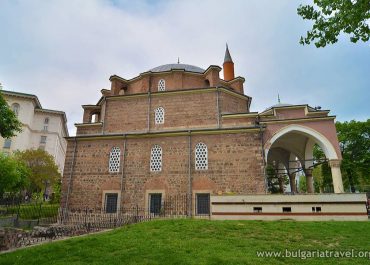
Sofia Mosque
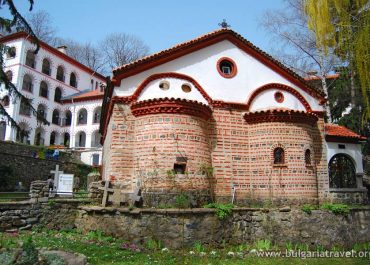
Dragalevski Monastery “St. Mary”.

Bulgaria’s Treasures
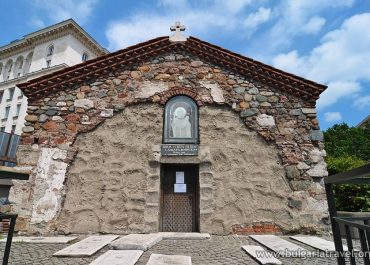
Situation in Haiti April 5, 2024
U.s. citizens in haiti, update april 12, 2024, information for u.s. citizens in the middle east.
- Travel Advisories |
- Contact Us |
- MyTravelGov |
Find U.S. Embassies & Consulates
Travel.state.gov, congressional liaison, special issuance agency, u.s. passports, international travel, intercountry adoption, international parental child abduction, records and authentications, popular links, travel advisories, mytravelgov, stay connected, legal resources, legal information, info for u.s. law enforcement, replace or certify documents.
Share this page:
Bulgaria Travel Advisory
Travel advisory july 26, 2023, bulgaria - level 1: exercise normal precautions.
Reissued with obsolete COVID-19 page links removed.
Exercise normal precautions in Bulgaria.
Read the country information page for additional information on travel to Bulgaria.
If you decide to travel to Bulgaria:
- Enroll in the Smart Traveler Enrollment Program ( STEP ) to receive Alerts and make it easier to locate you in an emergency.
- Follow the Department of State on Facebook and Twitter .
- Review the Country Security Report for Bulgaria.
- Visit the CDC page for the latest Travel Health Information related to your travel.
- Prepare a contingency plan for emergency situations. Review the Traveler’s Checklist .
Travel Advisory Levels
Assistance for u.s. citizens, bulgaria map, search for travel advisories, external link.
You are about to leave travel.state.gov for an external website that is not maintained by the U.S. Department of State.
Links to external websites are provided as a convenience and should not be construed as an endorsement by the U.S. Department of State of the views or products contained therein. If you wish to remain on travel.state.gov, click the "cancel" message.
You are about to visit:
Sofia Bulgaria Travel
- Sofia – the Capital of Bulgaria
Your Resource for Best Eats, Sights and Stays in Sofia
Sofia Sightseeing
Walk with me around ancient ruins, museums, churches, galleries and restaurants (savor traditional organic Bulgarian cuisine) then peek
into small Bulgarian shops with affordable prices, and end the day at one of the many night clubs where you can dance until morning.
Sofia Party or Business
Sofia provides not only a potential party location for a weekend stay or longer vacation, but also an ideal opportunity for business development research.
As the business environment here has improved over the last couple of years, foreign investors are starting to flock to the country.
Sofia Lifestyle
On this website you can read about the best of Sofia and Bulgaria, interesting stories and detailed descriptions of local life and affairs.
Bulgarians are welcoming, friendly, love a bit of gossip and have a good sense of humor (obviously we are not modest :)).
Sofia with Me
I live and work in Sofia and as a local resident I will give you fresh information about ongoing events, hotels, apartments and property bargains (there are lovely, cheap houses in Bulgarian villages).
Maybe you will decide to move here after reading my site lol.
Bulgaria Pictures
I love to take pictures of every place I visit and you can enjoy my photographer’s experiments.
Furthermore, I promise to record videos and to put them online for you to feel the local spirit.
Please subscribe to my monthly newsletter , Sofia and Bulgaria Lovers . It tells you each month about the new information that I have added.
Are you ready? Lets go to have fun!
Check this resource for cheap properties in Bulgaria , where you can find good offers. Check also their properties under 10’000€ .
Wednesday, September 19th, 2007, by traveler, Filed under: | | Comments off
- December 2007
- September 2007
- August 2007
- February 2007
- January 2007
- bachelors bagpipe Brad Pit Bruce Willis christmas city center climbing wall education Etar Etara fish fish restaurant fountain Gabrovo icons japanese restaurant market monasteries Museum NBU New Bulgarian University Odeon paintings Patriarch Evtimii Popa Priest public phones Raina Kabaivanska Robert De Niro rugs salad Santa Claus sasa sashimi sea food Shopping shopska salad students sushi sushi bar Tambuktu traffic University wasabi wine
- Christmas Galore
Syndication

- Best Sofia Restaurants
- Blog about Sofia, Bulgaria
- Getting There
- Privacy Policy
- Property in Bulgaria
- Shopping Around
- Sofia City Popular Places
- Sofia Tips and Tricks
- Travel in Bulgaria
- Why Sofia and Bulgaria
- Bulgaria (4)
- Bulgaria tips (3)
- Education in Sofia (2)
- Restaurants (8)
- Shopping (4)
- Sofia tips (4)
© 2017, Sofia Bulgaria Travel , WP Theme "mts journey" by mts from WebDesign .
- Election 2024
- Entertainment
- Newsletters
- Photography
- Personal Finance
- AP Investigations
- AP Buyline Personal Finance
- Press Releases
- Israel-Hamas War
- Russia-Ukraine War
- Global elections
- Asia Pacific
- Latin America
- Middle East
- Election Results
- Delegate Tracker
- AP & Elections
- March Madness
- AP Top 25 Poll
- Movie reviews
- Book reviews
- Personal finance
- Financial Markets
- Business Highlights
- Financial wellness
- Artificial Intelligence
- Social Media
Romania and Bulgaria partially join Europe’s Schengen travel zone, but checks at land borders remain
Romania and Bulgaria partially joined Europe’s ID-check-free travel zone on Sunday, marking a new step in the two countries’ integration with the European Union. (AP Video shot by Nic Dumitrache and Valentina Petrova)
Flight attendants arriving at the Henri Coanda International Airport pass under a Schengen Information sign, in Otopeni, near Bucharest, Romania, Sunday, March 31, 2024. Romania and Bulgaria joined Europe’s passport- and visa-free Schengen Area, applying only to travelers arriving by air and sea. (AP Photo/Andreea Alexandru)
- Copy Link copied
A passenger that arrived with a flight from Vienna shows his passport after being one of the first people to take advantage of Romania’s entry in the Schengen Area without border checks by air and sea at the Henri Coanda International Airport in Otopeni, near Bucharest, Romania, Sunday, March 31, 2024. Romania and Bulgaria joined Europe’s passport- and visa-free Schengen Area, applying only to travelers arriving by air and sea. (AP Photo/Andreea Alexandru)
Passengers pass a sign that reads “Welcome to Schengen!” at the Henri Coanda International Airport in Otopeni, near Bucharest, Romania, Sunday, March 31, 2024. Romania and Bulgaria joined Europe’s passport- and visa-free Schengen Area, applying only to travelers arriving by air and sea. (AP Photo/Andreea Alexandru)
Passengers arriving at the Henri Coanda International Airport pass under a Schengen Information sign, in Otopeni, near Bucharest, Romania, Sunday, March 31, 2024. Romania and Bulgaria joined Europe’s passport- and visa-free Schengen Area, applying only to travelers arriving by air and sea. (AP Photo/Andreea Alexandru)
Passengers coloured by green light attend a welcoming ceremony announcing Bulgarias’ accession in Schengen by air and water, at Sofia airport, Bulgaria, Sunday, March 31, 2024. Romania and Bulgaria partially joined Europe’s ID-check-free travel zone on Sunday, marking a new step in the two countries’ integration with the European Union. (AP Photo/Valentina Petrova)
Passengers make a selfie as they at Sofia airport, Bulgaria, Sunday, March 31, 2024. Romania and Bulgaria partially joined Europe’s ID-check-free travel zone on Sunday, marking a new step in the two countries’ integration with the European Union. (AP Photo/Valentina Petrova)
Ebasa, a border police service dog, climbs on her handler during a media tour at the Henri Coanda International Airport in Otopeni, near Bucharest, Romania, Sunday, March 31, 2024. Romania and Bulgaria joined Europe’s passport- and visa-free Schengen Area, applying only to travelers arriving by air and sea. (AP Photo/Andreea Alexandru)
From left: Yordanka Chobanova, the head of the Representation of the European Commission in Bulgaria, Maria Gabriel, deputy Prime Minister, Nikolay Denkov, Prime Minister, Jesus Caballero, Sofia Airport’s CEO, press the red button during an official opening of Schengen borders by air, at Sofia airport, Bulgaria, Sunday, March 31, 2024. Romania and Bulgaria partially joined Europe’s ID-check-free travel zone on Sunday, marking a new step in the two countries’ integration with the European Union. (AP Photo/Valentina Petrova)
Passenger passes posters announcing Bulgarias’ accession in Schengen by air and water, at Sofia airpot, Bulgaria, Sunday, March 31, 2024. Romania and Bulgaria partially joined Europe’s ID-check-free travel zone on Sunday, marking a new step in the two countries’ integration with the European Union. (AP Photo/Valentina Petrova)
Passengers pass posters announcing Bulgarias’ accession in Schengen by air and water, at Sofia airport, Bulgaria, Sunday, March 31, 2024. Romania and Bulgaria partially joined Europe’s ID-check-free travel zone on Sunday, marking a new step in the two countries’ integration with the European Union. AP Photo/Valentina Petrova)
A journalist passes Non-Schengen automatic border control gates during a media tour at the Henri Coanda International Airport in Otopeni, near Bucharest, Romania, Sunday, March 31, 2024. Romania and Bulgaria joined Europe’s passport- and visa-free Schengen Area, applying only to travelers arriving by air and sea. (AP Photo/Andreea Alexandru)
Passengers ride an escalator at Sofia airport, Bulgaria, Sunday, March 31, 2024. Romania and Bulgaria partially joined Europe’s ID-check-free travel zone on Sunday, marking a new step in the two countries’ integration with the European Union. (AP Photo/Valentina Petrova)
A passenger that arrived with a flight from Vienna talks to media members after being one of the first people to take advantage of Romania’s entry in the Schengen Area without border checks by air and sea at the Henri Coanda International Airport in Otopeni, near Bucharest, Romania, Sunday, March 31, 2024. Romania and Bulgaria joined Europe’s passport- and visa-free Schengen Area, applying only to travelers arriving by air and sea. (AP Photo/Andreea Alexandru)
A woman passes a sign that reads “Welcome to Schengen!” as she arrives at the Henri Coanda International Airport in Otopeni, near Bucharest, Romania, Sunday, March 31, 2024. Romania and Bulgaria joined Europe’s passport- and visa-free Schengen Area, applying only to travelers arriving by air and sea. (AP Photo/Andreea Alexandru)
A man touches a sign that reads “Welcome to Schengen!” as he arrives at the Henri Coanda International Airport in Otopeni, near Bucharest, Romania, Sunday, March 31, 2024. Romania and Bulgaria joined Europe’s passport- and visa-free Schengen Area, applying only to travelers arriving by air and sea. (AP Photo/Andreea Alexandru)
A flight attendant passes a sign that reads “Welcome to Schengen!” as she arrives at the Henri Coanda International Airport in Otopeni, near Bucharest, Romania, Sunday, March 31, 2024. Romania and Bulgaria joined Europe’s passport- and visa-free Schengen Area, applying only to travelers arriving by air and sea. (AP Photo/Andreea Alexandru)
SOFIA, Bulgaria (AP) — Romania and Bulgaria partially joined Europe’s ID-check-free travel zone on Sunday, marking a new step in the two countries’ integration with the European Union.
After years of negotiations to join the Schengen area, there is now free access for travelers arriving by air or sea from both countries. However, land border checks will remain in place due to opposition primarily from Austria which has long blocked their bid over illegal migration concerns.
EU Commission President Ursula von der Leyen hailed the change as a “huge success for both countries” and a “historic moment” for what is the world’s largest free travel zone.
The Schengen Area was established in 1985. Before Bulgaria and Romania’s admission, it was comprised of 23 of the 27 EU member countries, along with Switzerland, Norway, Iceland and Liechtenstein. Around 3.5 million people cross an internal border each day.
Austria vetoed Romania and Bulgaria’s admission into the Schengen zone at the end of 2022 but allowed Croatia full accession. Bulgaria and Romania joined the EU in 2007 and Croatia in 2013.
Siegfried Muresan, a Romanian Member of the European Parliament, told The Associated Press that it is “an important first step” that will benefit millions of travelers annually.
“Bulgaria and Romania have been fulfilling all criteria for joining the Schengen area for years — we are entitled to join with the terrestrial border as well,” he said, adding that it “will offer additional arguments to the last EU member state that has been vetoing the full accession.”
Romanian Prime Minister Marcel Ciolacu called it a “well-deserved achievement” for Romania that he said will benefit citizens who can travel more easily and will bolster the economy.
“We have a clear and firmly assumed government plan for full accession to the Schengen Area by the end of the year,” he said.
The EU’s executive branch, the European Commission, has said for more than a decade that Romania and Bulgaria both meet the technical criteria for full accession, which requires unanimous support from their partners. Both countries have agreed to implement random security screening at airports and maritime borders to combat illegal migration and cross-border crime.
“Bulgaria’s full accession to Schengen will happen by the end of 2024,” Kalin Stoyanov, Bulgaria’s interior minister, told reporters on Sunday. “We showed and continue to show to illegal migrants that they should not take the road to Europe through Bulgaria.”
The lifting of border control is expected to facilitate operations at Bulgaria’s four international airports, which in 2023 saw nearly 11 million passengers, according to official data.
The airport in the capital, Sofia, serves as the biggest hub for Schengen flights which constitute 70% of all flights, airport representatives said.
While the eased regulations are expected to positively impact the tourism sector, members of the European Parliament have voiced concerns about long queues at the EU’s land borders and the impact it can have on trade in the bloc’s single market, as well as the health and safety of drivers.
Truck drivers are frequently stuck in kilometers-long queues at the borders of both Romania and Bulgaria. The Union of International Carriers in Bulgaria estimates delays cost the sector tens of millions of euros each year.
McGrath reported from Sighisoara, Romania.
Romania and Bulgaria partially join Europe’s Schengen travel zone, but checks at land borders remain
SOFIA, Bulgaria — Romania and Bulgaria partially joined Europe’s ID-check-free travel zone on Sunday, marking a new step in the two countries’ integration with the European Union.
After years of negotiations to join the Schengen area, there is now free access for travelers arriving by air or sea from both countries. However, land border checks will remain in place due to opposition primarily from Austria which has long blocked their bid over illegal migration concerns.
EU Commission President Ursula von der Leyen hailed the change as a “huge success for both countries” and a “historic moment” for what is the world’s largest free travel zone.
The Schengen Area was established in 1985. Before Bulgaria and Romania’s admission, it was comprised of 23 of the 27 EU member countries, along with Switzerland, Norway, Iceland and Liechtenstein. Around 3.5 million people cross an internal border each day.
Austria vetoed Romania and Bulgaria’s admission into the Schengen zone at the end of 2022 but allowed Croatia full accession. Bulgaria and Romania joined the EU in 2007 and Croatia in 2013.
Siegfried Muresan, a Romanian Member of the European Parliament, told The Associated Press that it is “an important first step” that will benefit millions of travelers annually.
“Bulgaria and Romania have been fulfilling all criteria for joining the Schengen area for years — we are entitled to join with the terrestrial border as well,” he said, adding that it “will offer additional arguments to the last EU member state that has been vetoing the full accession.”
Romanian Prime Minister Marcel Ciolacu called it a “well-deserved achievement” for Romania that he said will benefit citizens who can travel more easily and will bolster the economy.
“We have a clear and firmly assumed government plan for full accession to the Schengen Area by the end of the year,” he said.
The EU’s executive branch, the European Commission, has said for more than a decade that Romania and Bulgaria both meet the technical criteria for full accession, which requires unanimous support from their partners. Both countries have agreed to implement random security screening at airports and maritime borders to combat illegal migration and cross-border crime.
“Bulgaria’s full accession to Schengen will happen by the end of 2024,” Kalin Stoyanov, Bulgaria’s interior minister, told reporters on Sunday. “We showed and continue to show to illegal migrants that they should not take the road to Europe through Bulgaria.”
The lifting of border control is expected to facilitate operations at Bulgaria’s four international airports, which in 2023 saw nearly 11 million passengers, according to official data.
The airport in the capital, Sofia, serves as the biggest hub for Schengen flights which constitute 70% of all flights, airport representatives said.
While the eased regulations are expected to positively impact the tourism sector, members of the European Parliament have voiced concerns about long queues at the EU’s land borders and the impact it can have on trade in the bloc’s single market, as well as the health and safety of drivers.
Truck drivers are frequently stuck in kilometers-long queues at the borders of both Romania and Bulgaria. The Union of International Carriers in Bulgaria estimates delays cost the sector tens of millions of euros each year.
McGrath reported from Sighisoara, Romania.


IMAGES
VIDEO
COMMENTS
Sofia Travel Costs. Hostel prices - A bed in a hostel dorm with 4-6 beds costs between 12-25 BGN per night. For a private room in a hostel, expect to pay between 35-75 BGN per night. Free Wi-Fi is standard and most hostels also have self-catering facilities.
Sofia. Bulgaria's pleasingly laid-back capital is often overlooked by visitors heading to the coast or the ski resorts, but they're missing something special. Sofia is no grand metropolis, but it's a modern, youthful city, with a scattering of onion-domed churches, Ottoman mosques and stubborn Red Army monuments that lend an eclectic, exotic ...
ATMs and Currency Exchange. Luckily, both terminals of Sofia Airport, as well as the bus station, have ATMs when you arrive. One of my biggest Sofia travel tips is to use ATMs rather than money exchange. By far the best way to get money out in Sofia is by using local ATMs.
With a history that stretches over seven millennia, ruin-rich Sofia is one of Europe's oldest cities. The National Historical Museum is one of Eastern Europe's most extensive. Wide, cobblestone boulevards, charming boutiques and truly electrifying nightlife star in this city of 1.3 million. Trolleys, trams and buses traverse the dynamic city.
Mapping out the ideal Sofia itinerary is a highlight of visiting Bulgaria and spending 1, 2 or 3 days in Sofia is an unbeatable experience. Sofia is a city that is often overlooked, too frequently shunted and added to "skip it" lists without a second thought. And, to be honest, it might be understandable at first sight of Bulgaria's ...
St. Sophia in Sofia, Bulgaria, holds the title of being the oldest church in the country. It originates from a Byzantine church dating back to the 4th century and showcases a predominantly brick interior adorned with beautiful paintings. Additionally, the church boasts an intriguing underground crypt.
Exzarh Iosif. Borisova Gradina. Down bul. Tsar Osvoboditel, past Sofia University, is Borisova Gradina, named after Bulgaria's interwar monarch, Boris III. The park - the largest in Sofia - has a rich variety of flowers and trees, outdoor bars, two football stadiums and two huge Communist monuments. The City Art Gallery.
Best things to do in Sofia, Bulgaria. With all those travel tips out of the way, let's take a look at some of the best things you can do in Sofia on your trip! 1. Take the free walking tour. An excellent way to start your time in Sofia is by taking one of the free 2-hour walking tours offered by Free Sofia Walking Tour. In the Summer, Free ...
Many people visiting Bulgaria focus on either the ski slopes or beaches, but there's a lot more. Check out these fun things to do in Sofia. Over a century ago, Prince Ferdinand of Bulgaria aimed to make Sofia a fashionable capital city to the likes of nearby cities, Budapest or Prague. Walking the locally renowned yellow-bricked-tree-lined road leading to the National Assembly building, you ...
Sofia. Sofia (София) is the capital of Bulgaria. It is also the biggest city in the country with about 2 million citizens (including suburbs). Today, Sofia is a dynamic European capital, distinguished by its unique combination of European and communist-style architecture as well as many beautiful Orthodox churches.
Here are the best things to do in Sofia: 1. St. Alexander Nevski Cathedral. Source: flickr. St. Alexander Nevski Cathedral. The scale of this building will blow you away. Inside St. Alexander Nevski has room for 10,000 people and it's the second largest cathedral in the Balkan region.
Sofia's star attraction is this enormous, golden-domed basilica, which, despite being named after a Russian prince, serves as a symbol of modern, independent Bulgaria. It took 30 years to build ...
Upon arrival in Sofia, Bulgaria, visitors are captivated by soaring Mount Vitosha. Yet downtown awaits with the discovery of grand Orthodox cathedrals, charming open-air book markets, ancient ...
Besides the first layer of 11th-12th century frescoes. | sofia bulgaria travel guide. If you have more time, you can visit the Boyana church located on the outskirts of Sofia, one of the nine UNESCO cultural heritage sites of Bulgaria. Slaveykov Book Market at Petko R. Slaveykov Square | sofia bulgaria blog
Water Quality in Sofia, Bulgaria . The water in Sofia and other areas of Bulgaria are completely safe to drink. Restaurants will typically bring bottled water in restaurants in Sofia, but you can request to drink the tap water instead. Tipping in Bulgaria. The tipping culture in Bulgaria is similar to many other European countries. While tips ...
Sofia Place. The Sofia Place Hotel is popular with families, as it has the amenities of a hotel, but still offers the space and convenience of apartments. They get a thumbs up for having modern clean bathrooms, a delicious breakfast, and a great coffee shop next door. Price: $35+ USD per night.
Days 4-5: Plovdiv. After exploring Sofia, the final step on a 5-day Bulgaria itinerary should be the second-largest city of Plovdiv. As one of the European Capitals of Culture in 2019, Plovdiv is probably the most tourist-friendly city in Bulgaria and it has a lot to offer visitors.
Eclectic, with a unique blend of conceptual parties like Shame, Social time, All Eyez On You Hip-hop parties, Soul train, weekends with electronic sound - disco, house, funk and groove patterns, Fashion parties and comedy shows. Every month, our guests have the unique opportunity to hear live world-famous names from the club scene as Stephane ...
Welcome to Sofia Adventures! We're Stephanie and Allison, two American travel bloggers who moved to Bulgaria. We use Sofia as our base to discover our favorite region in the world - the Balkans! We're here to share our knowledge from our past 3+ years of traveling the Balkans and inspire you to plan a trip to this beautiful part of the world.
Banya Bashi Mosque - the only functioning mosque in Sofia and it is built over natural thermal spas. St. Sophia Church - there is an underground museum in the oldest church in Sofia. St. George Rotunda Church - see frescos inside the 4th-century red brick rotunda. This is the oldest preserved building in Sofia.
Sofia is Bulgaria's capital and its largest city. Founded thousands of years ago, today the city continues to develop as the country's cultural and economic center. Sofia is located in the western part of the country, on The Sofia Plain and the lower slopes of Mount Vitosha. The city's average altitude is 550 meters above sea level, the ...
Read the country information page for additional information on travel to Bulgaria. If you decide to travel to Bulgaria: Enroll in the Smart Traveler Enrollment Program to ... U.S. Embassy Sofia . 16, Kozyak Street Sofia 1408, Bulgaria. Telephone +(359) (2) 937-5100. Emergency +(359) (2) 937-5101. Fax +(359) (2) 937-5209. Email. ACS_Sofia@state ...
Of all European Union countries, Bulgaria and its capital Sofia are almost unknown traveling places. Sofia is the pearl of Bulgaria with its unique location near to skiing and beach resorts. Sofia Bulgaria Travel Site Map. Sofia, Bulgaria is party location. Traveling around Bulgaria is fun and don't break your budget.
SOFIA, Bulgaria — Romania and Bulgaria partially joined Europe's ID-check-free travel zone on Sunday, marking a new step in the two countries' integration with the European Union. After ...
Passengers coloured by green light attend a welcoming ceremony announcing Bulgarias' accession in Schengen by air and water, at Sofia airport, Bulgaria, Sunday, March 31, 2024. Romania and Bulgaria partially joined Europe's ID-check-free travel zone on Sunday, marking a new step in the two countries' integration with the European Union.
Nov 2, 2019 - alexander-nevsky-cathedral-sofia-bulgaria-bulgaria-travel-destinations-bulga/ delivers online tools that help you to stay in control of your personal information and protect your online privacy.
Assistant Secretary of State for Consular Affairs Rena Bitter will travel April 11-19 to Nicosia, Cyprus; Frankfurt, Germany; Bucharest, Romania; and Sofia, Bulgaria. In Nicosia, Bucharest, and Sofia, Assistant Secretary Bitter will meet with host government officials to discuss further facilitating travel between our countries and other consular issues of mutual interest. In all four cities ...
SOFIA, Bulgaria — Romania and Bulgaria partially joined Europe's ID-check-free travel zone on Sunday, marking a new step in the two countries' integration with the European Union.